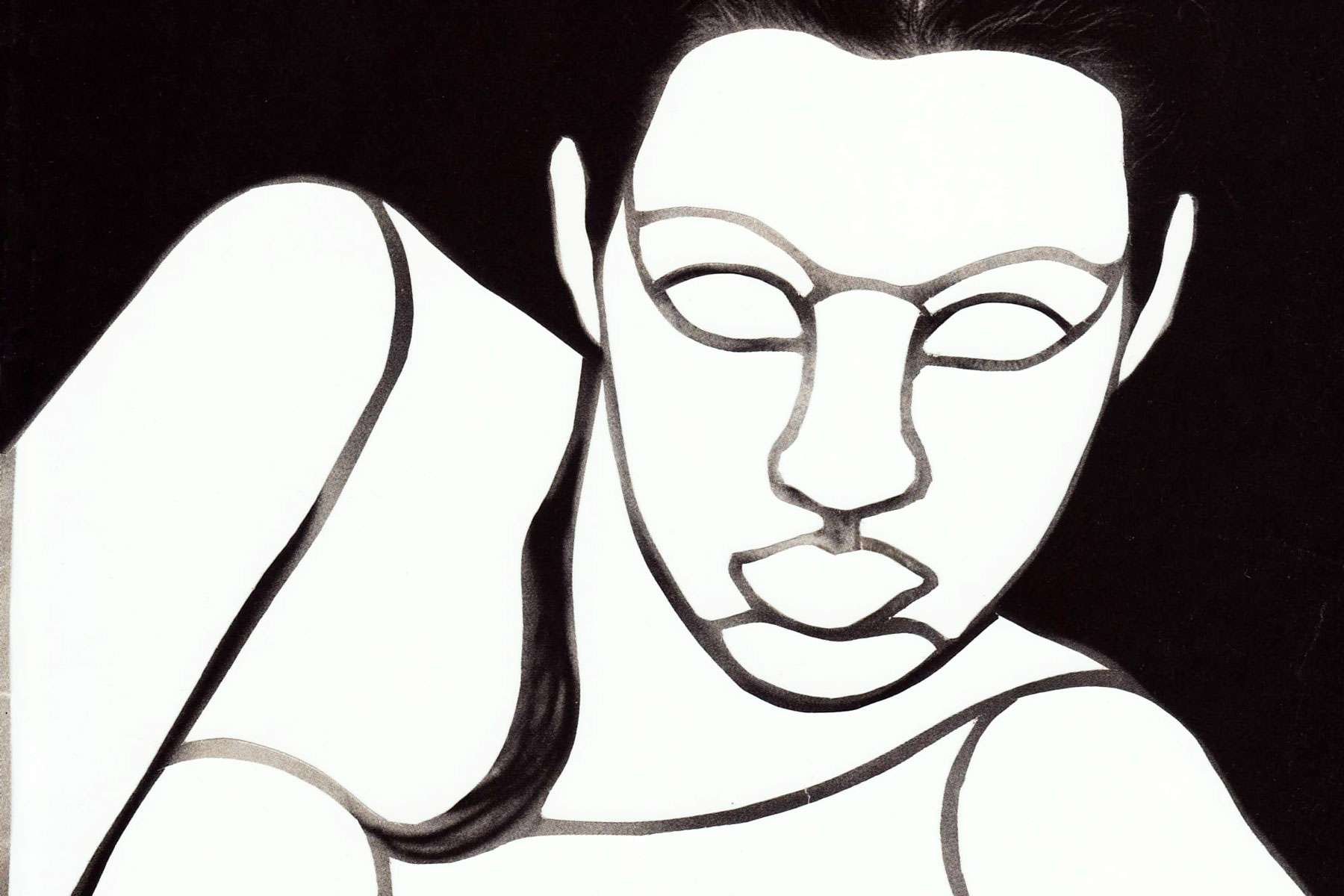
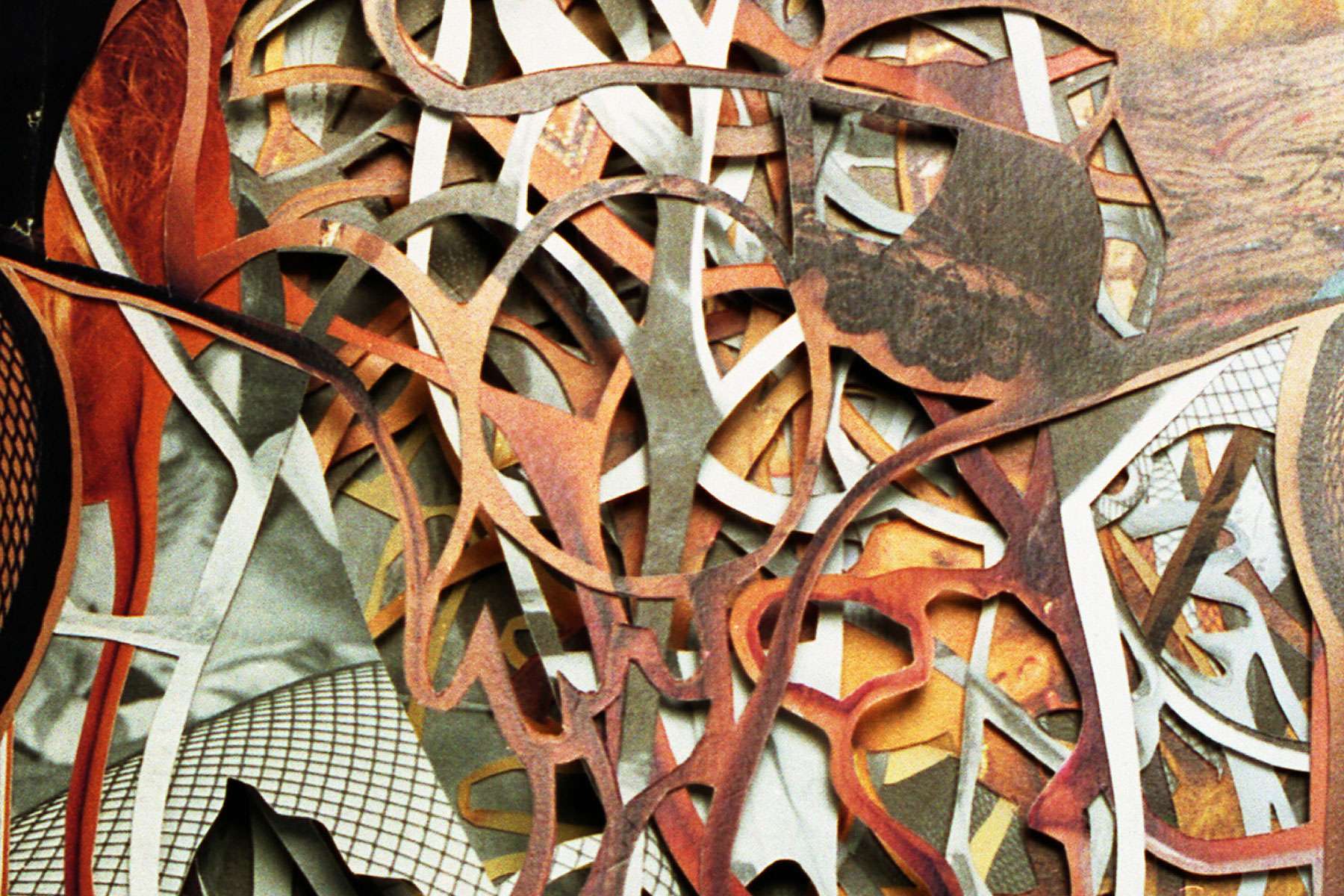
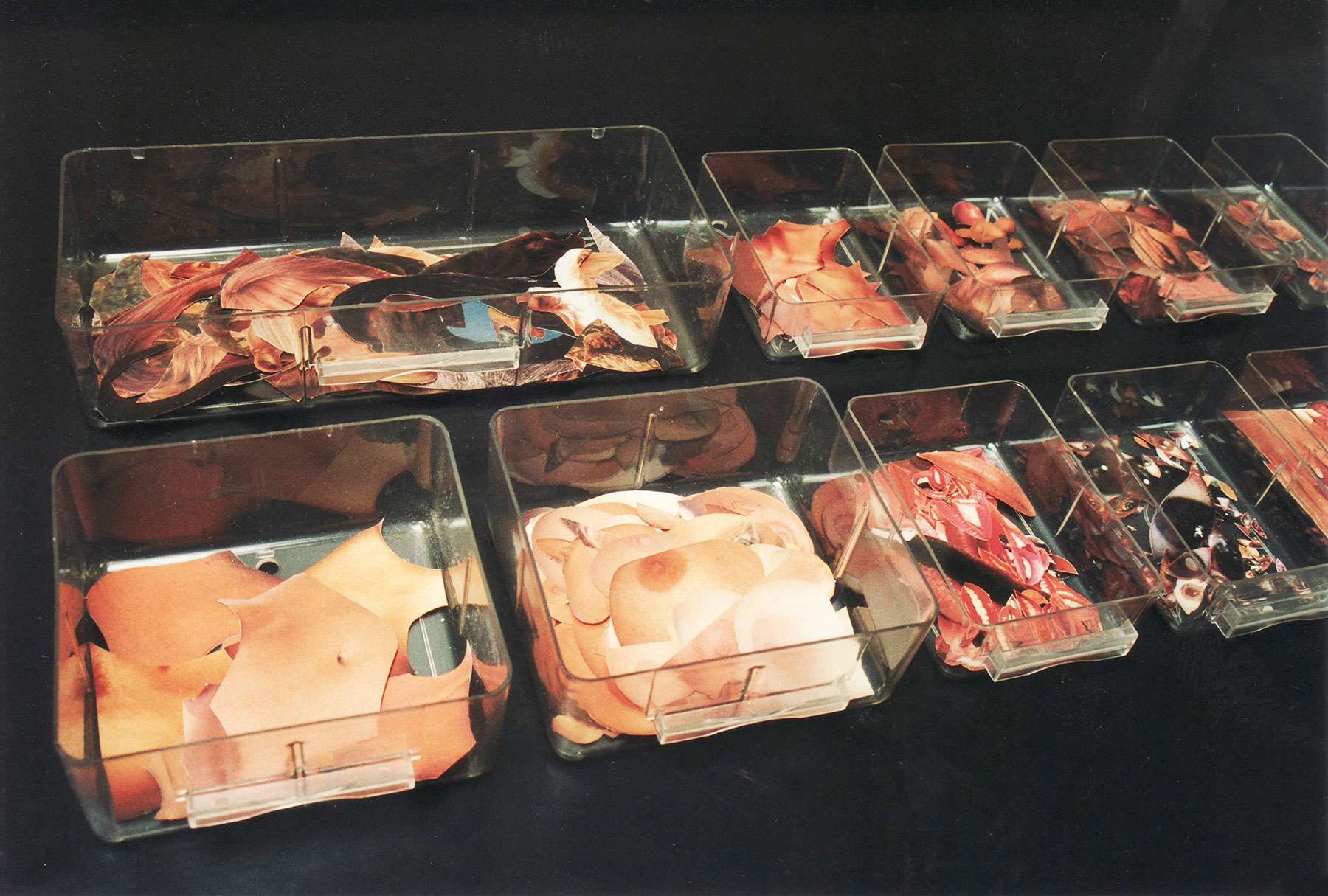







The (National) Institute for Research of the Public Body, (N) IRPuB – examines the way people use and exhibit their bodies in public. For its research, the Institute uses images of bodies or parts of bodies taken from various media.
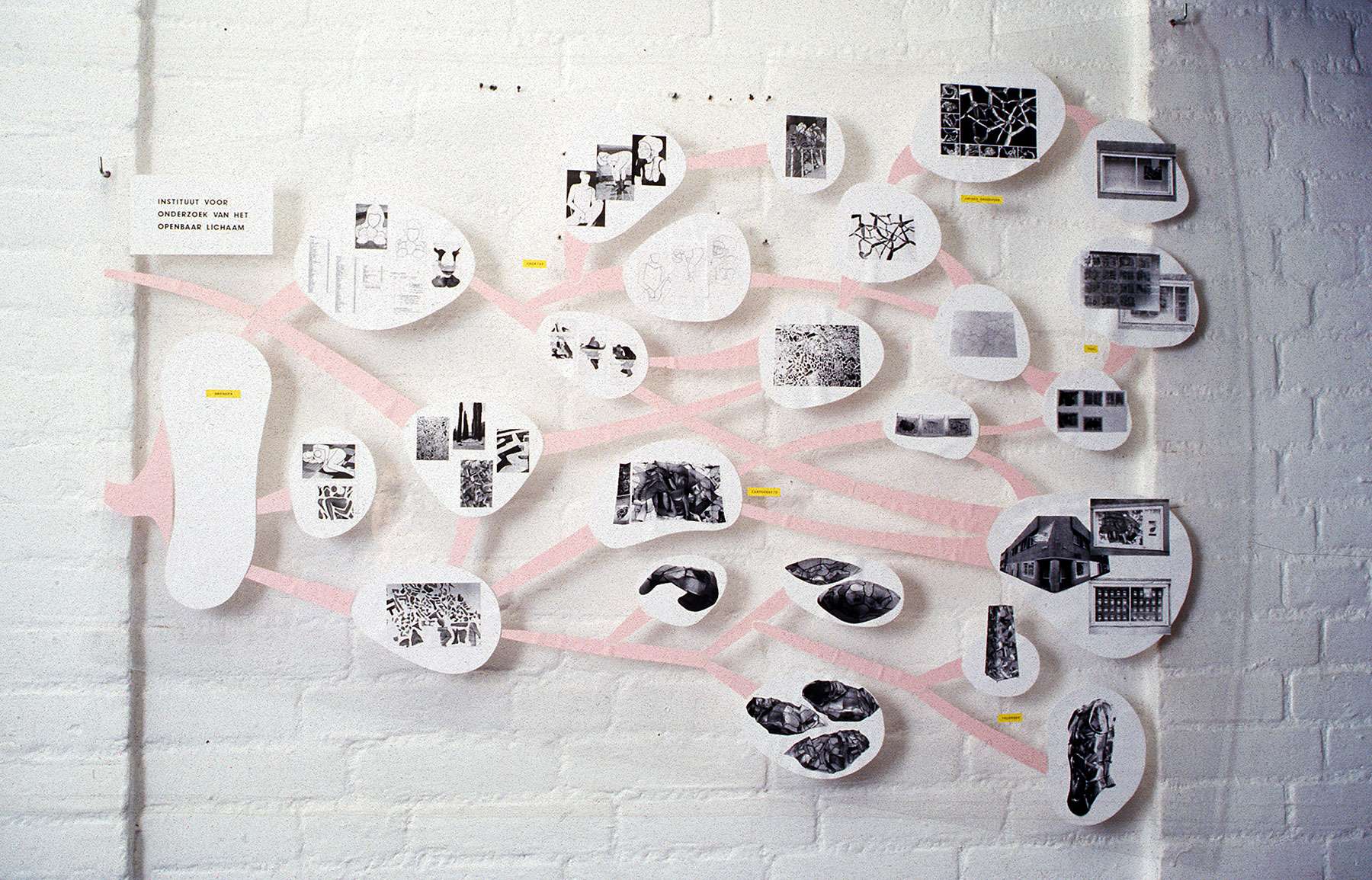 Organizational structure of the Institute.
Organizational structure of the Institute.
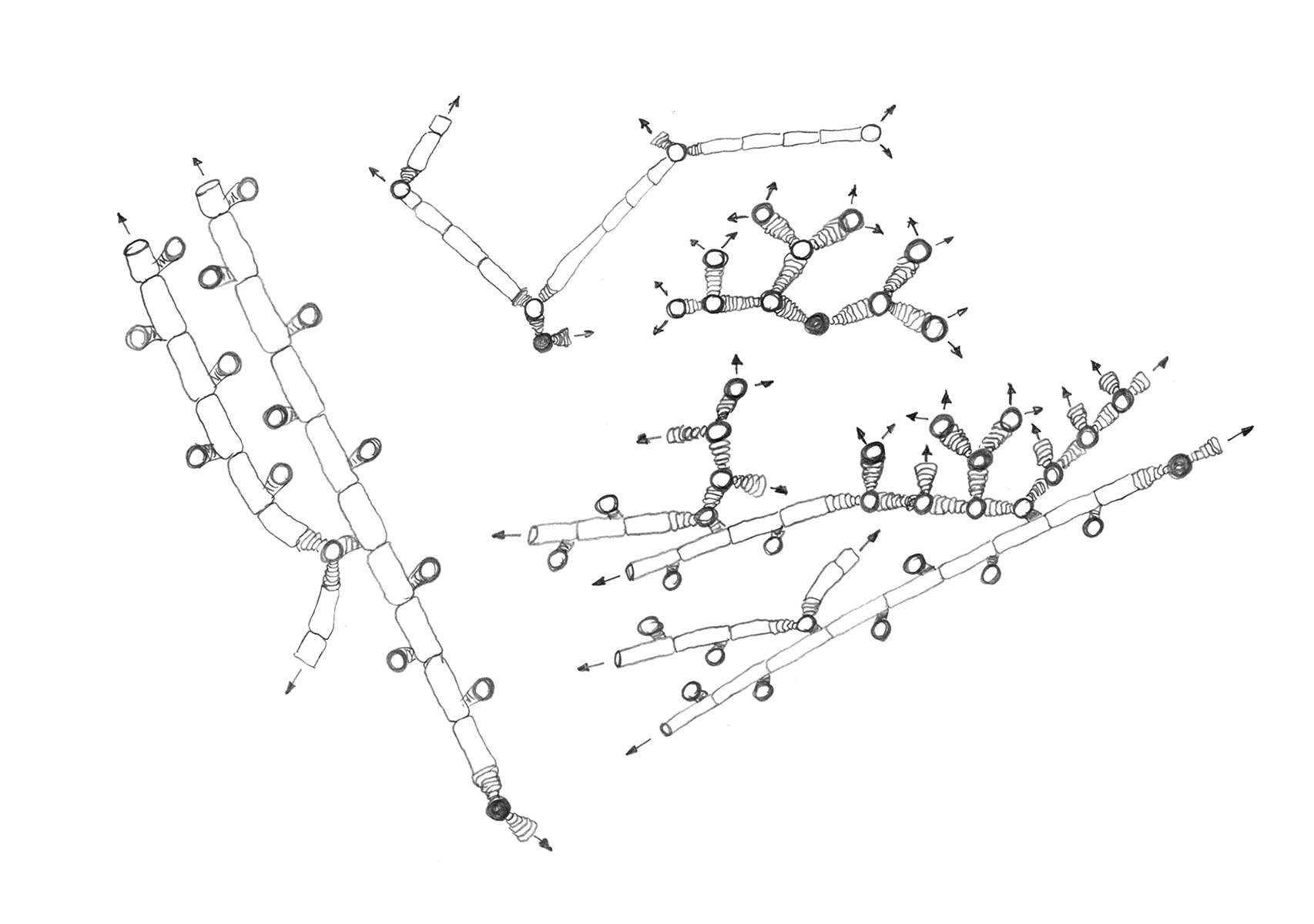
The Public Body examined displays many similarities with the way bamboo grows: it branches out in all directions by means of rhizomes and then shoots up at an increasing number of places.
The Institute consists of several departments. The Archive department forms the centre of the research. Other departments, each with its own work field, are External Research, Development and Presentations.
The Archive department makes sure that suitable Public Body source material is collected and processed. The processed material is archived and stored. Compositions and Scans are separate sections of Archive, which, by extrapolation, interpret the larger Public Body.
External Research is aimed at direct field research and reporting. Through the Field Work and Cartography sections this department develops appropriate tools for its staff.
The Development department provides a freer interpretation of the material from Archive and External Research.
Presentations documents the activities of the Institute and shows how the institute works and processes material. Various means are used for this purpose, of which installations are the best known.
The Archive department is the heart of the (N) IRPuB. It is here that media material is collected, processed and stored. The material is screened, analysed, processed and ultimately stored and managed. It is also lent to other departments for further examination, further interpretation or part-processing.
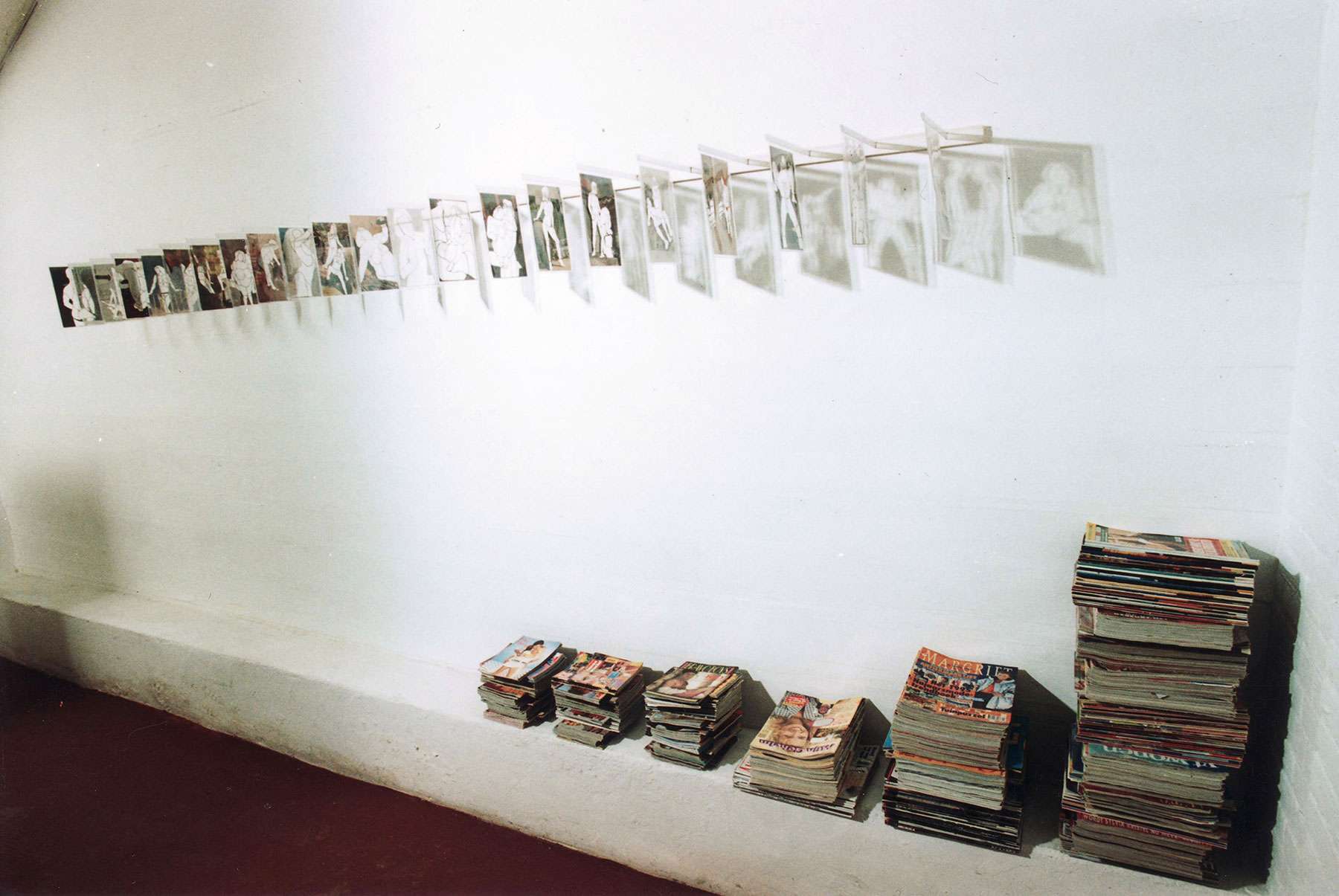
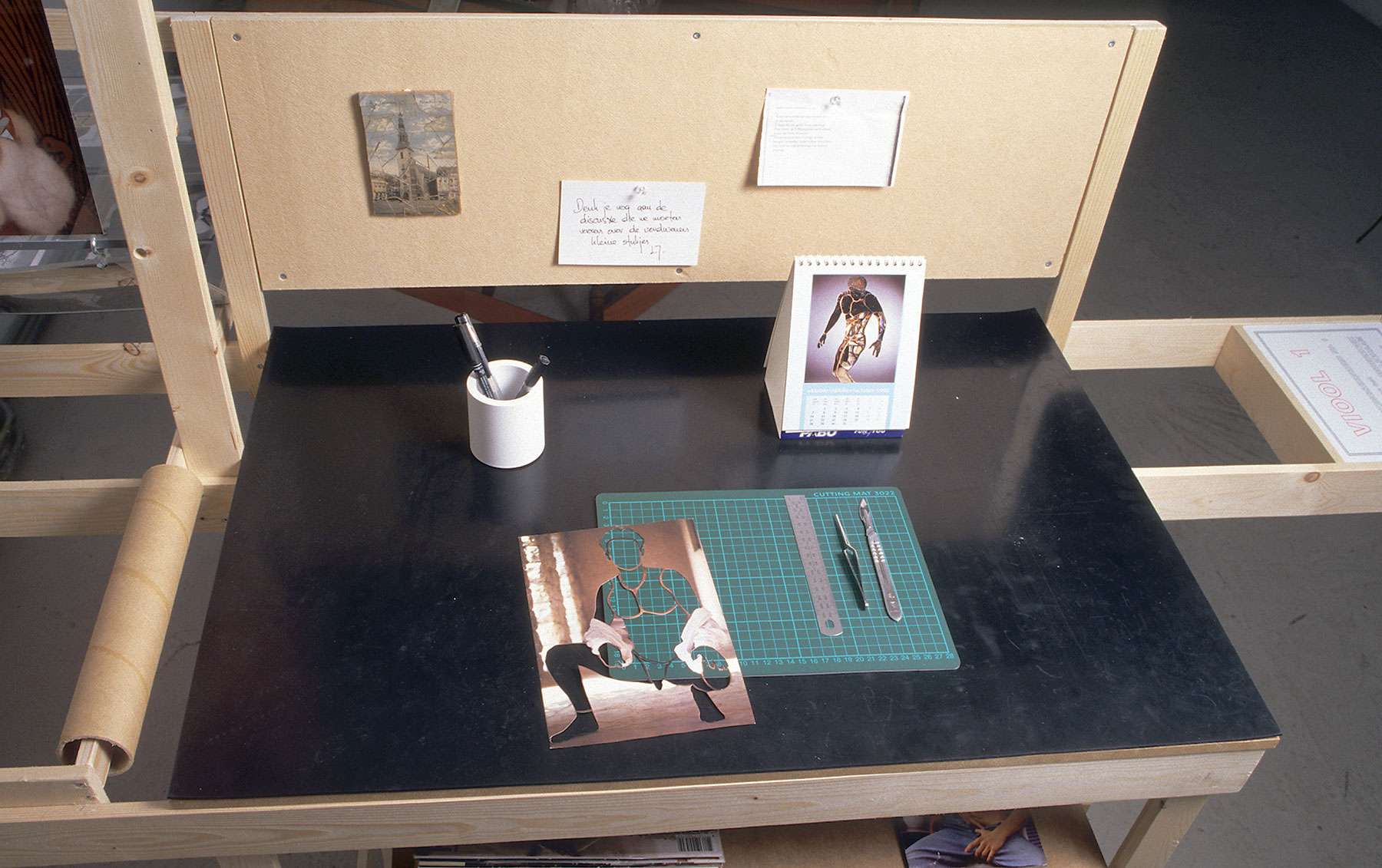
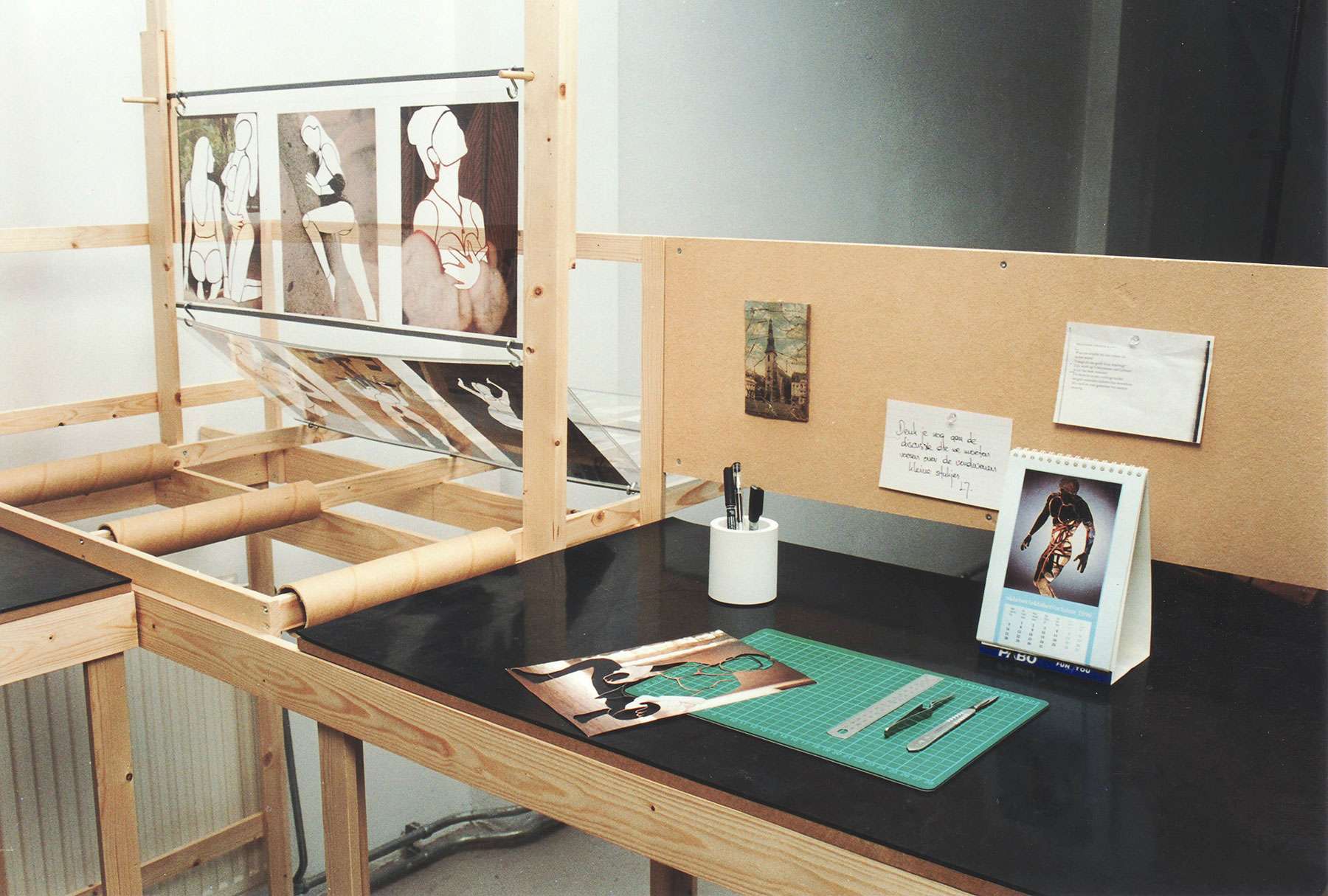
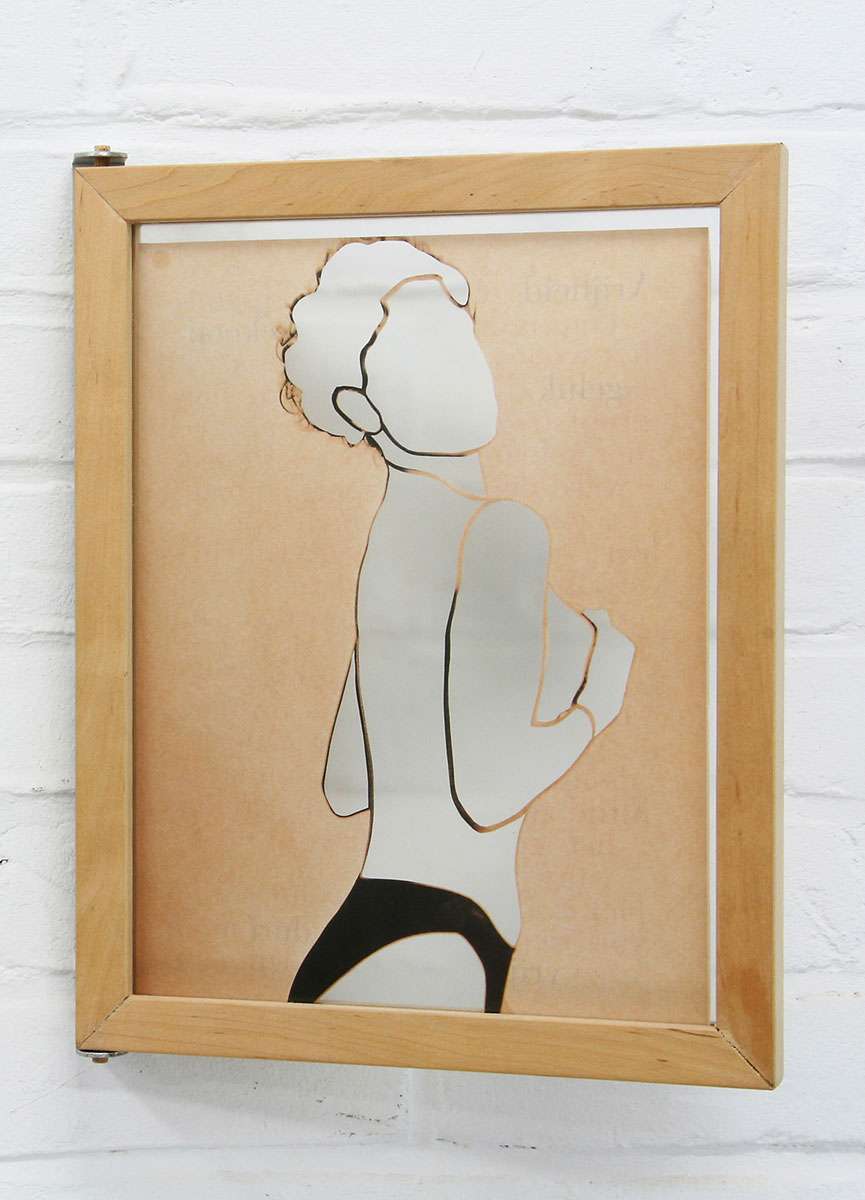 Side 1 of Bettine / paper, wood, glass, metal / 26x33x4cm / 2002
Side 1 of Bettine / paper, wood, glass, metal / 26x33x4cm / 2002
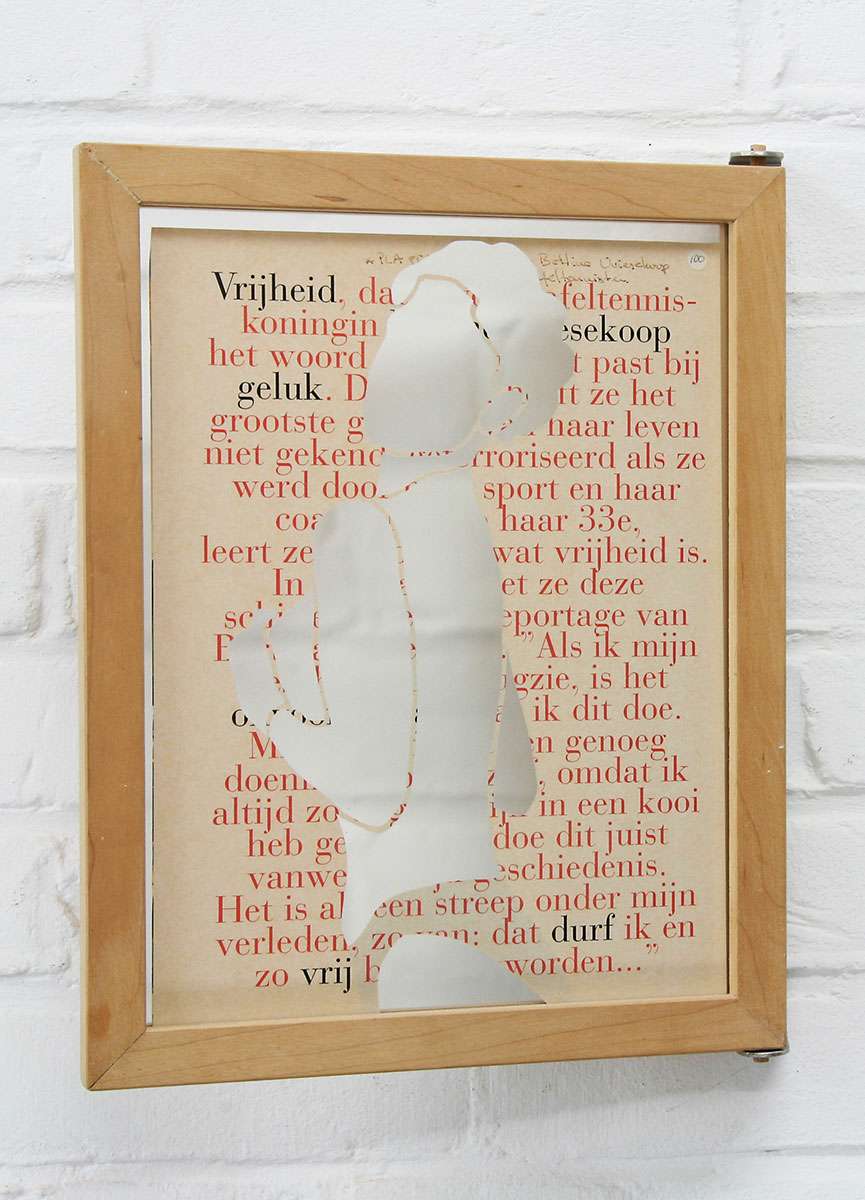 Side 2 of Bettine / paper, wood, glass, metal / 26x33x4cm / 2002
Side 2 of Bettine / paper, wood, glass, metal / 26x33x4cm / 2002
This work is stored in the archive as Bettine - RPuB / A100 - 01PLA95.7P80-1VBR10ST
Images of bodies come in from various media, usually in print and on paper. For example, pages with appropriate photos can be selected from a magazine, with the back of a page also being important and considered in the selection. A cutting plan is made for each page; this is used to cut out the image of the body. The structure, expression and unity of the portrayed body is left intact when cut. For most of the photos, both the cut-out parts and remaining whole are numbered and saved.
In Archive, a distinction is made between the portrayed bodies based on the purpose of the image. If the immediate display of the body is the objective then the letter A is added to the numbering. If the body is displayed with the objective of promoting a product, then the letter R is added to the numbering.
The method
From a single image (PuB), the following are listed in succession below: Remains after cutting out (RPuB), the Parts of the Body (PPuB) cut out and the Drawing (DPuB) made of the body, with the numbers of the parts.
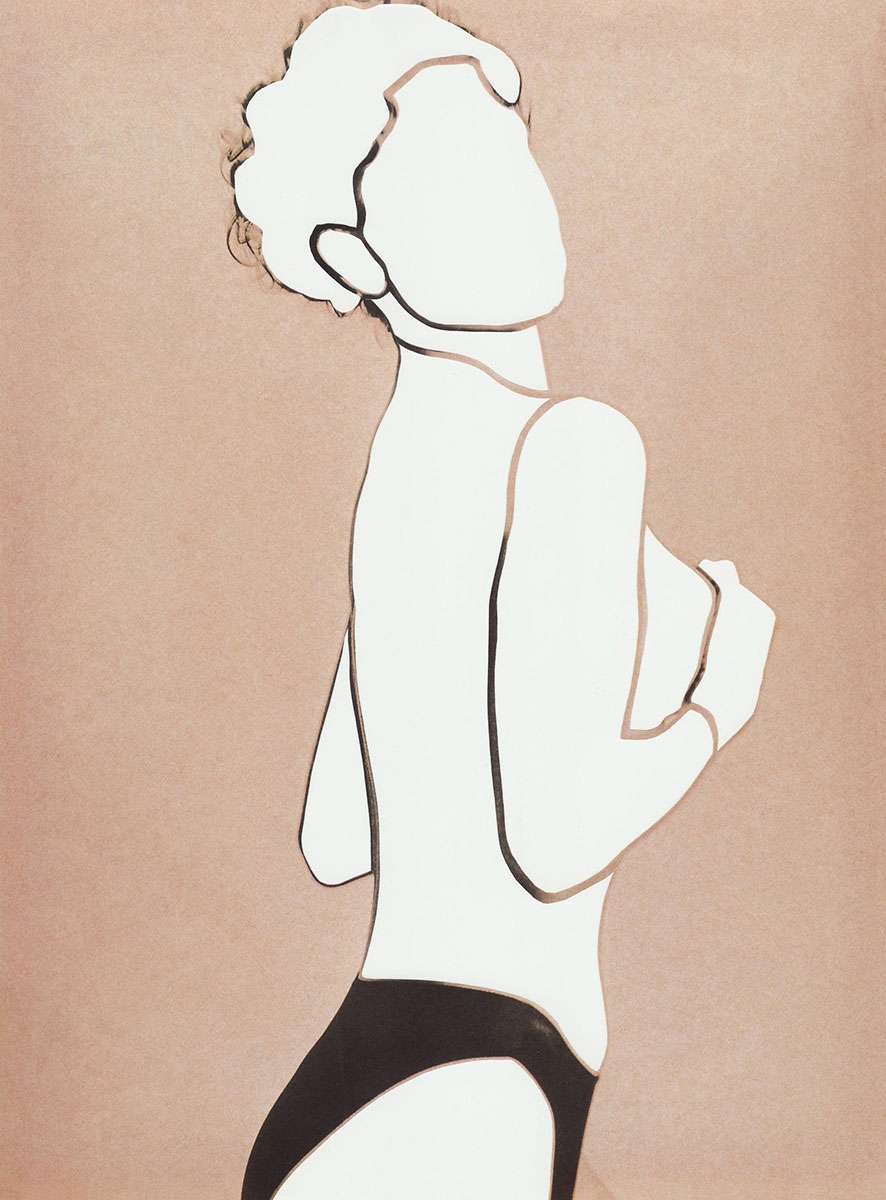 Side 1 of A100 – RPuB [RPuB / A100K1 - 01PLA95.7P80-1VBR10ST]
Side 1 of A100 – RPuB [RPuB / A100K1 - 01PLA95.7P80-1VBR10ST]
The Remains after cutting out the image (RPuB), seen from the cutting side.
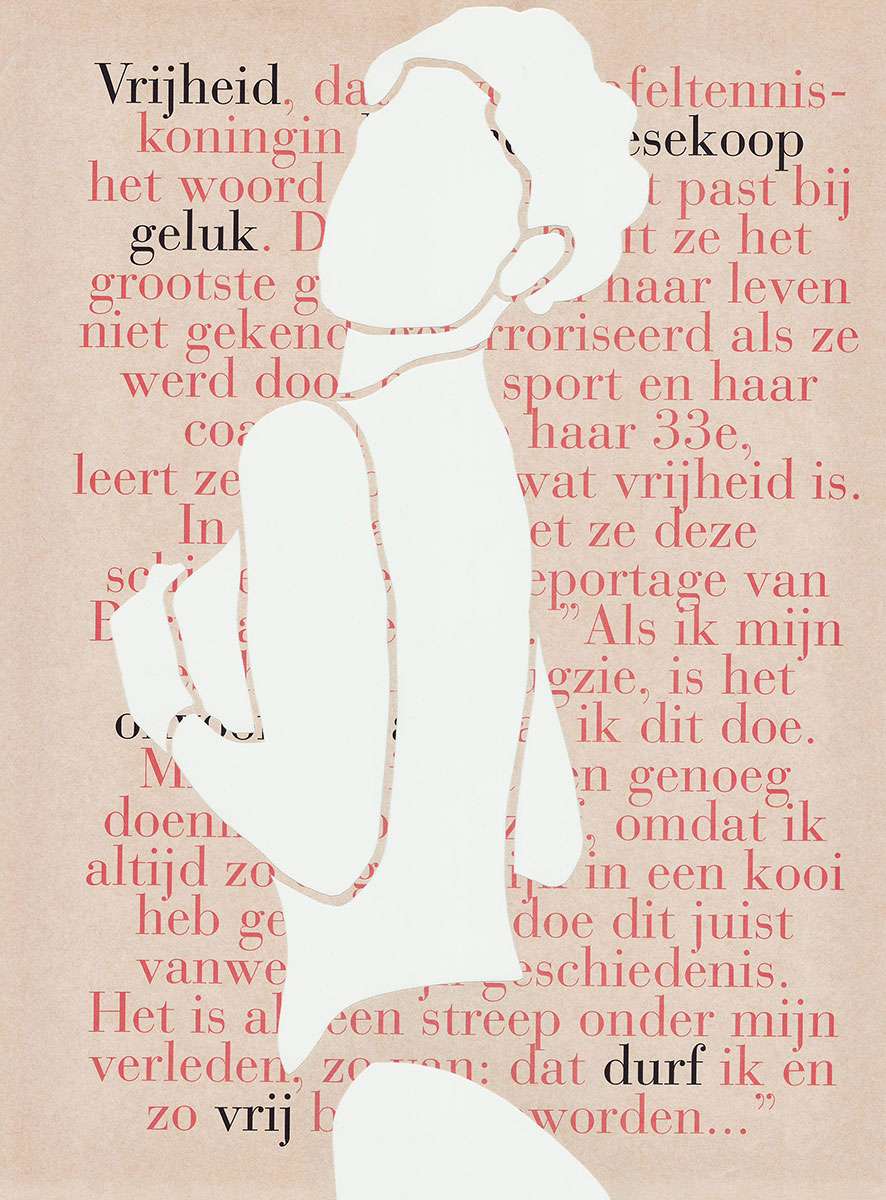 Side 2 of A100 – RPuB [RPuB / A100K2 - 01PLA95.7P80-1VBR10ST]
Side 2 of A100 – RPuB [RPuB / A100K2 - 01PLA95.7P80-1VBR10ST]
The Remains after cutting out the image (RPuB), seen from the other side.
 A100 – PPuB [PPuB / A100 - 01PLA95.7P80-1VBR10ST]
A100 – PPuB [PPuB / A100 - 01PLA95.7P80-1VBR10ST]
The Parts of the Body (PPuB) that are cut out, numbered and stored.
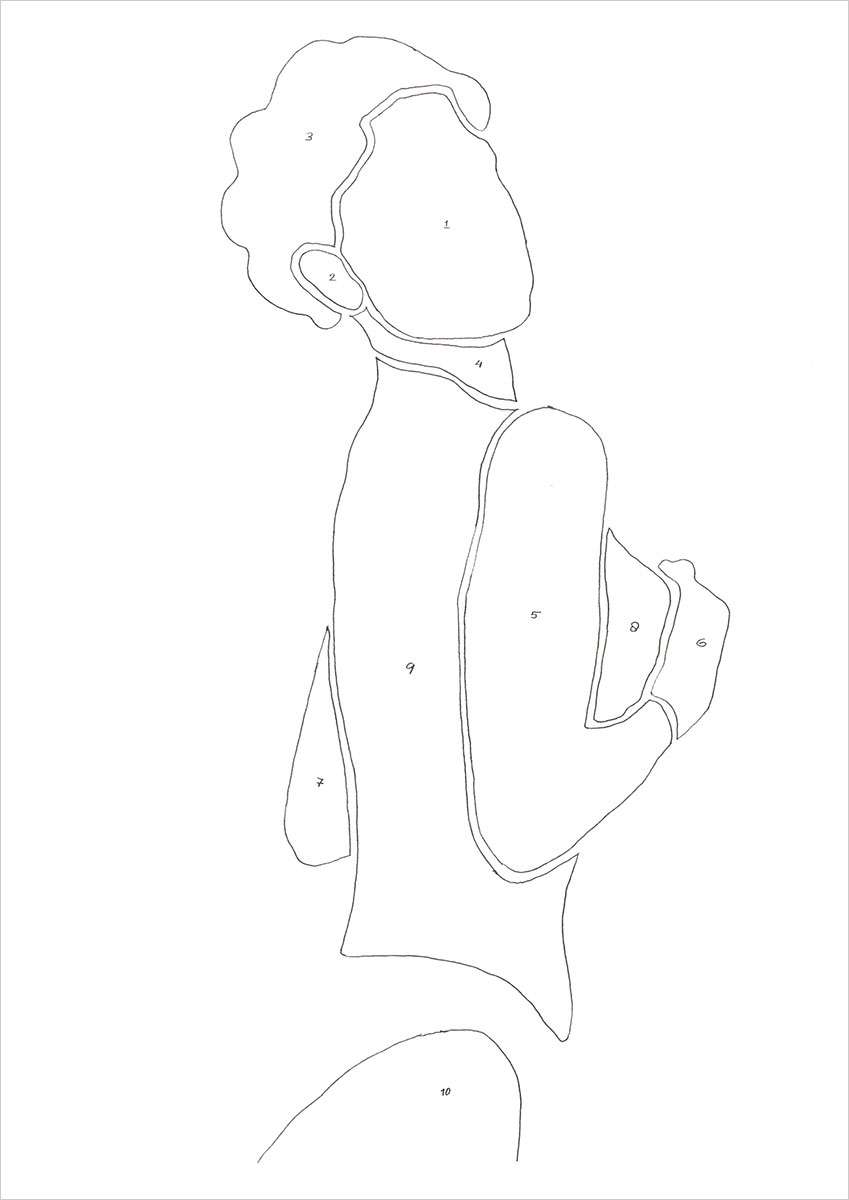 A100 – DPuB [DPuB / A100 - 01PLA95.7P80-1VBR10ST]
A100 – DPuB [DPuB / A100 - 01PLA95.7P80-1VBR10ST]
The Drawing (DPuB) of the cut-out Parts of the Body, identically numbered.
An image is examined for the presence of visible skin and based on that, selected or not. Here, it is about the whole of the existing image including the rest of the page. The position of the image on the page, the composition of the image and the placing of the visible skin in the image are also important. Legible texts, products and the surroundings also play a role.
For the (N) IRPuB having and maintaining a clear and comprehensive registration and coding system is essential. Archive has developed a system to enable tracking and tracing of the sources used and the material processed and stored. In all kinds of investigations it can also be seen which (archive) material was used or reused.
 Side 1 of A100 – RPuB [RPuB / A100K1 - 01PLA95.7P80-1VBR10ST]
Side 1 of A100 – RPuB [RPuB / A100K1 - 01PLA95.7P80-1VBR10ST]
This code can be read as follows:
For a more comprehensive insight into the coding … Read more
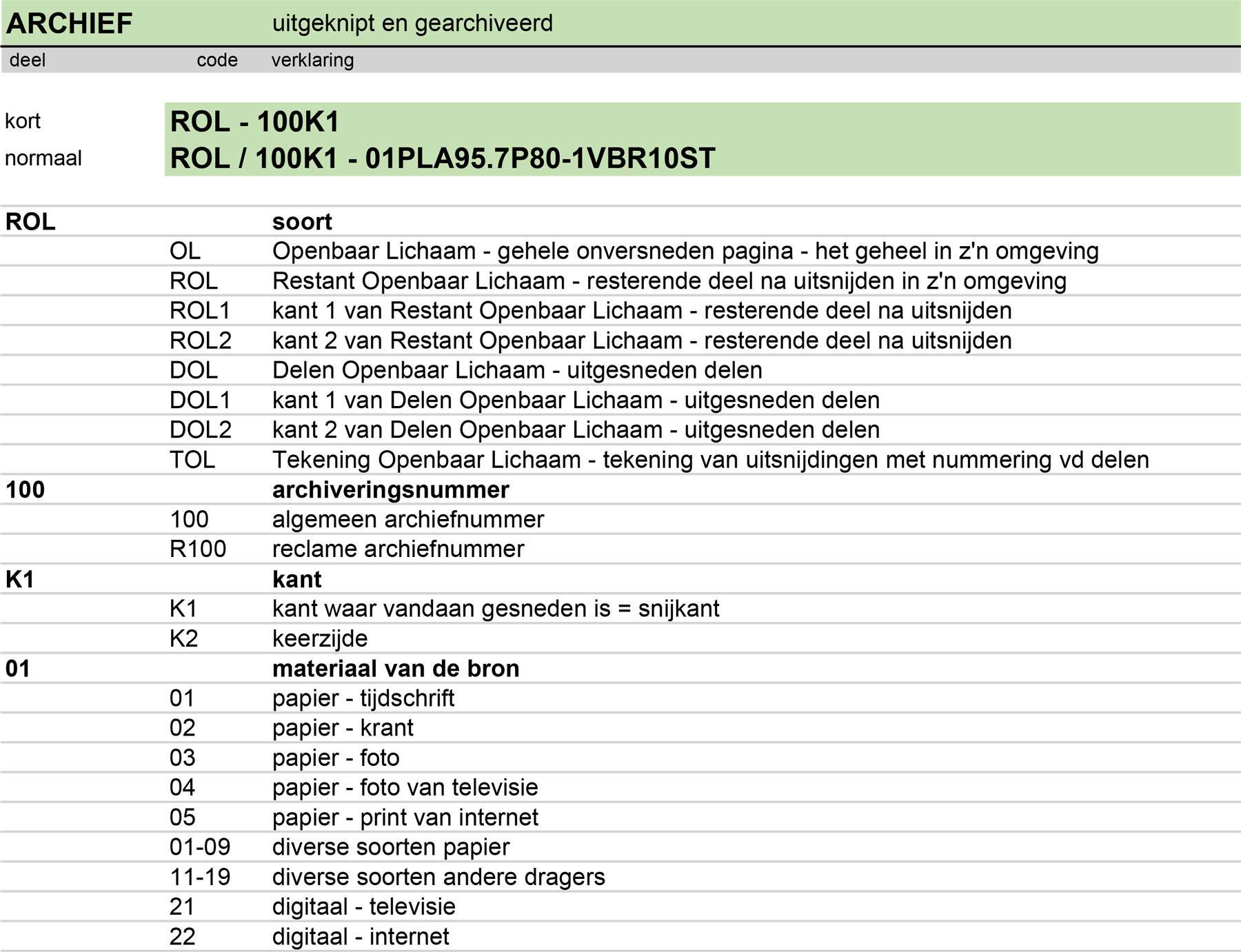
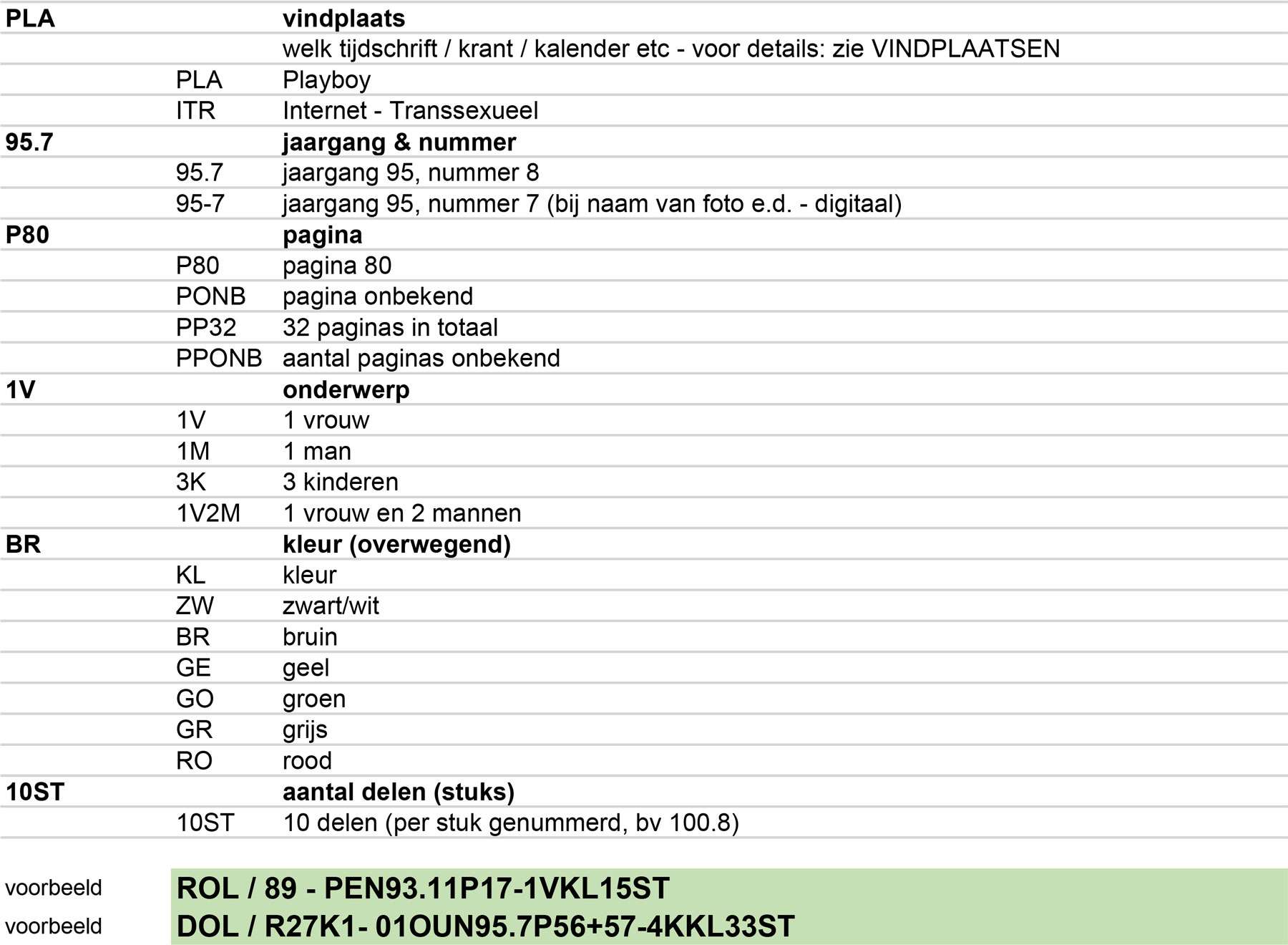
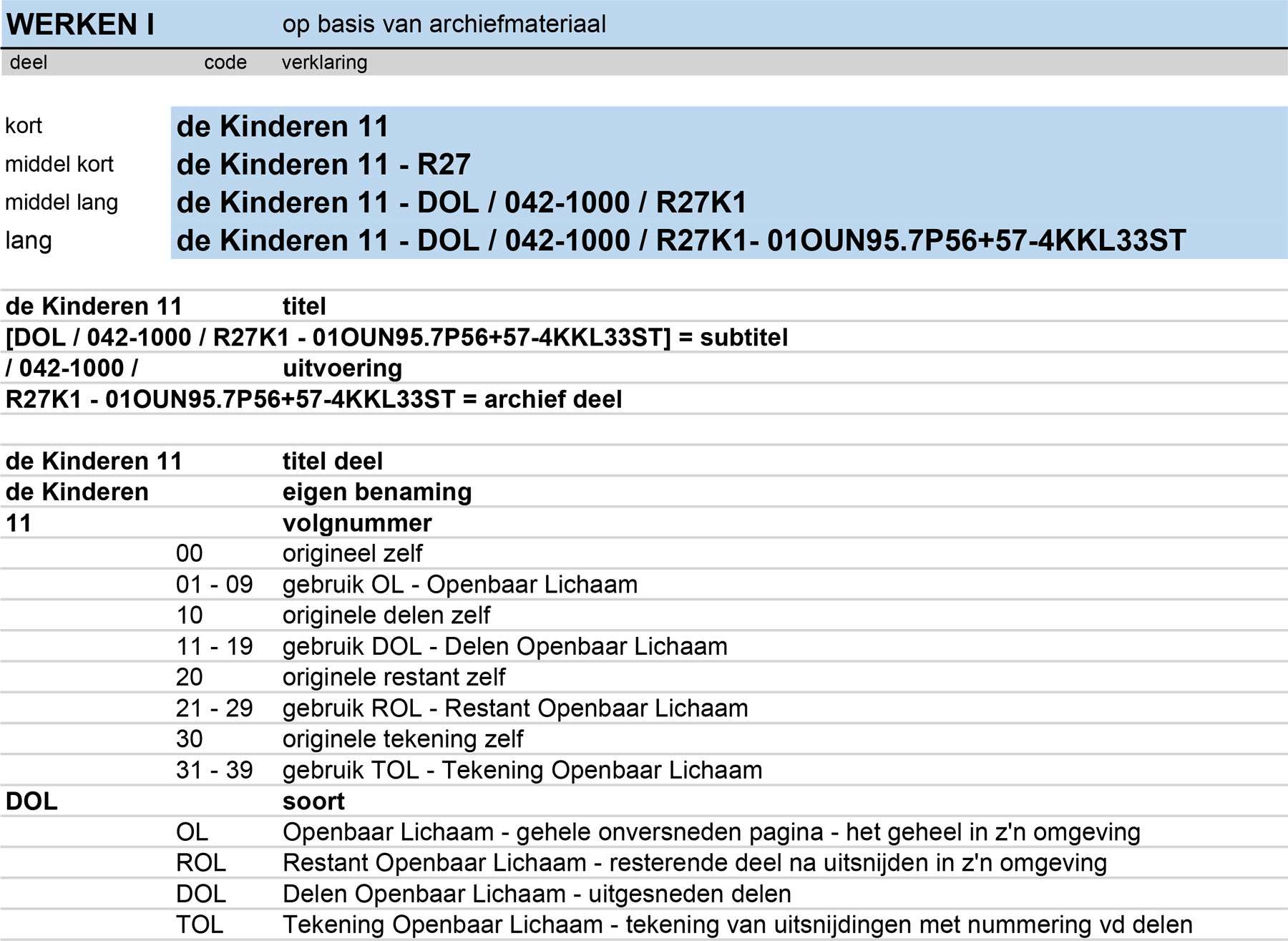
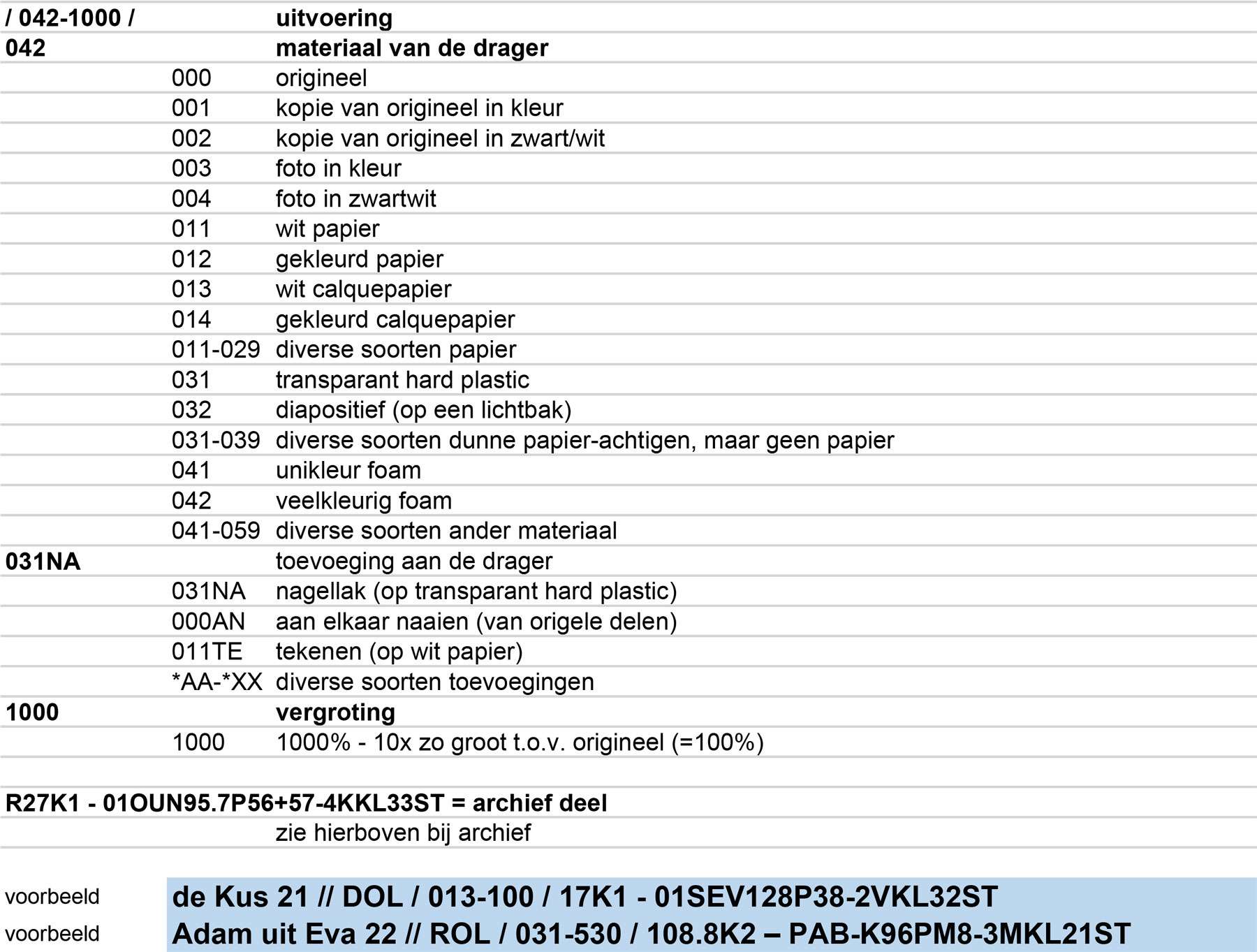

All the images used in the Institute, are generally given a standard coding.
The (N) IRPuB also works extensively with people and groups from outside the Institute. Many of the utilized and developed images, use the coding system developed by the Institute. This coding is stored in Archive.
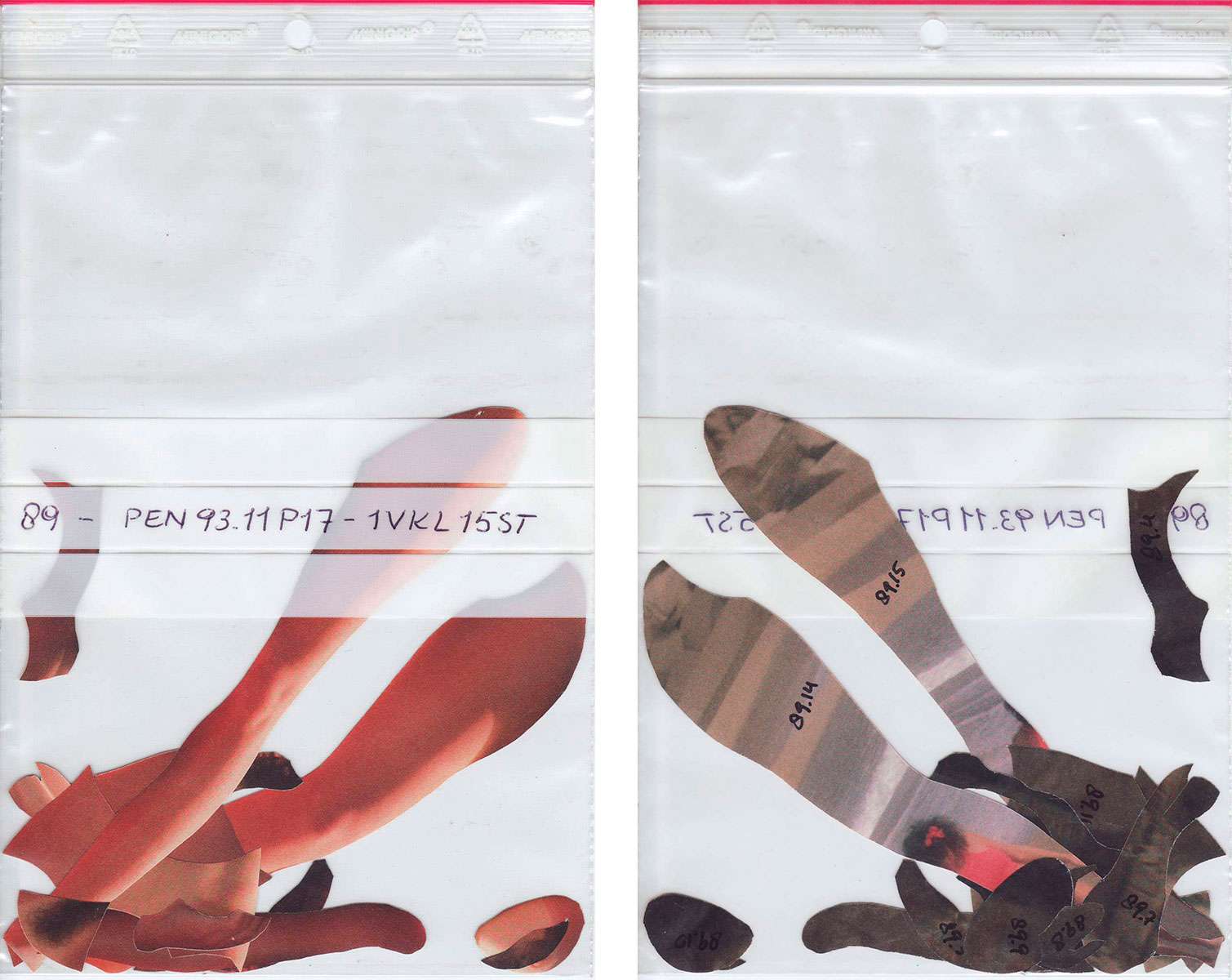
A089 - PPuB [PPuB / A089 - 01PEN93.11P17-1VKL15ST]
After an image has been chosen to be included in Archive, a cutting plan is made. Here, both internal organic forms and external shapes can be used as a guideline. Poses also influence the cutting plan.
As the Public Body is zoomed in on, the image contains more details. This means that the sections can also be smaller and more detailed. A bigger image provides more opportunity for detailed sections and examination.
The cut-out forms are the Parts Public Body (PPuB). They are each given a number that is usually written on the back and stored together in a bag which also contains the archive code of the complete image.
On the reverse side of the page to be cut out, the cutting intrudes on the image(s) and/or text there. Where the cut-out section on the cutting side shows a recognizable part of the body, the displayed image and/or text on the other side is random.
Here are the PPuB of eight examples from Archive.
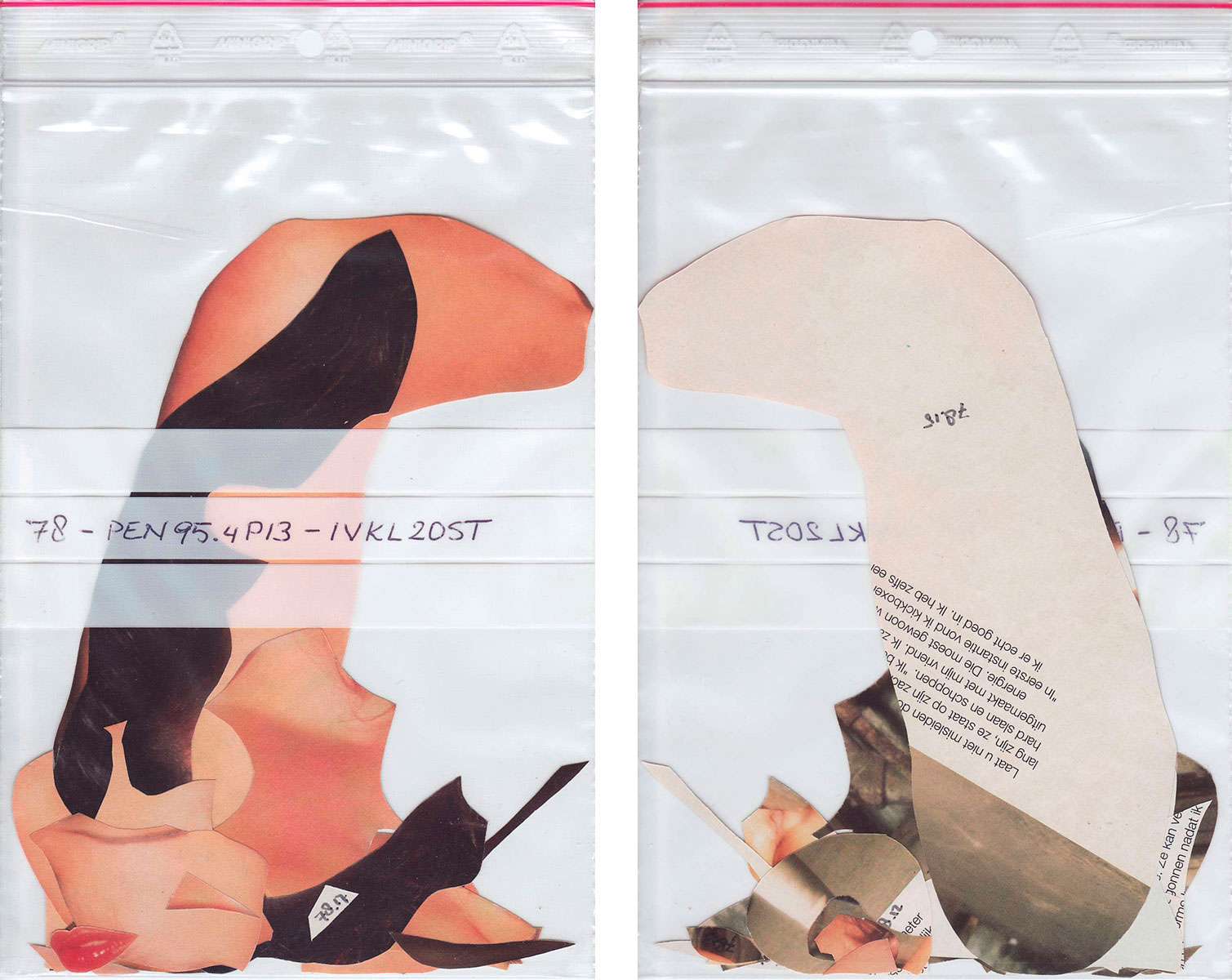 A078 – PPuB [PPuB / A078 - 01PEN95.4P13-1VKL20ST]
A078 – PPuB [PPuB / A078 - 01PEN95.4P13-1VKL20ST]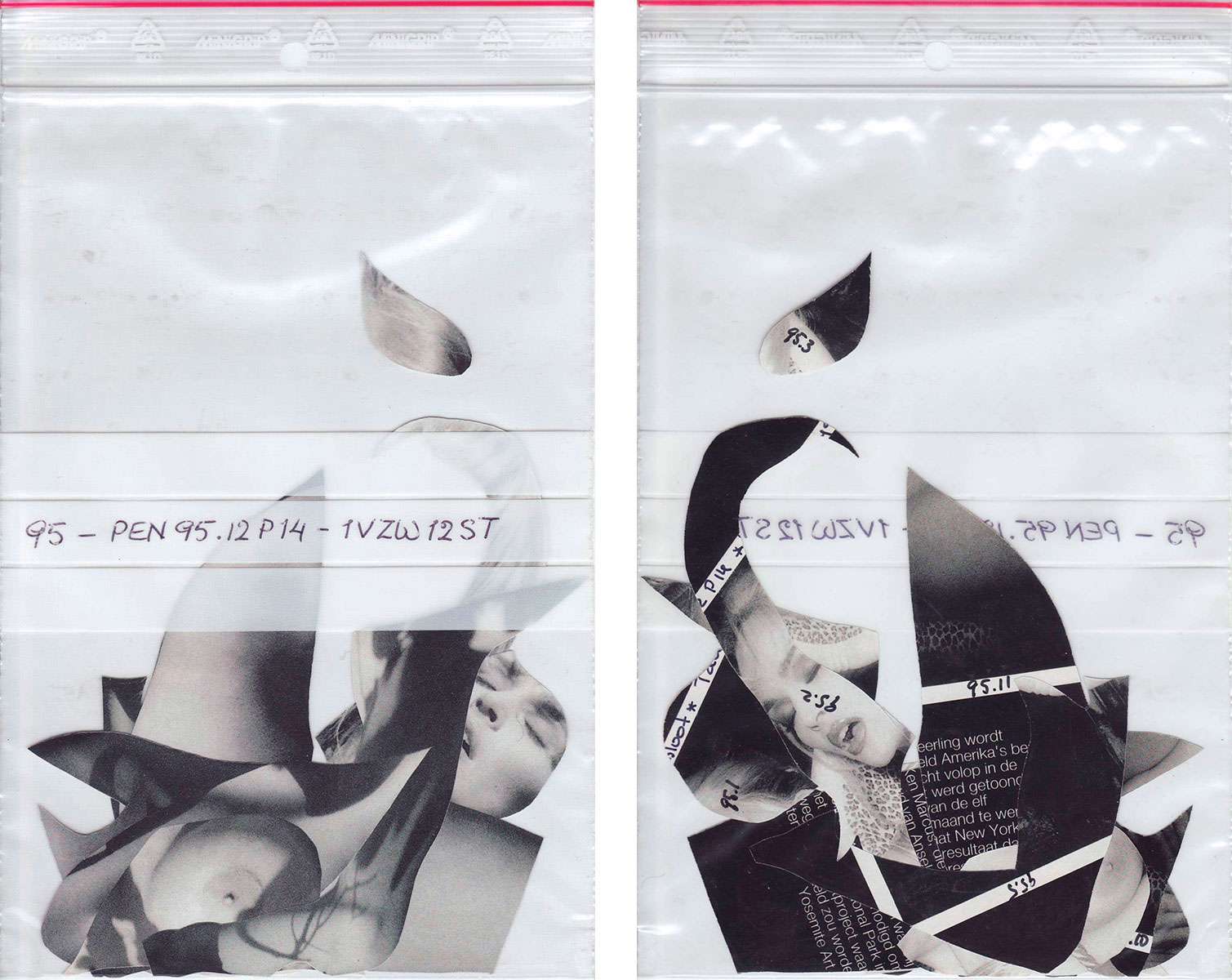 A095 – PPuB [PPuB / A095 - 01PEN95.12P14-1VZW12ST]
A095 – PPuB [PPuB / A095 - 01PEN95.12P14-1VZW12ST]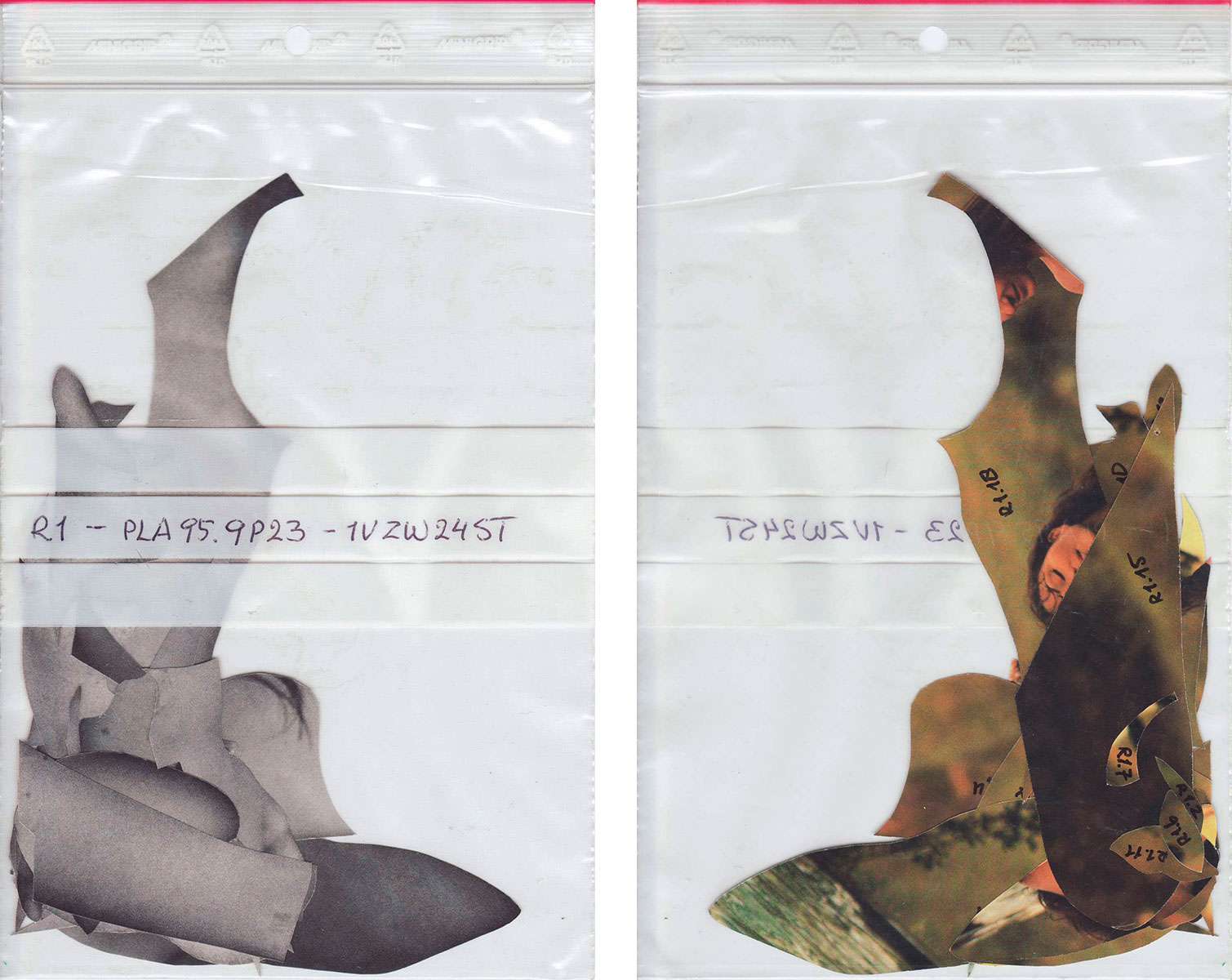 R001 – PPuB [PPuB / AR001 - 01PLA95.9P23-1VZW24ST]
R001 – PPuB [PPuB / AR001 - 01PLA95.9P23-1VZW24ST]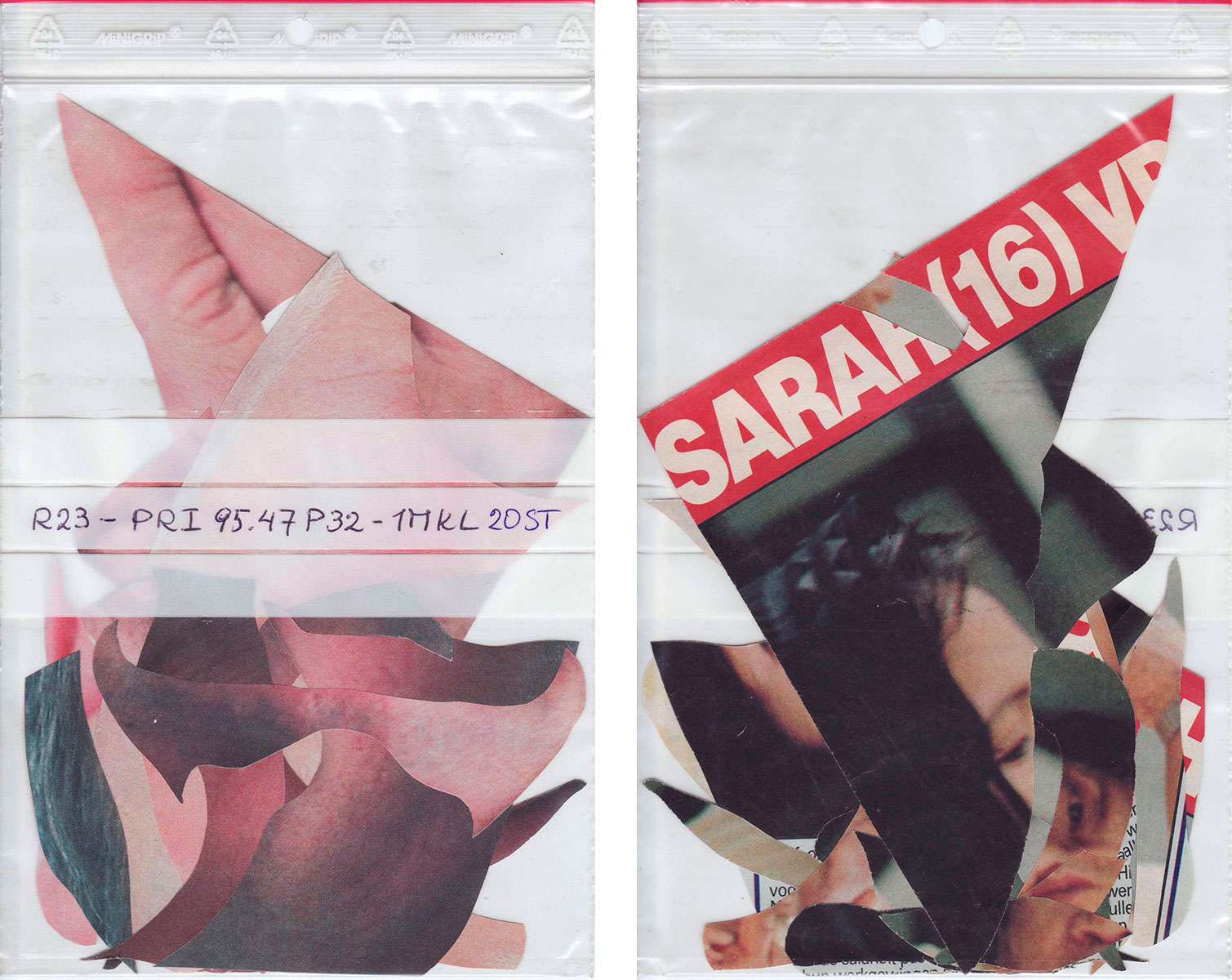 R023 – PPuB [PPuB / AR023 - 01PRI95.47P32-1MKL20ST]
R023 – PPuB [PPuB / AR023 - 01PRI95.47P32-1MKL20ST]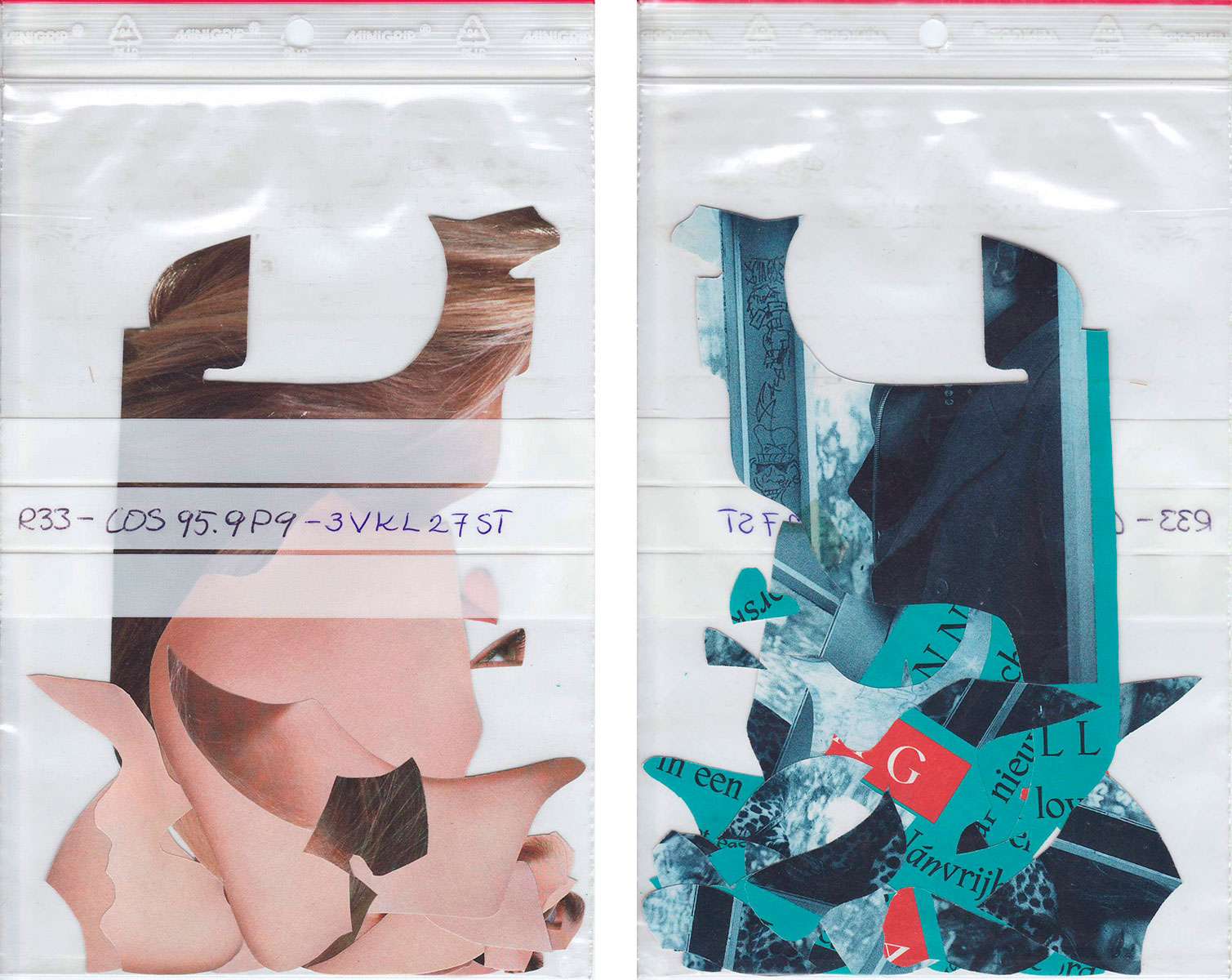 R033 – PPuB [PPuB / AR033 - 01COS95.9P9-3VKL27ST]
R033 – PPuB [PPuB / AR033 - 01COS95.9P9-3VKL27ST]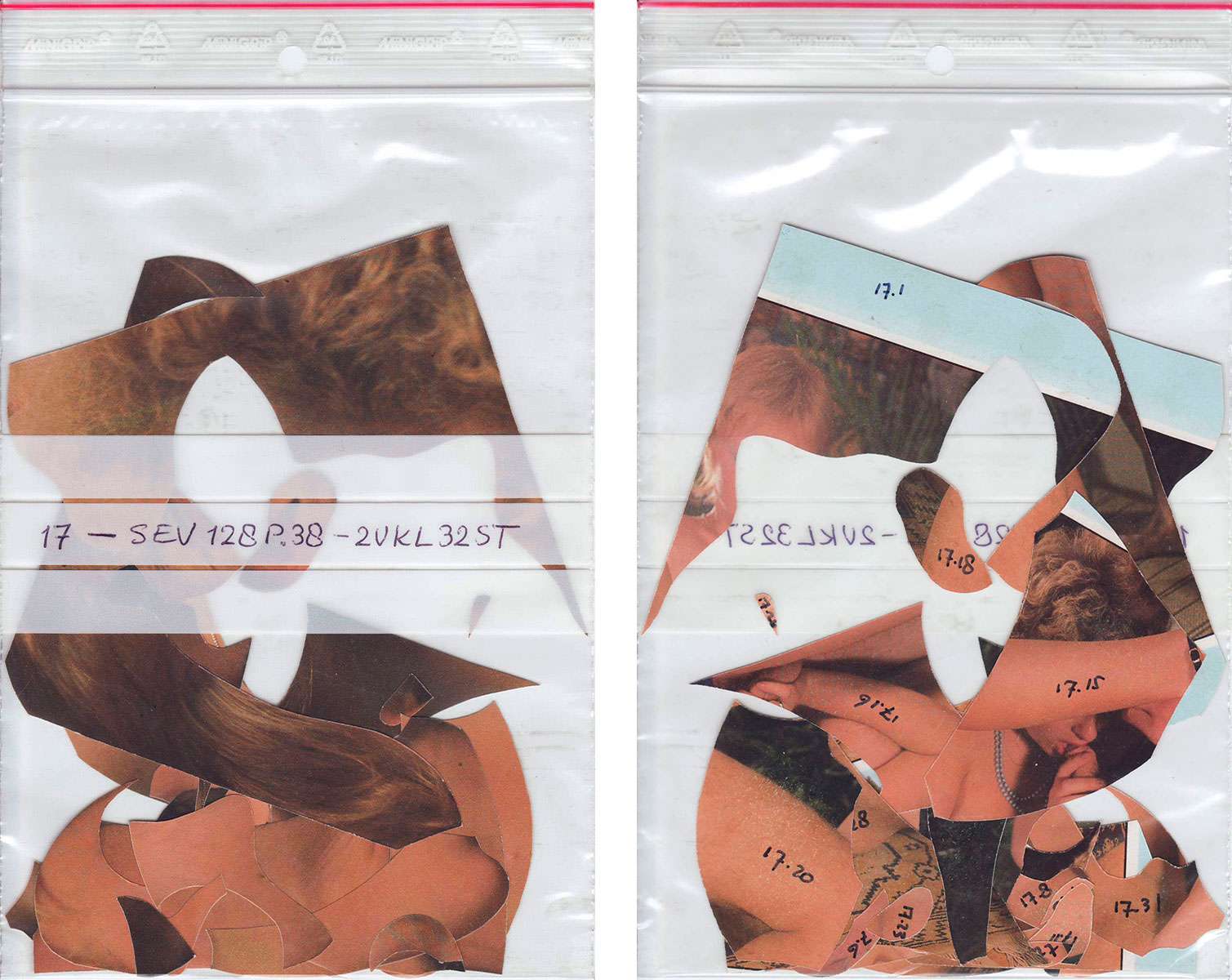 A017 – PPuB [PPuB / A017 - 01SEV128P38-2VKL32ST]
A017 – PPuB [PPuB / A017 - 01SEV128P38-2VKL32ST]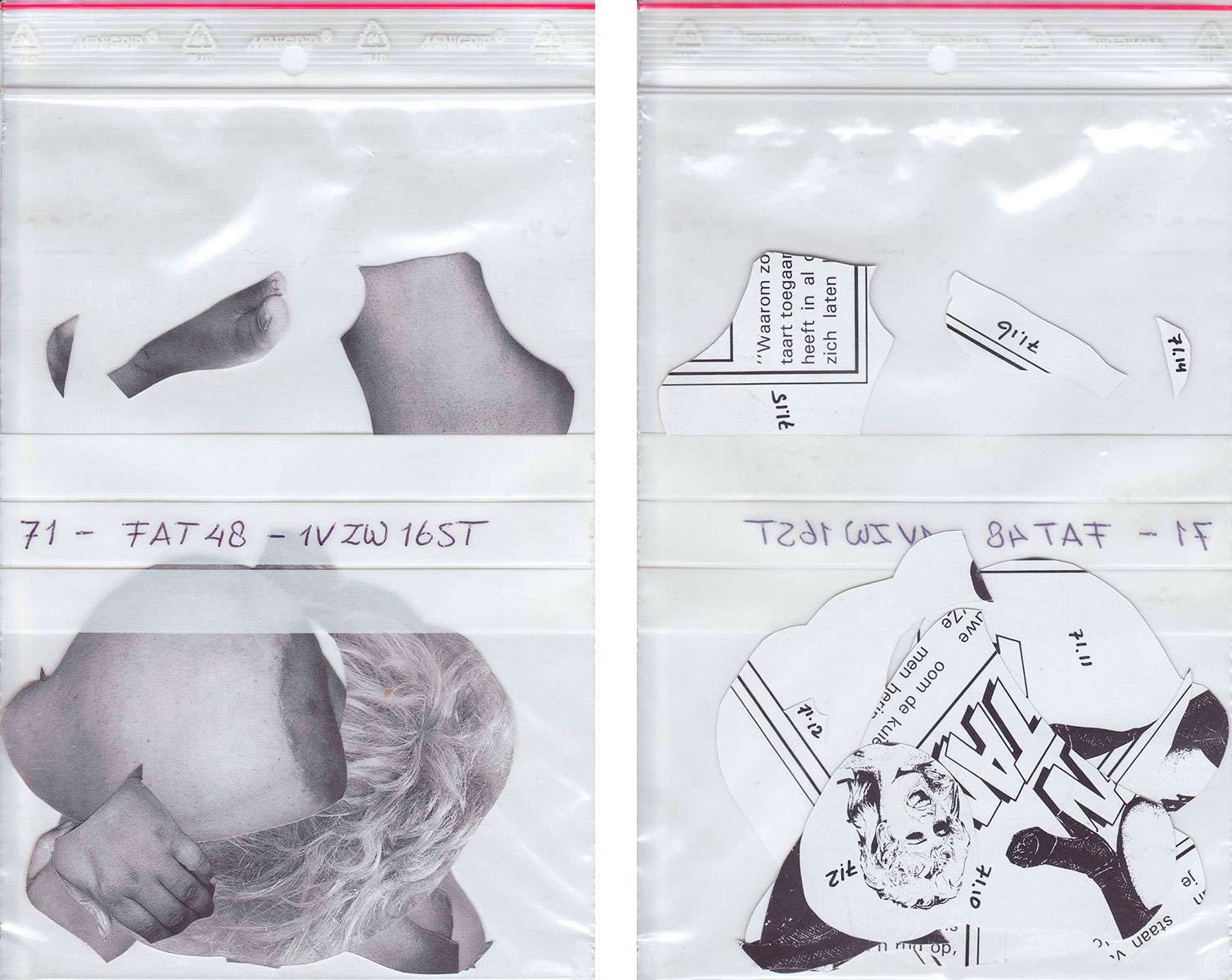 A071 – PPuB [PPuB / A071 - 01FAT48-1VZW16ST]
A071 – PPuB [PPuB / A071 - 01FAT48-1VZW16ST]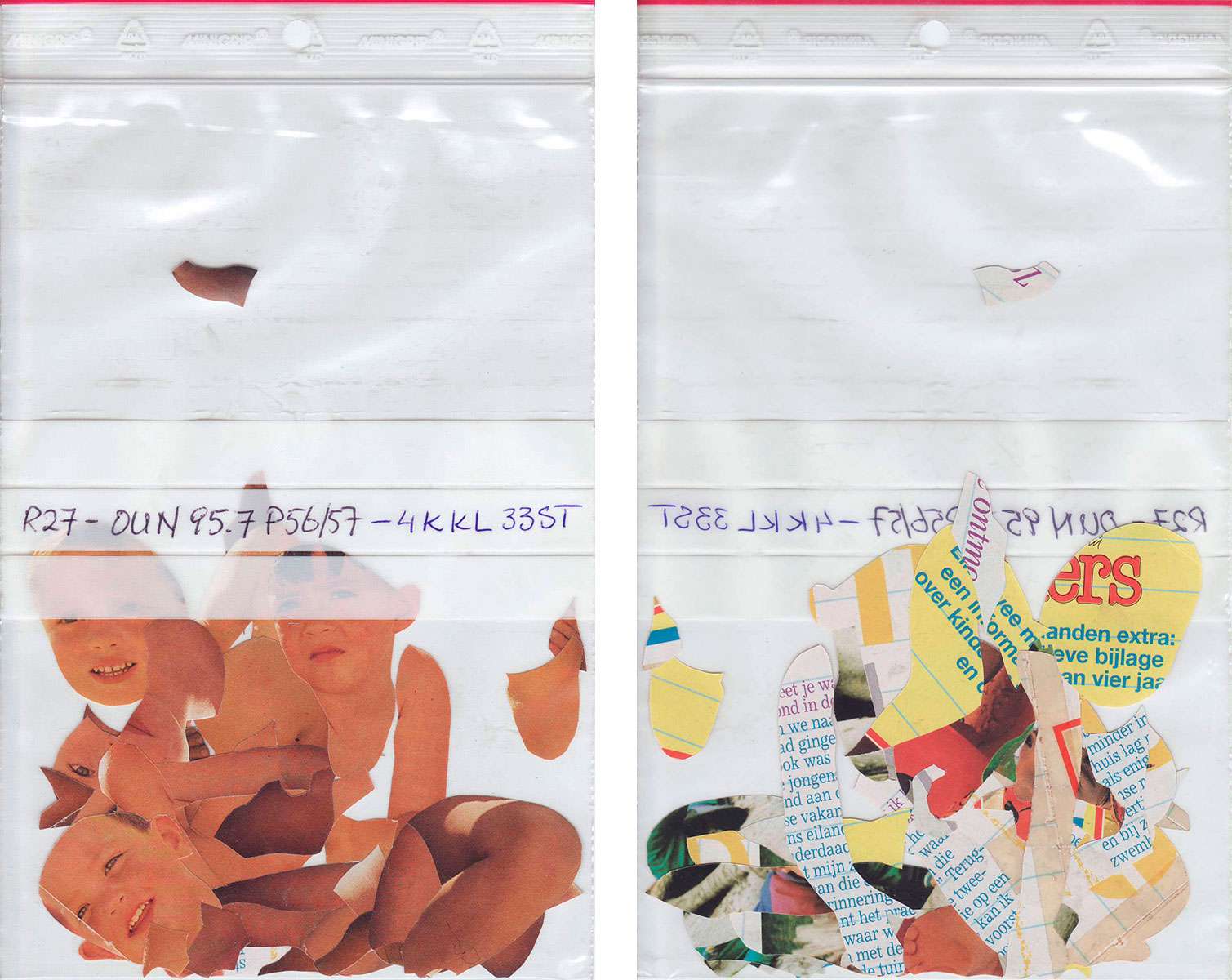 R027 – PPuB [PPuB / AR027 - 01OUN95.7P56+57-4KKL33ST]
R027 – PPuB [PPuB / AR027 - 01OUN95.7P56+57-4KKL33ST]
Due to the choice to cut out certain parts of the image, these sections are emphasized. A hand is a hand but a separated hand evokes something different from a hand attached to a body. The emphasis is placed on the part itself and its shape, and less on its function.
On an image, the hand may be displayed at a strange angle, or only partially visible. In the complete image, a half-hidden hand is still just a hand, but the cut-out section results in a bizarre, new shape. Taken out of context, the new shape is not an image of a half-hidden hand but an image of half a hand.
Scroll horizontally below for a number of PPuB from Archive.
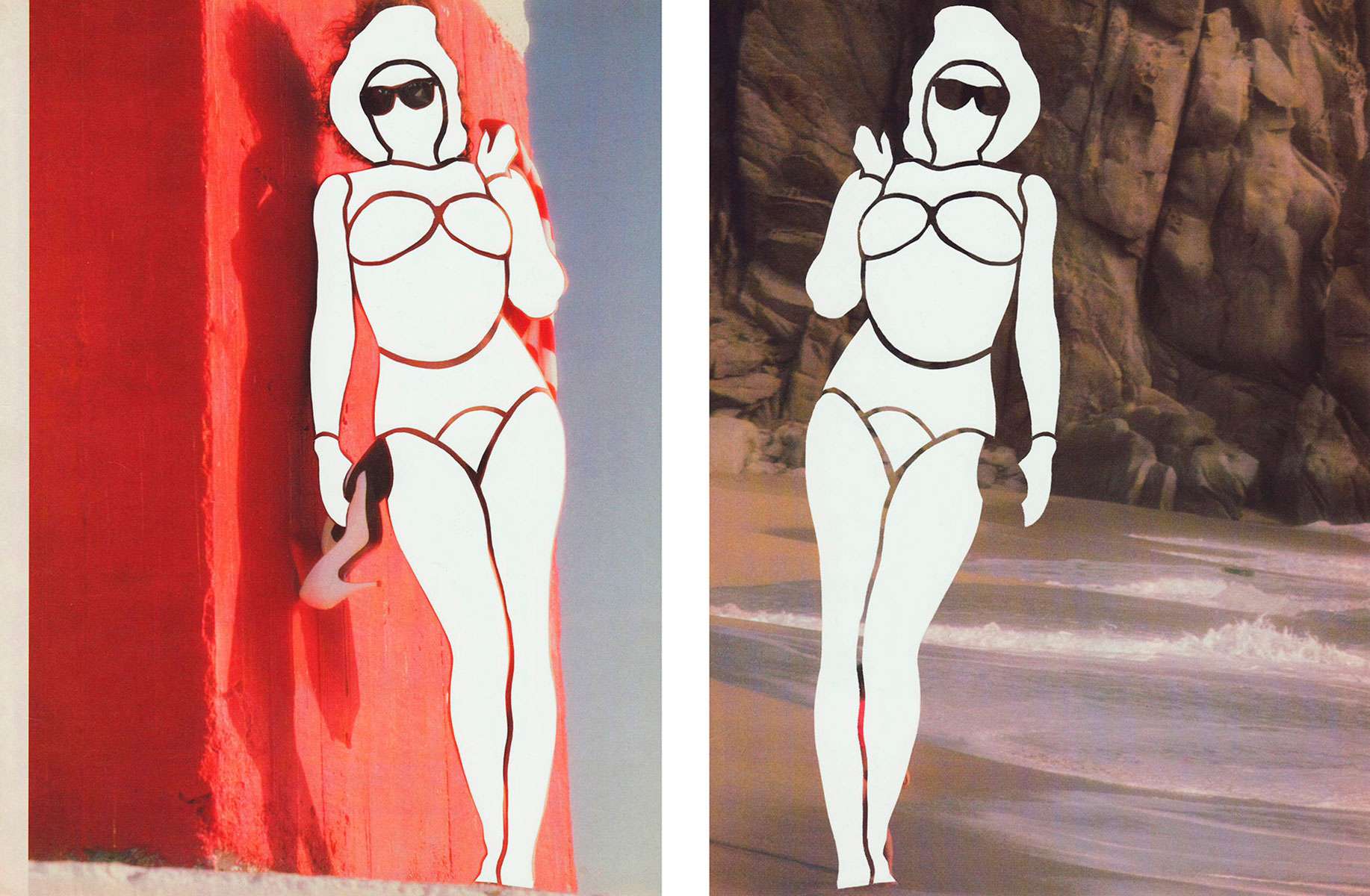 A089 – RPuB [RPuB / A089 - 01PEN93.11P17-1VKL15ST]
A089 – RPuB [RPuB / A089 - 01PEN93.11P17-1VKL15ST]
After the cutting plan has been decided, the image of the Body is carefully cut out. In all cases, the form, the structure and the unity of a specifically portrayed Body is left intact during cutting. When cutting out (parts of) the Public Body the remaining part (RPG) stays intact. This remaining part displays the construction and structure of the Body, as though the intrusion with the image has exposed an underlying construction. As the cutting away becomes more and more detailed, a more detailed Remains (RPG) is left over.
On the reverse side of the page to be cut out, the cutting results in an intrusion with the image(s) and/or text present there. ‘Holes’ are created, as it were. Depending on the chosen cutting plan the grouping of the ‘holes’ can still or once again evoke the (memory of a) Body. On the reverse side, therefore, information or a memory is added that runs right across the existing image or text. The two sides also enter into a more direct relationship with each other.
The RPuB of the same eight examples from the Archive follow below.
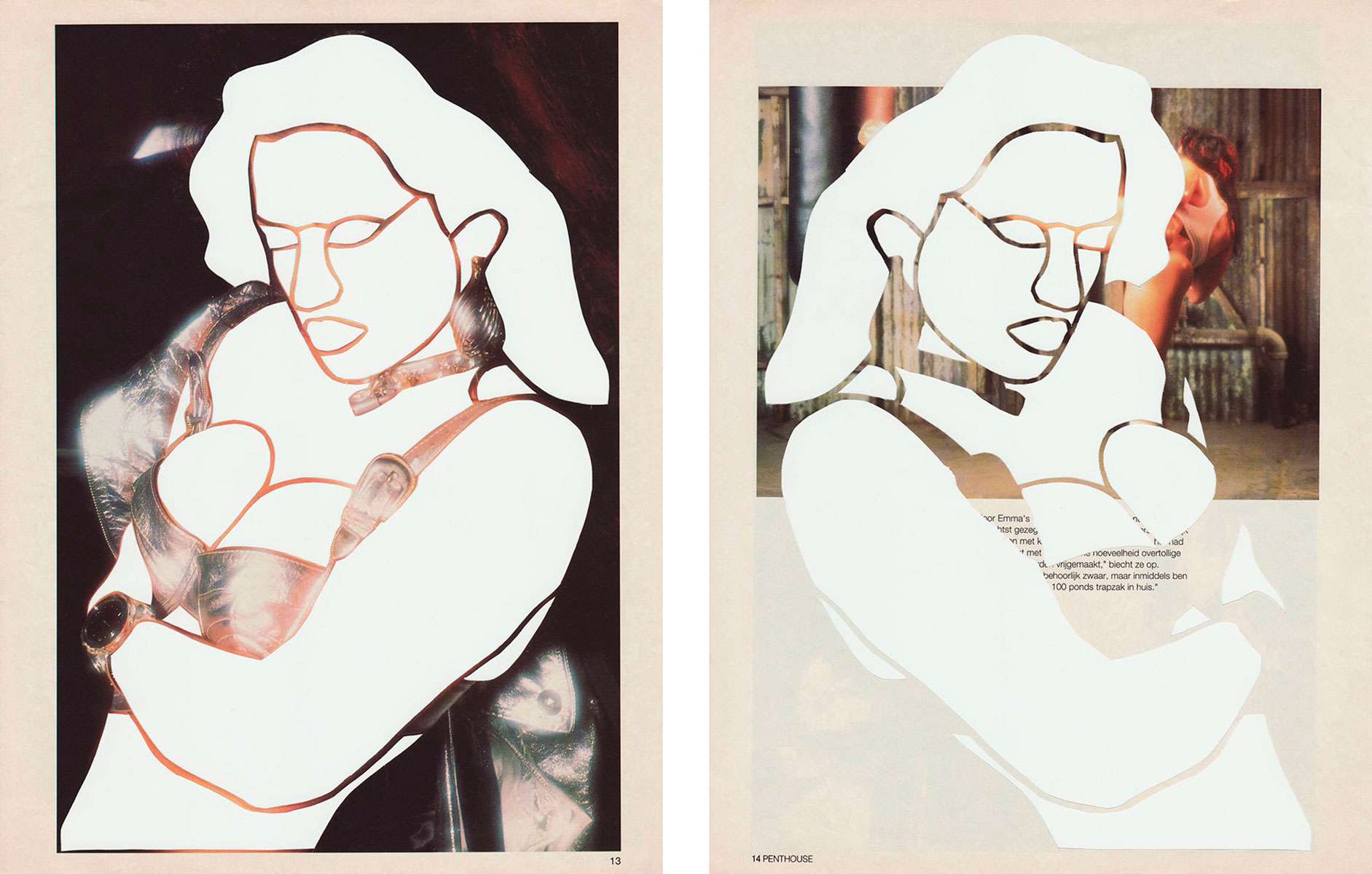 A078 – RPuB [RPuB / A078 - 01PEN95.4P13-1VKL20ST]
A078 – RPuB [RPuB / A078 - 01PEN95.4P13-1VKL20ST]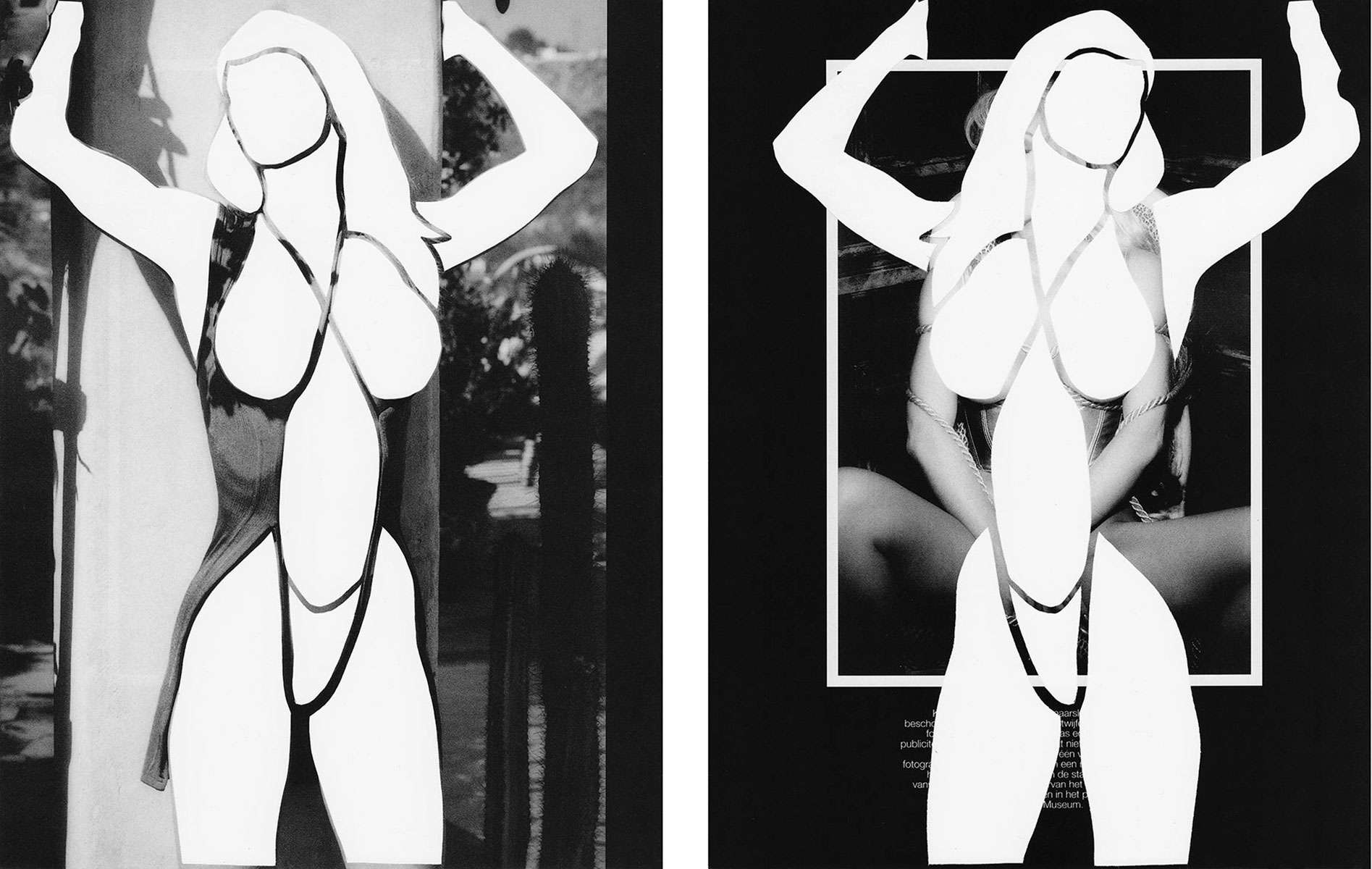 A095 – RPuB [RPuB / A095 - 01PEN95.12P14-1VZW12ST]
A095 – RPuB [RPuB / A095 - 01PEN95.12P14-1VZW12ST]
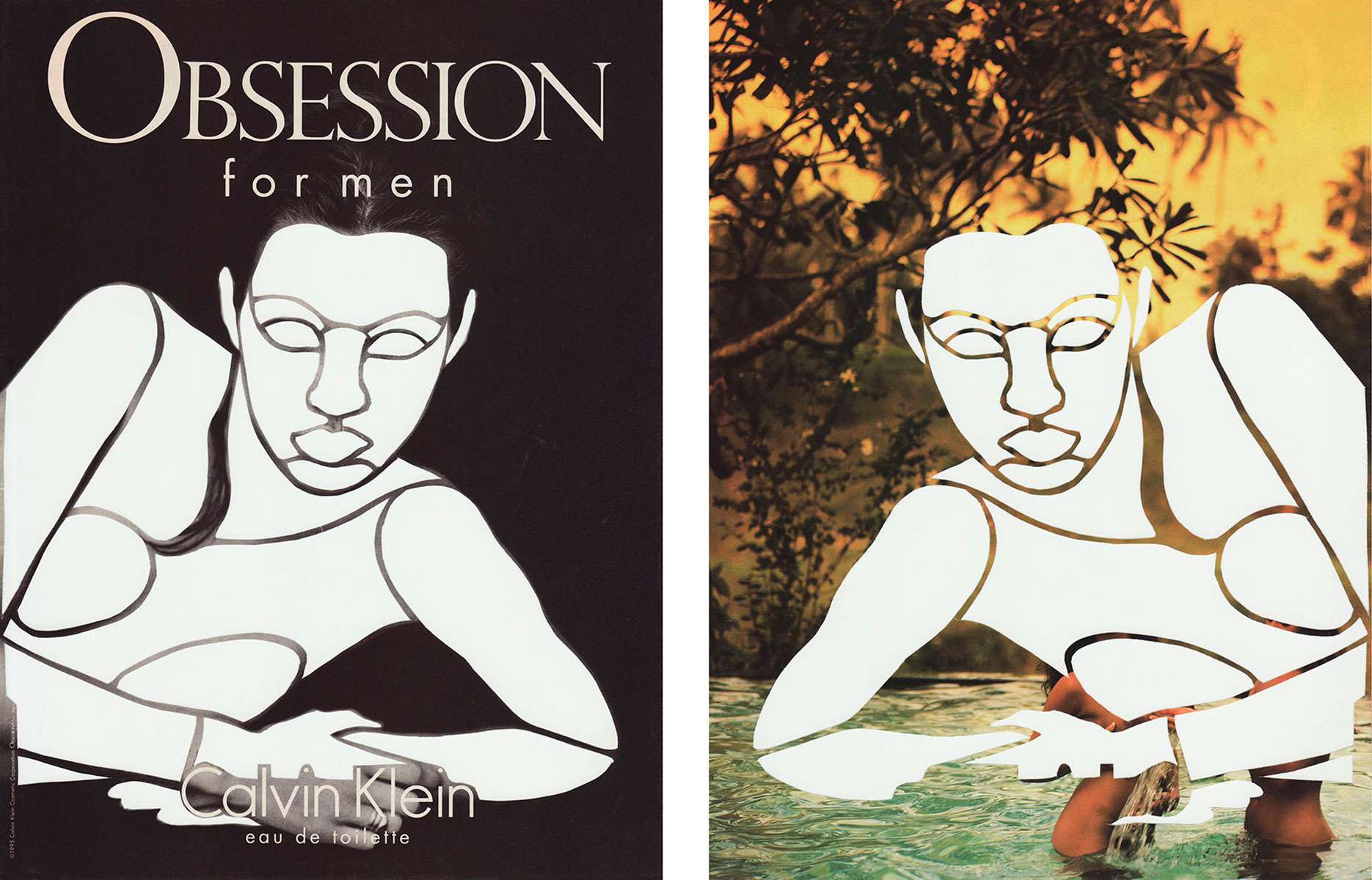 R001 – RPuB [RPuB / AR001 - 01PLA95.9P23-1VZW24ST]
R001 – RPuB [RPuB / AR001 - 01PLA95.9P23-1VZW24ST]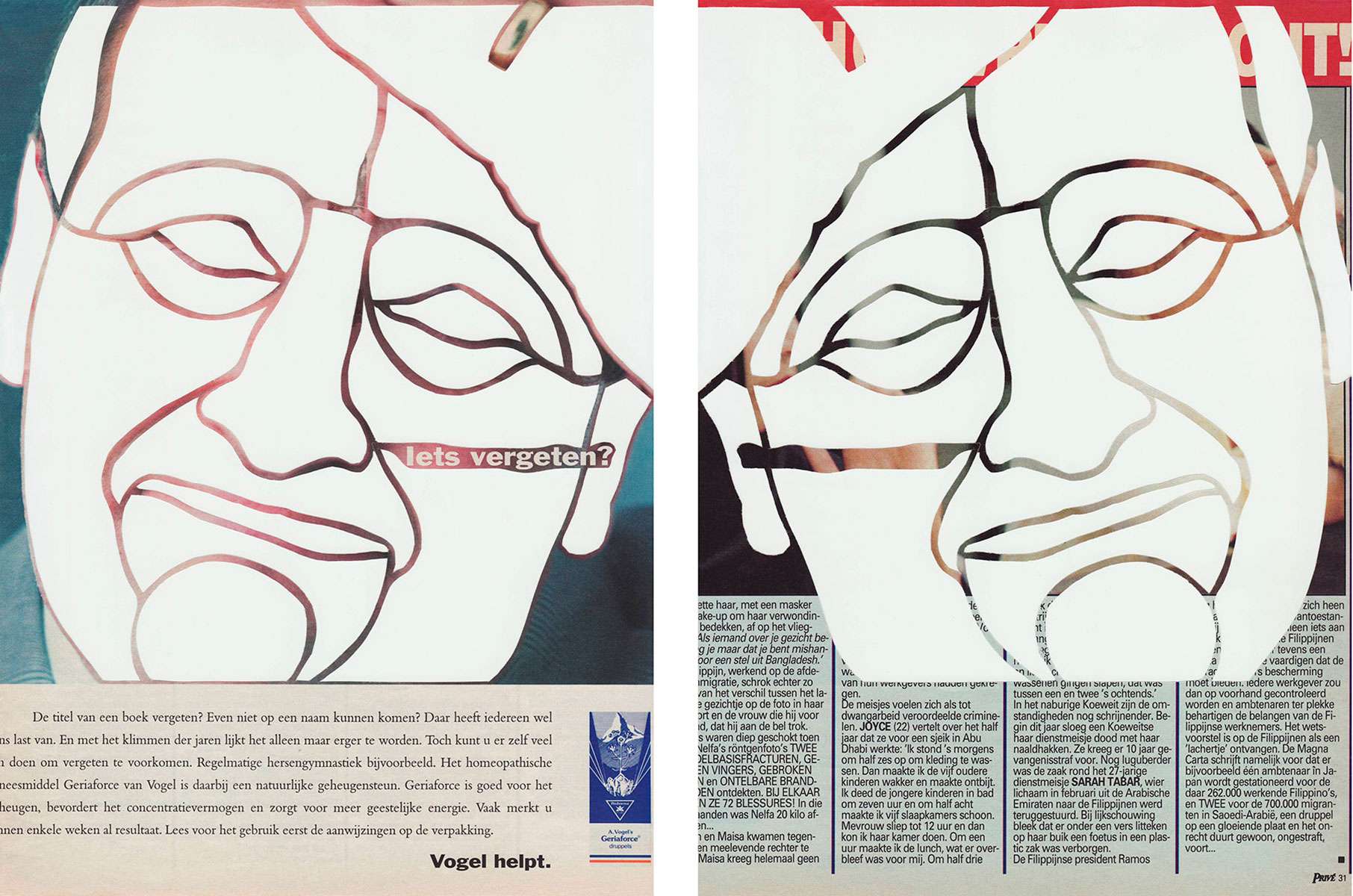 R023 – RPuB [RPuB / AR023 - 01PRI95.47P32-1MKL20ST]
R023 – RPuB [RPuB / AR023 - 01PRI95.47P32-1MKL20ST] R033 – RPuB [RPuB / AR033 - 01COS95.9P9-3VKL27ST]
R033 – RPuB [RPuB / AR033 - 01COS95.9P9-3VKL27ST]
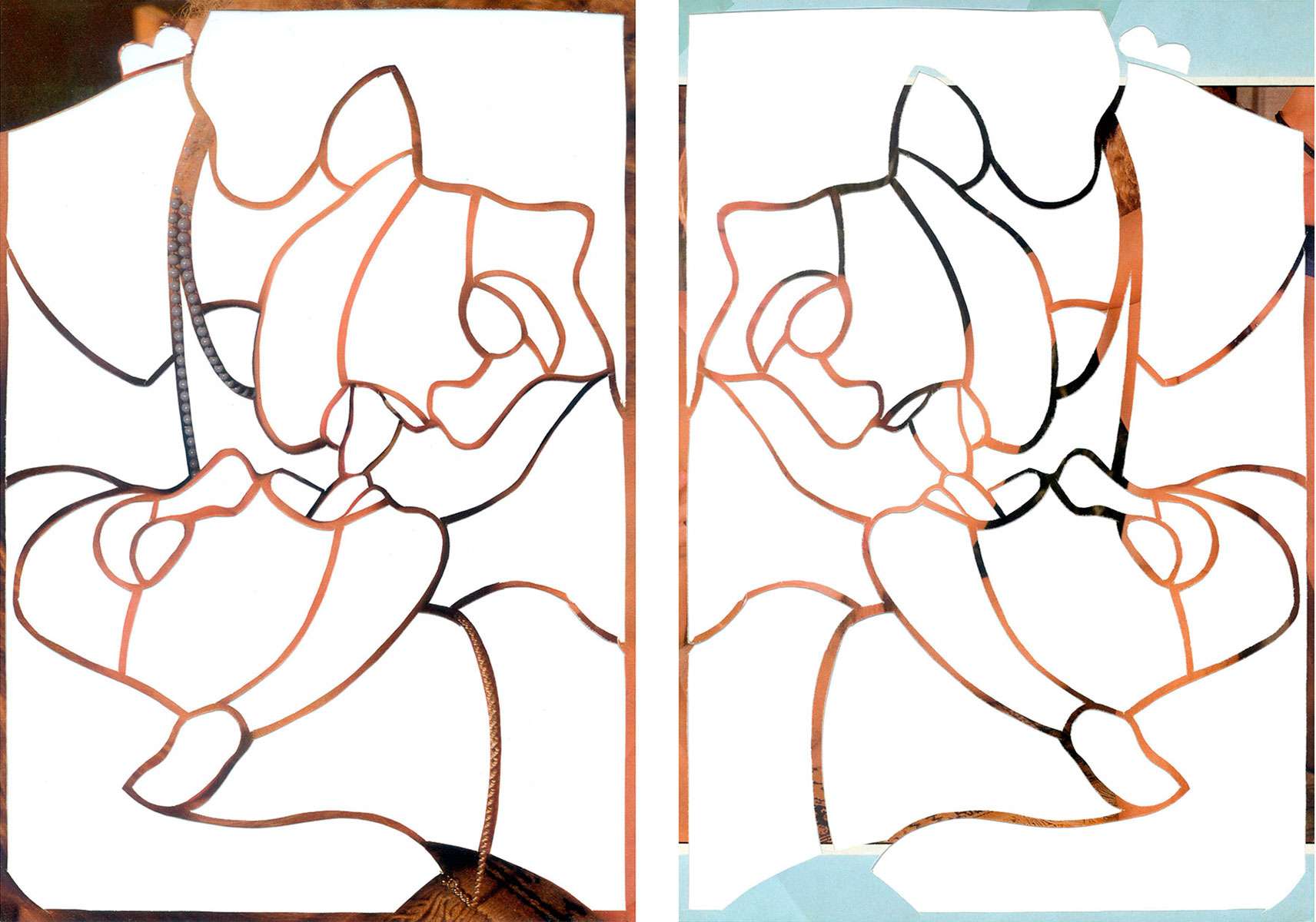 A017 – RPuB [RPuB / A017 - 01SEV128P38-2VKL32ST]
A017 – RPuB [RPuB / A017 - 01SEV128P38-2VKL32ST]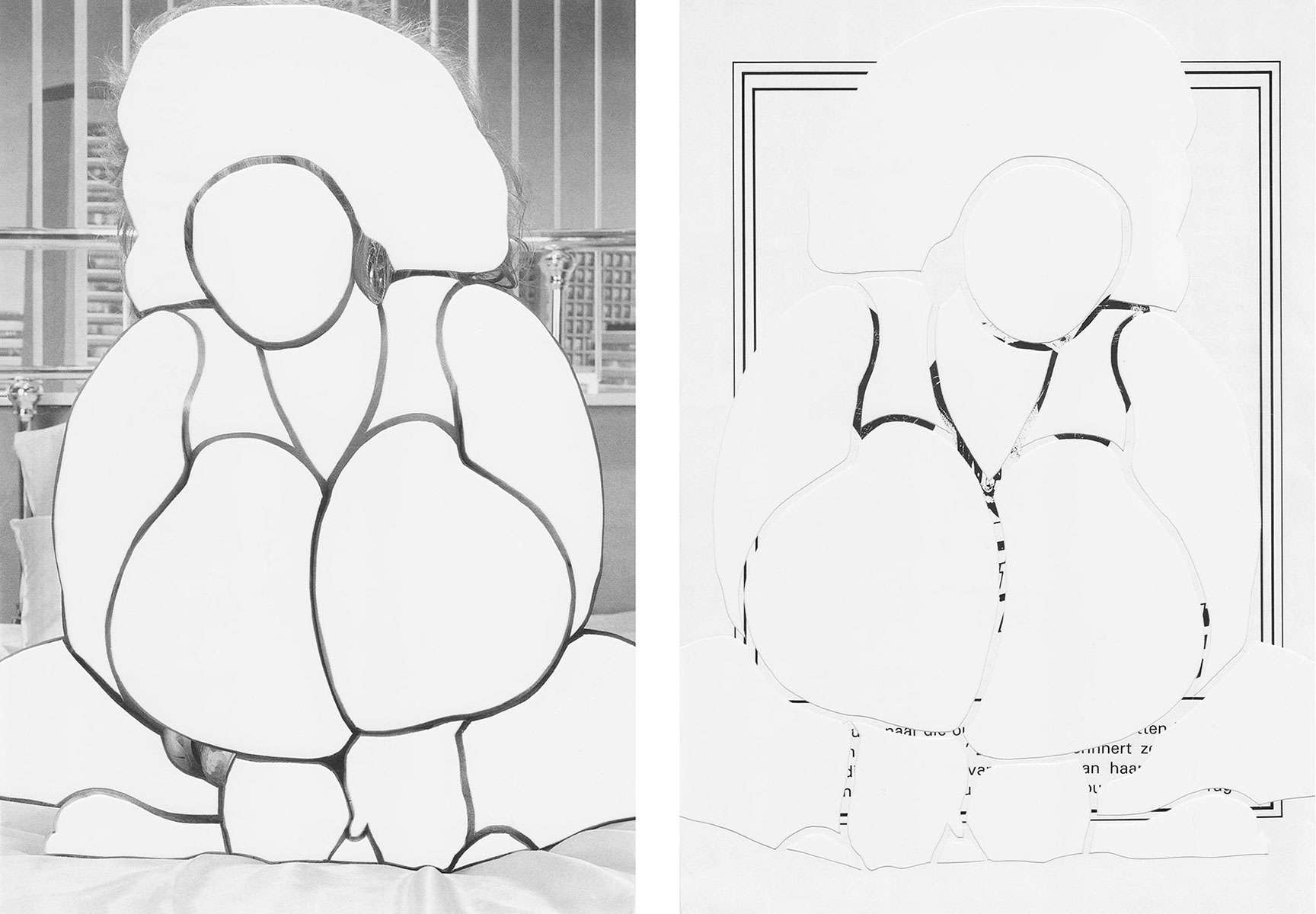 A071 – RPuB [RPuB / A071 - 01FAT48-1VZW16ST]
A071 – RPuB [RPuB / A071 - 01FAT48-1VZW16ST]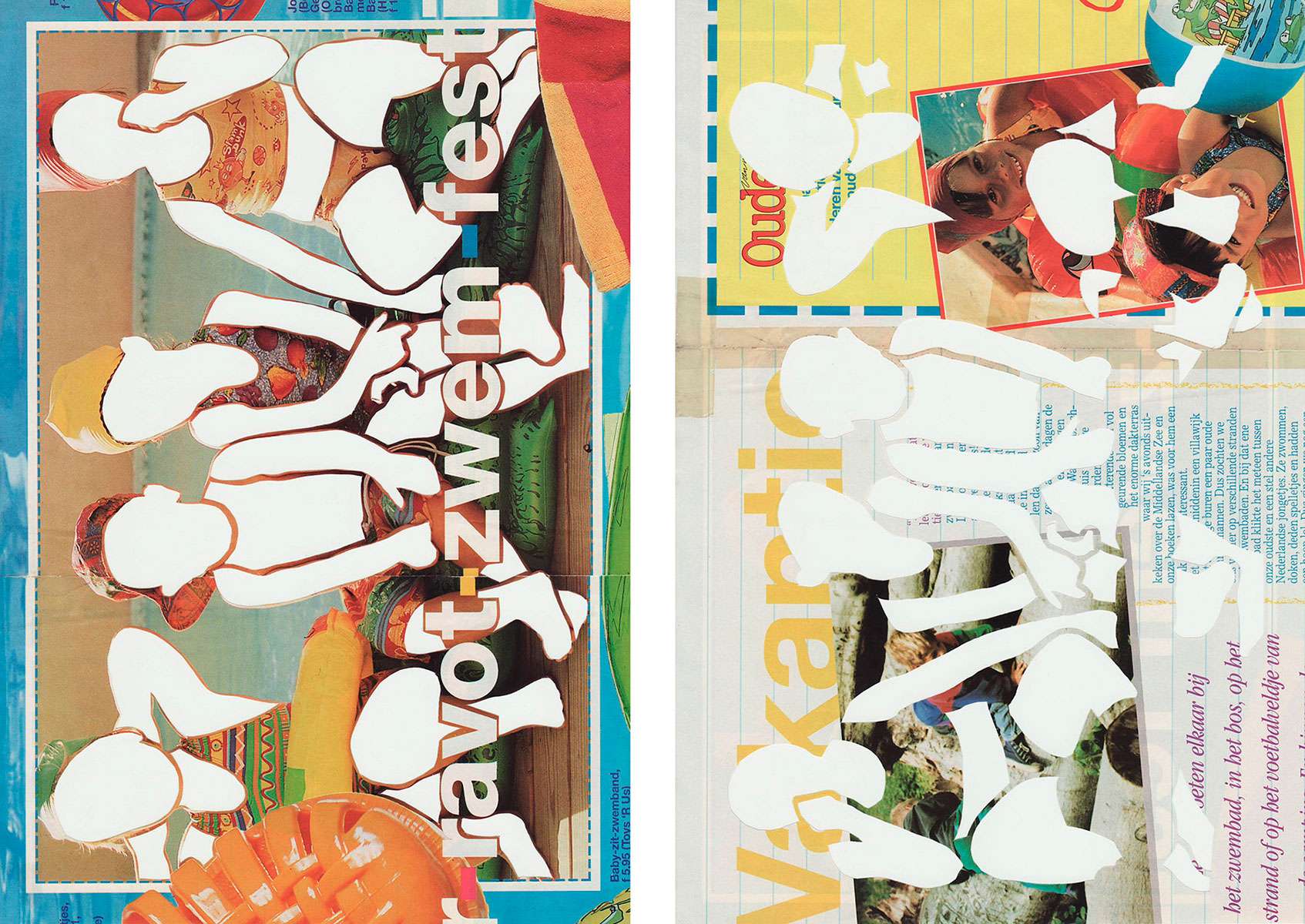 R027 – RPuB [RPuB / AR027 - 01OUN95.7P56+57-4KKL33ST]
R027 – RPuB [RPuB / AR027 - 01OUN95.7P56+57-4KKL33ST]
By removing most of the image, the opportunity to discover more content arises. The combination of a remaining (outer) form and the space within it offers extra possibilities for expression, there is literally more space to look further.
Ultimately, the view is no longer stopped by the closed outside, but goes further and deeper and gains a better view of the inside of the body. By taking away, something is also added to the image.
On the other side of the chosen image, there is an image and/or text, either on the same topic or not. Before the process, the two sides are separate from each other and as such cannot be looked at and/or read simultaneously. By cutting, the space that is created in the image also appears on the other side. The choice of cutting plan and cutting out on one side, is a correspondingly important intrusion on the other side. A reflection of the cut-out image emerges. Intrusion in the original image creates room for a blending of the content of both sides. In this way, previously separate images and/or text enter ‘in-page’ into a (new) relationship.
Scroll horizontally below for more RPuB from Archive.
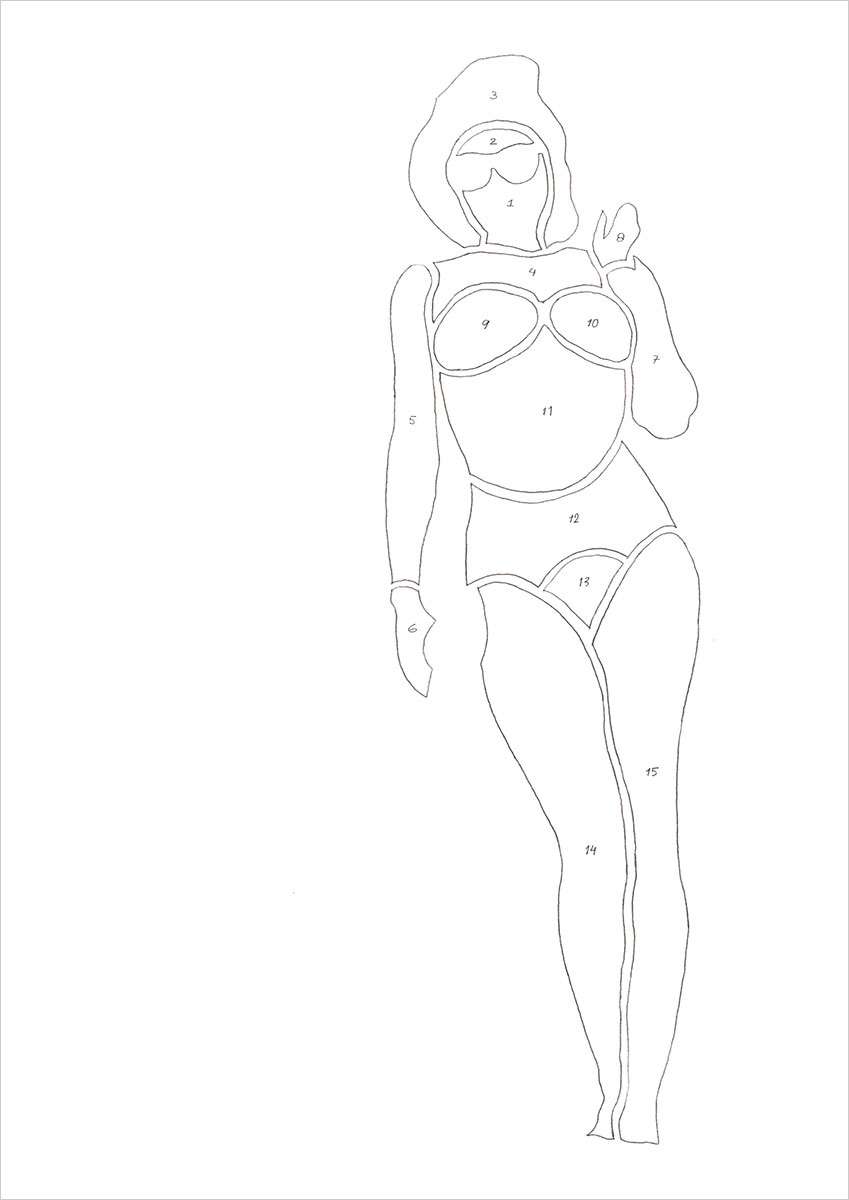 A089 – DPuB [DPuB / A089 - 01PEN93.11P17-1VKL15ST]
A089 – DPuB [DPuB / A089 - 01PEN93.11P17-1VKL15ST]
The way in which the image will ultimately be cut out, is set out in a drawing (DPuB). The remainder of the image, with the holes that have ‘emerged’, is used to trace the separate parts onto a neutral, white background. This drawing sets out where the parts have been cut out and what their mutual relationship is. This is emphasized since the numbers assigned to the parts, are listed in the drawing with pencil.
The drawing (DPuB) supplements the PPuB, the cut-out parts belonging to an image, and the RPuB, the remainder with the structure of the Body in the image. In relation to the PPuB, the DPuB shows where each part originated and in relation to the RPuB it is a positive image of the ‘holes’ without the help of the leftover remnant image. The DPuB also corresponds to the original cutting plan, whereby the cutting cycle is complete and the choice recorded.
The DPuB of the same eight examples from the Archive follow below.
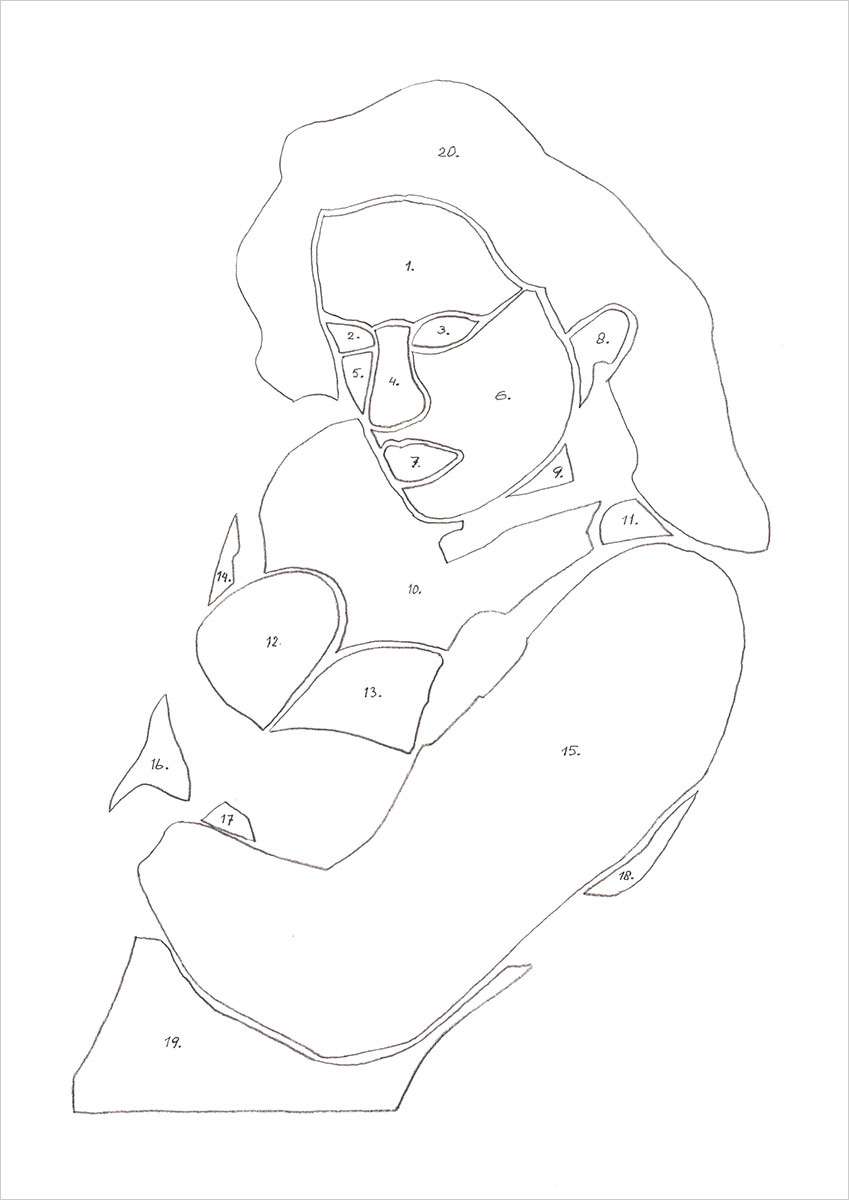 A078 – DPuB [DPuB / A078 - 01PEN95.4P13-1VKL20ST]
A078 – DPuB [DPuB / A078 - 01PEN95.4P13-1VKL20ST]
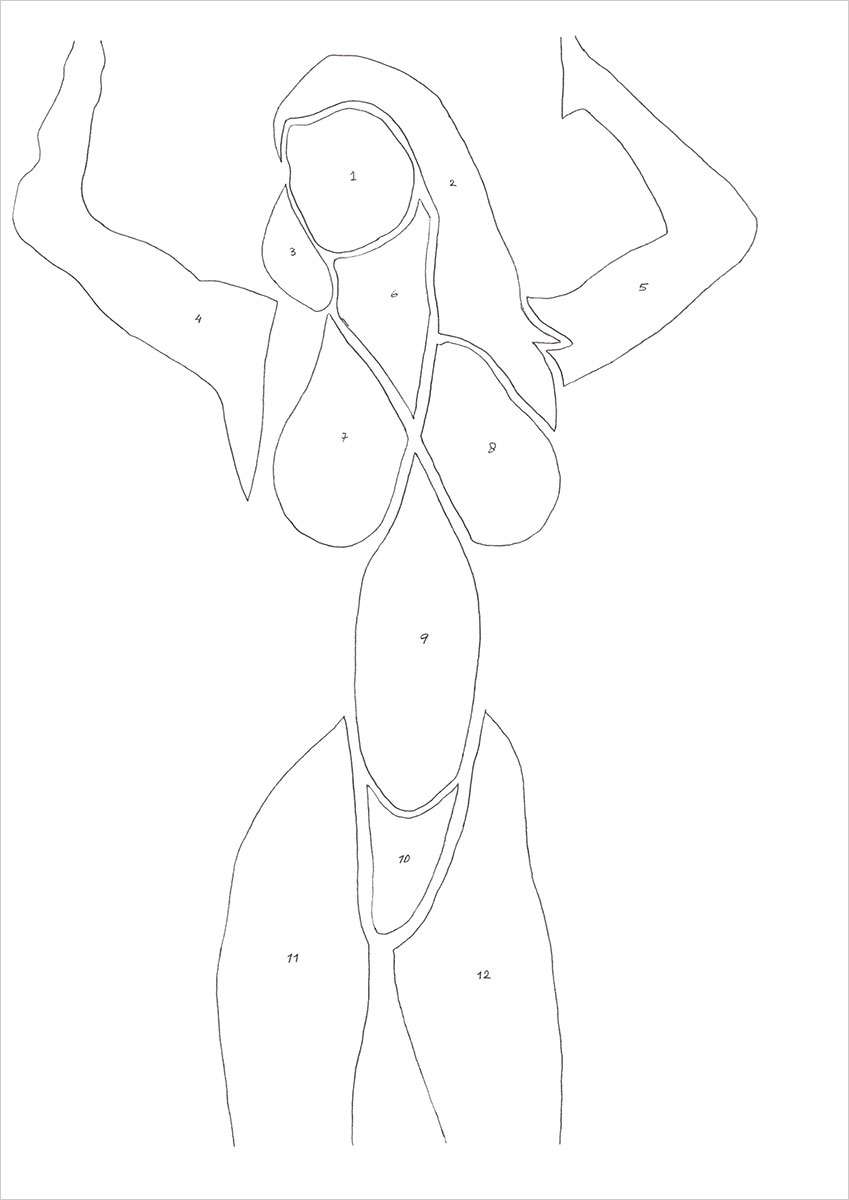 A095 – DPuB [DPuB / A095 - 01PEN95.12P14-1VZW12ST]
A095 – DPuB [DPuB / A095 - 01PEN95.12P14-1VZW12ST]
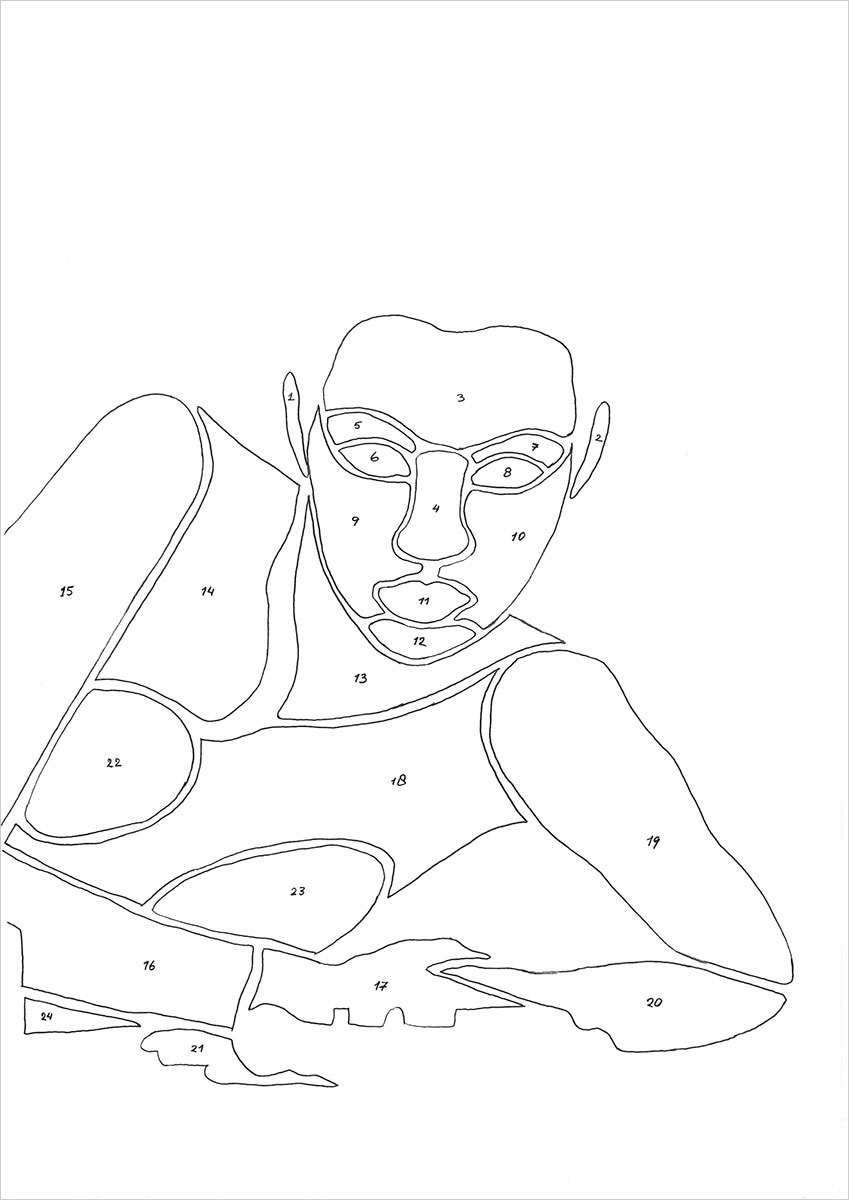
R001 – DPuB [DPuB / AR001 - 01PLA95.9P23-1VZW24ST]
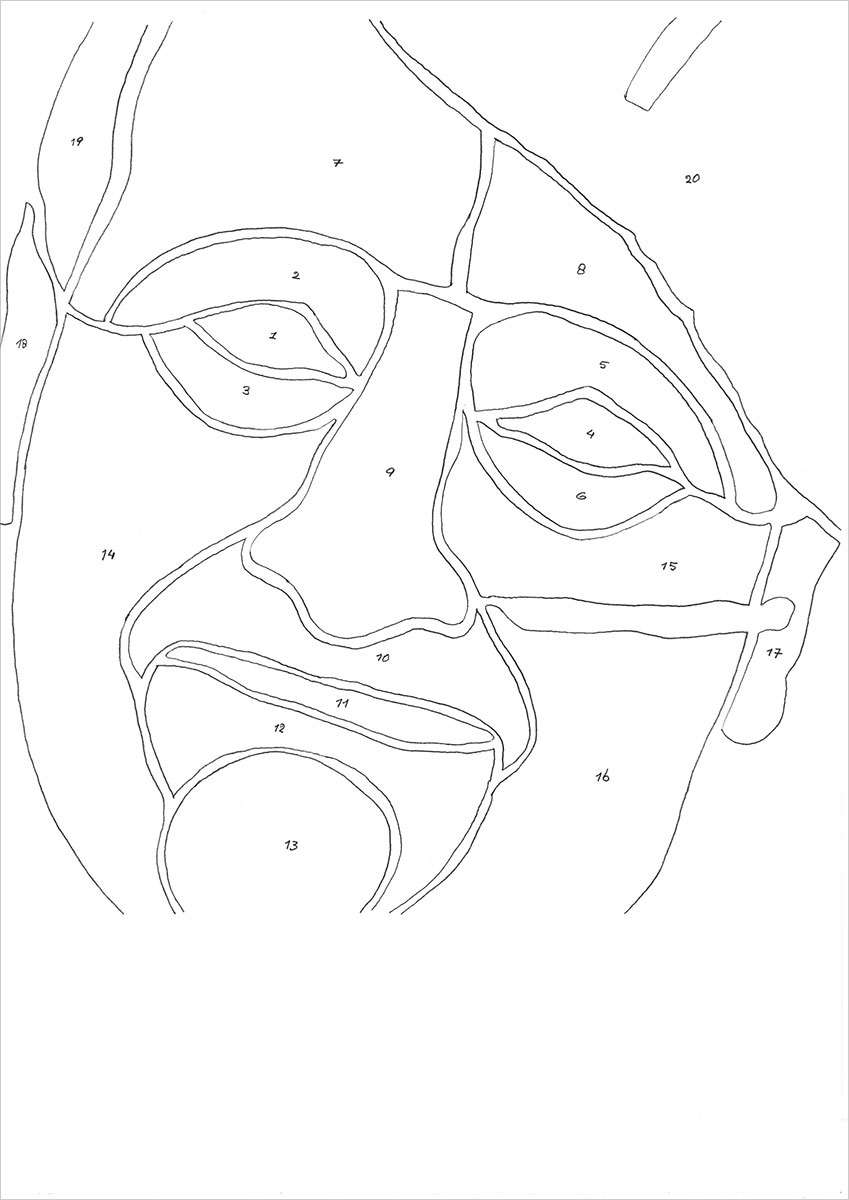
R023 – DPuB [DPuB / AR023 - 01PRI95.47P32-1MKL20ST]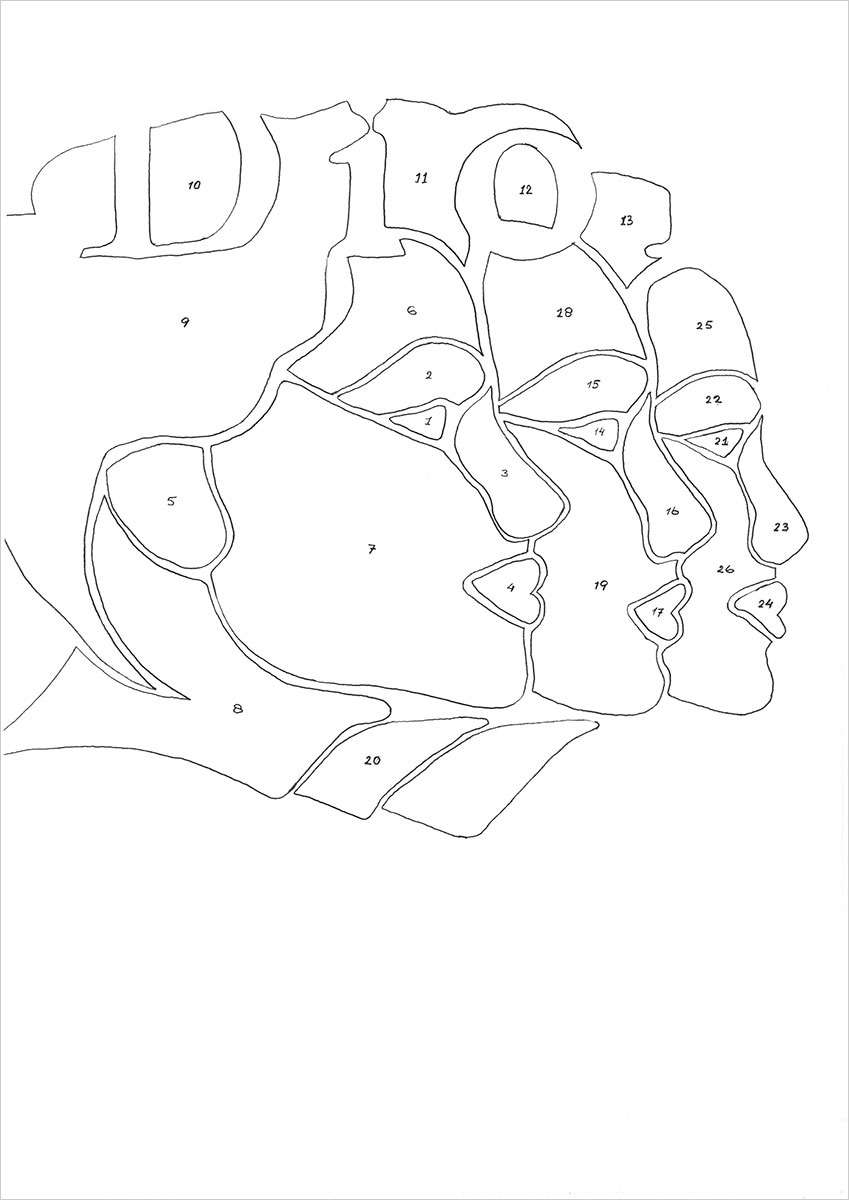
R033 – DPuB [DPuB / AR033 - 01COS95.9P9-3VKL27ST]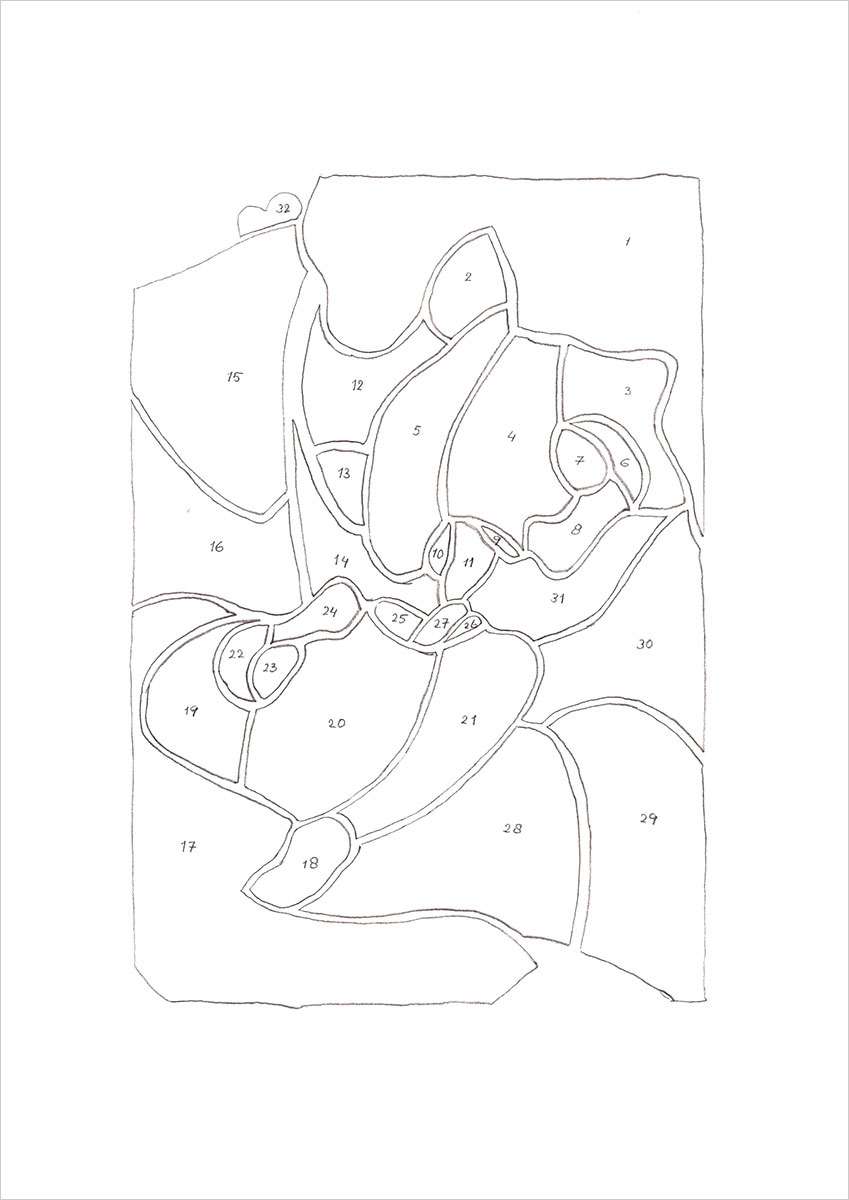
A017 – DPuB [DPuB / A017 - 01SEV128P38-2VKL32ST]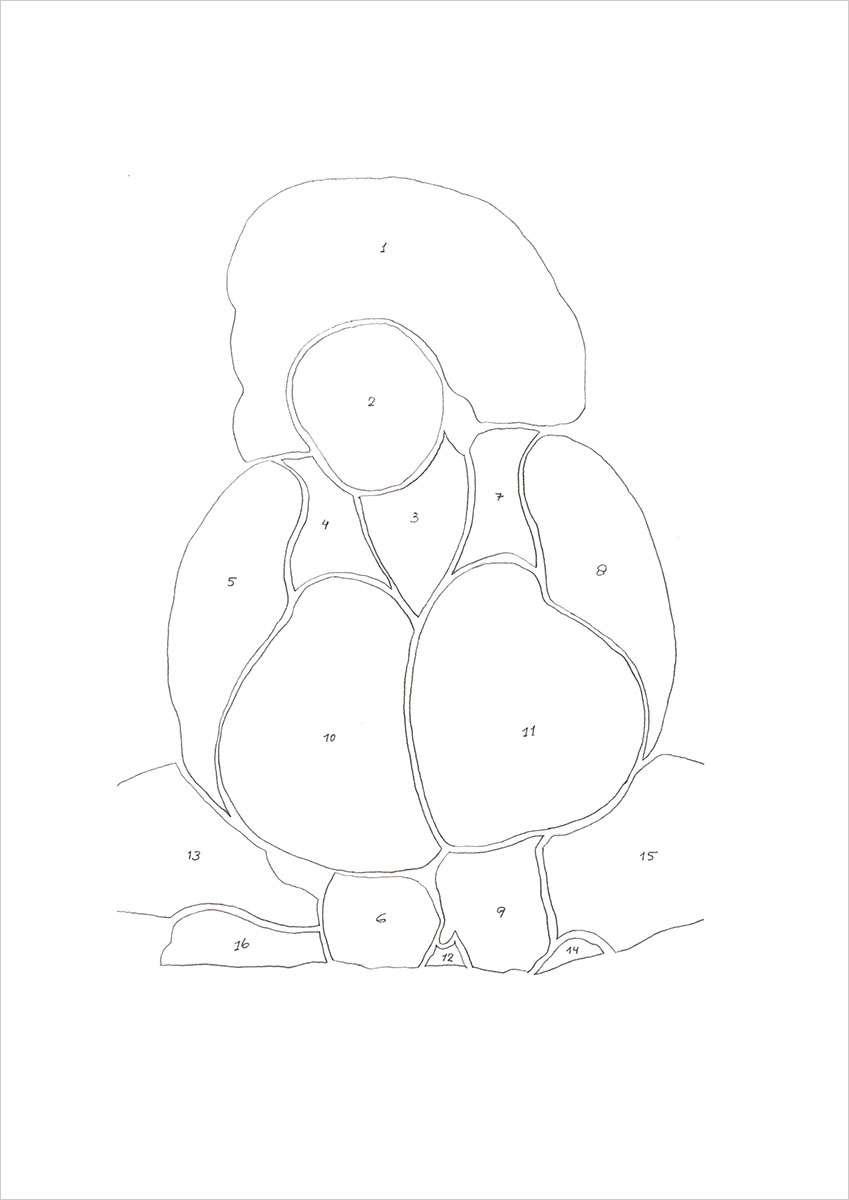
A071 – DPuB [DPuB / A071 - 01FAT48-1VZW16ST]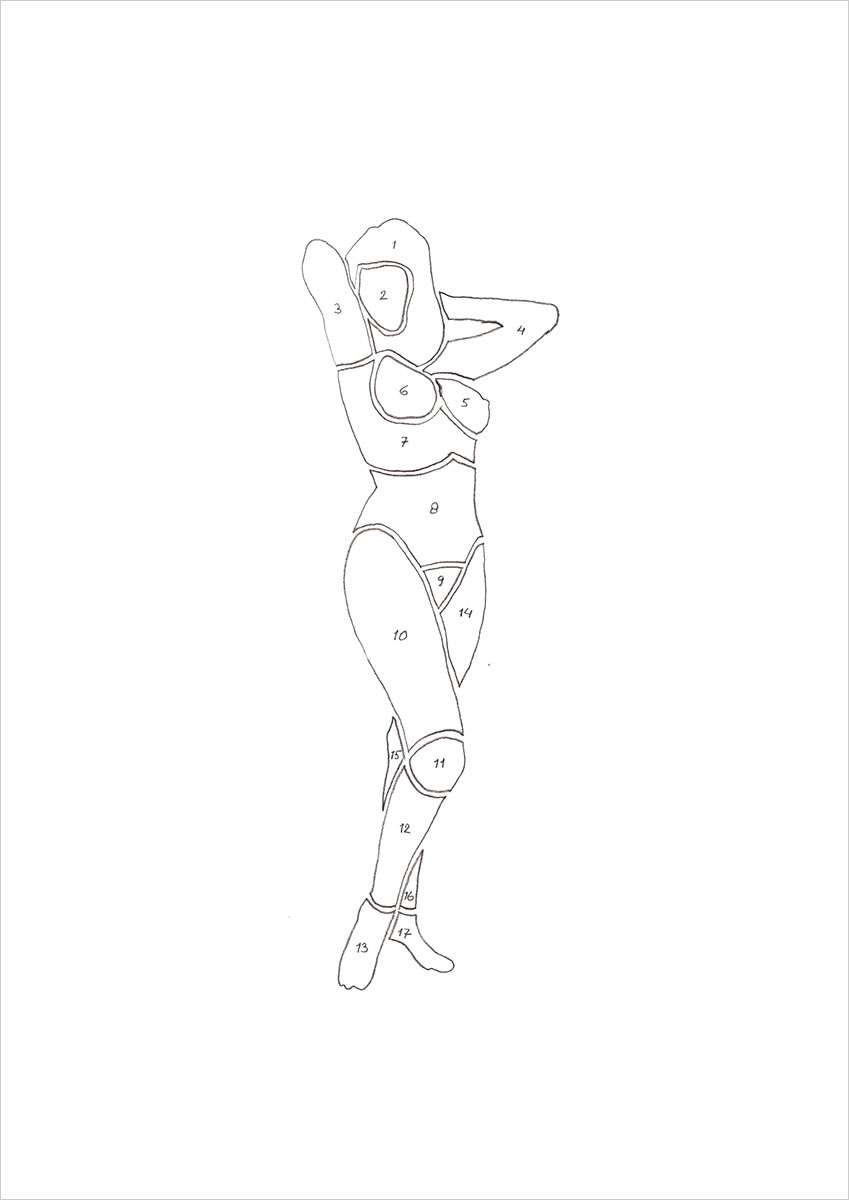
R027 – DPuB [DPuB / AR027 - 01OUN95.7P56+57-4KKL33ST]
When cutting the image only the parts where skin is visible are cut away. The covered part of the body is left behind in the remainder of the image. In the drawing, the parts together show a reflection of the visible skin part of the Body or Bodies. This provides a new drawn picture of the Body, composed of its cut away parts. This new image can differ significantly from the original.
In the cutting process mentioned above, ultimately 3 new images are made from 1 original.
Taken out of context, the parts (PPuB) are a separate collection and have become unusual partial images of a Body.
The remainder (RPuB) puts the emphasis on the body composition and original structure (within the Total image), separate from the outside, the skin.
And the drawing (DPuB) shows the original connection between the PPuB in a complementary composition in relation to the RPuB.
Scroll horizontally below for more DPuB from the Archive of the Institute.
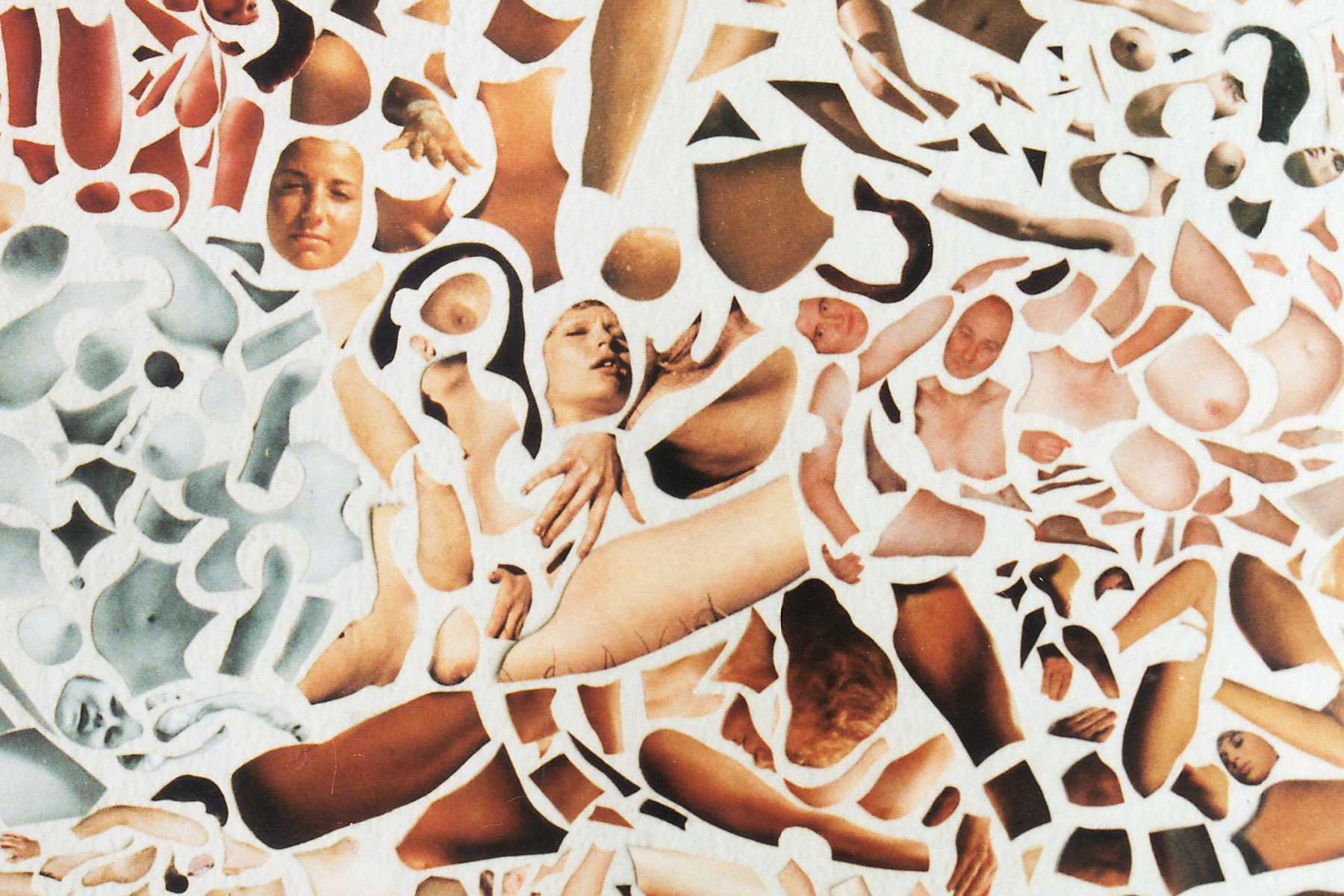
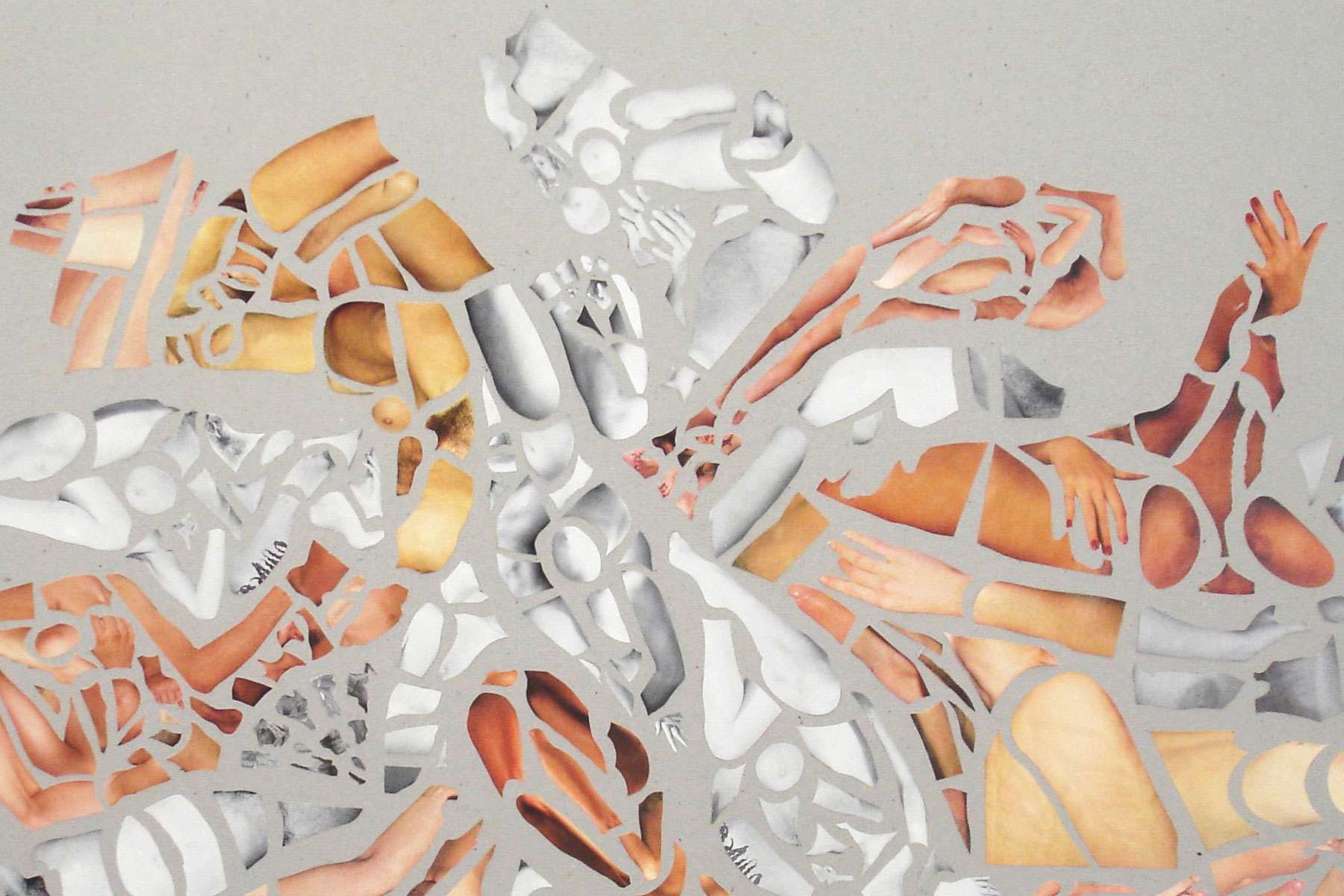
The Parts of the Public Body are stored together per photo (in a bag) in the Archive. When they are taken out again, they can be put together in a different way from the original, in a new composition. Different bags together make all manner of grouping possible.
With most of the activities in the Archive it’s about decomposition, taking an image apart, the deconstruction of a Public Body. With Compositions, however, it’s about the composing, the re-building of the images. In as far as this composing is only a rearranging of existing archive material, it also falls under the Archive department.
The individual images in Archive are called Public Body, but the same name also applies to the various new compositions.
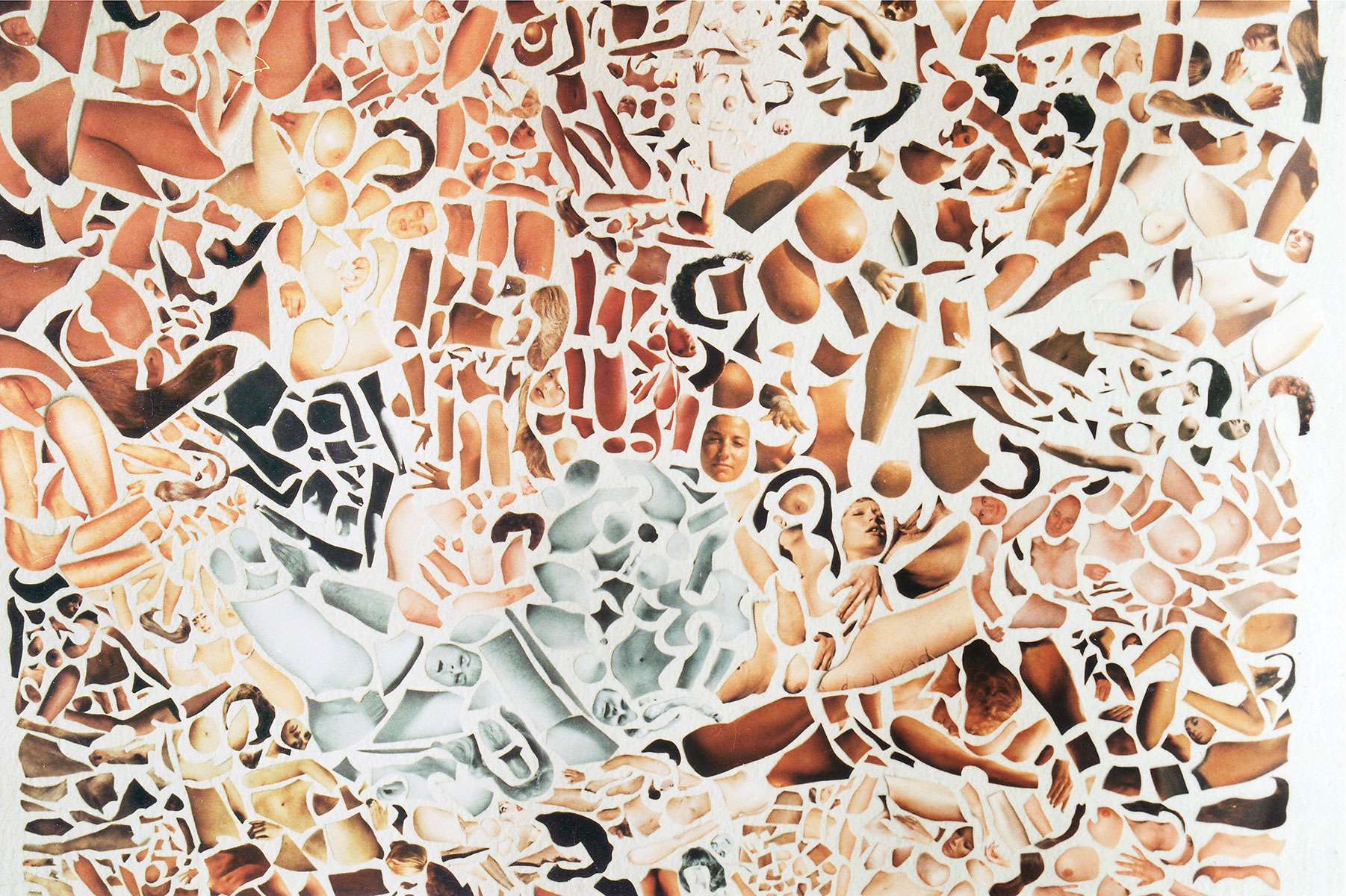 Composition PPuB 1-42 / paper, table / 140x90cm / 1995
Composition PPuB 1-42 / paper, table / 140x90cm / 1995
All the Parts of the Public Body images registered under number 1 to 42 in the Archive are used here.
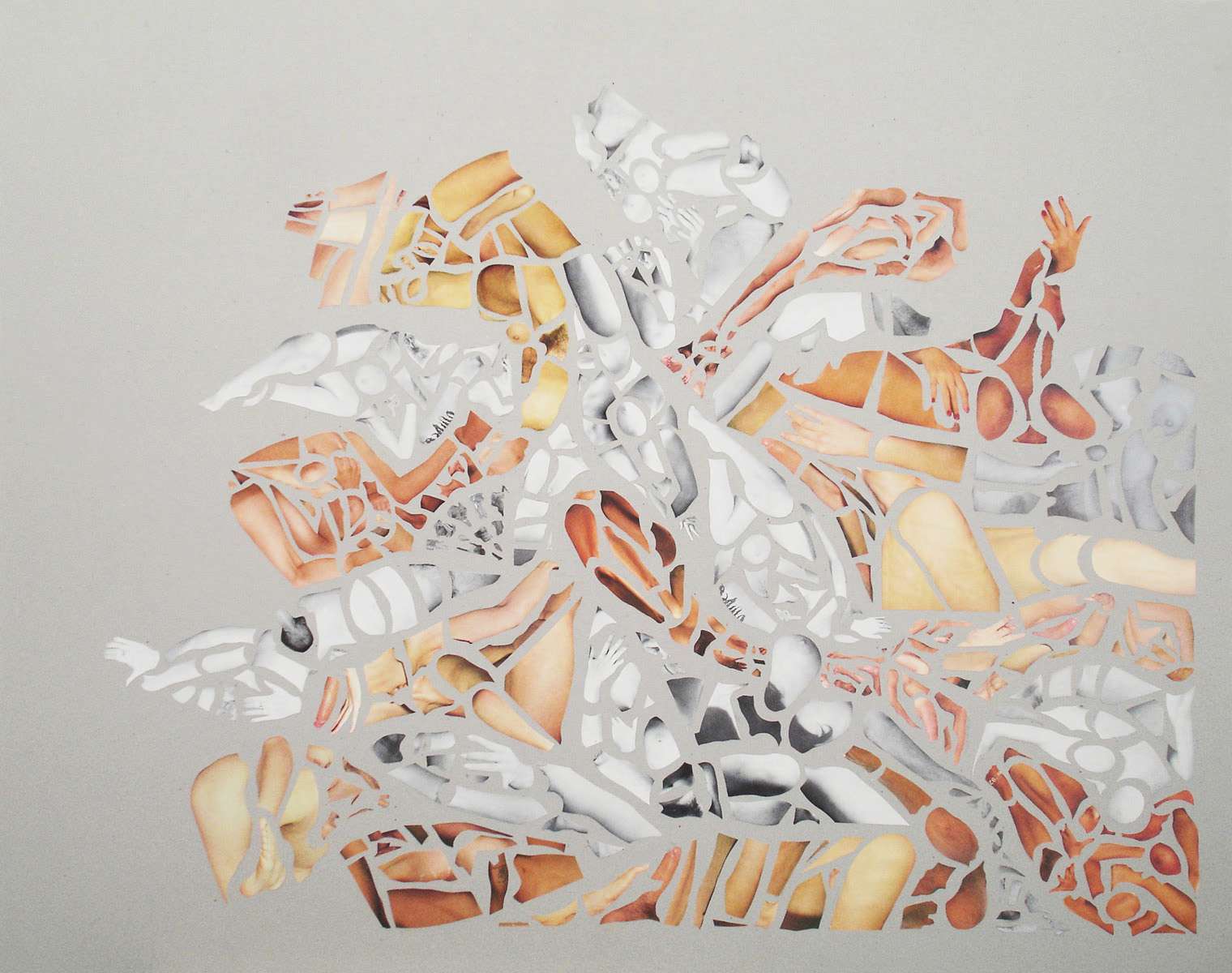 PPuB of honey / paper on cardboard / 100x80cm / 1999
PPuB of honey / paper on cardboard / 100x80cm / 1999
In the archive this work is saved as: PPuB of honey - RPuB / 000-100 / 01HON 92.5 PP44
All the Parts of the Public Body from the work honey - see later - are used here.
In the section PPuB above it has become clear that each Part in a specific form shows an image of a body part in a specific cut-out. It is also noted here that the emphasis is more on the form and less on the function.
Without the context of the complete, original image or even only the Remains of the image, part of the original meaning changes. Standing alone, rotated, moved and put together with other Parts, it generates a new meaning.
The material used for Compositions is returned to the Archive after use.

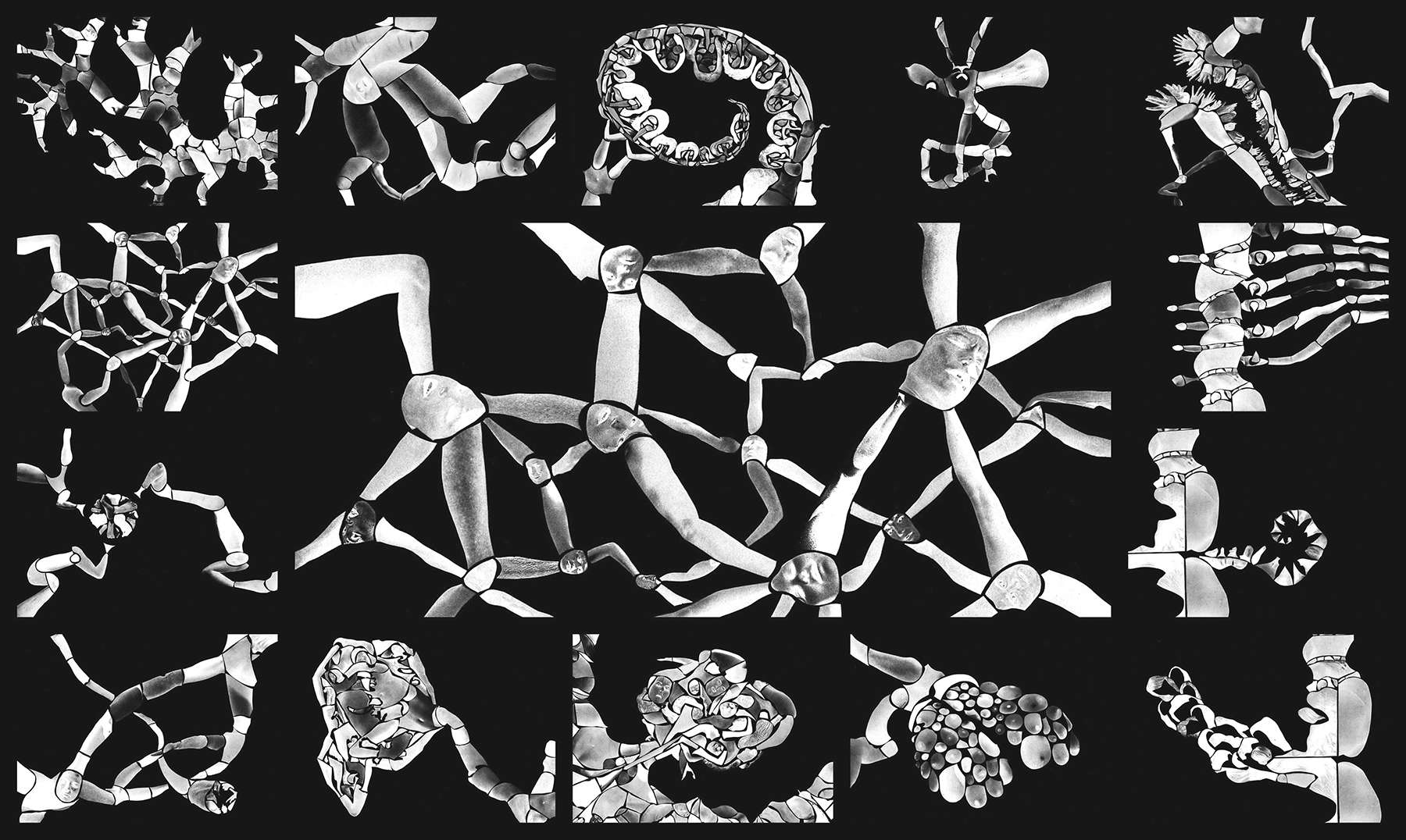
The Scans of the Public Body are a special form of Compositions, both separately and together. There is a SPuB-external and a SPuB-internal. On the work floor, these are also called the Organ Series.
Based on the first 42 numbers with parts from the Archive, a representation was made of a larger, more spacious Public Body. In its entirety, this Body is quite large, extremely flexible and moreover it constantly changes shape. From this larger Body, several partial organs have been made visible.
The Partial images, together form 14 compositions that all show part of the outside of the Public Body. This is called a Scan of the outside of the Public Body or, in short, a SPuB-external. The large Body is, as it were zoomed in on, and part of it temporarily fixed or frozen.
Here are first the SPuB-external from the Organ series.
It is a series of 14 images of the outside of the Public Body.
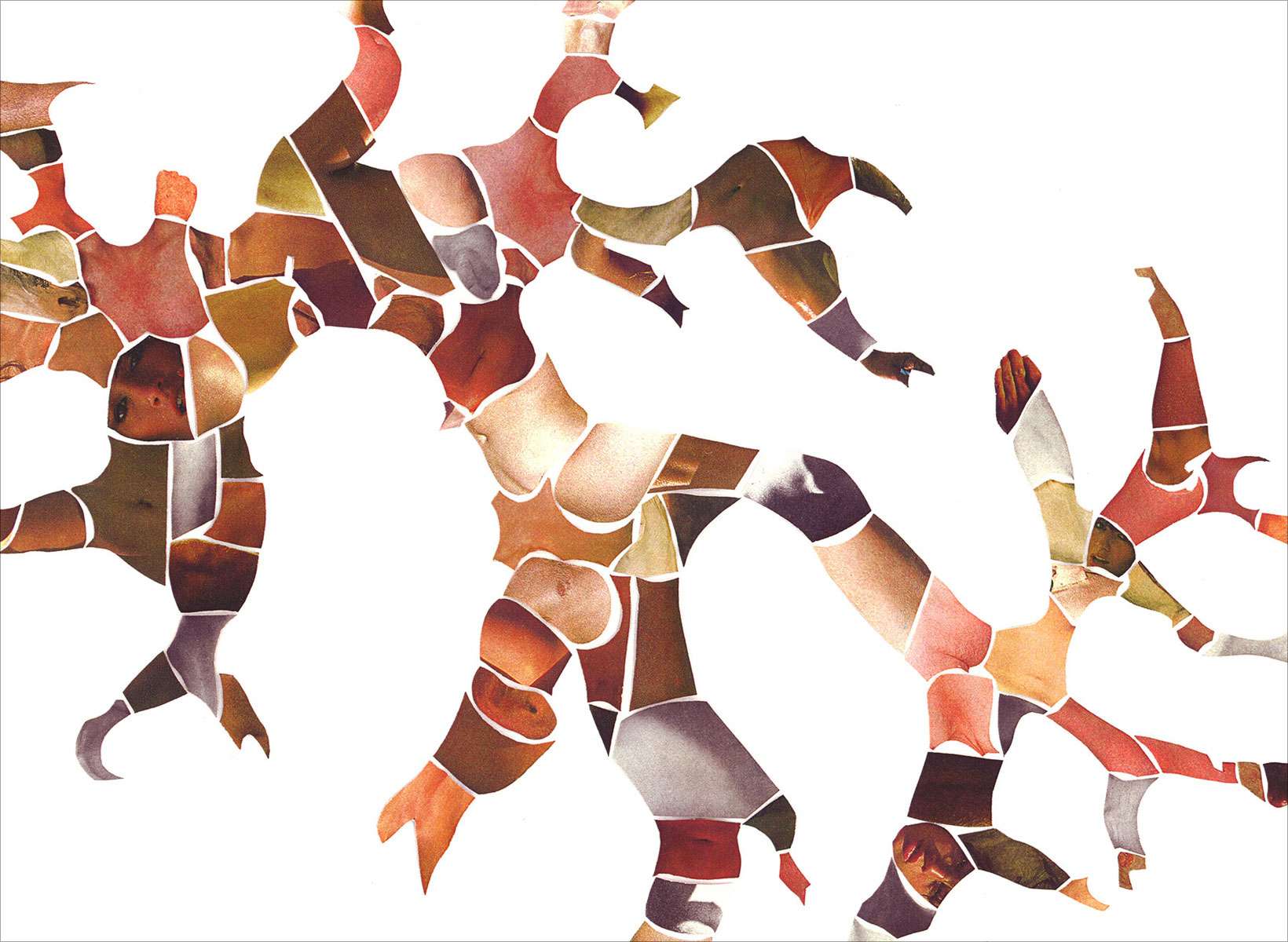
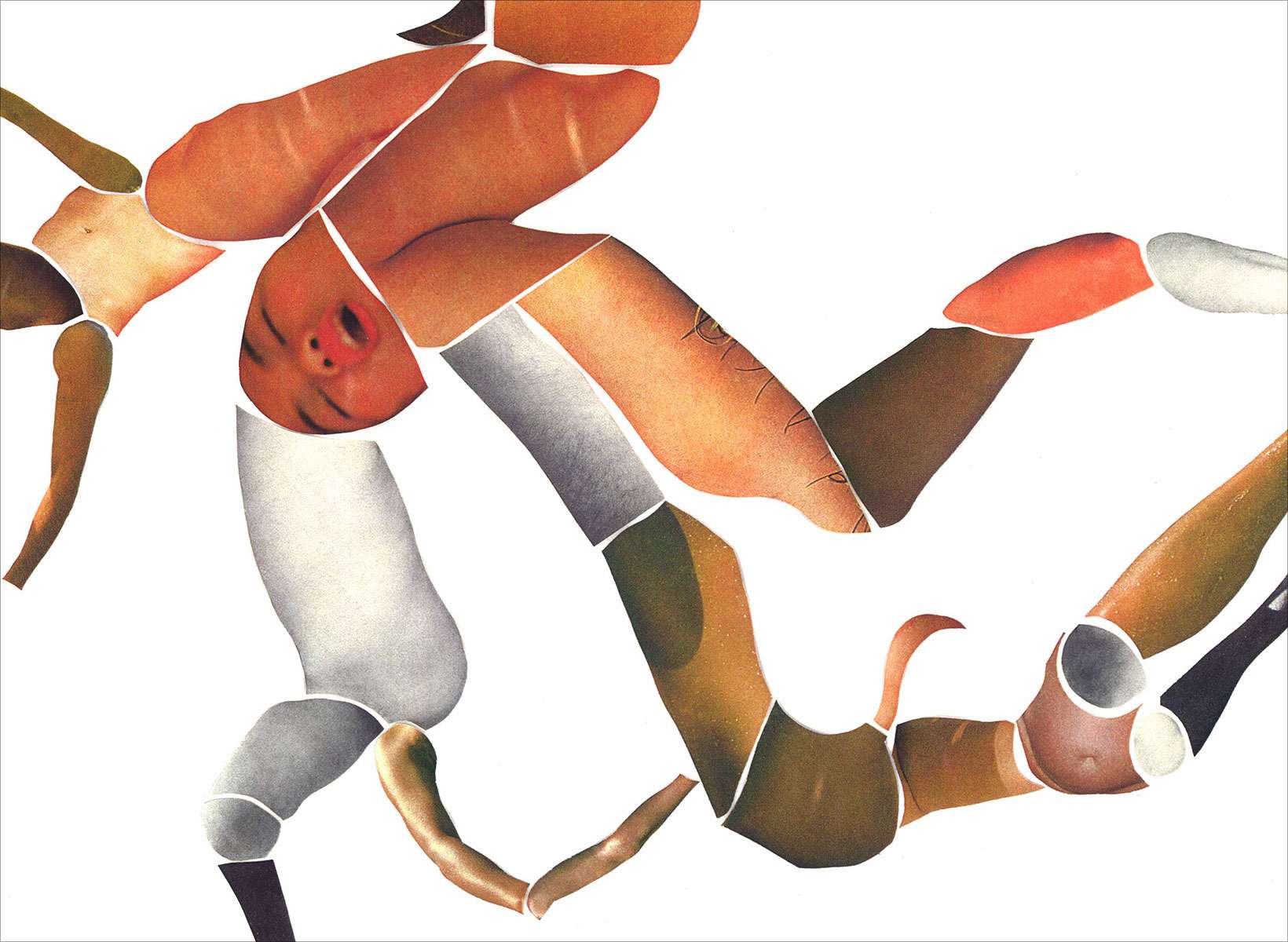
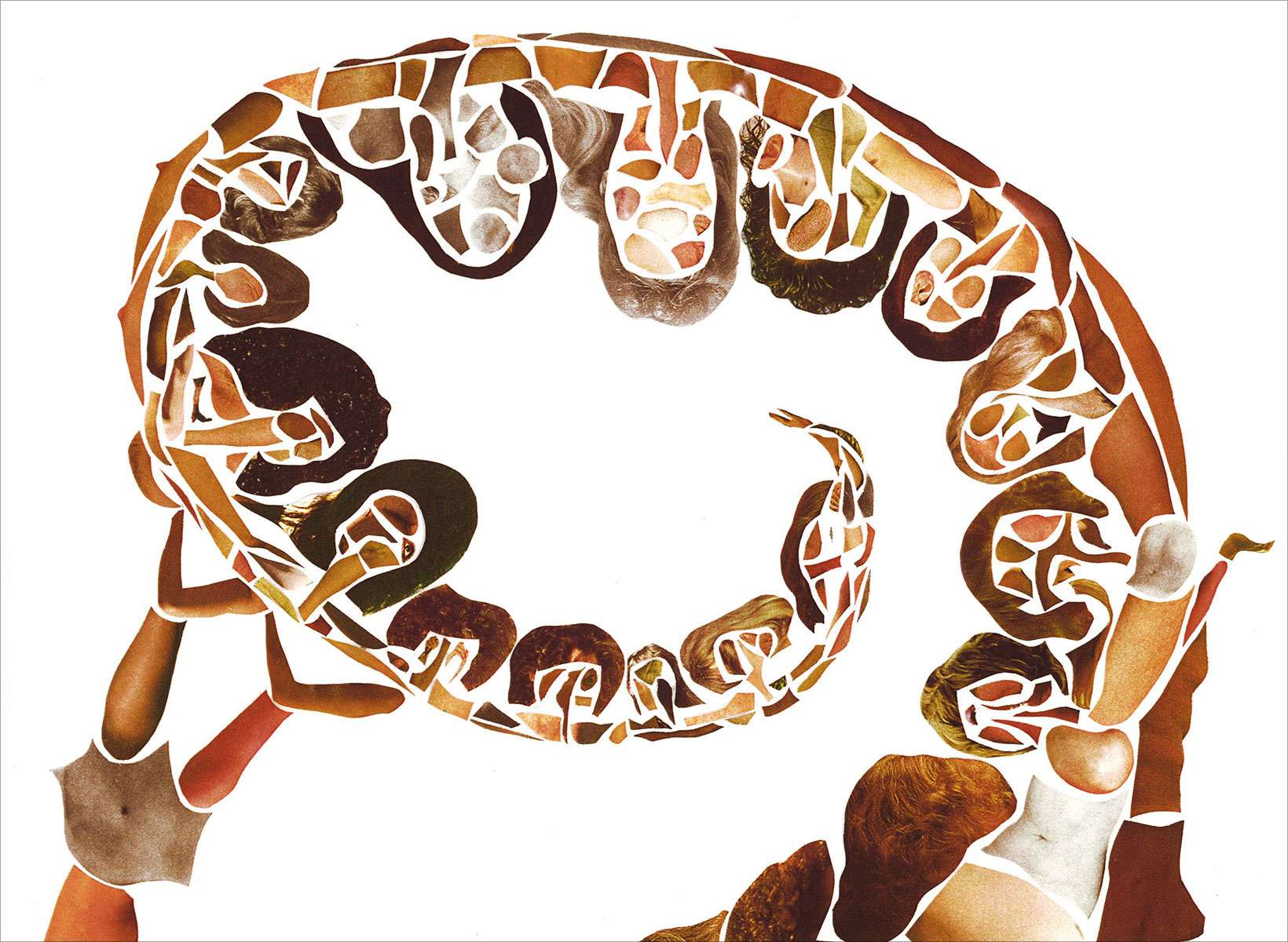
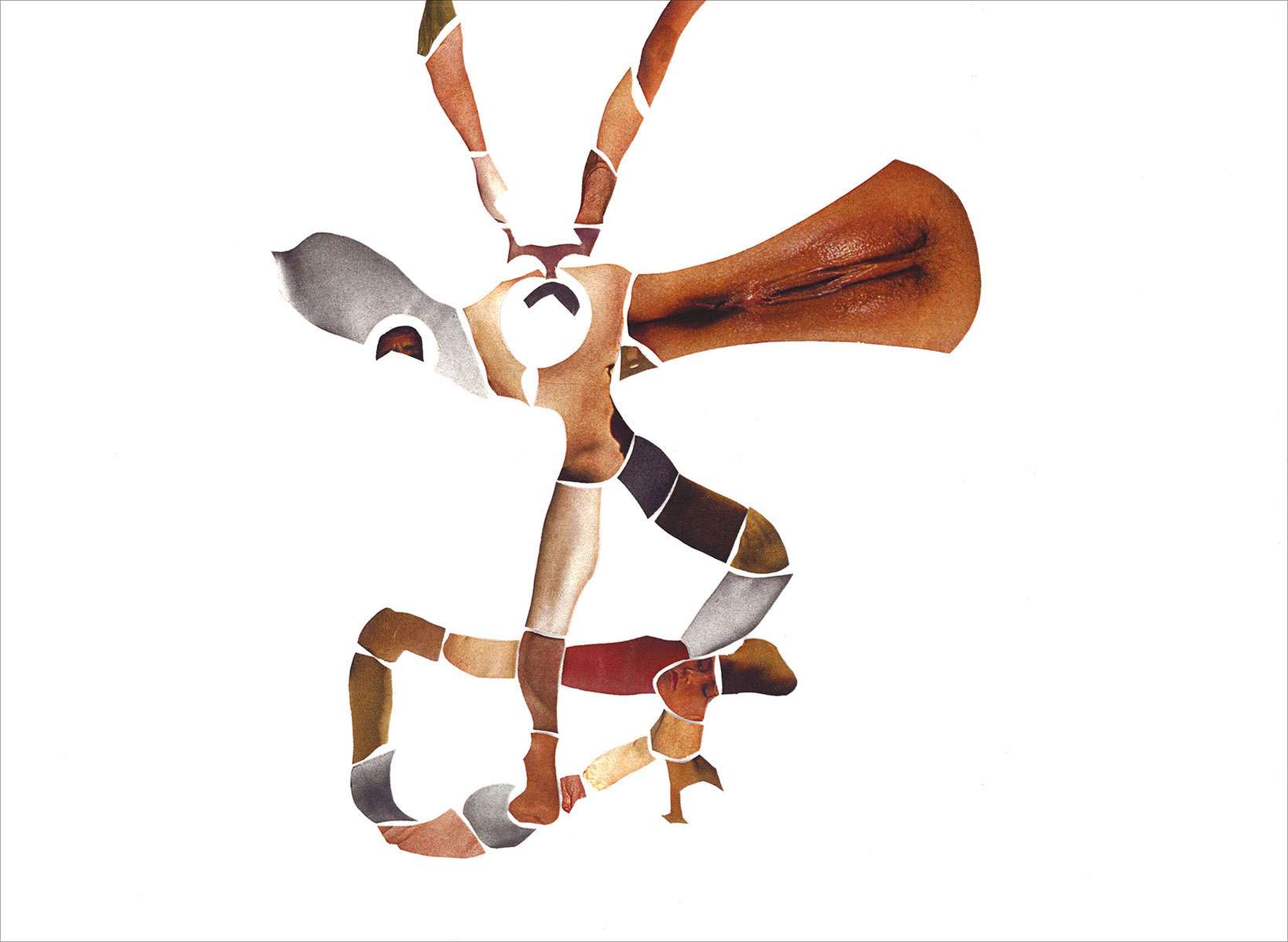

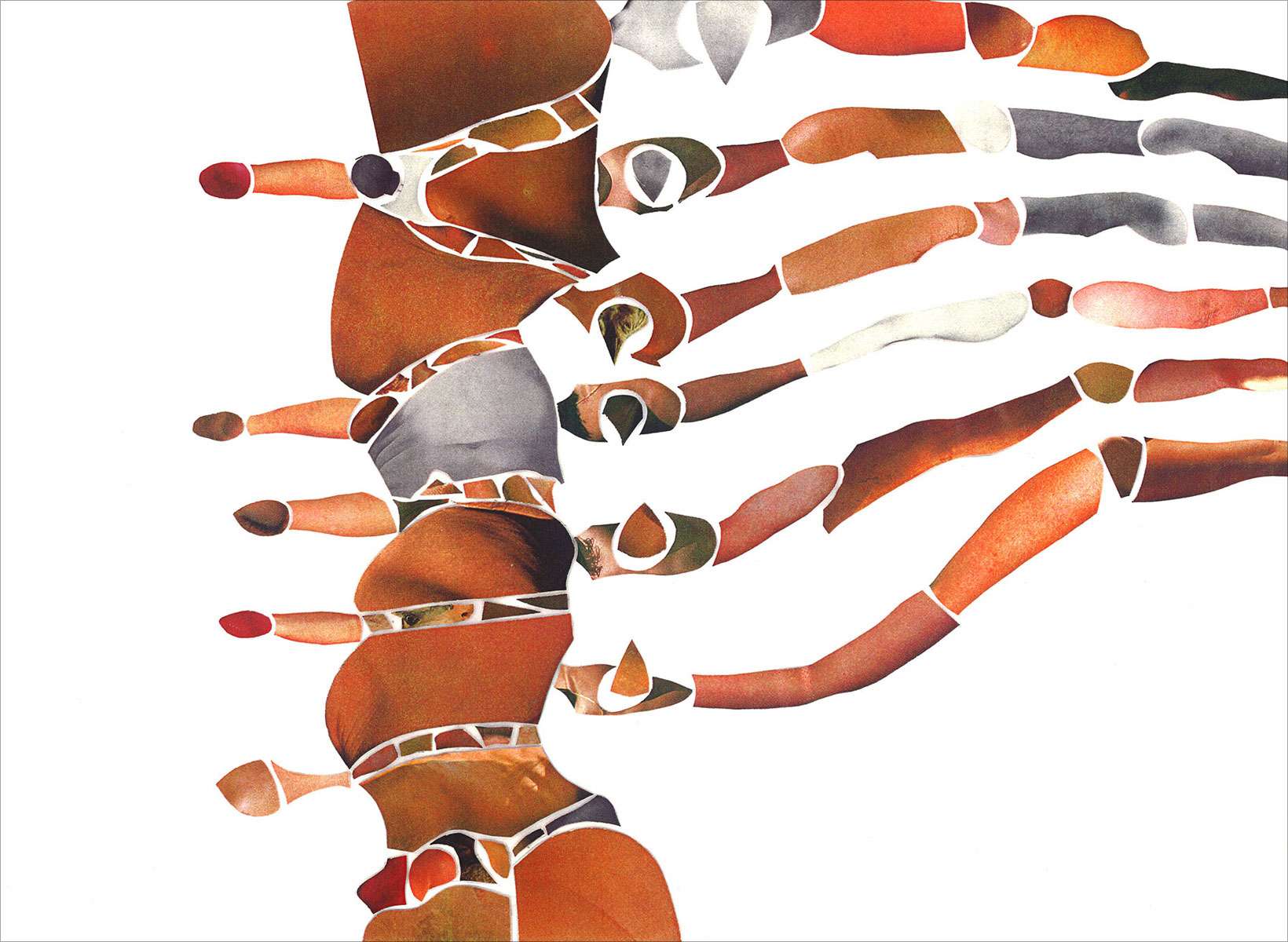

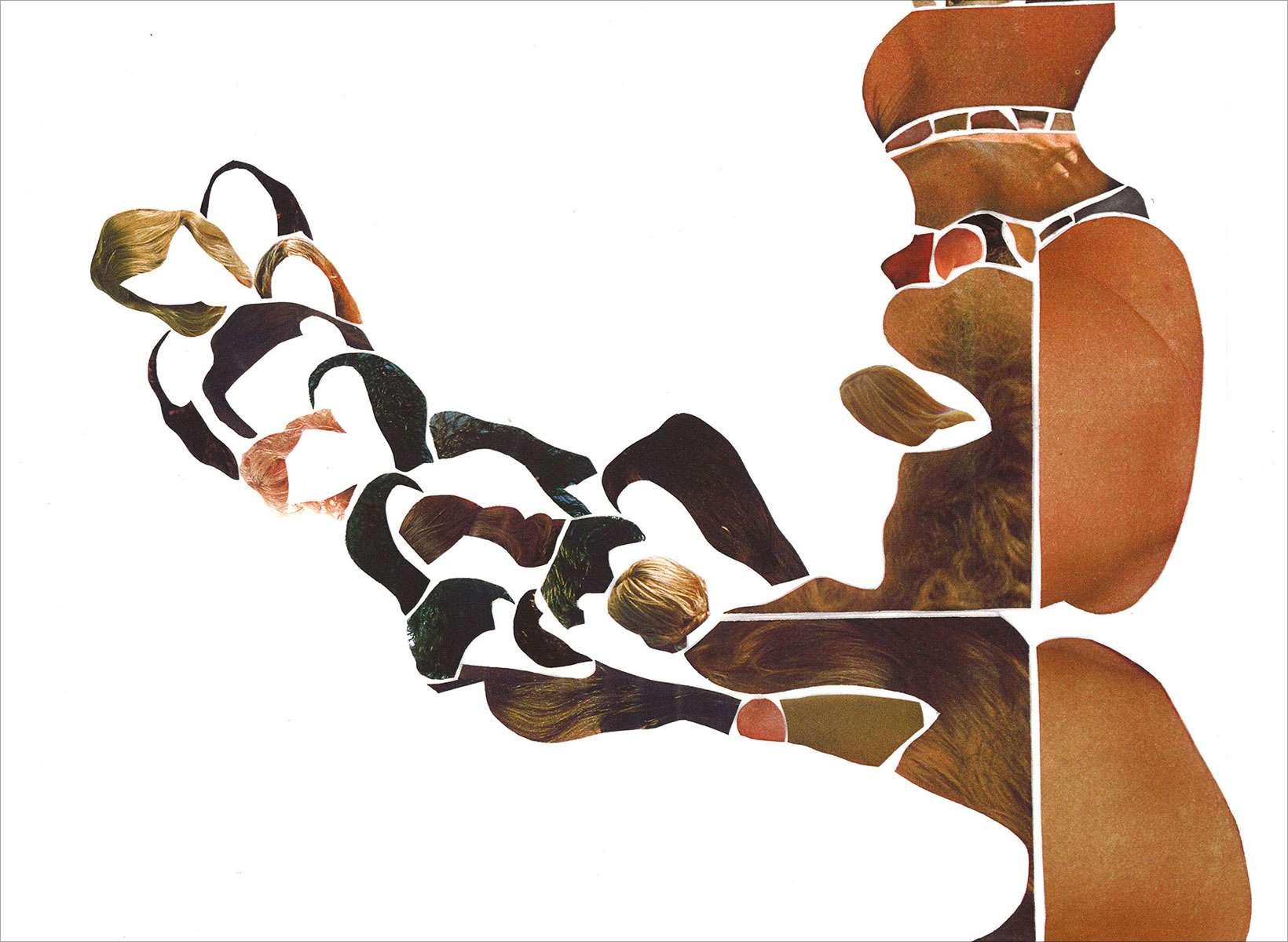
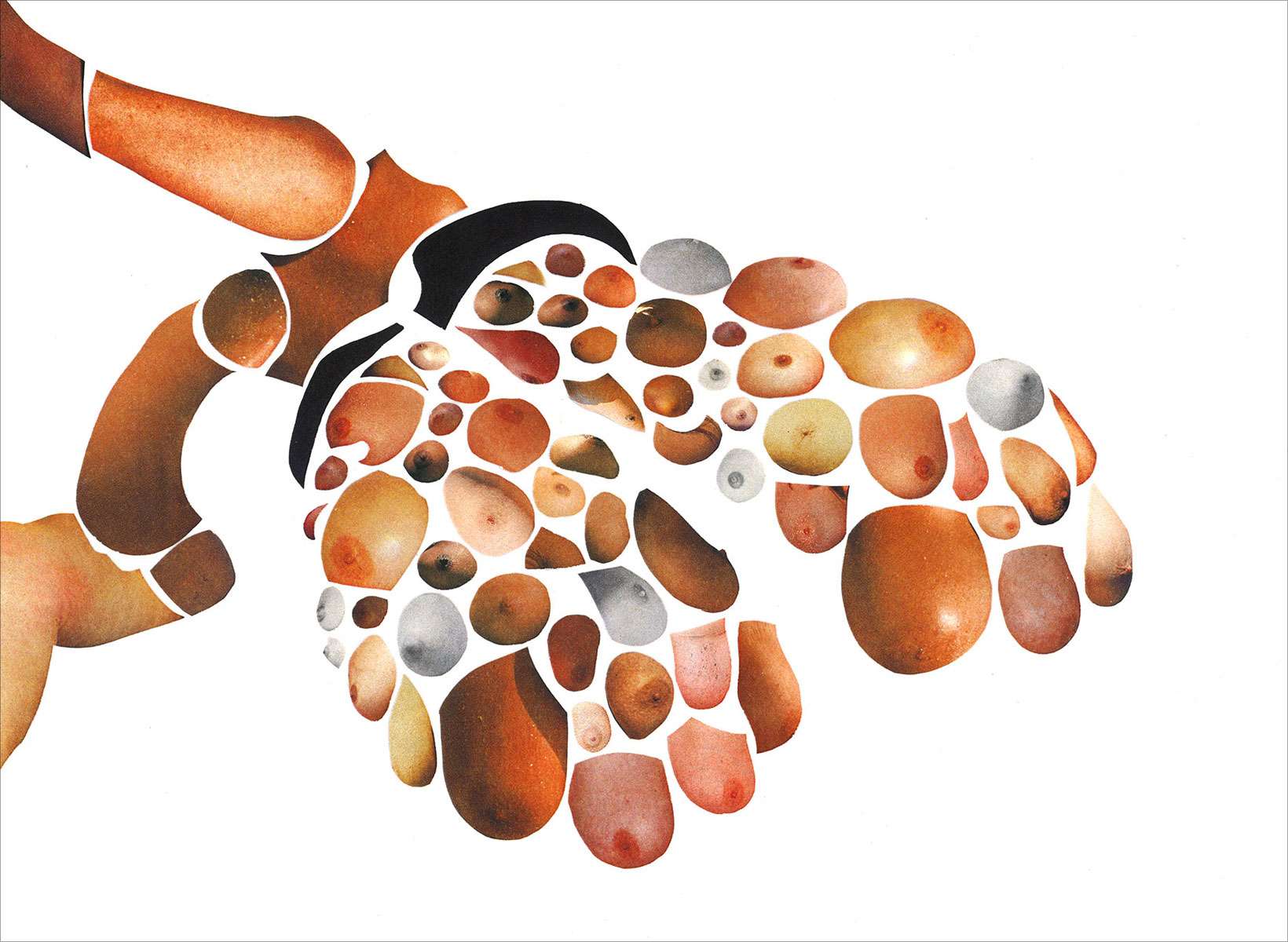
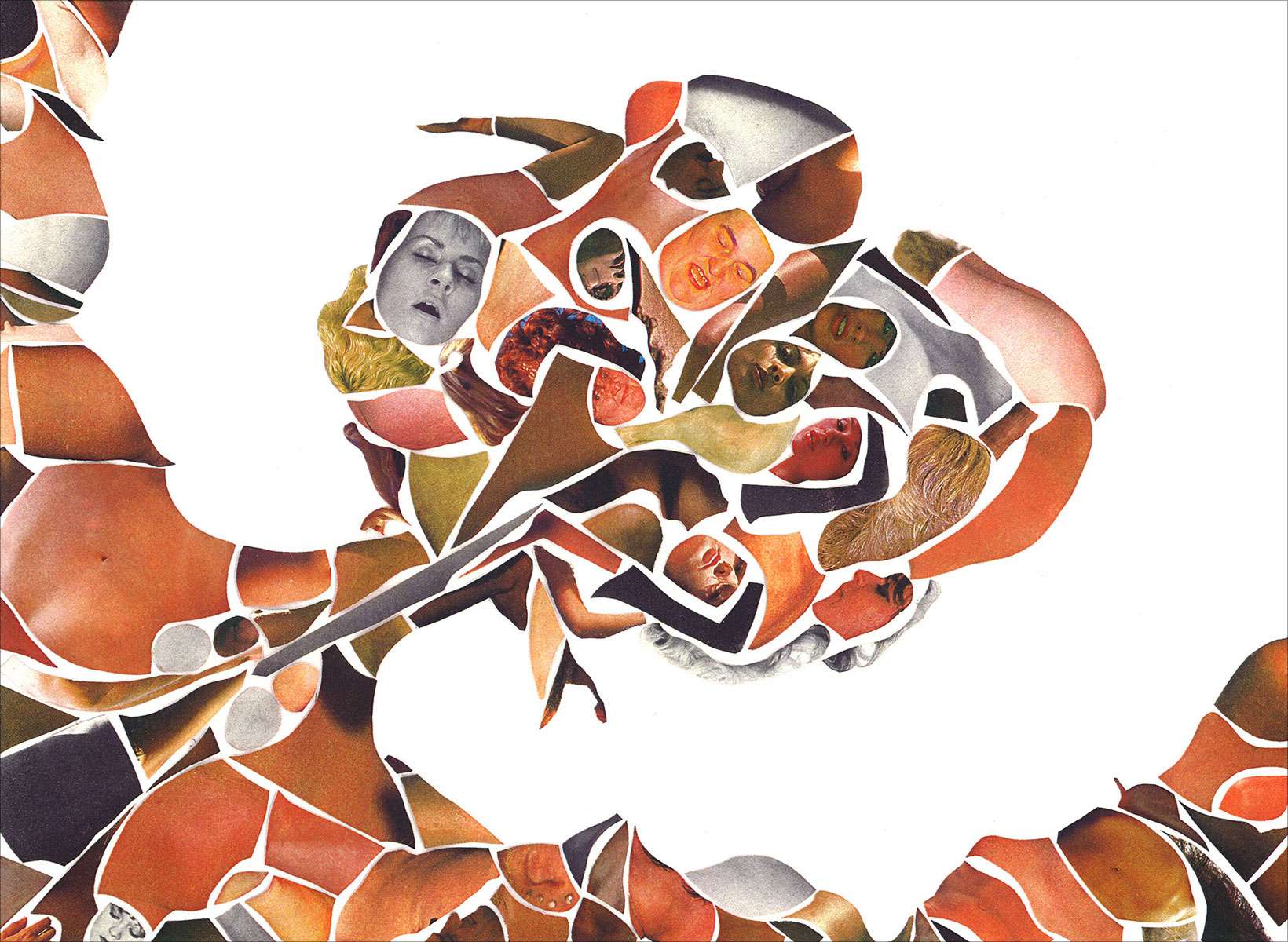
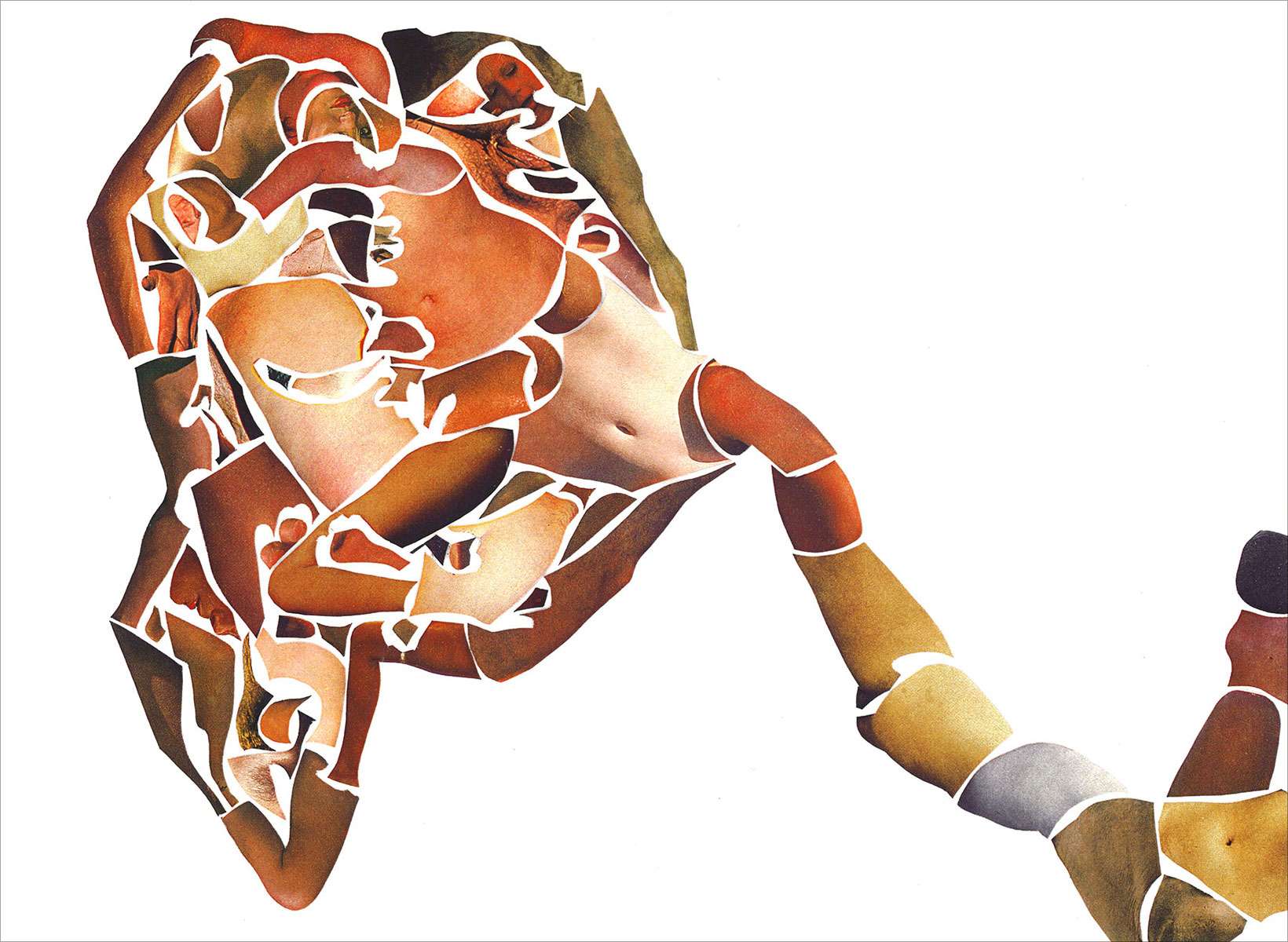
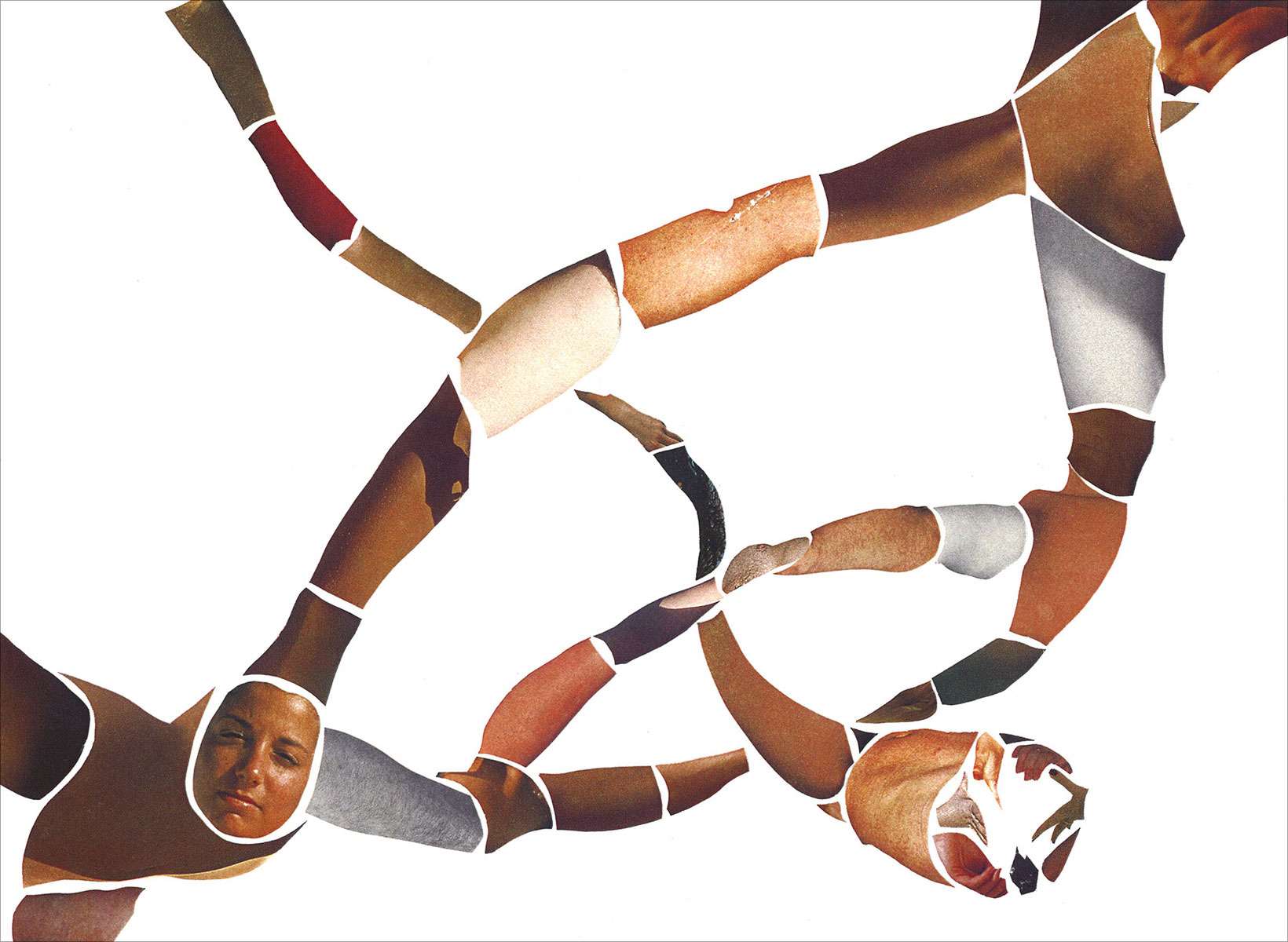
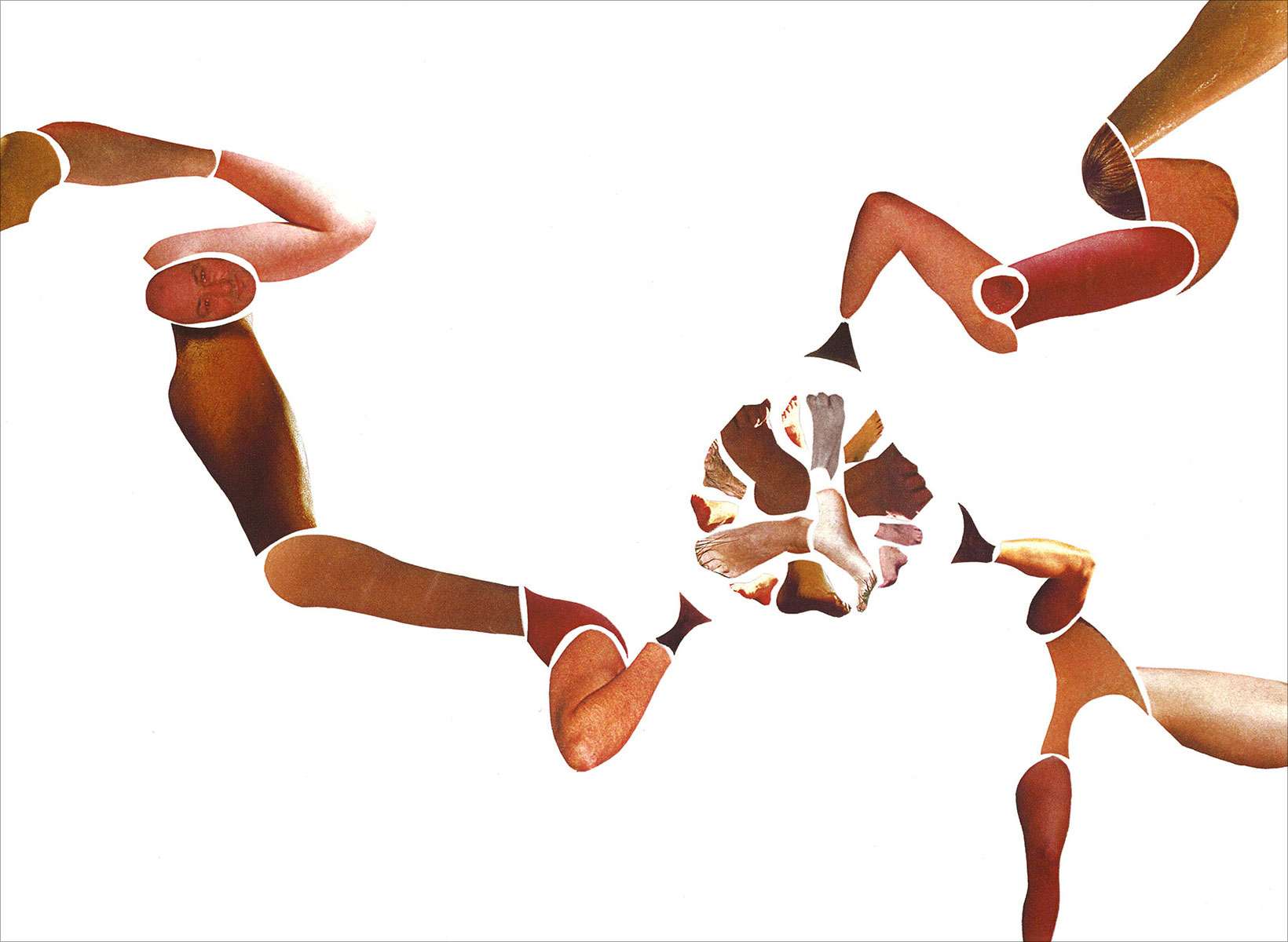
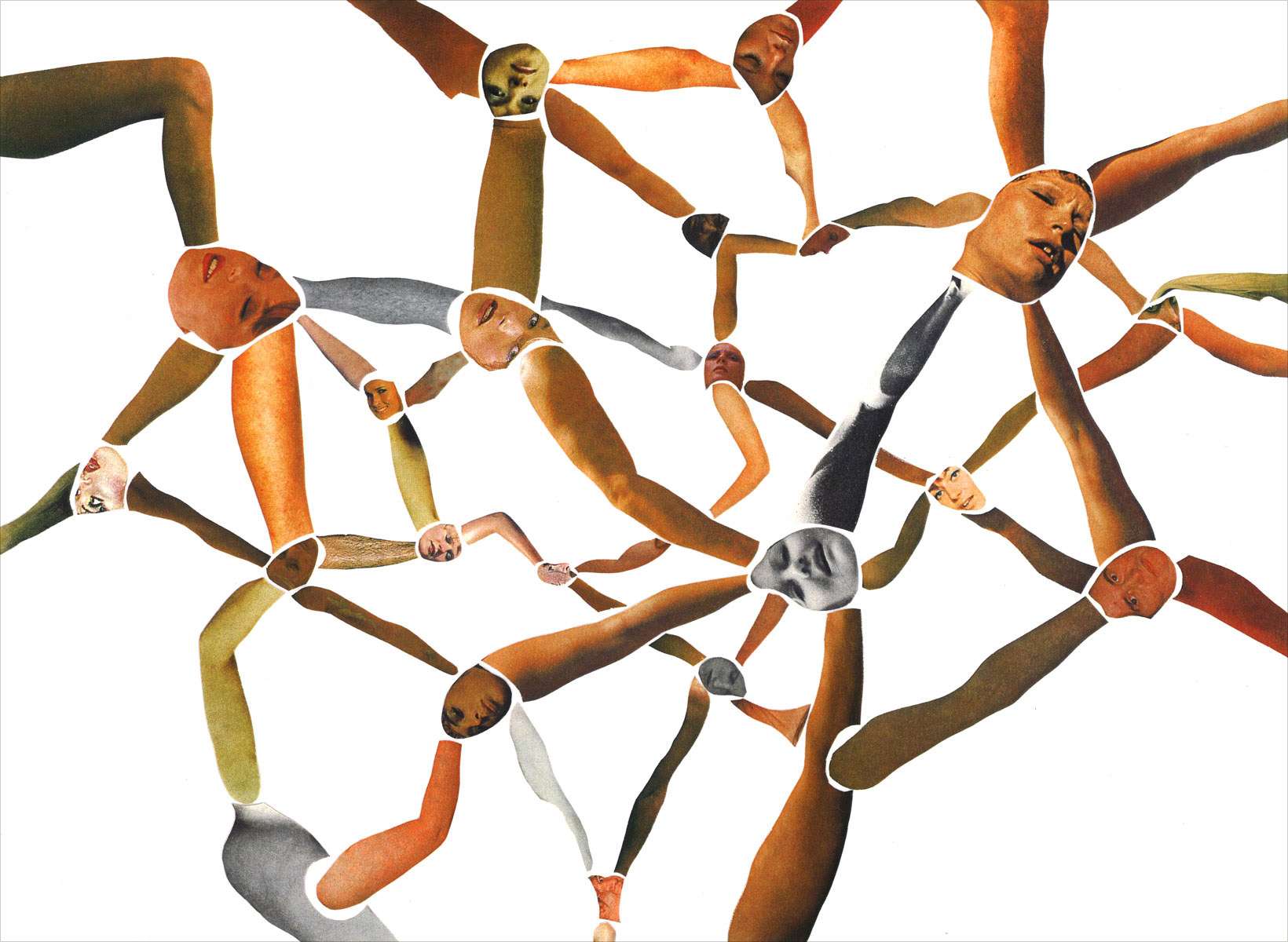
SPuB-external, Scan of the Public Body, part 1-14 / print on paper / each 37.5x27.5cm / 1995
It is also possible to make a Scan of the inside of the Body, a SPuB- internal. Here we see, as it were, a CT scan, a snapshot with x-ray of a part of the large Public Body.
Here are the SPuB- internal from the Organ Series.
It is a series of 14 photos of the inside of the Public Body.
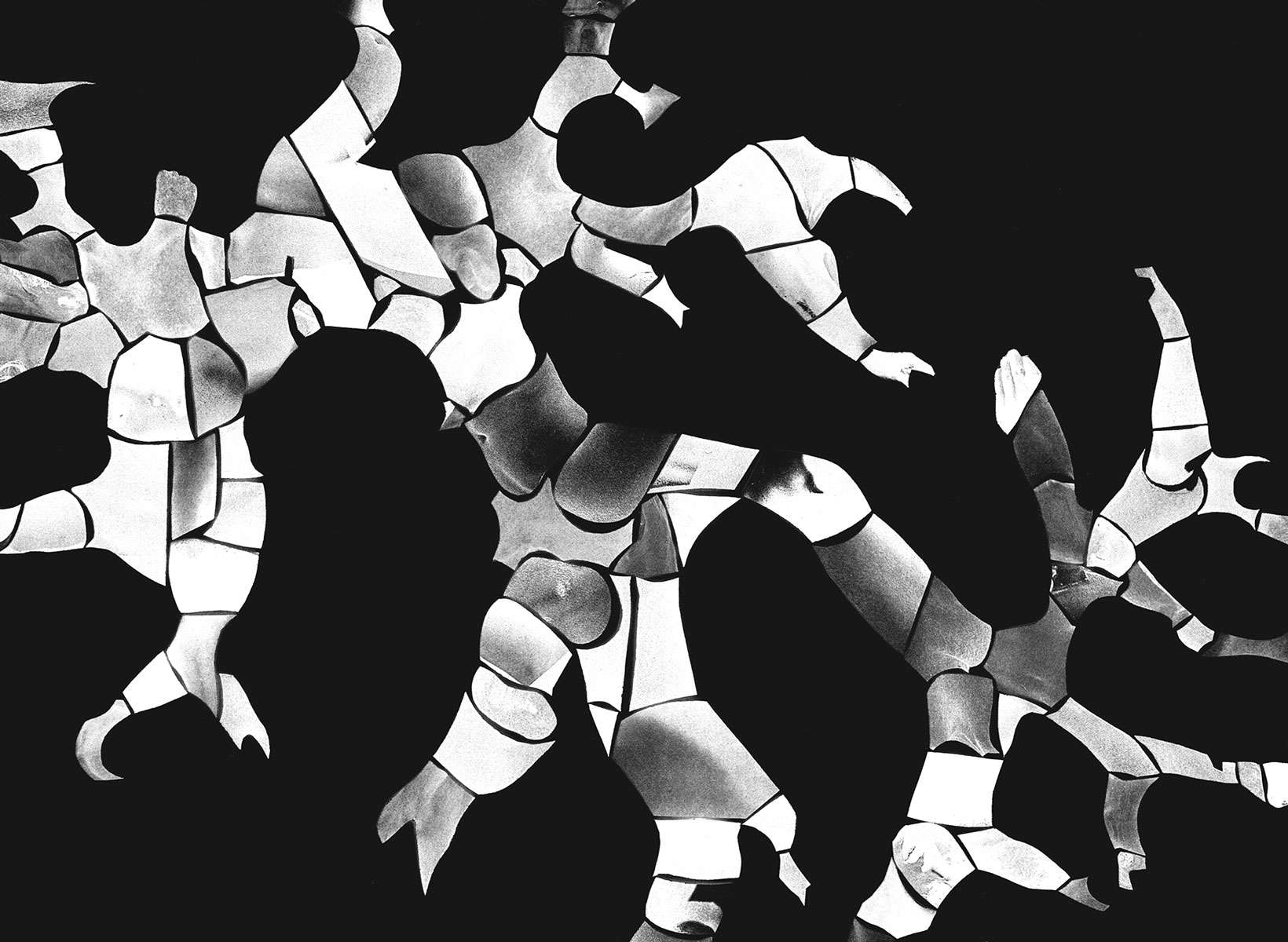
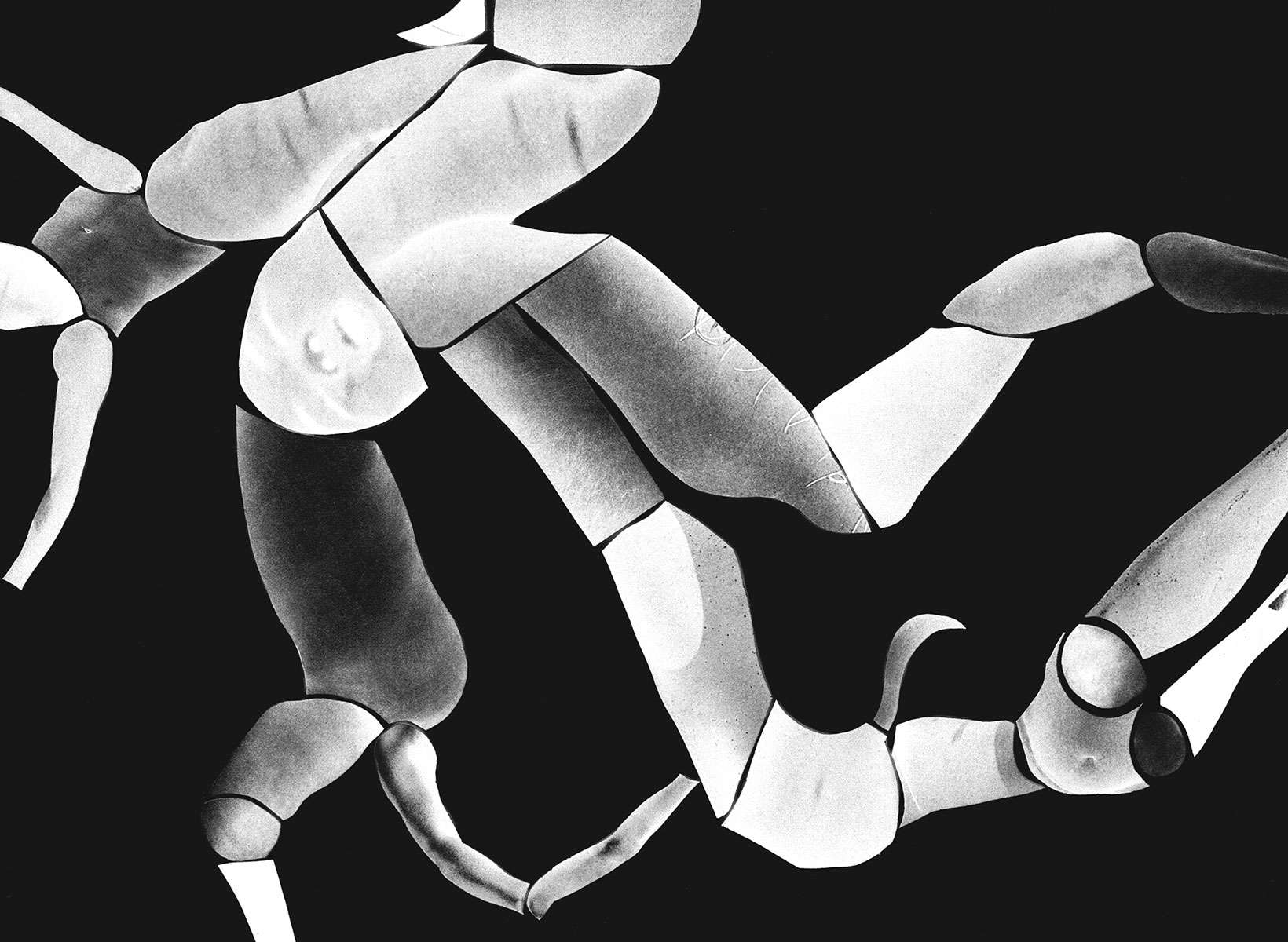
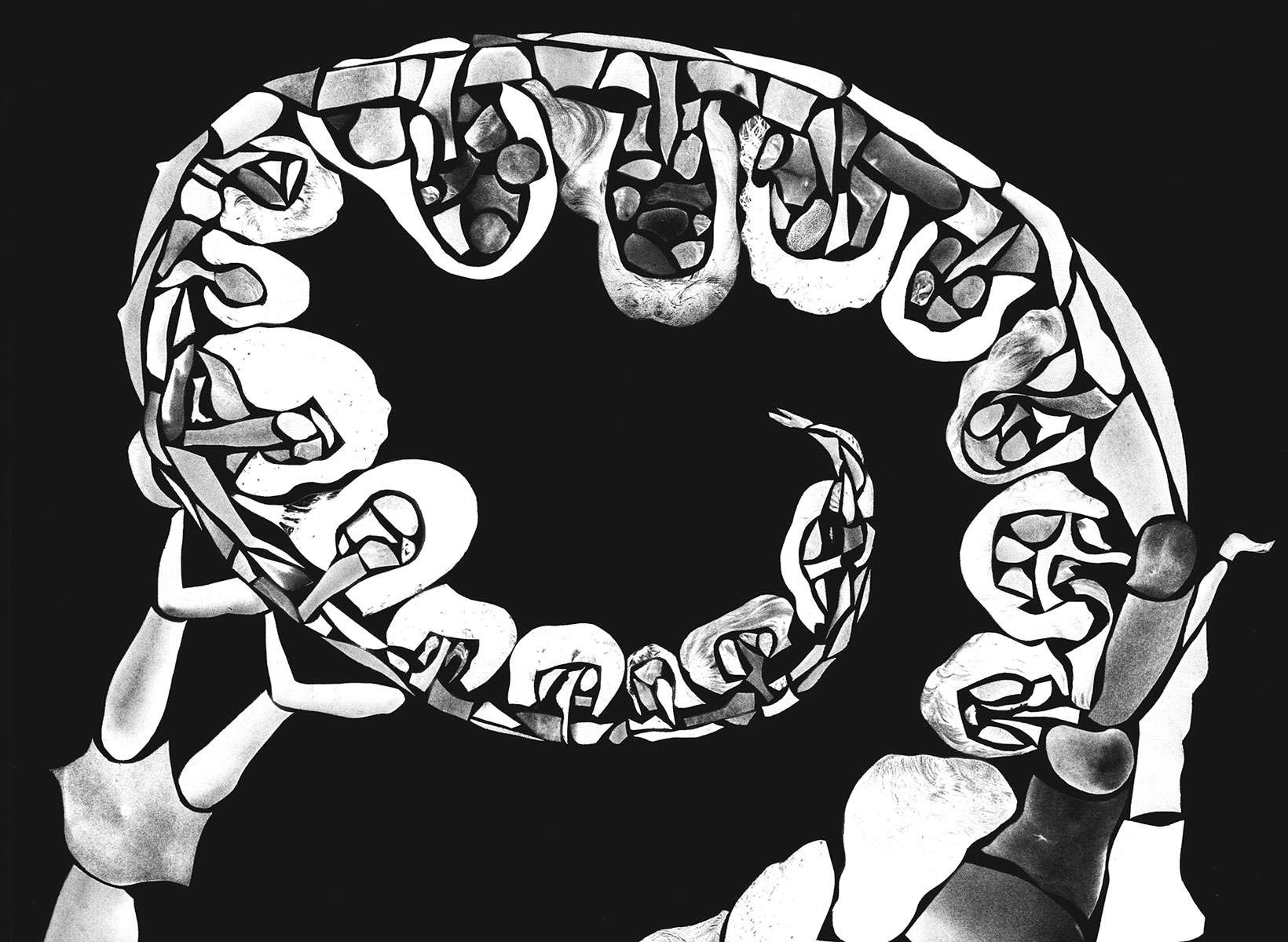
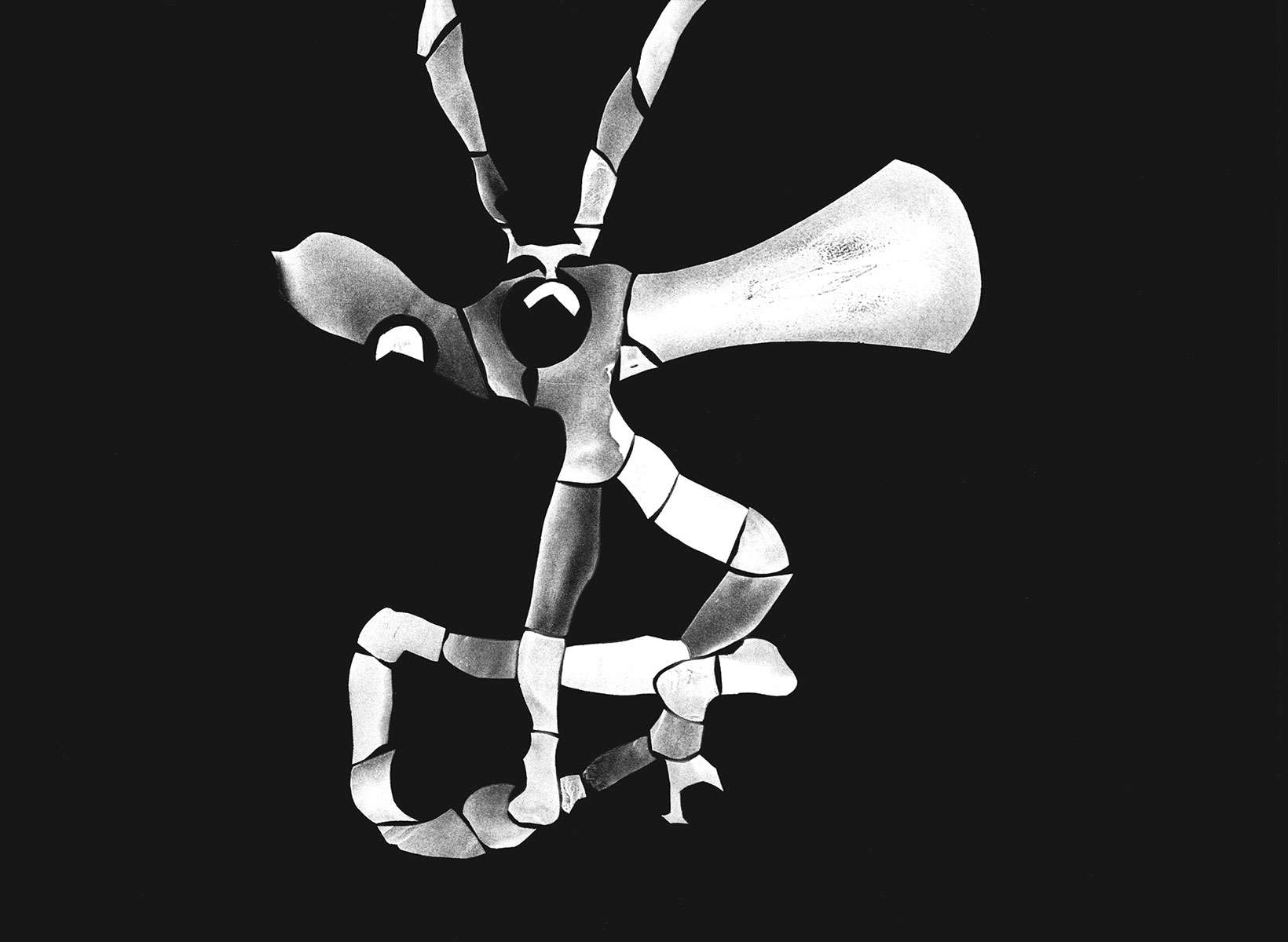
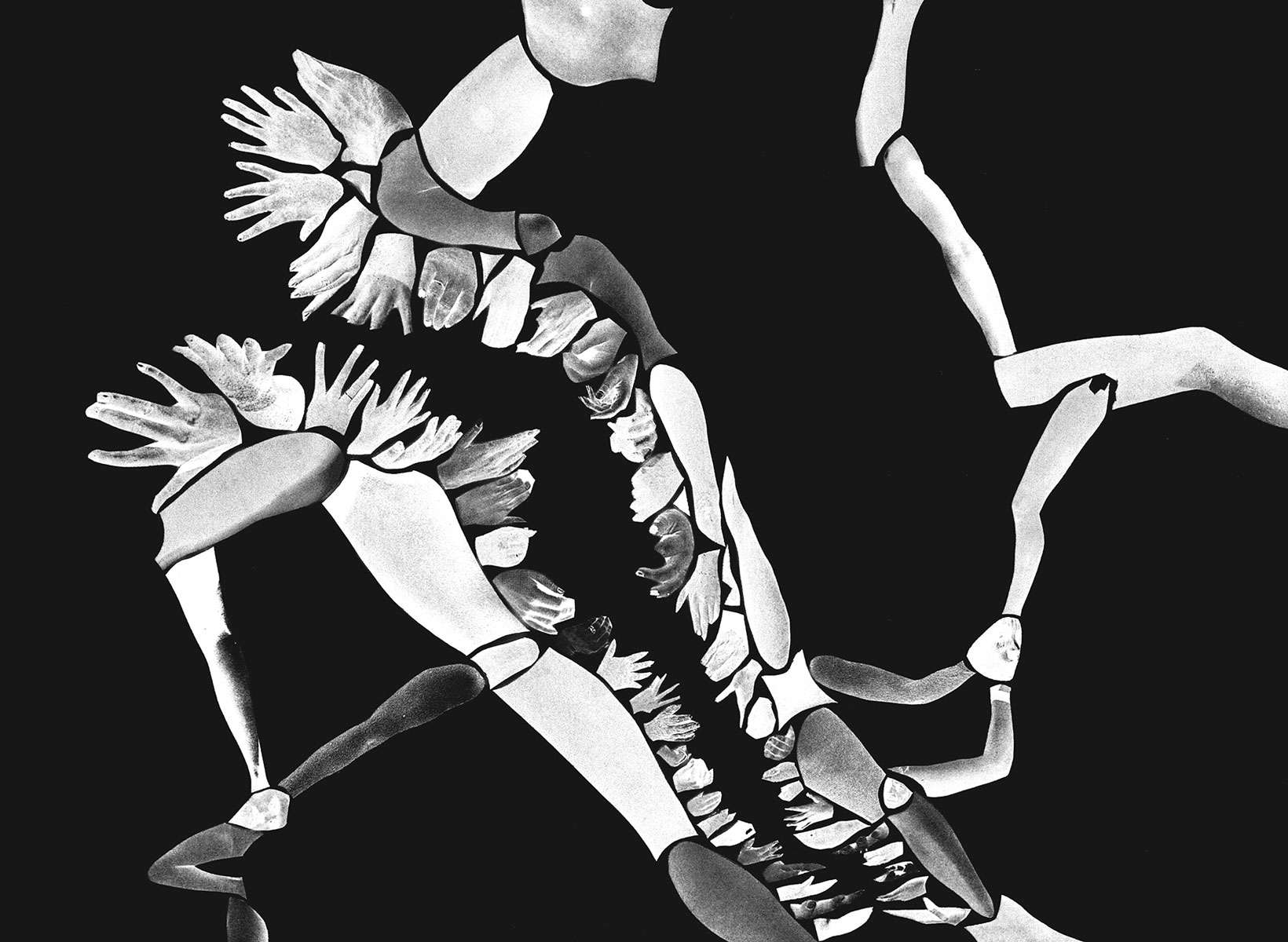
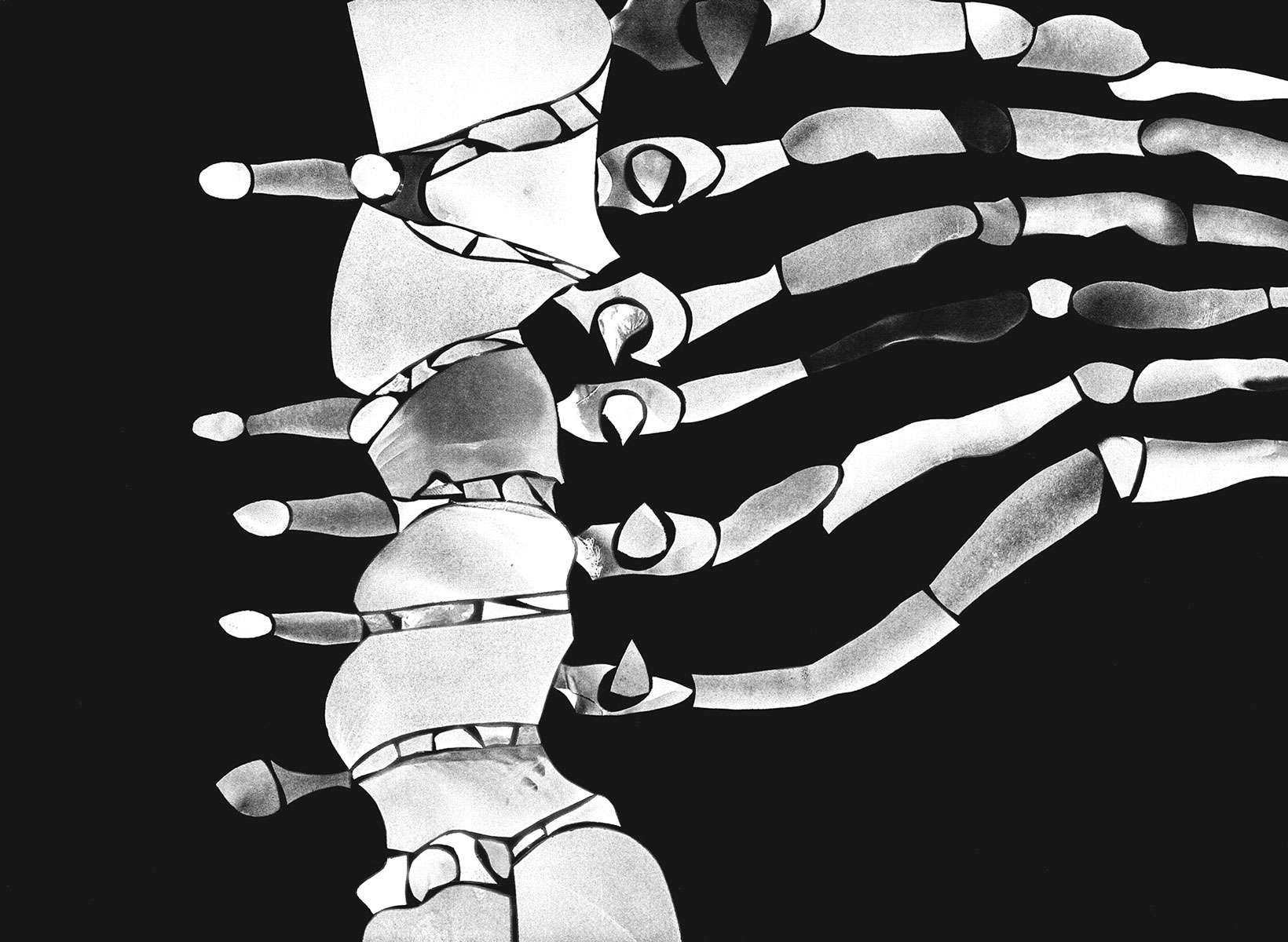
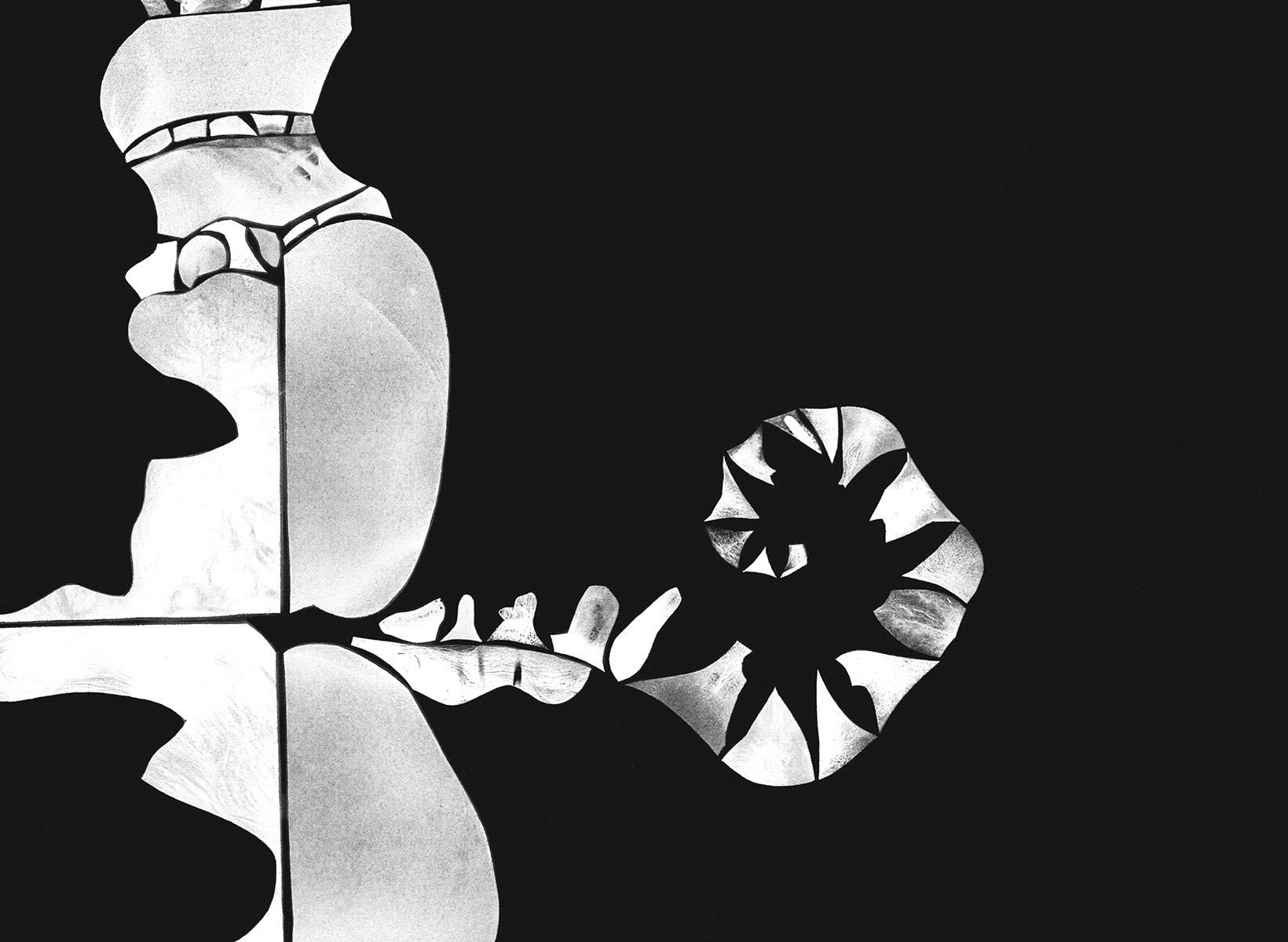
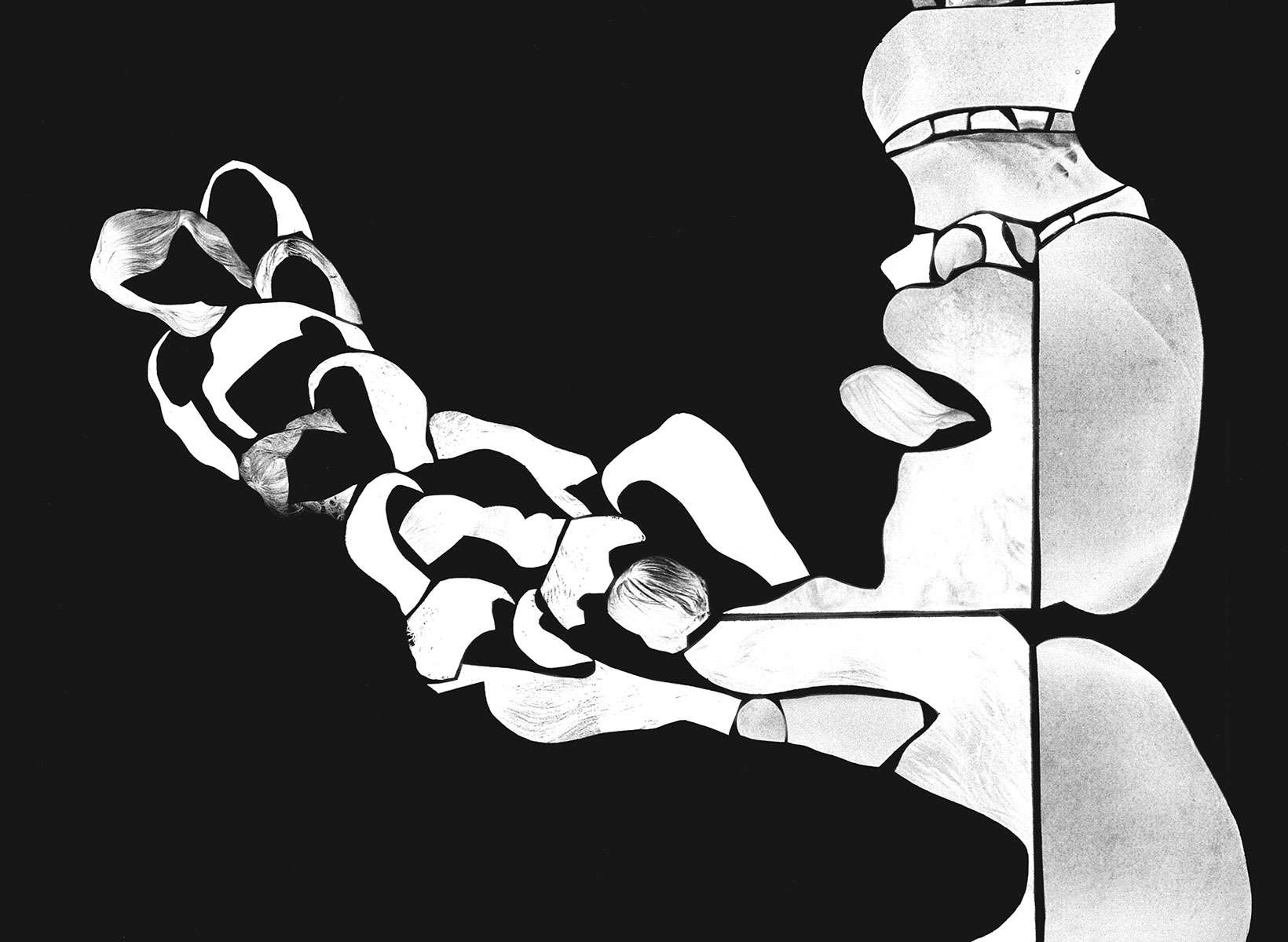
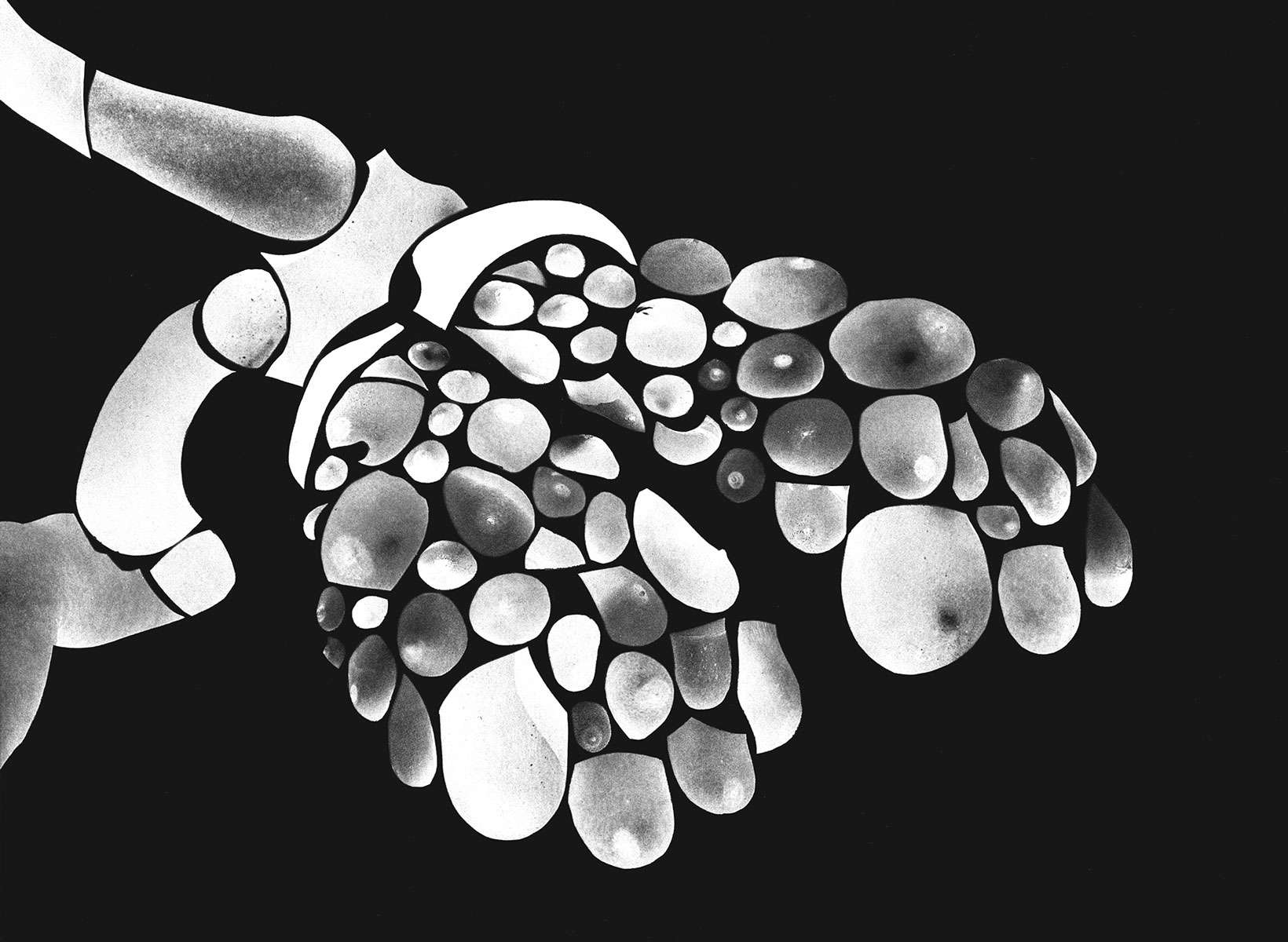
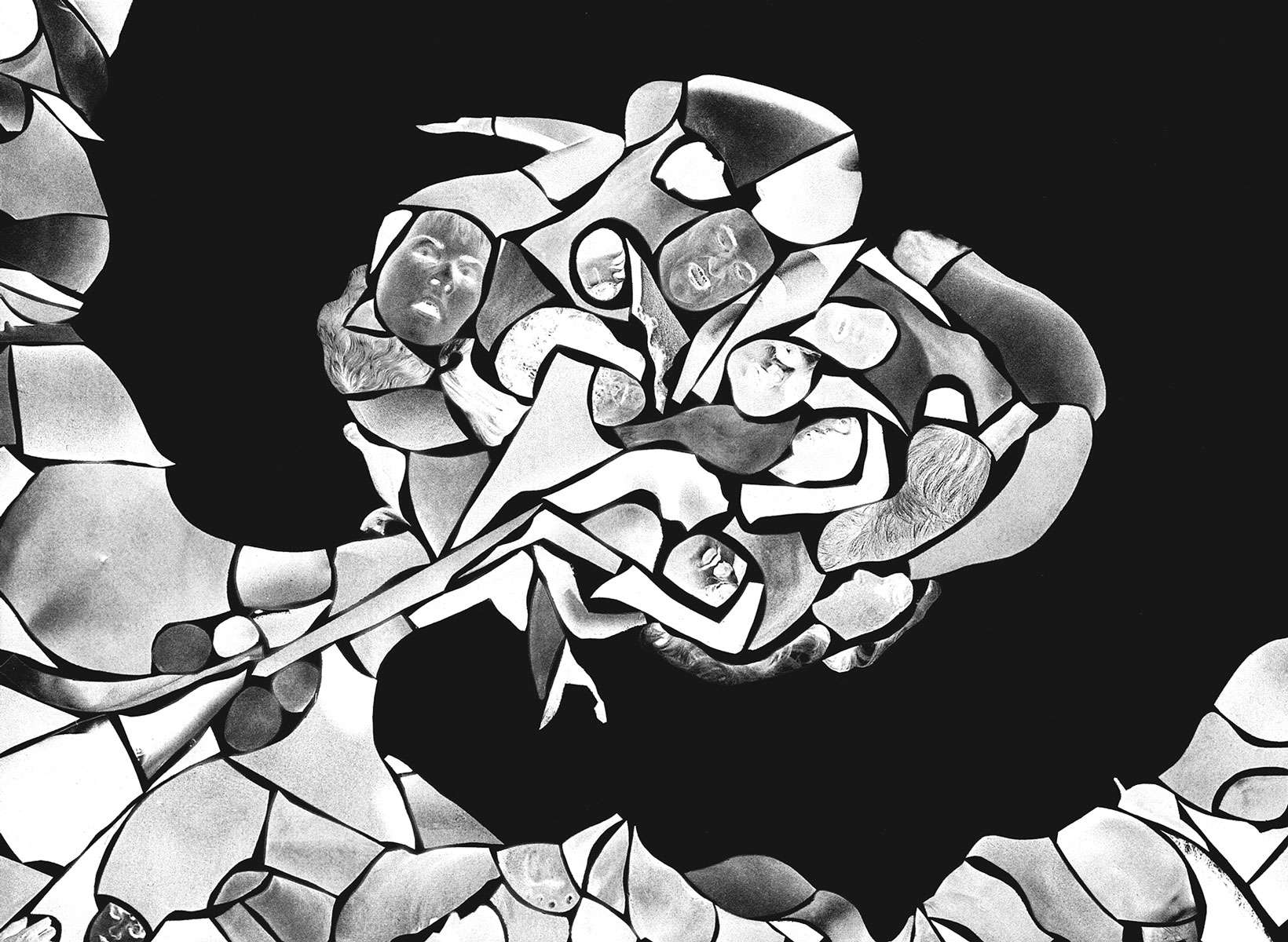
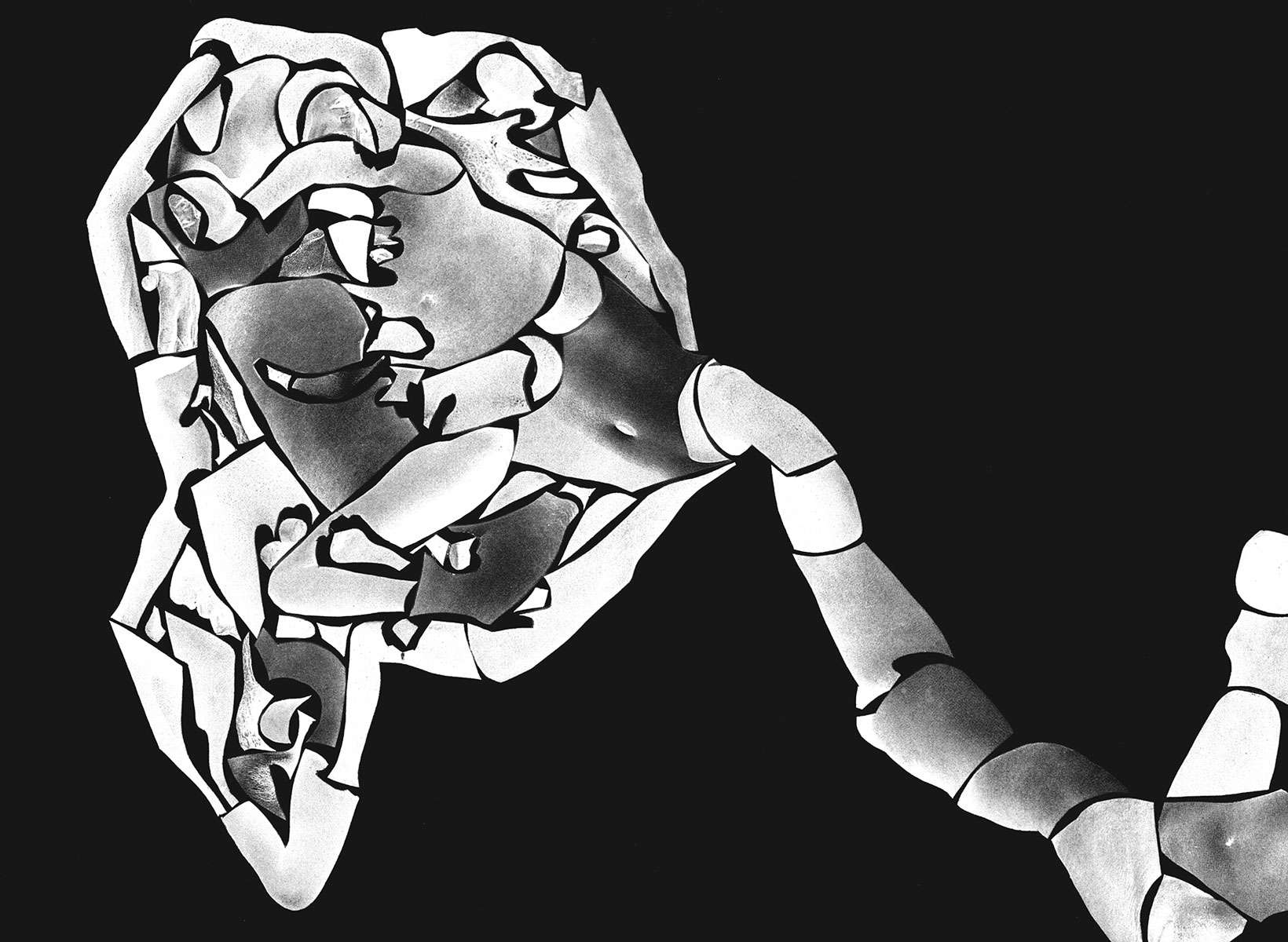
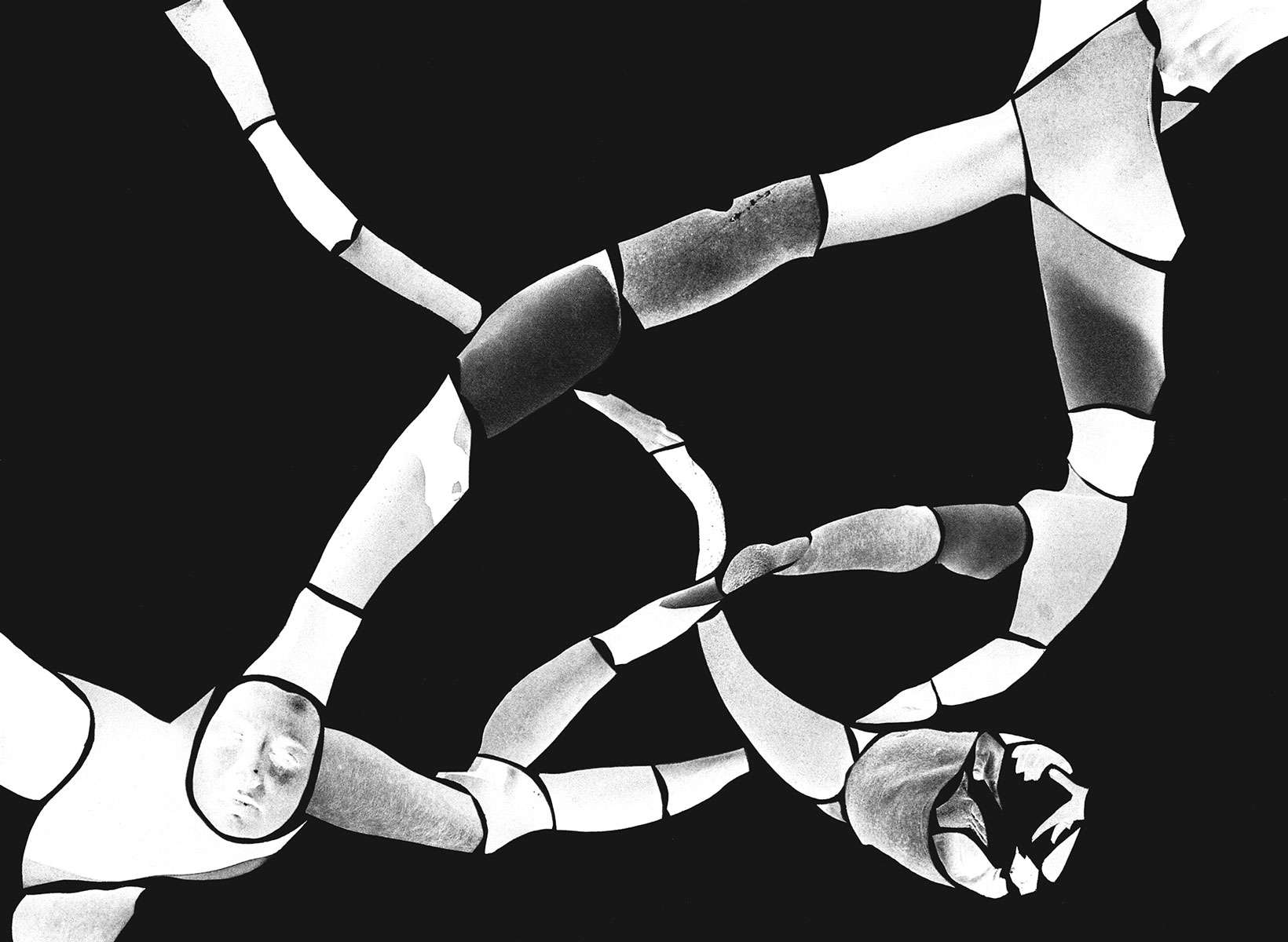
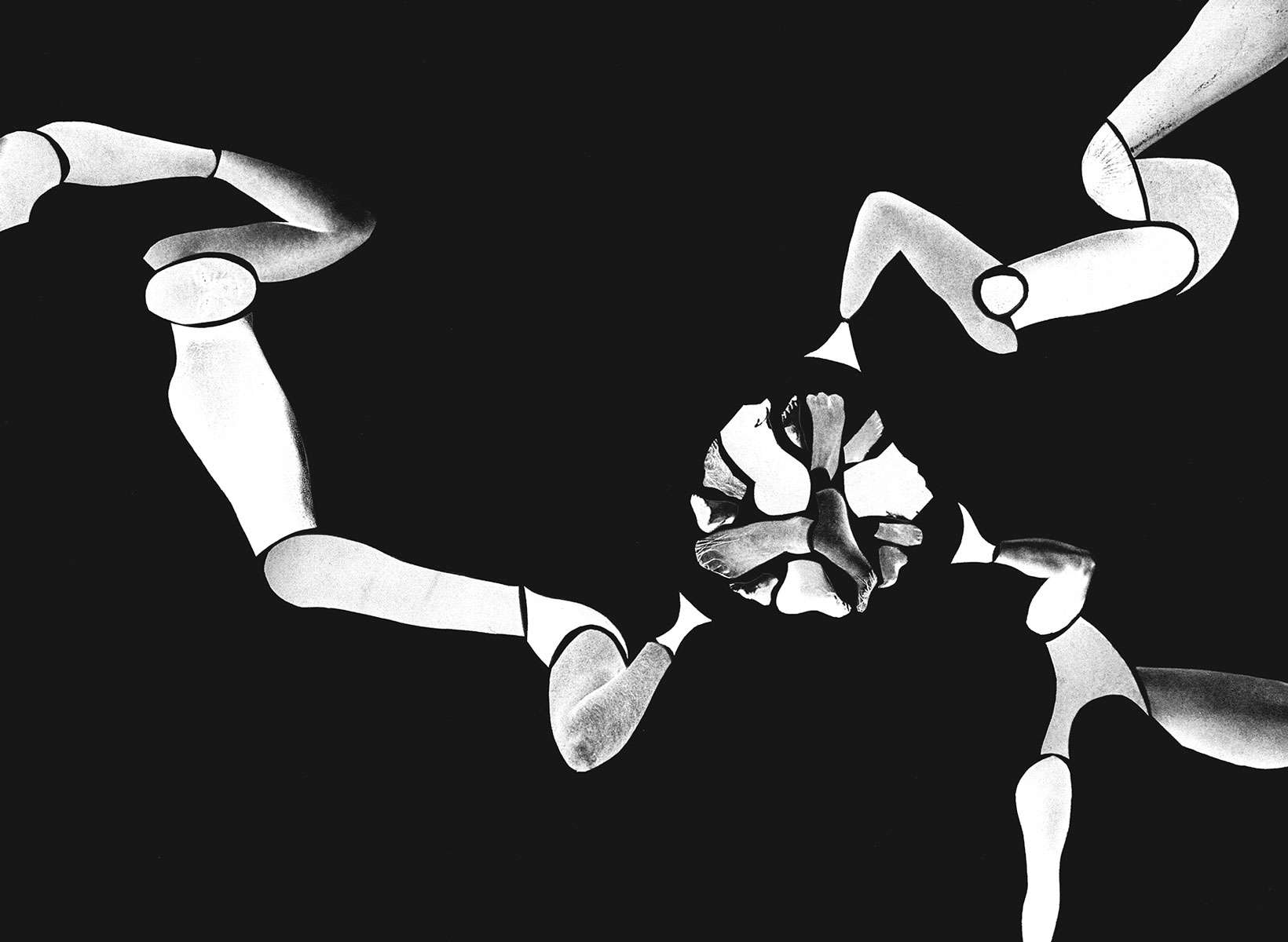
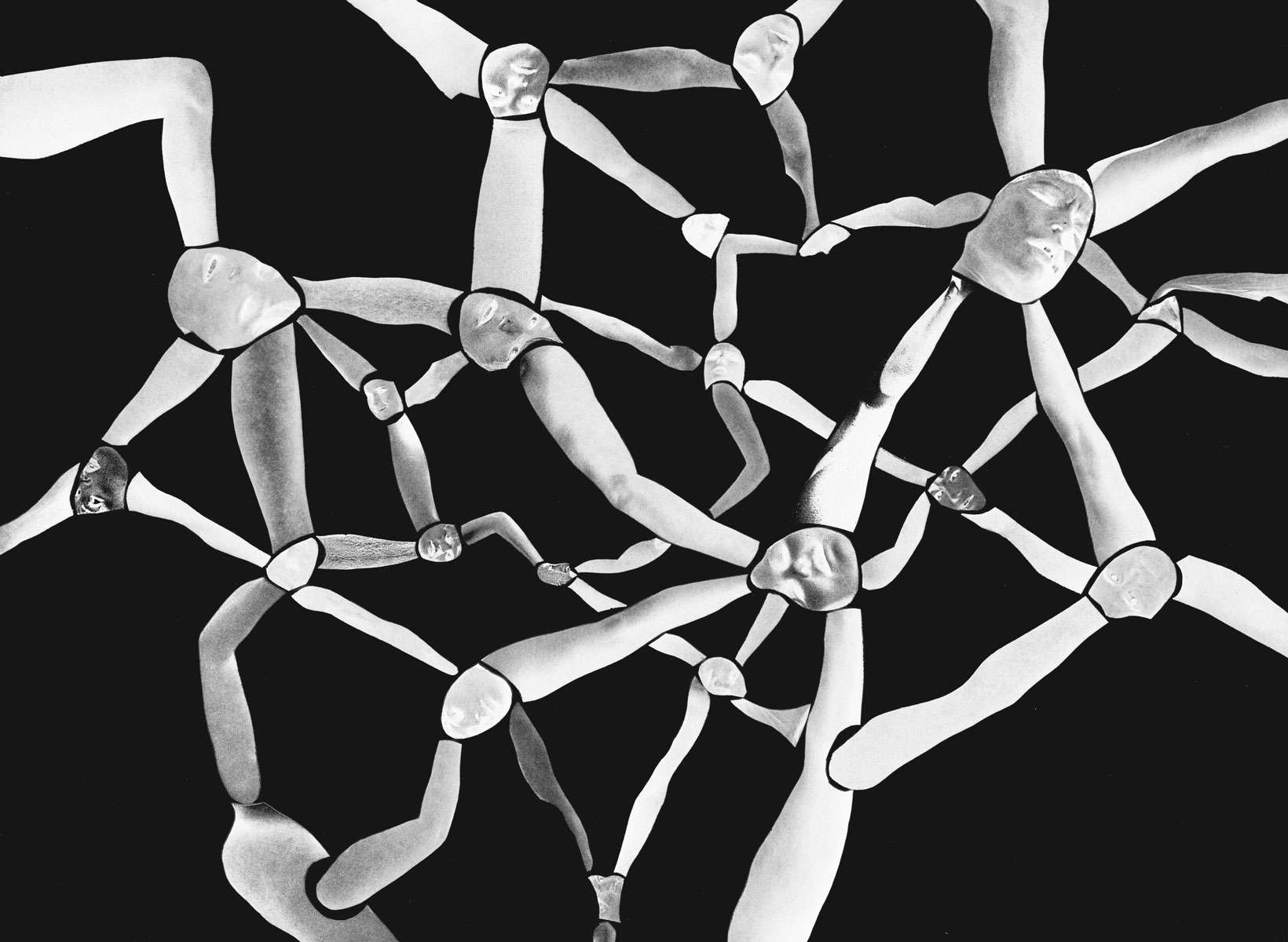
SPuB-internal, Scan of the Public Body, part 1-14 / print on plastic / each 37.5x27.5cm / 1995
The (abbreviated) titles of the works are SPuB-external, part x and SPuB-internal, part x. There is in fact also an official, longer title for the whole series registered in Archive. Click for the official title below.
Read more
The official title for the complete series SPuB-external is:
SPuB-external, Scan of the Public Body // PPuB / A001 - 01HOL26-1VKL15ST / A002 - 01SEV167P69-1VKL19ST / A003 - 01TUK15.12-2M1VKL35ST / A004 - 01TUK11.5-1VKL24ST / A005 - 01TUK11.5-1VKL23ST / A006 - 01TUK20.4-1VKL31ST / A007 - 01SEV168P45-1VKL20ST / A008 - 01TUK11.13P47-2VKL28ST / A009 - 01TUK11.13P45-2VKL31ST / A010 - 01TUK11.13P31-1VKL23ST / A011 - 01PUS20.5P2-1VKL20ST / A012 - 01ONB-2VKL31ST / A013 - 01HOL26-1VKL17ST / A014 - 01HOL26-1VKL24ST / A015 - 01TUK11.13P90-1VKL17ST / A016 - 01TUK18.19-1VKL14ST / A017 - 01SEV128P38-2VKL32ST / A018 - 01CHIONB-2VZW19ST / A019 - 01ONB-1V1MZW31ST / A020 - 01ONB-1M1VZW23ST / A021 - 01ORI11-1VKL16ST / A022 - 01TUK11.13P111-1V1MVSKL47ST / A023 - 01ONB3-1V1MKL25ST / A024 - 01TUKONB1-1VKL19ST / A025 - 01PUSONB1P82-1M1VKL29ST / A026 - 01JOLONB1-1VKL32ST / A027 - 01JOLONB2-1VKL17ST / A028 - 01TUK11.5P28-1VKL23ST / A029 - 01CHIONB-1VKL20ST / A030 - 01TUKONB2-1M1V1PKL31ST / A031 - 01TUKONB3-1M1V1PKL35ST / A032 - 01HOL26-1VVSKL47ST / A033 - 01CAN218P35-1VKL26ST / A034 - 01ONB4-2VKL30ST / A035 - 01TUK11.5P128-1VKL13ST / A036 - 01TUK11.5P123-1VKL24ST / A037 - 01TUK11.6P69-1VZW18ST / A038 - 01PUSONB2P117-1VKL9ST / A039 - 01TUK11.5P44-2VKL24ST / A040 - 01TUK18.9-2VKL23ST / A041 - 01TUK11.5P126-1VKL19ST / A042 - 01POS36-1V1MZW31ST
The official title for the complete series SPuB-internal is:
SPuB, Scan of the Public Body // PPuB / A001 - 01HOL26-1VKL15ST / A002 - 01SEV167P69-1VKL19ST / A003 - 01TUK15.12-2M1VKL35ST / A004 - 01TUK11.5-1VKL24ST / A005 - 01TUK11.5-1VKL23ST / A006 - 01TUK20.4-1VKL31ST / A007 - 01SEV168P45-1VKL20ST / A008 - 01TUK11.13P47-2VKL28ST / A009 - 01TUK11.13P45-2VKL31ST / A010 - 01TUK11.13P31-1VKL23ST / A011 - 01PUS20.5P2-1VKL20ST / A012 - 01ONB-2VKL31ST / A013 - 01HOL26-1VKL17ST / A014 - 01HOL26-1VKL24ST / A015 - 01TUK11.13P90-1VKL17ST / A016 - 01TUK18.19-1VKL14ST / A017 - 01SEV128P38-2VKL32ST / A018 - 01CHIONB-2VZW19ST / A019 - 01ONB-1V1MZW31ST / A020 - 01ONB-1M1VZW23ST / A021 - 01ORI11-1VKL16ST / A022 - 01TUK11.13P111-1V1MVSKL47ST / A023 - 01ONB3-1V1MKL25ST / A024 - 01TUKONB1-1VKL19ST / A025 - 01PUSONB1P82-1M1VKL29ST / A026 - 01JOLONB1-1VKL32ST / A027 - 01JOLONB2-1VKL17ST / A028 - 01TUK11.5P28-1VKL23ST / A029 - 01CHIONB-1VKL20ST / A030 - 01TUKONB2-1M1V1PKL31ST / A031 - 01TUKONB3-1M1V1PKL35ST / A032 - 01HOL26-1VVSKL47ST / A033 - 01CAN218P35-1VKL26ST / A034 - 01ONB4-2VKL30ST / A035 - 01TUK11.5P128-1VKL13ST / A036 - 01TUK11.5P123-1VKL24ST / A037 - 01TUK11.6P69-1VZW18ST / A038 - 01PUSONB2P117-1VKL9ST / A039 - 01TUK11.5P44-2VKL24ST / A040 - 01TUK18.9-2VKL23ST / A041 - 01TUK11.5P126-1VKL19ST / A042 - 01POS36-1V1MZW31ST
Also, a drawing (DPuB) was made of every Scan of the Public Body.
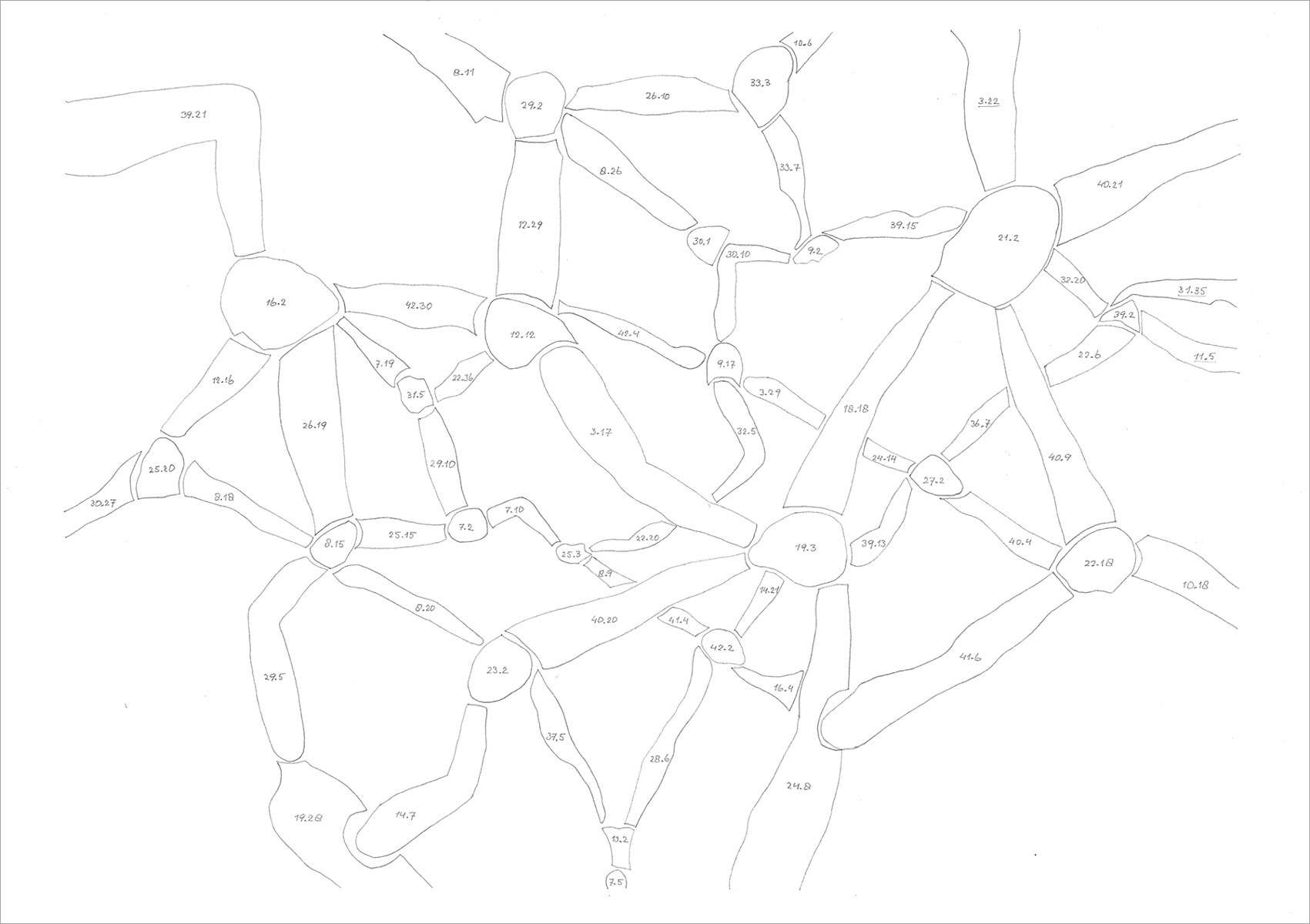 Drawing DPuB of part 14 of the Scan of the Public Body.
Drawing DPuB of part 14 of the Scan of the Public Body.
The External Research department of the Institute for Research of the Public Body is outward-oriented. Its staff carry out field research, directly in the Public Body, in the middle of all the people who show themselves to the outside world.
This department often collaborates with people outside of the Institute. It also subsidizes and supports third party initiatives. For more projects to which it has contributed see: More Body.
It also directly processes various images of Public Bodies. In contrast to Archives, these images are not stored but used in its own works, research, products and publications.
For its own external services, there are several specific sections, such as Field Work and Cartography.
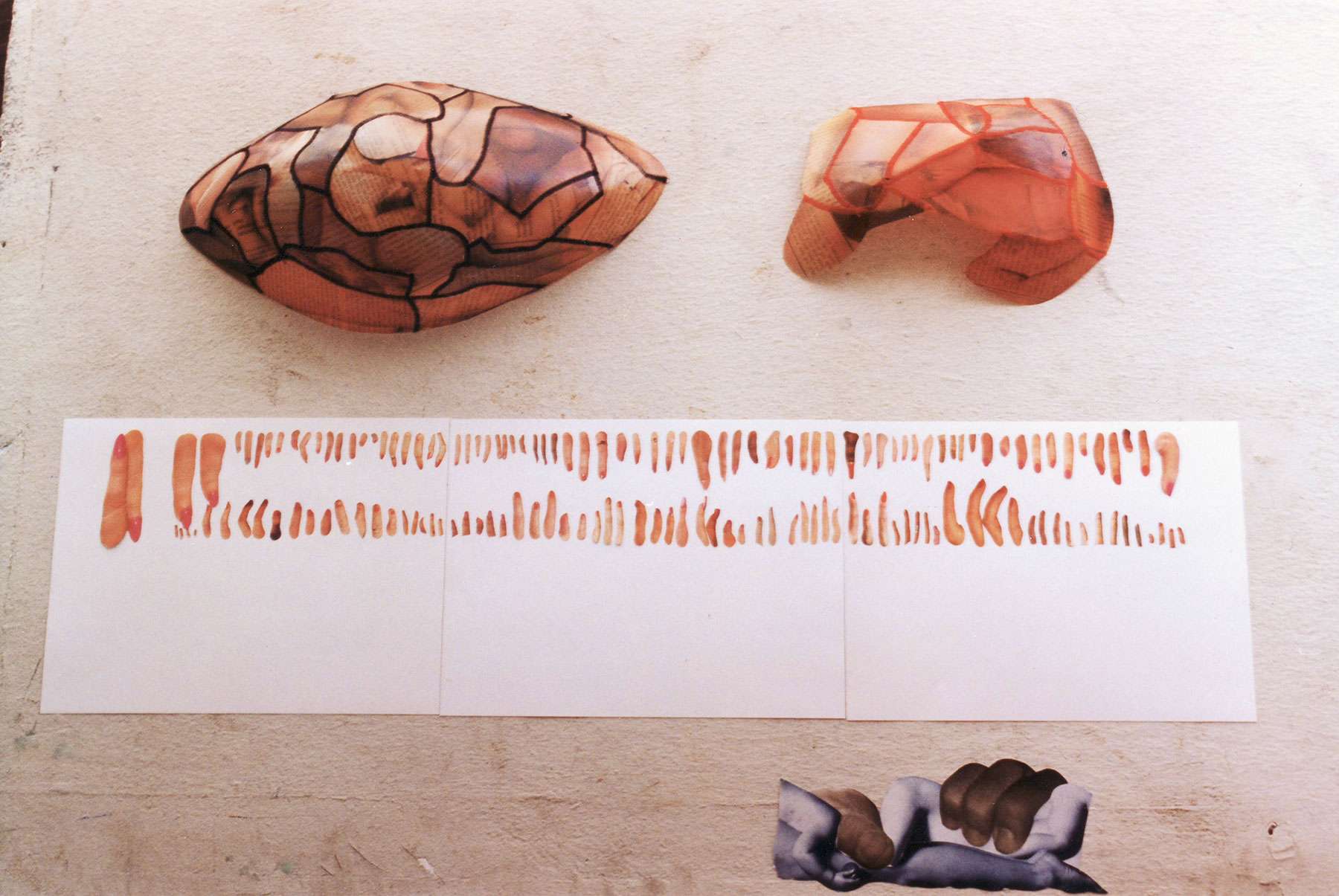
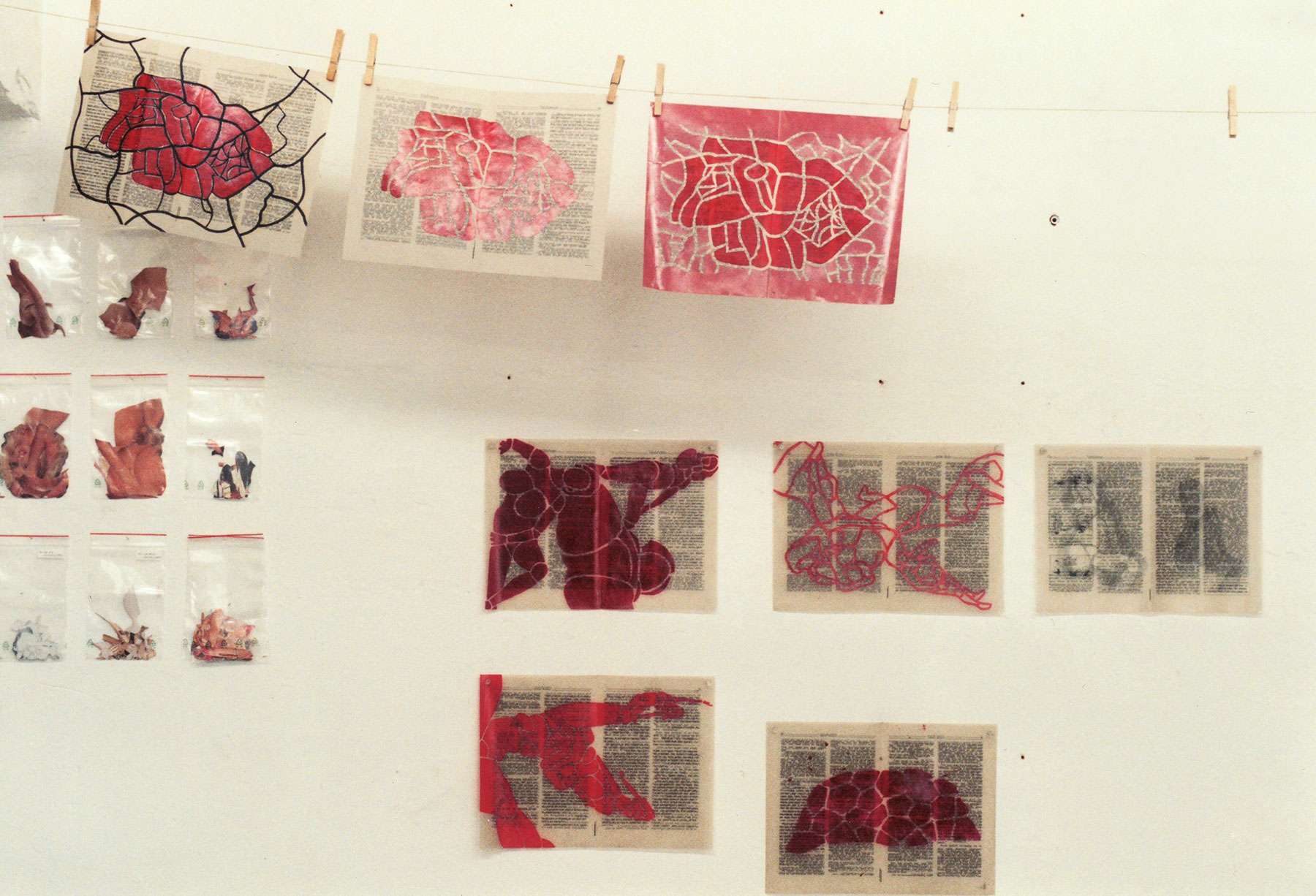
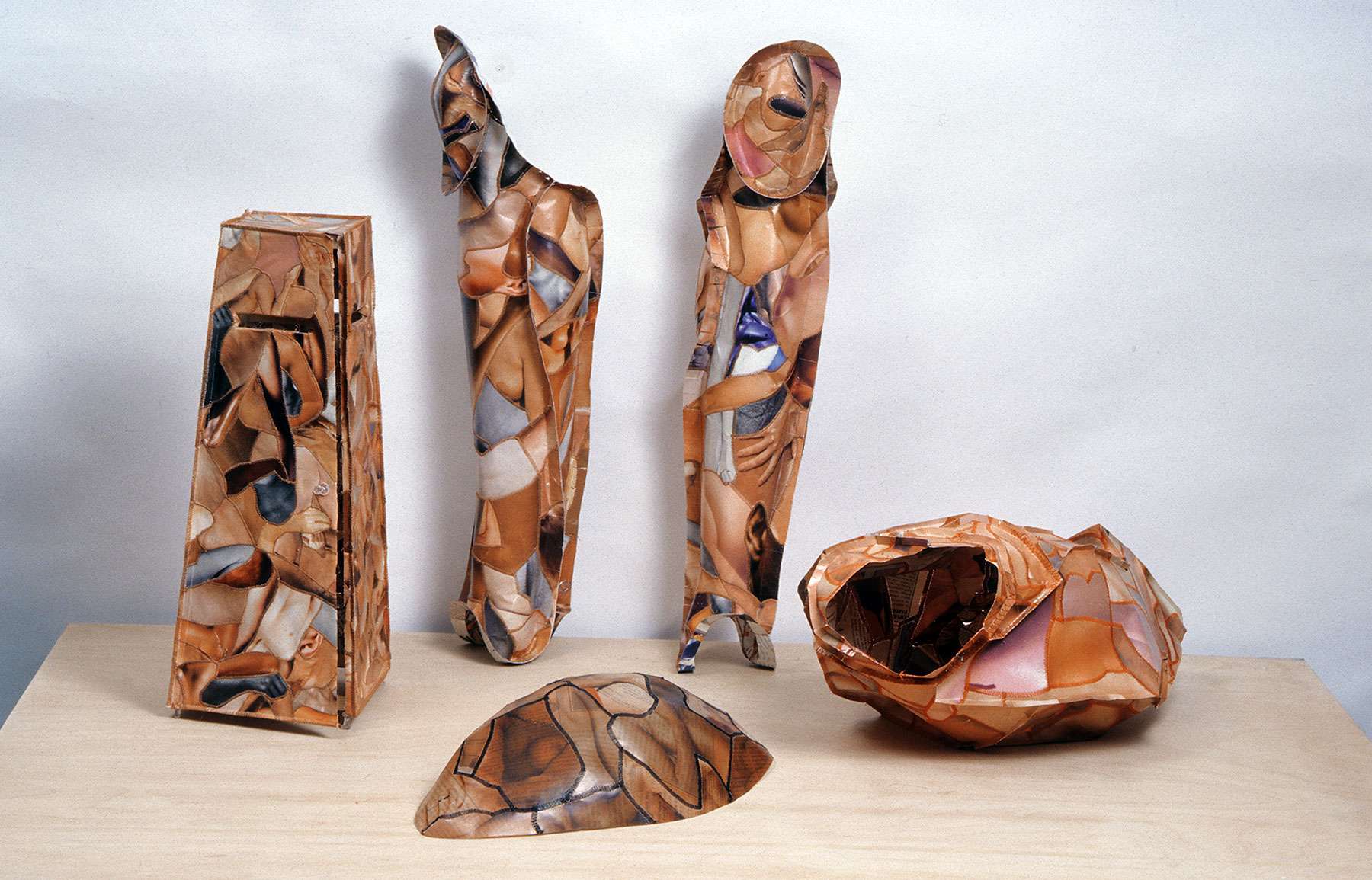

The Field Work section is aimed specifically at developing suitable tools for the staff of the External Research department to use in the field. These are mainly means to help staff in dealing with Public Bodies so that they can carry out their research undisturbed.
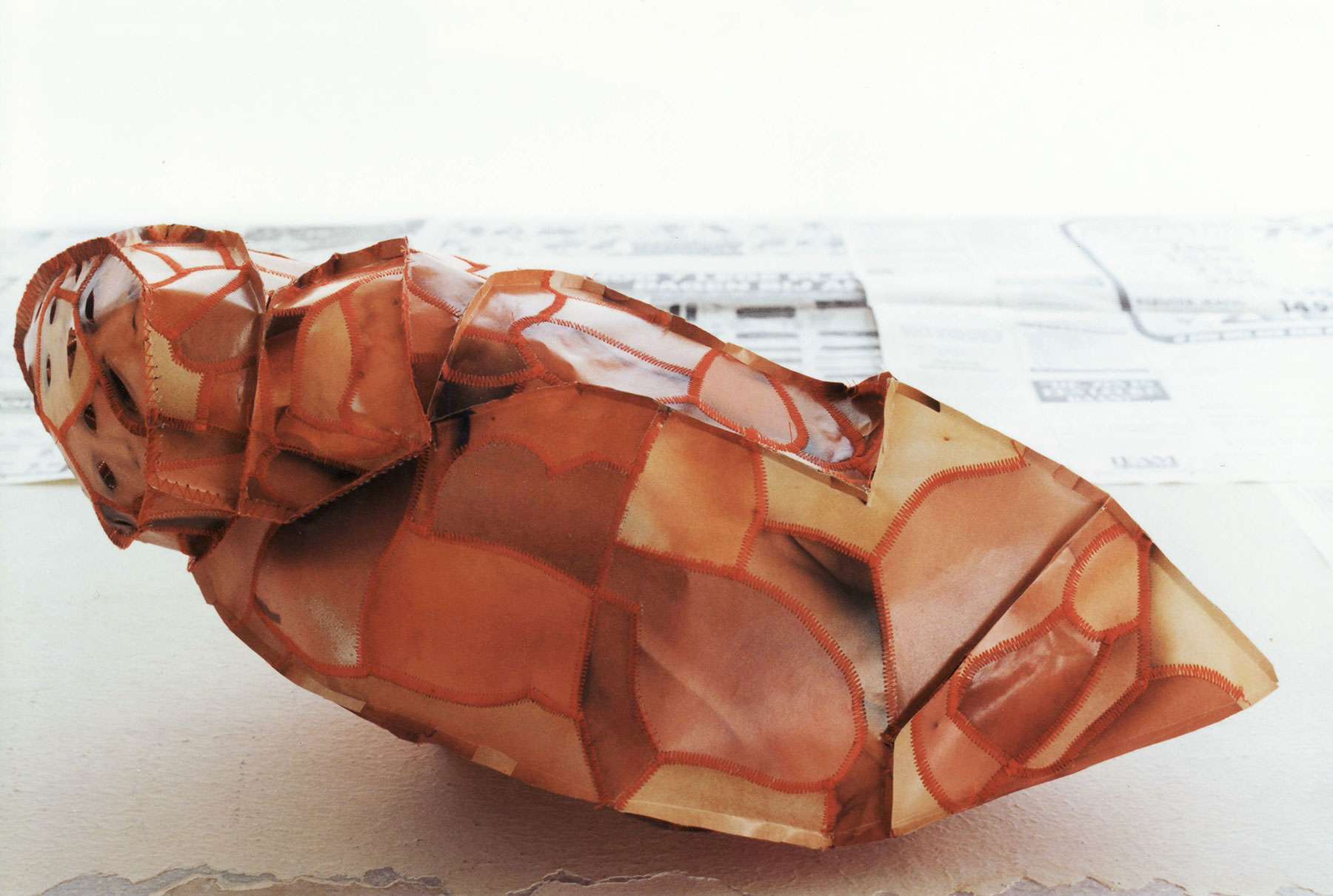
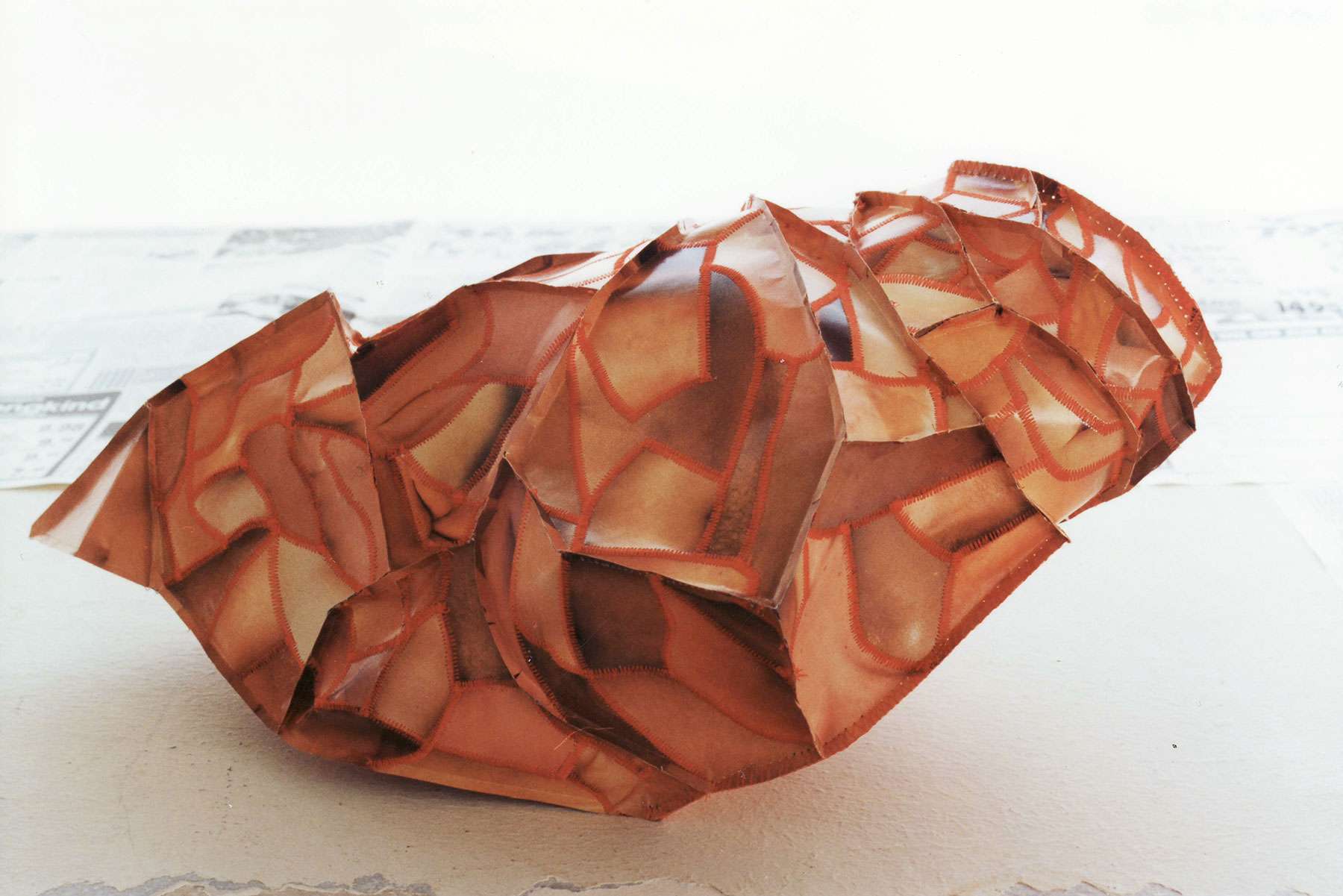

 Sample models Public Body and camouflage
Sample models Public Body and camouflage
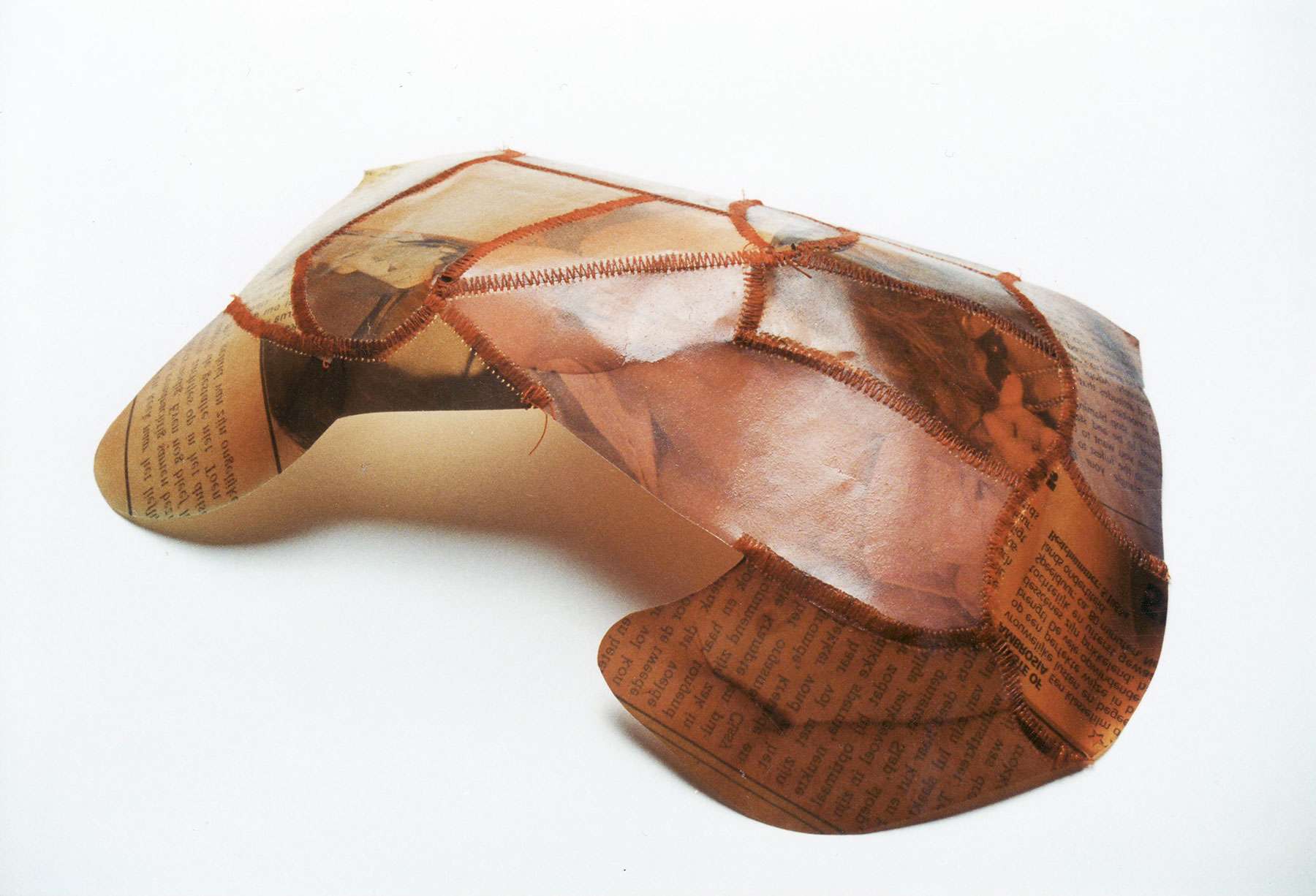
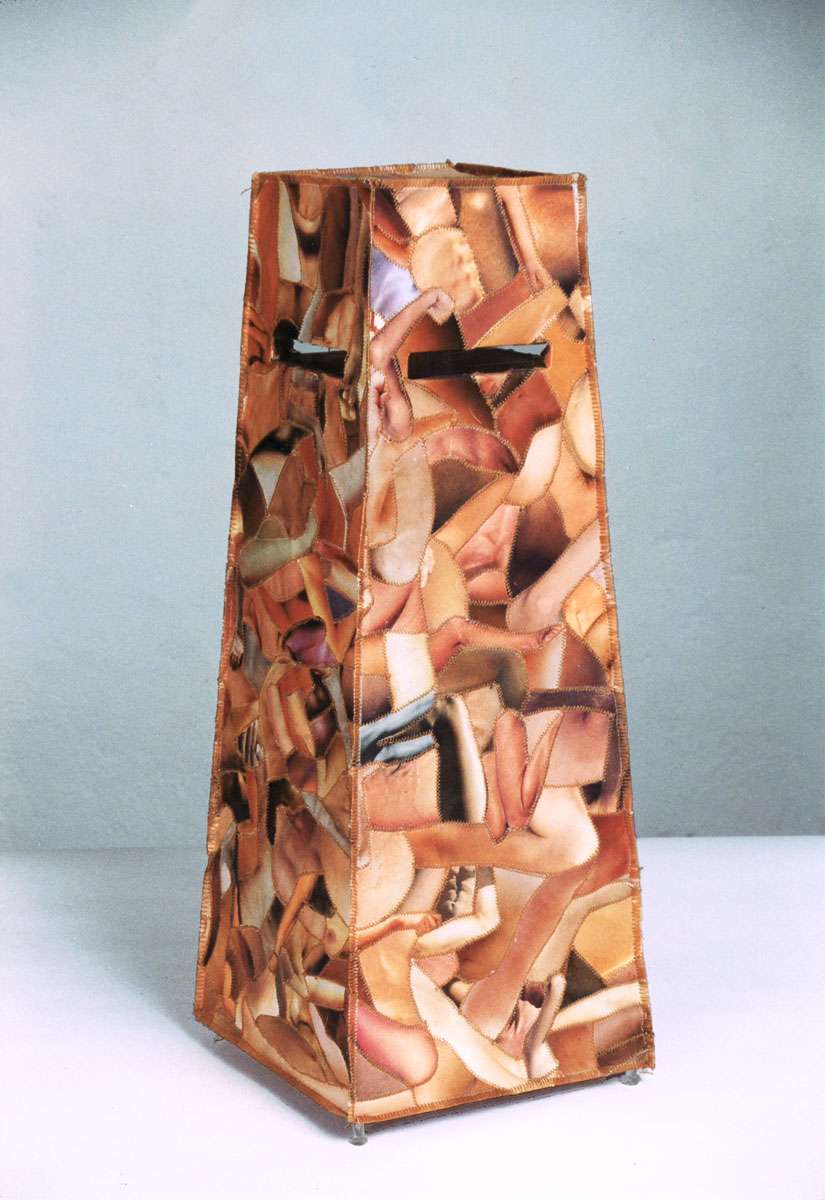 Sample models shelter
Sample models shelter
Small sample models of the Public Body and models for a shelter have first been made. Camouflage items were then developed based on these. They are suitable to be worn by staff and so blend in with the Public Body.
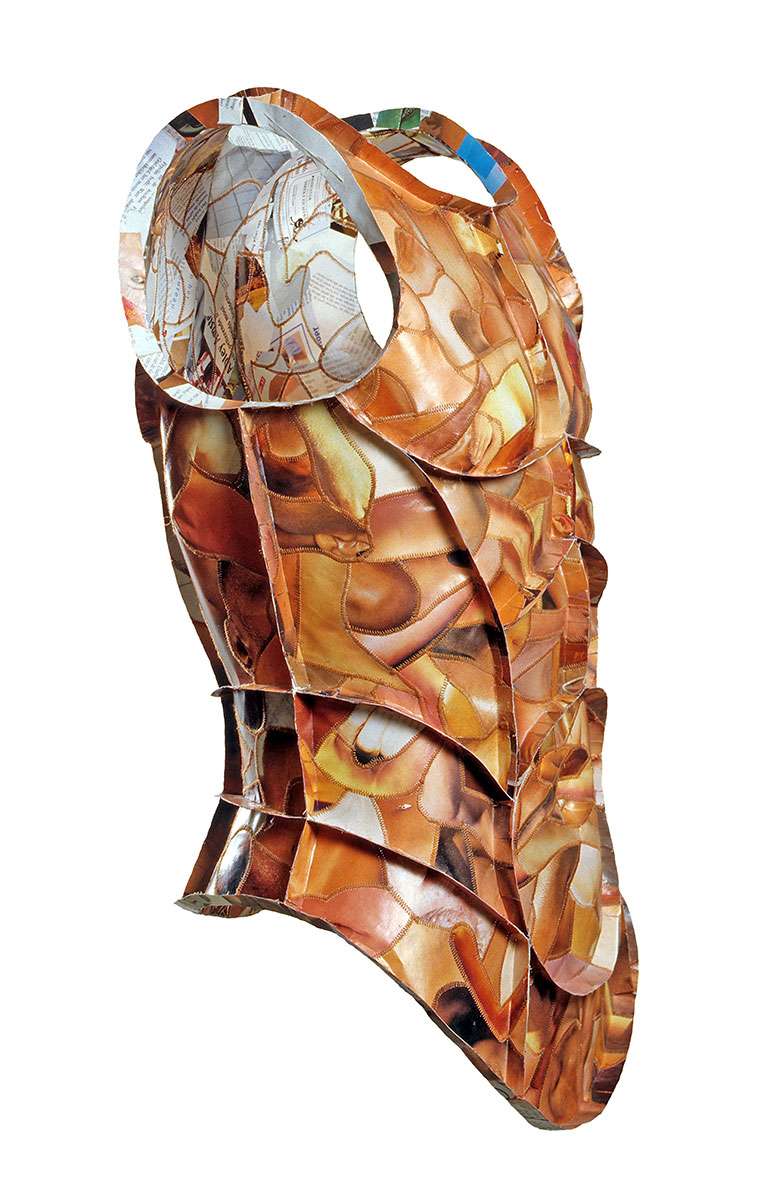
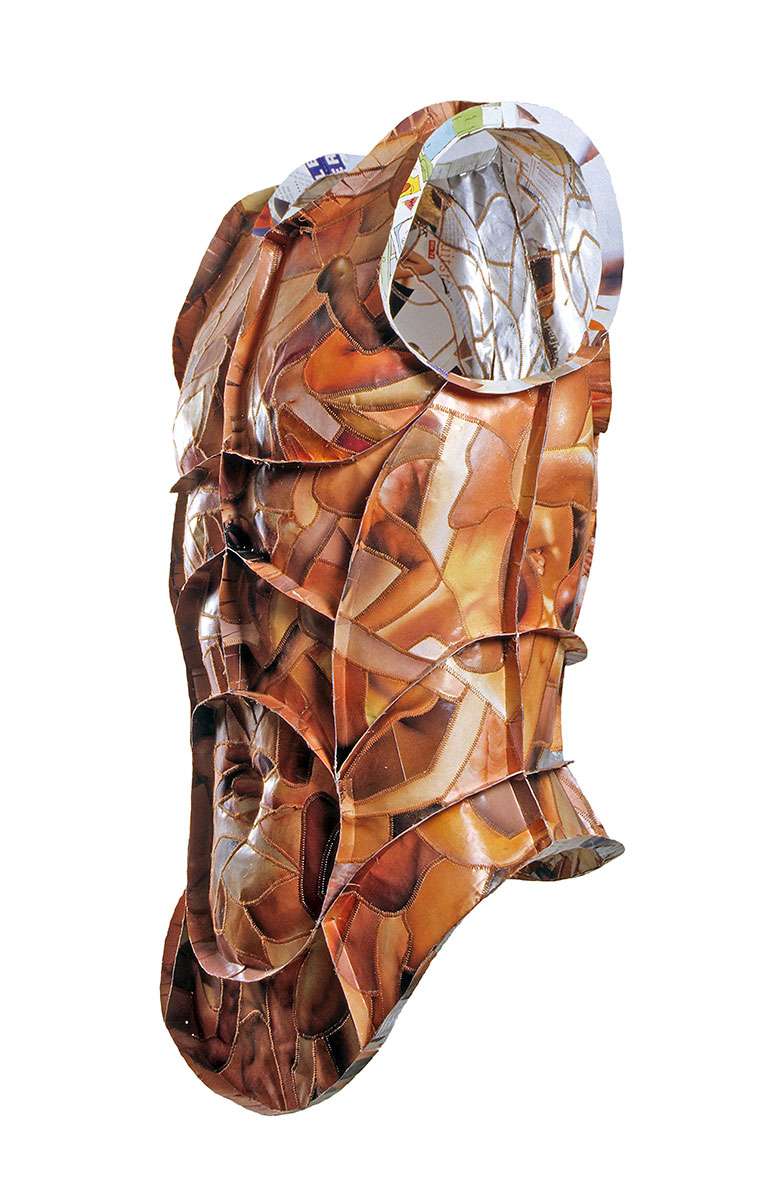
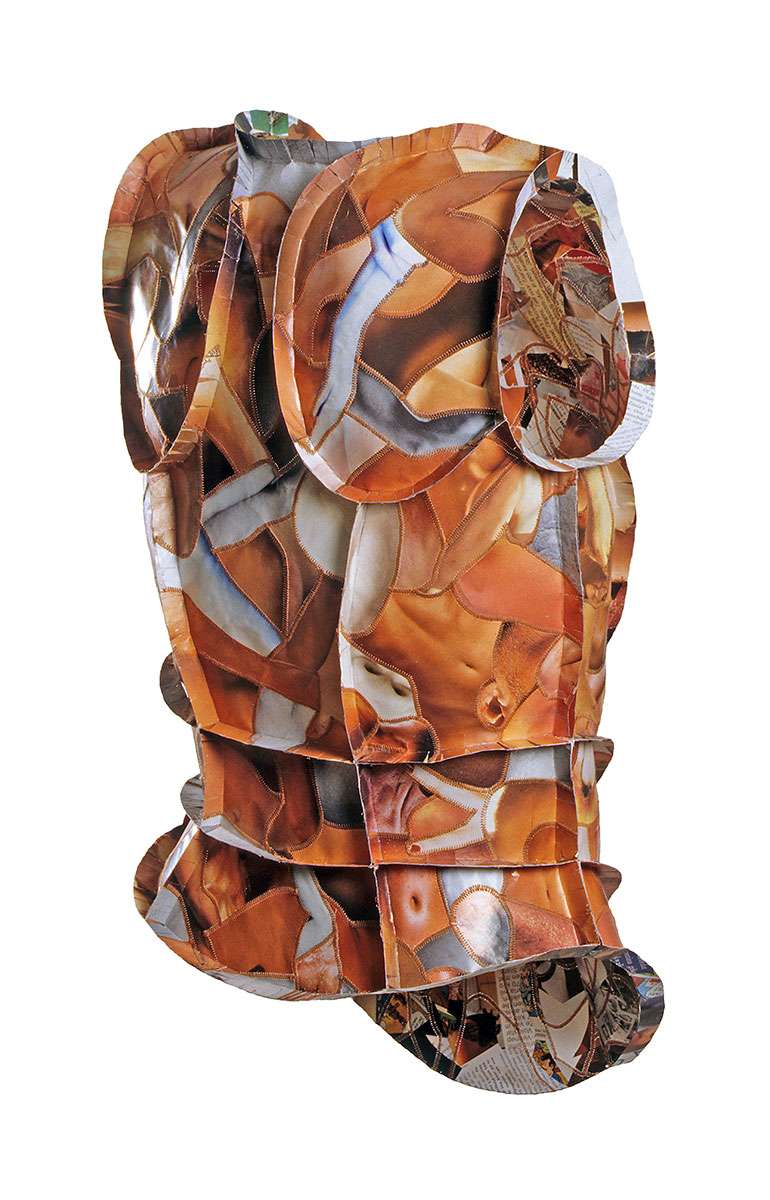
camouflage harness - torso 1 / paper, yarn, snap fasteners / 38x70x27cm / 1996
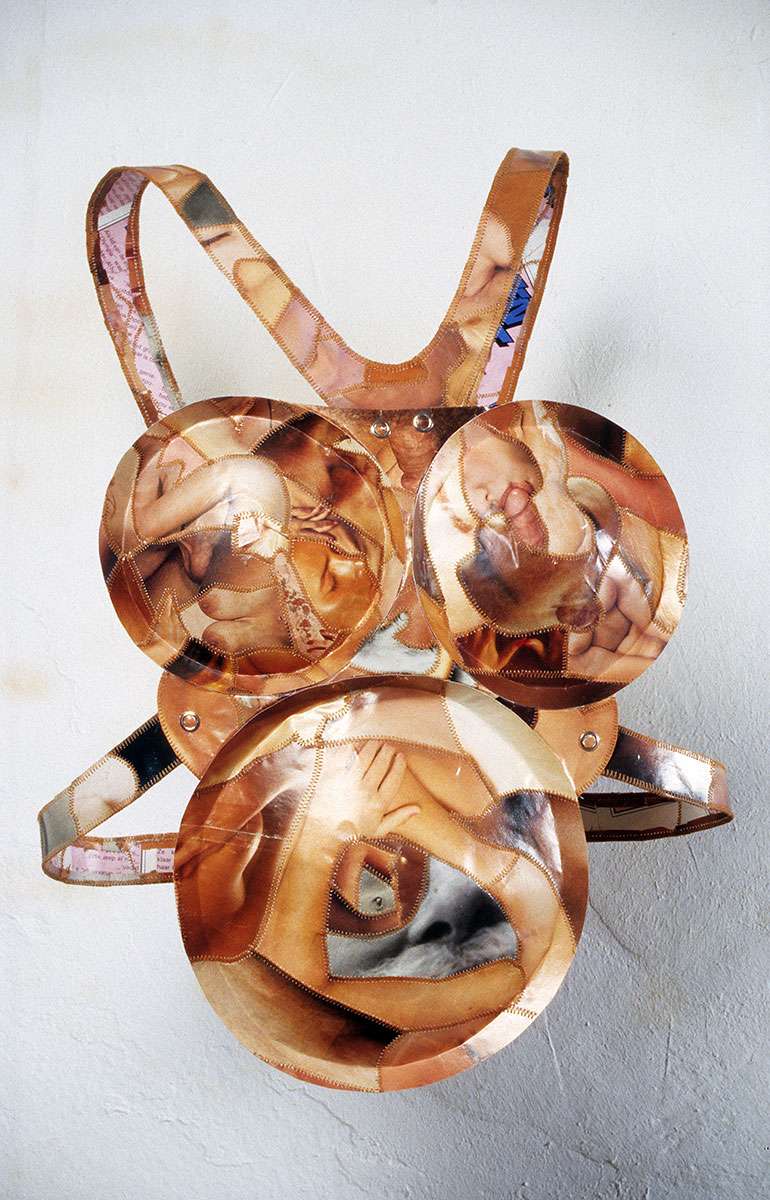 camouflage harness – chest 1 / paper, yarn, snap fasteners / 50x53x25cm / 1998
camouflage harness – chest 1 / paper, yarn, snap fasteners / 50x53x25cm / 1998
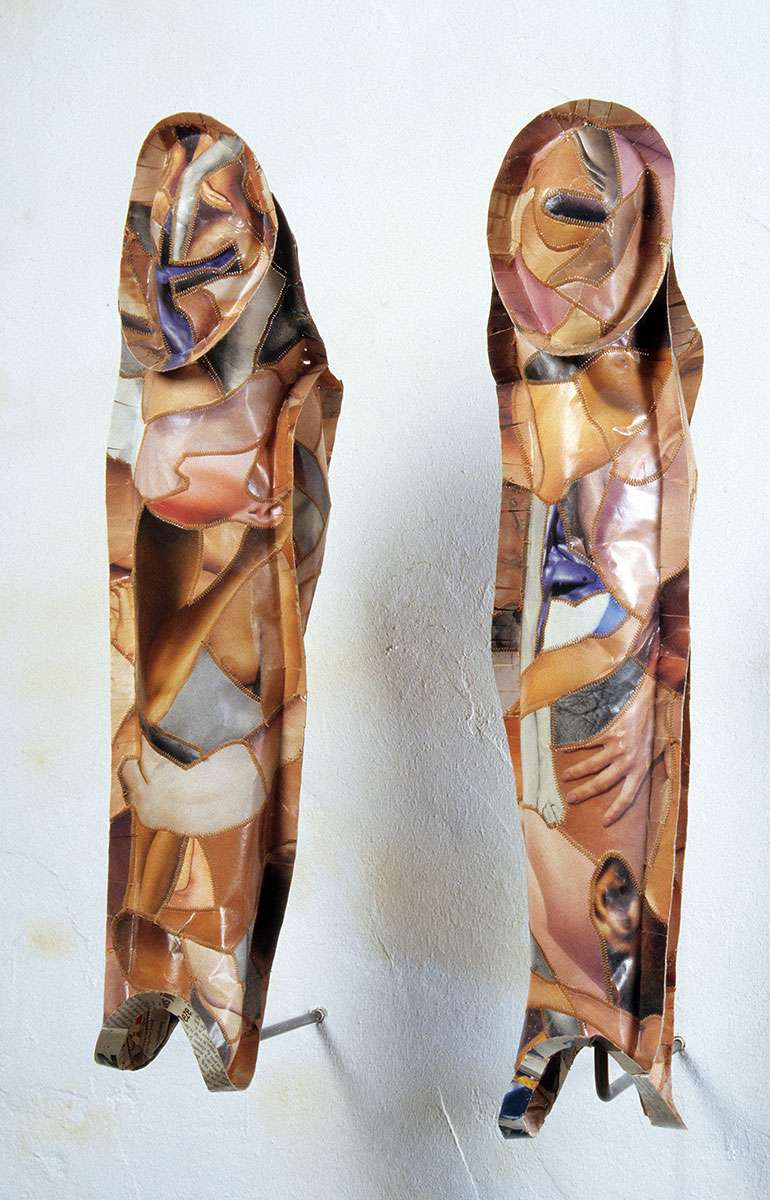 camouflage harness – leg protectors 1 / paper, yarn, snap fasteners / each 13x15x58cm / 1998
camouflage harness – leg protectors 1 / paper, yarn, snap fasteners / each 13x15x58cm / 1998
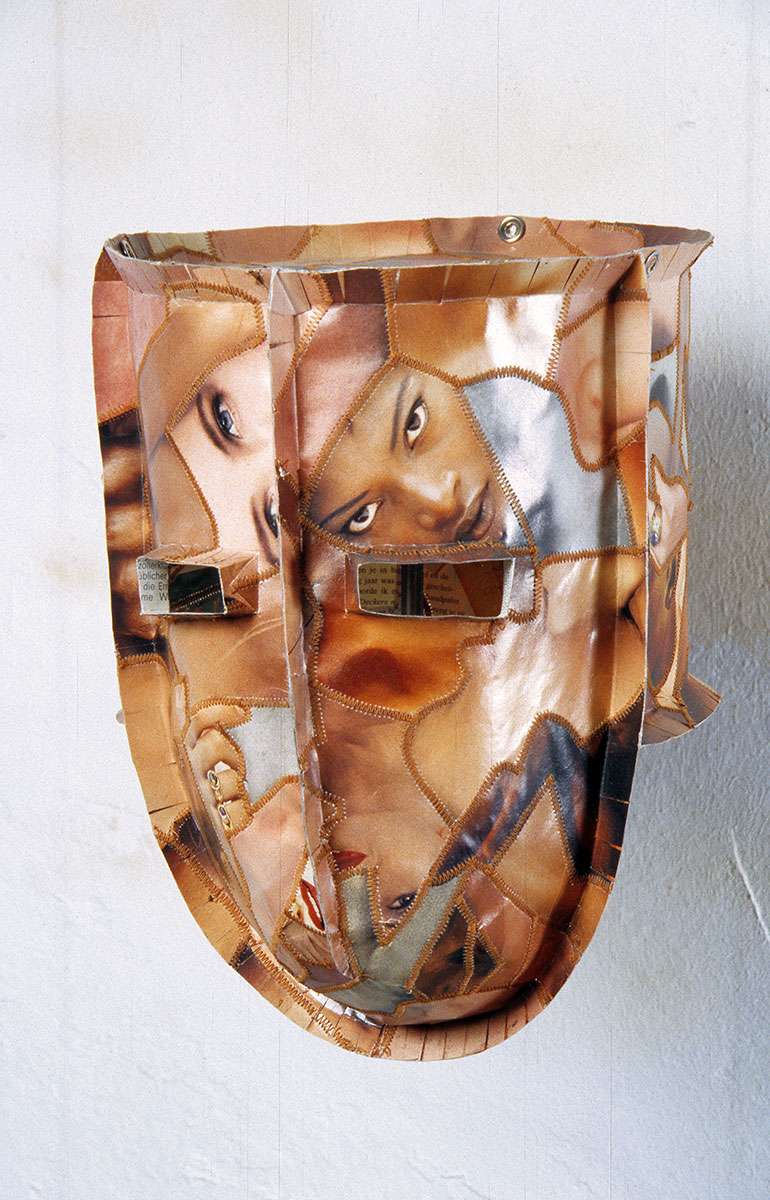 camouflage harness – helmet 1 / paper, yarn, snap fasteners / 23x27x29cm / 1998
camouflage harness – helmet 1 / paper, yarn, snap fasteners / 23x27x29cm / 1998
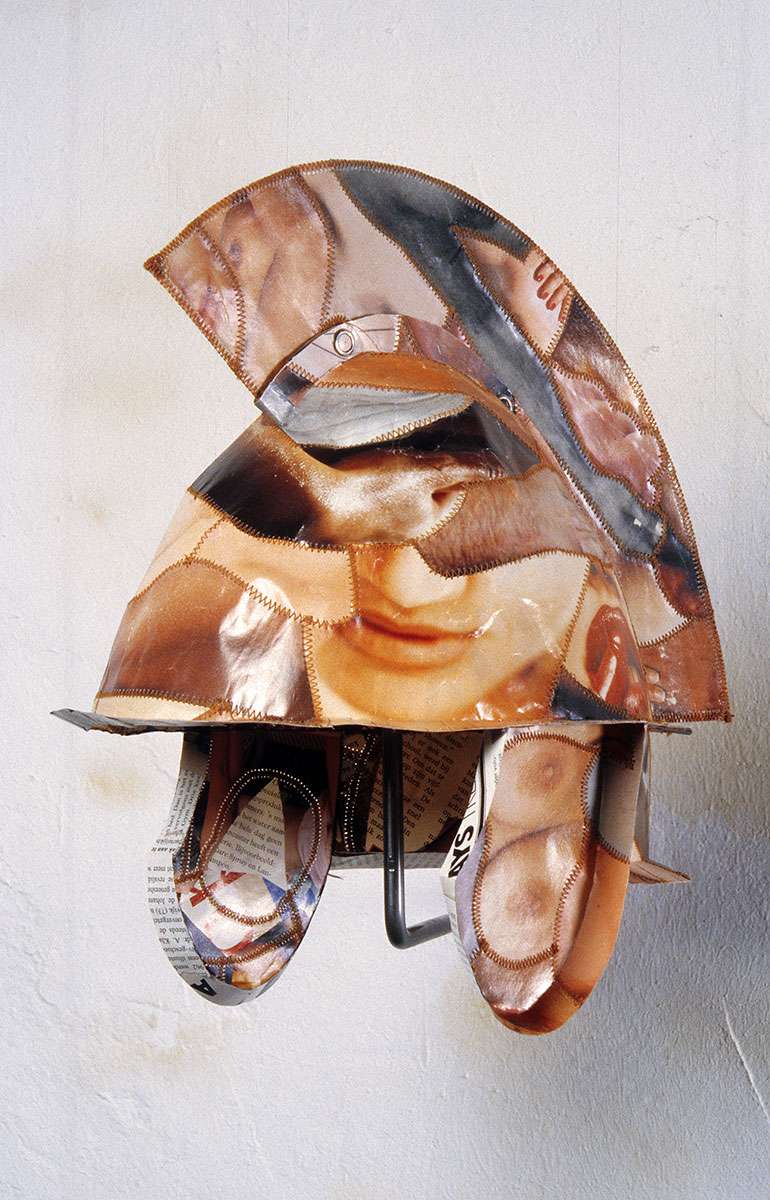
 camouflage harness – helmet 2 / paper, yarn, snap fasteners / 23x30x33cm / 1998
camouflage harness – helmet 2 / paper, yarn, snap fasteners / 23x30x33cm / 1998
The material used for this, is the same as for Archive. The difference being that the source material from the images of the Public Body is used directly (1:1) without first being saved and archived.
Because of the direct use by staff, a precise size and fit is important.
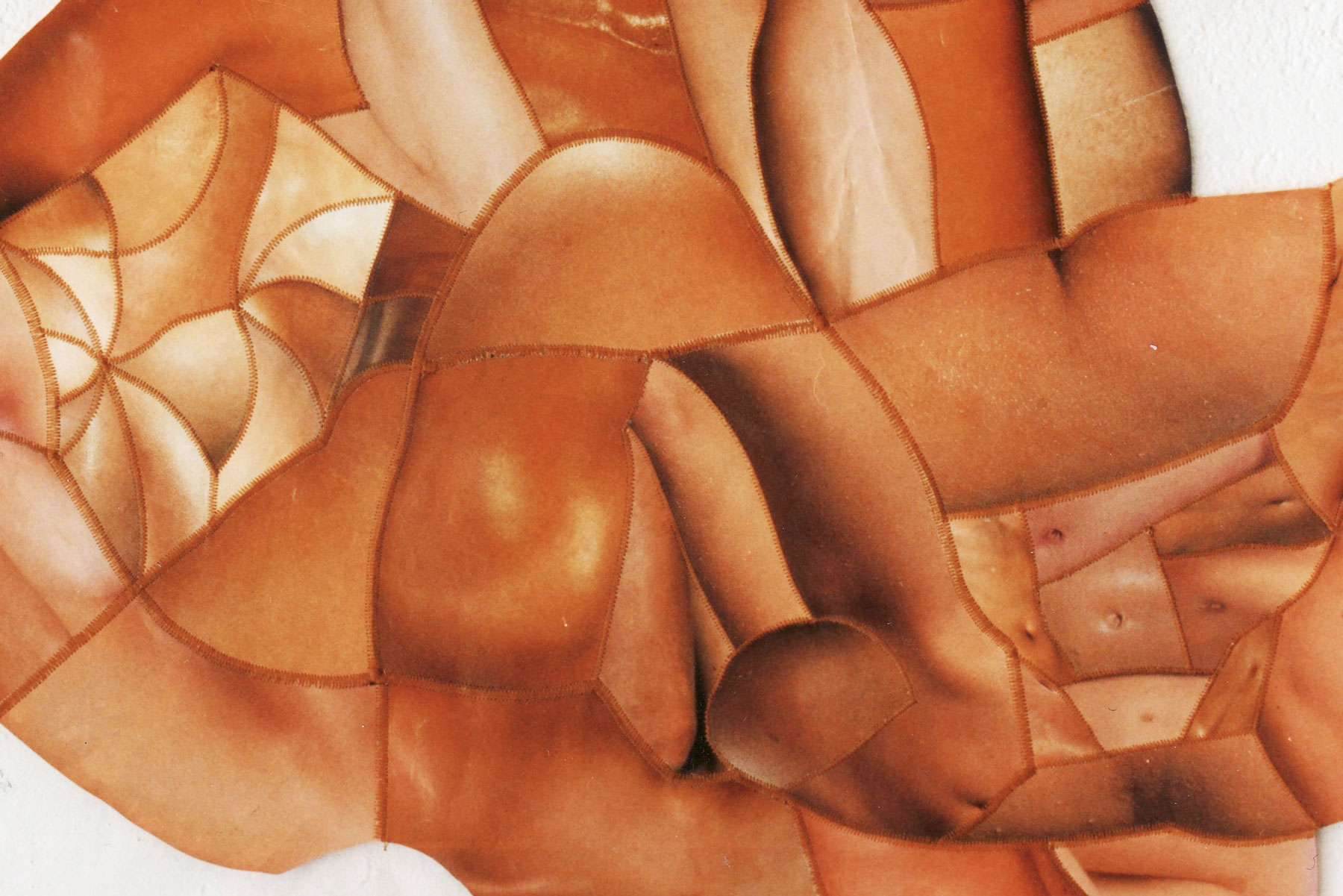
The Cartography section is equally focused on supporting the External Research department staff. Specifically, it develops the MPuB, the maps of the Public Body that help the researchers in the field to navigate in the Public Body. Conversely, it maps out the field work afterwards.
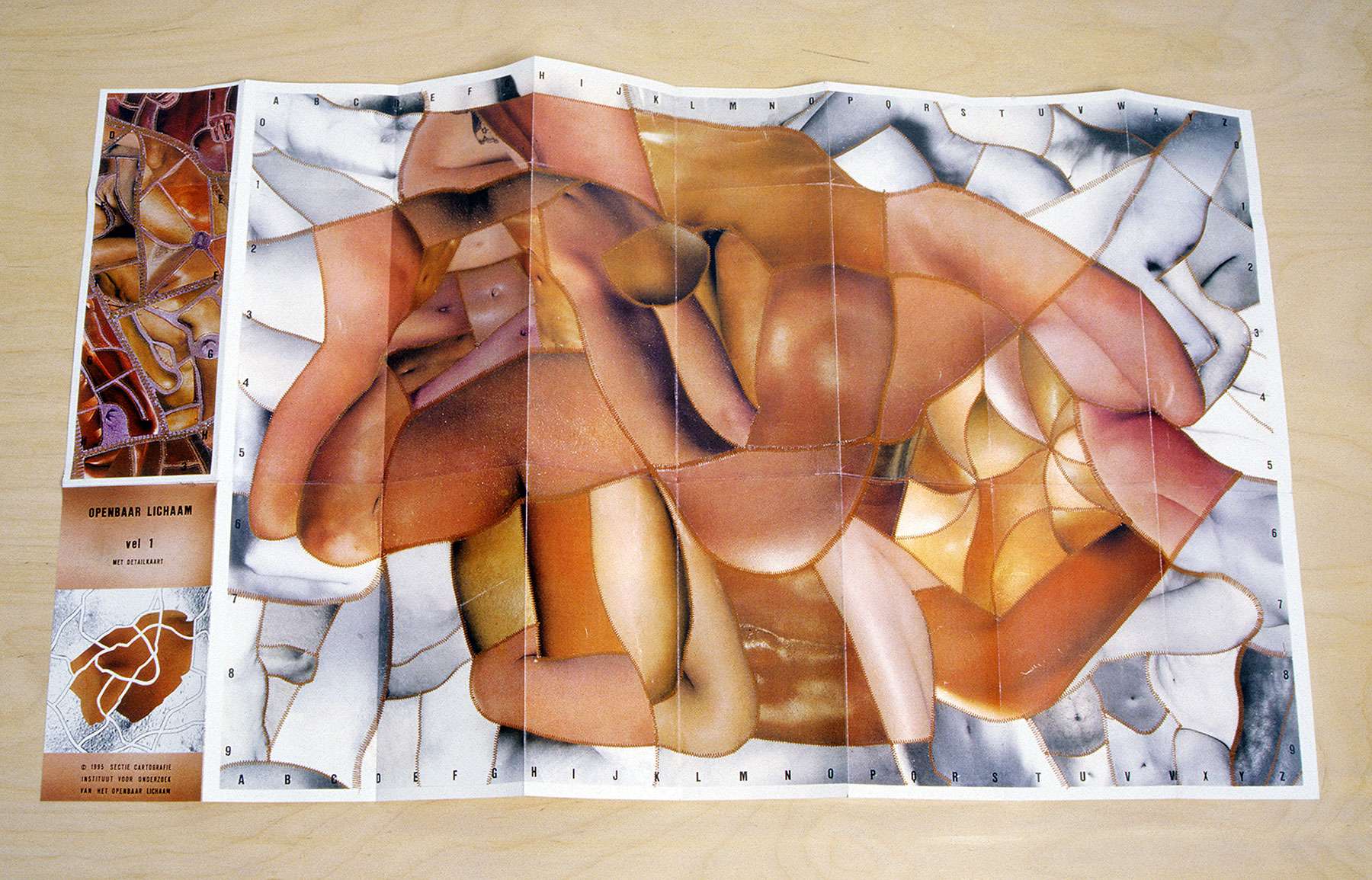
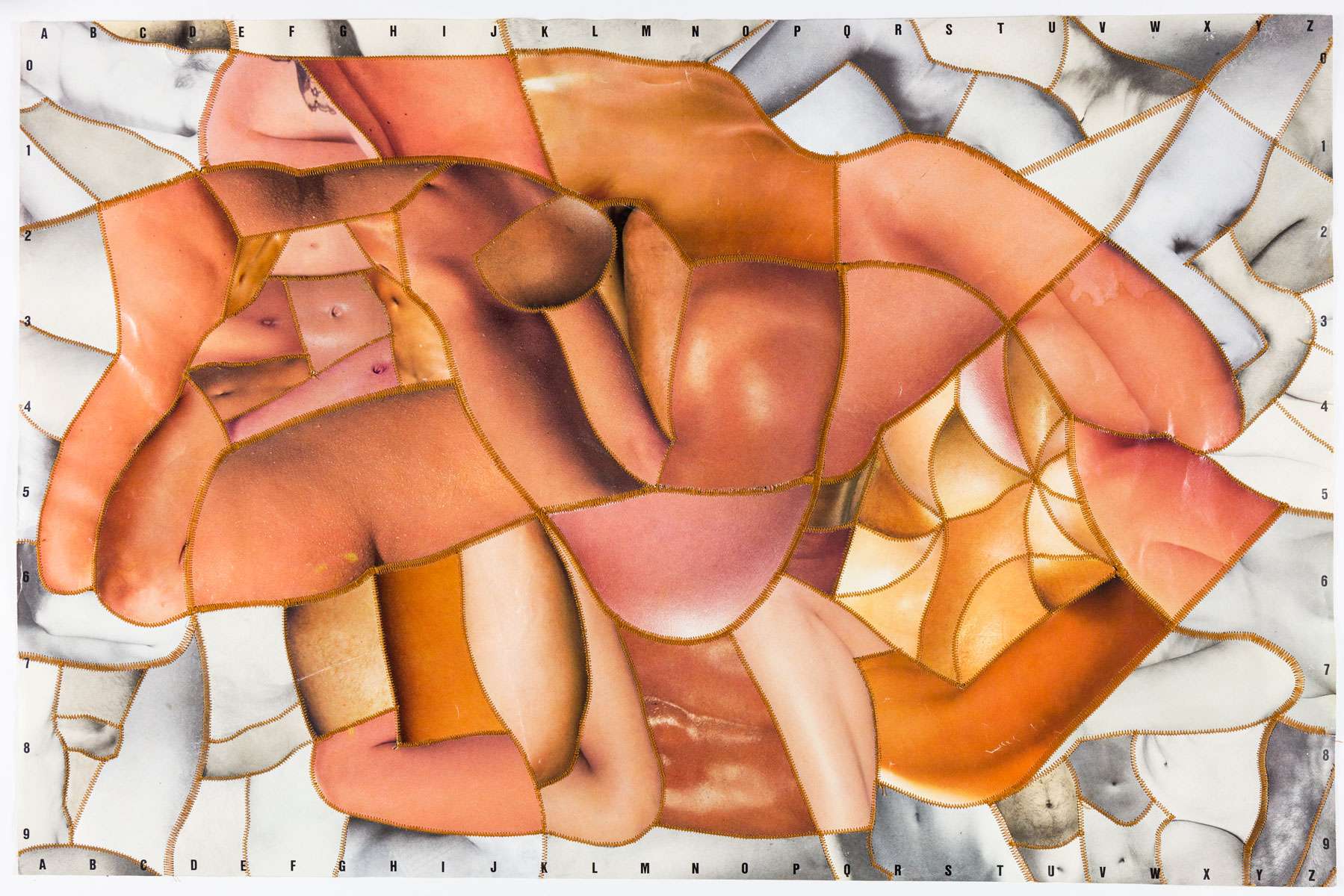
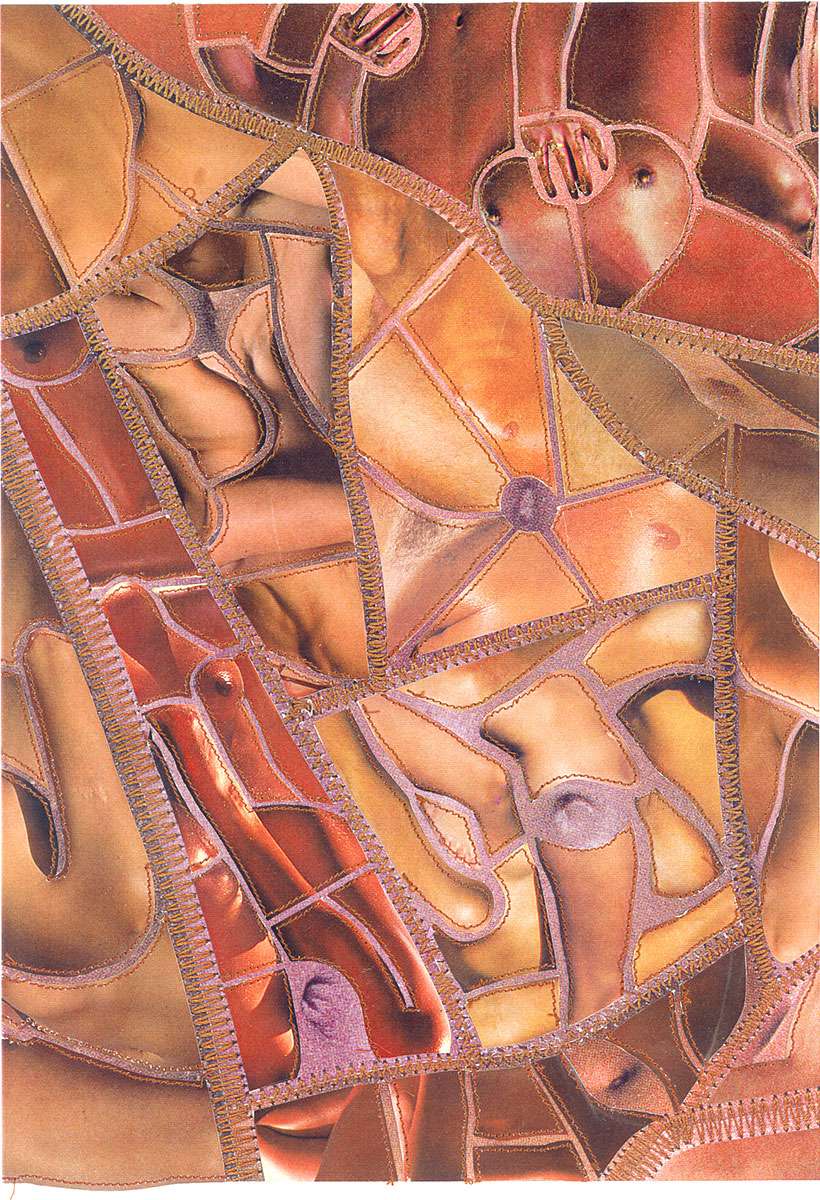 MPuB 1, Map of the Public Body / print on paper / 82x48cm / 1995
MPuB 1, Map of the Public Body / print on paper / 82x48cm / 1995
As in the case of Field Work, the material used stems directly and without archiving from images of the Public Body.
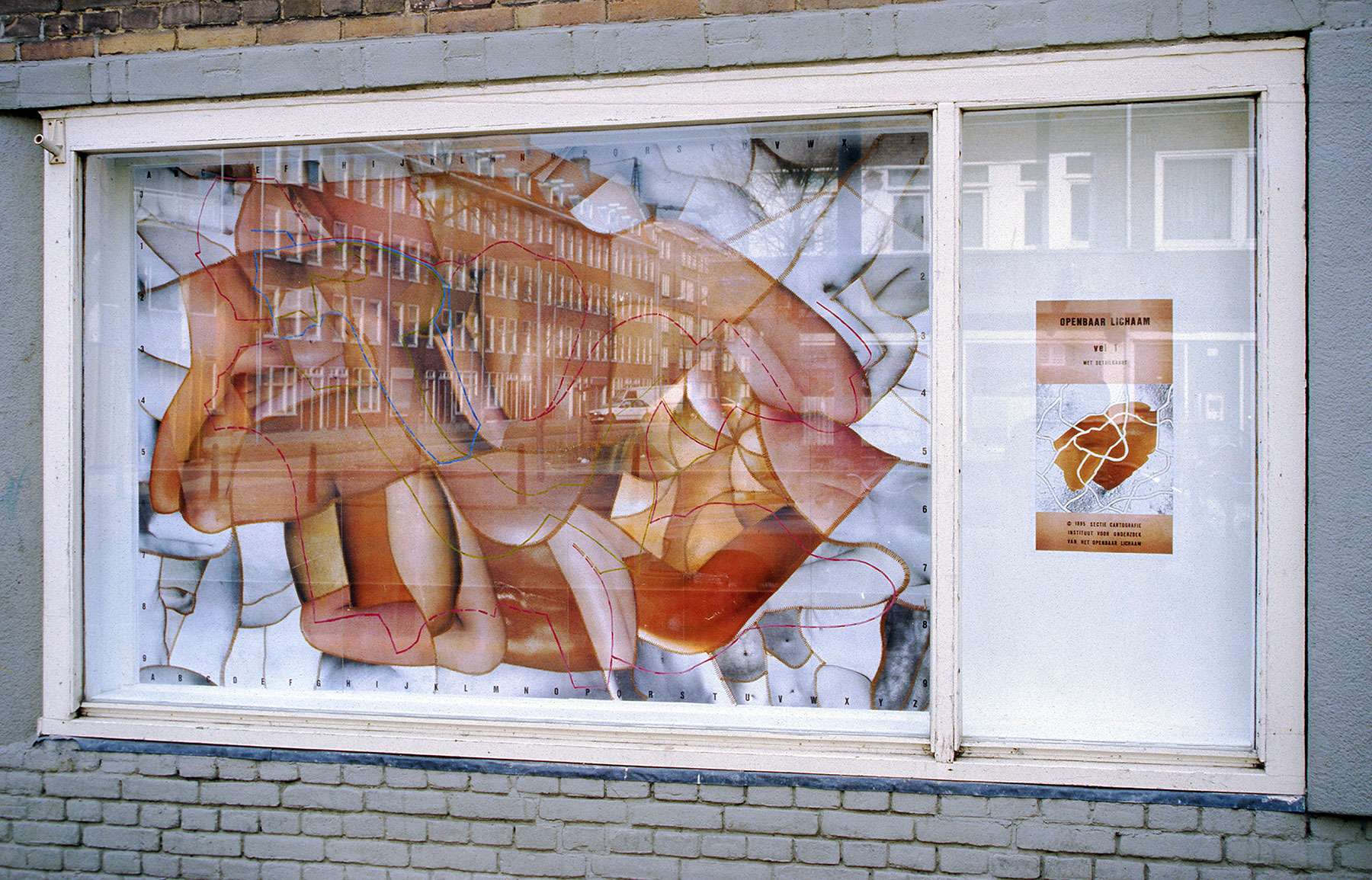
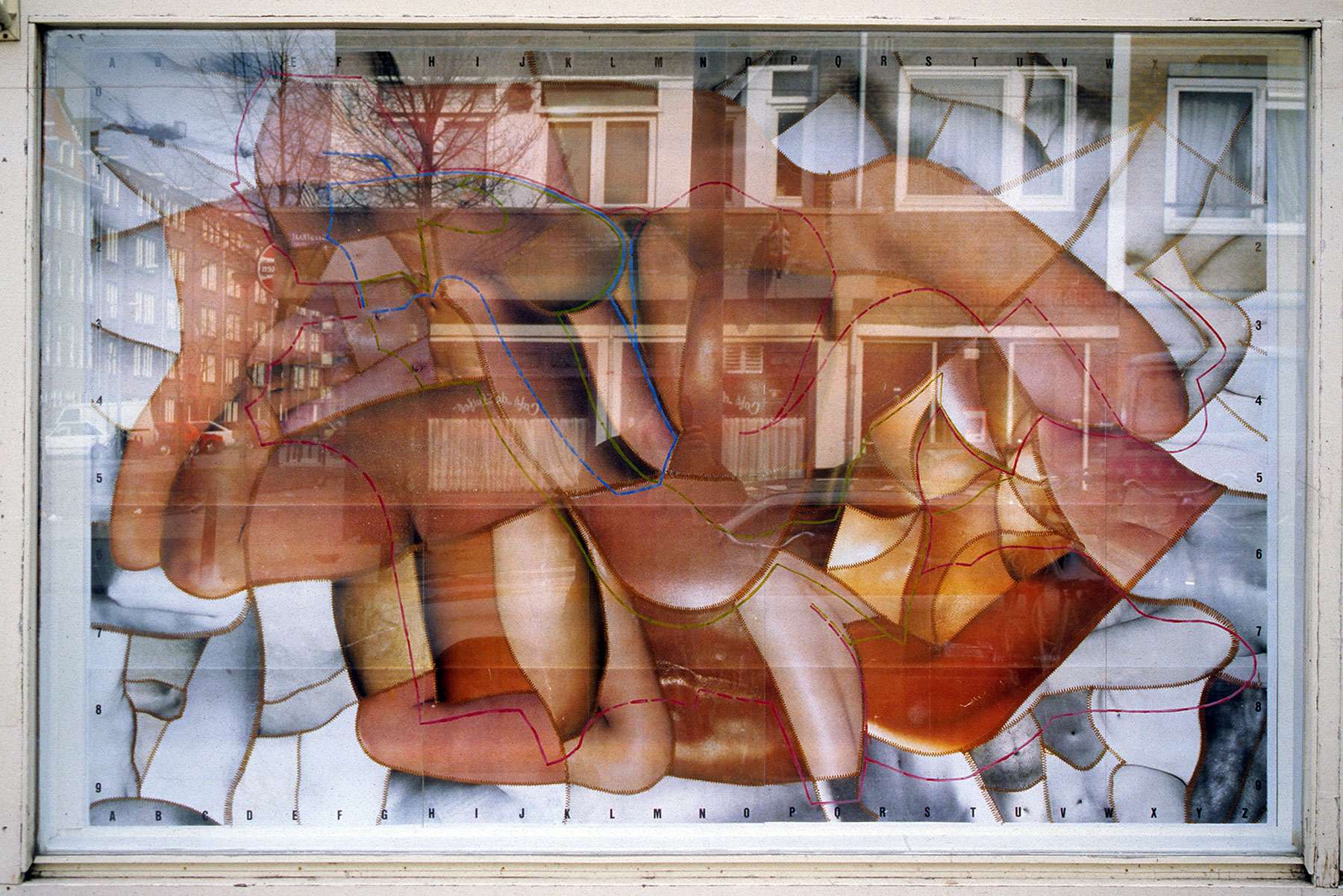
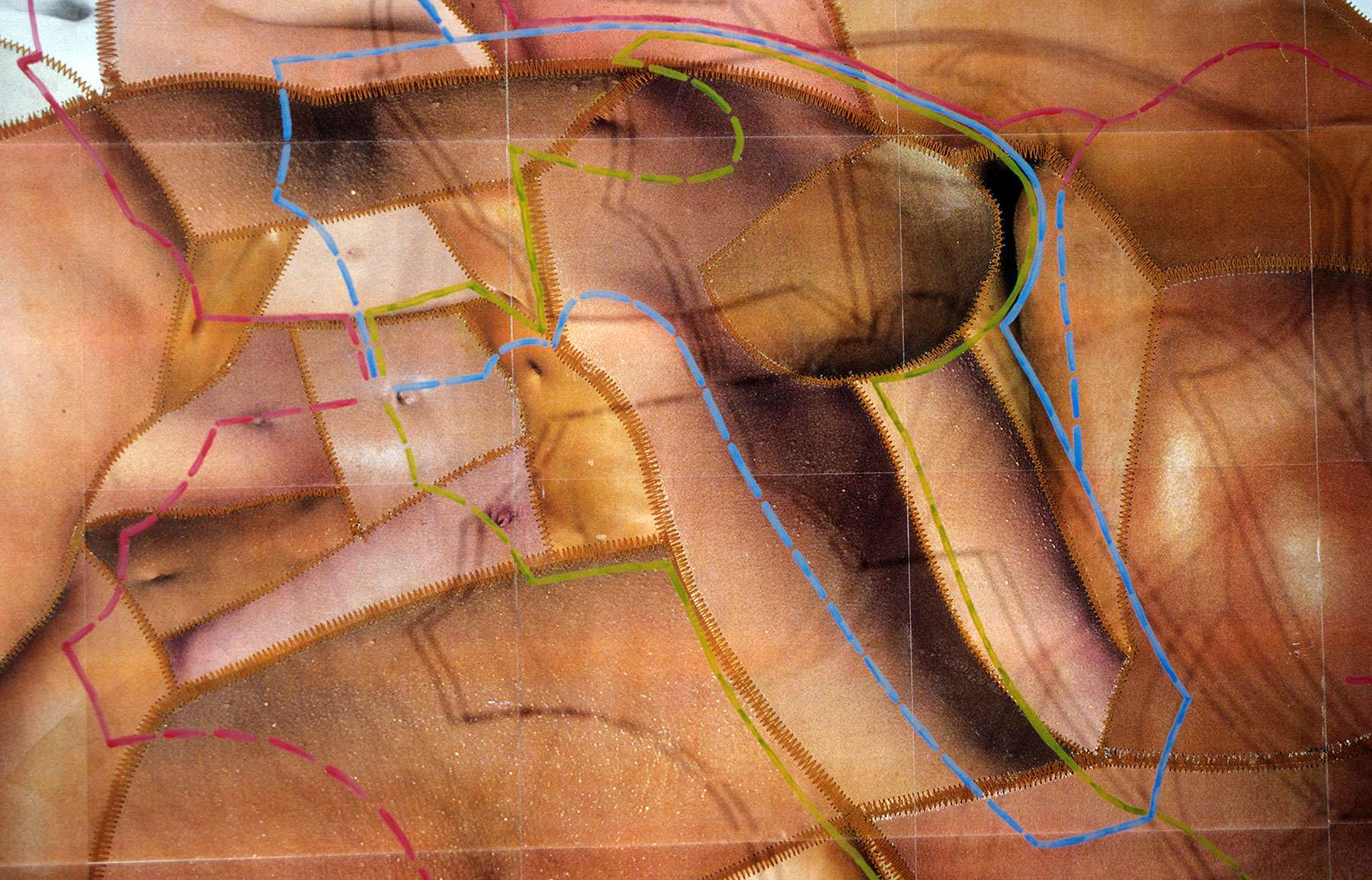 MPuB 2, Map of the Public Body / print on paper, wood, nail polish, window / 210x137cm / 1995
MPuB 2, Map of the Public Body / print on paper, wood, nail polish, window / 210x137cm / 1995
Part of Rahmenerzählung, an installation on location, duo exhibition, Semarangstraat-Javastraat, Amsterdam
This Map of the Public Body is presented with a number of marked out footpaths. All the paths start at the same point in the centre and fan out over the area covered by the map. See for more images and explanation Presentation Rahmenerzählung.
The Cartography section is also involved in making and developing the SPuB, the Scans of the Public Body, because of its knowledge in the area and orientation inside the Public Body.
The Development department is a free department within the Institute for Research of the Public Body. Its staff builds on the knowledge and material present in the Institute. The way in which images are cut out and re-used in the Archive, is also applied here but then in a freer way, for example by adding other materials or further processing.
It can directly process image material itself, as is also done in the Archive department, but not necessarily all the material used is saved or processed. It can also use existing material from the Archive to re-interpret or extrapolate it freely. In the latter case, the material is returned to Archive.
Parallel to the Archive department, the Development department has the same double base tone when it comes to de-composition and composition. This is reflected in the sections, Processing and Applications.
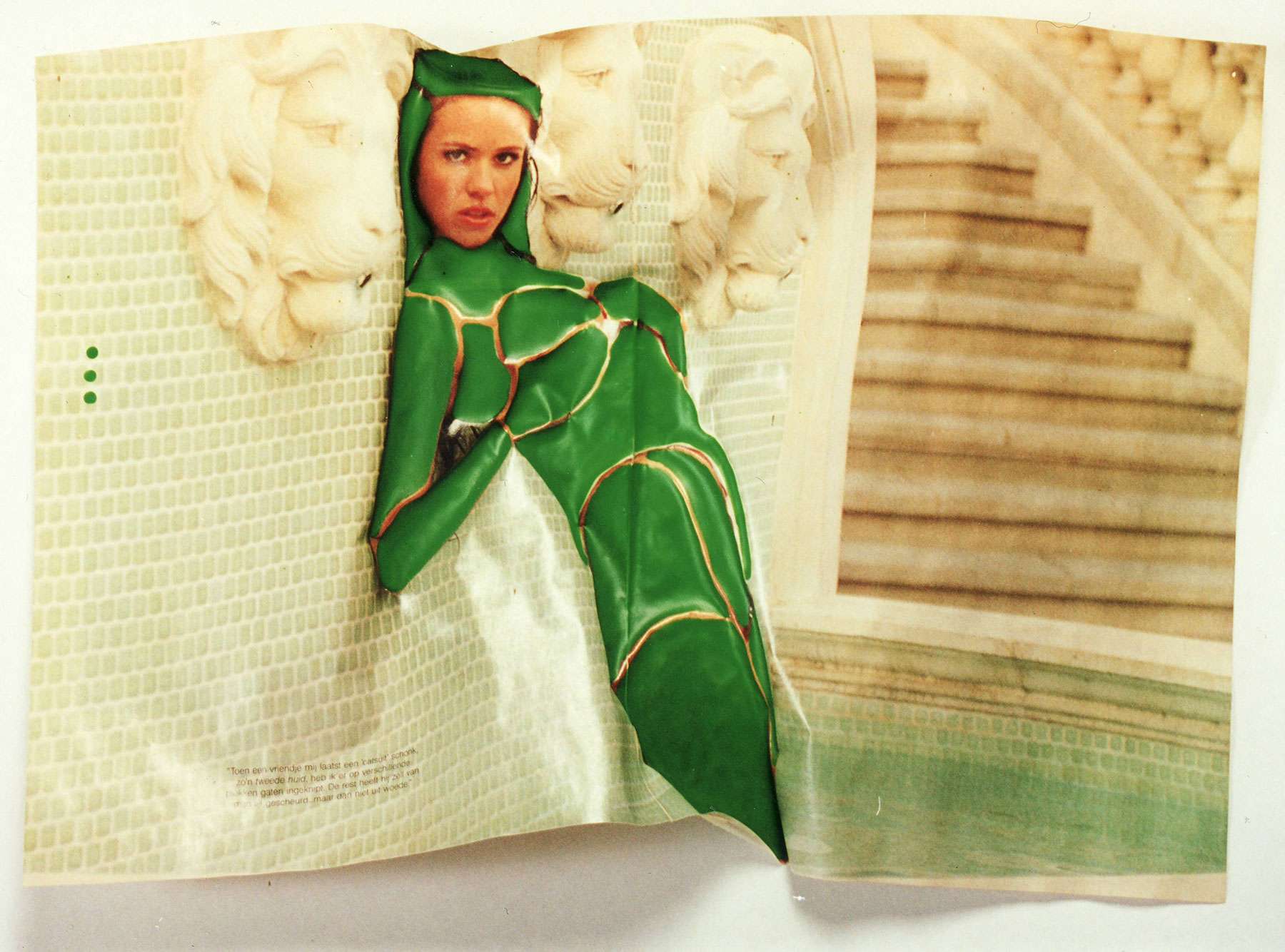
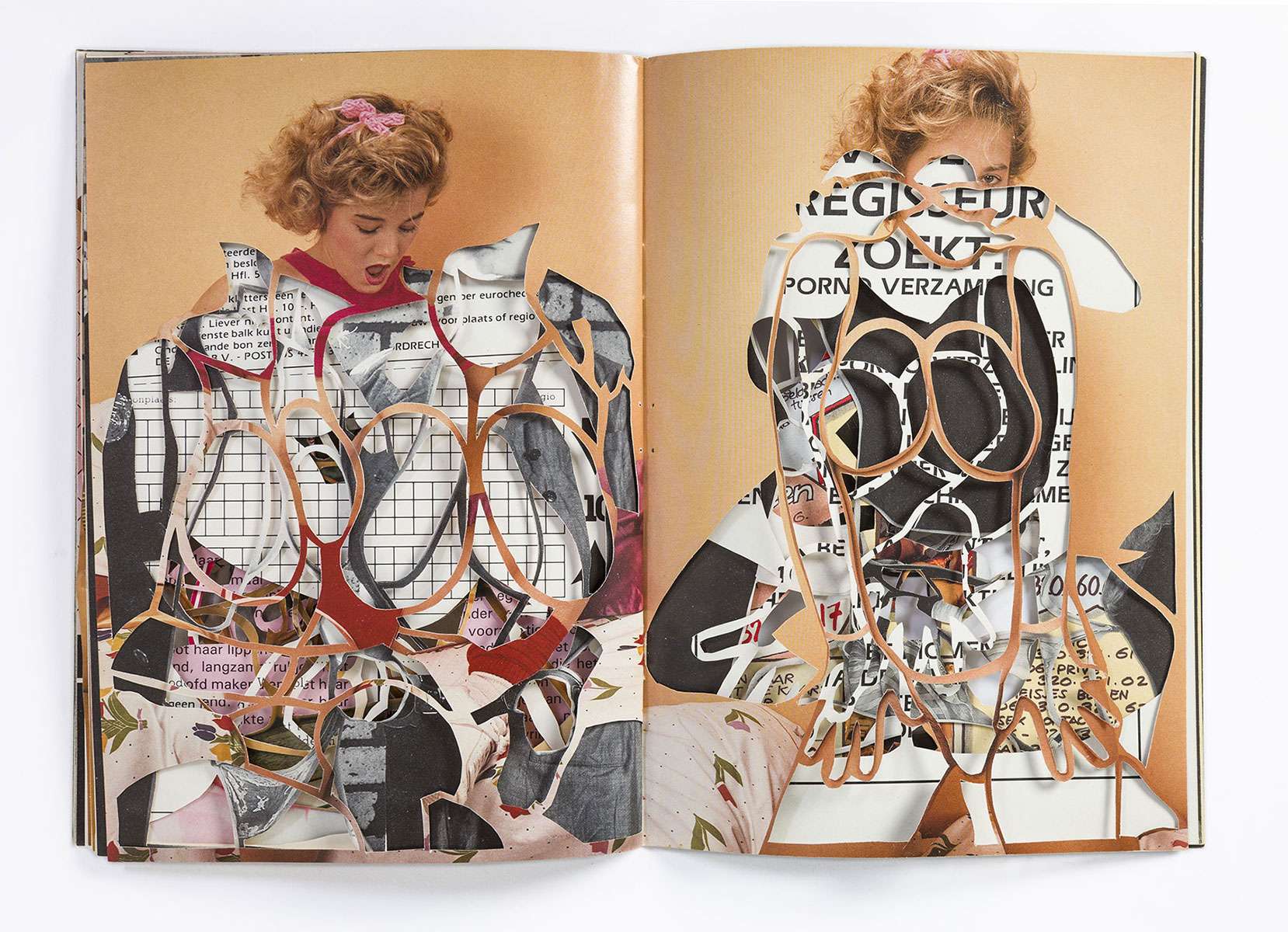
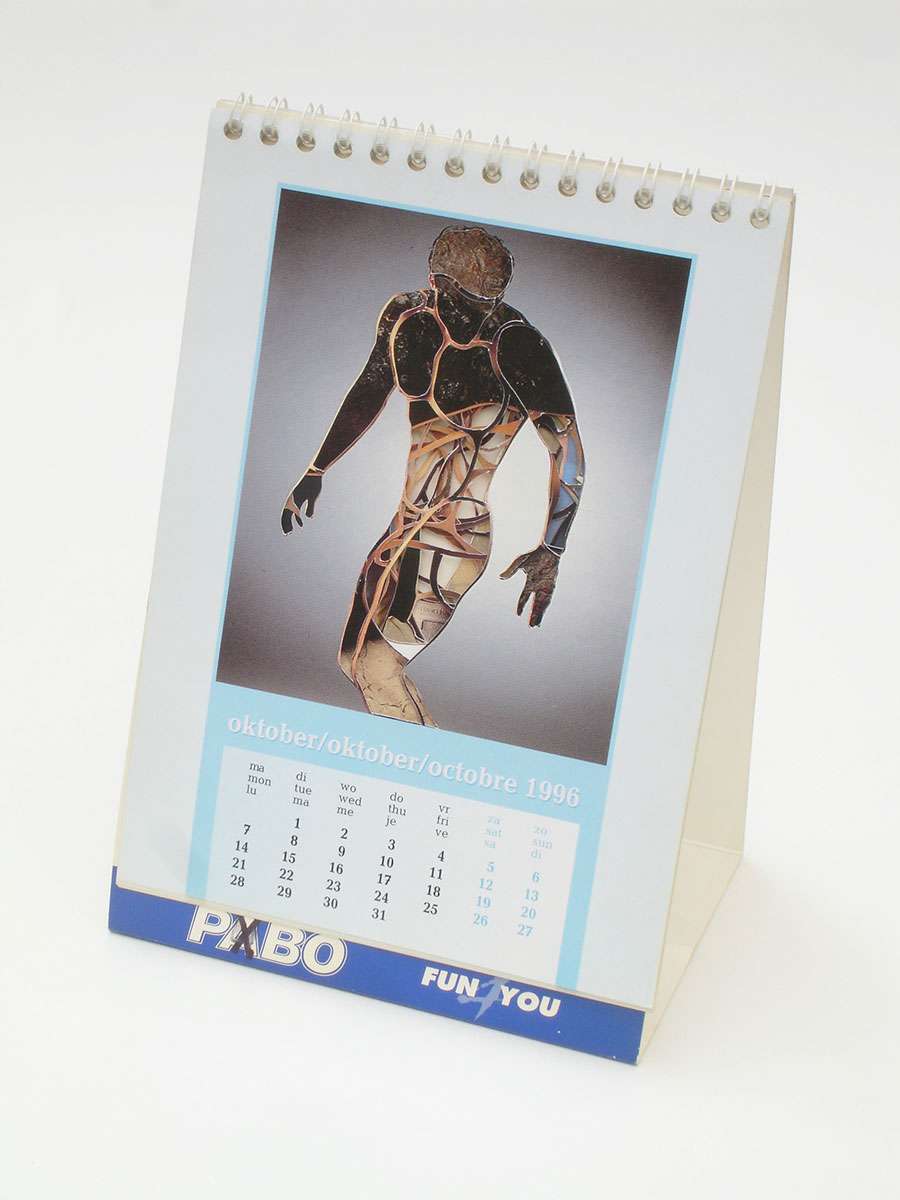
For Archive, it is about laying a foundation of studied and processed Public Body material. On the other hand, the purpose of the Processing section is to achieve singular and unique results with the cutting out and processing Public Body images.
The Processing section uses the same de-composition technique as Archive. But the source material may be very different, or used differently; instead of a single page it may be a book, a series or a calendar. Also, copies of this original material, possibly a different size than the original, can be used or cut out. Or, original material is not subjected to the Archive system but directly applied without the possibility of being re-used.
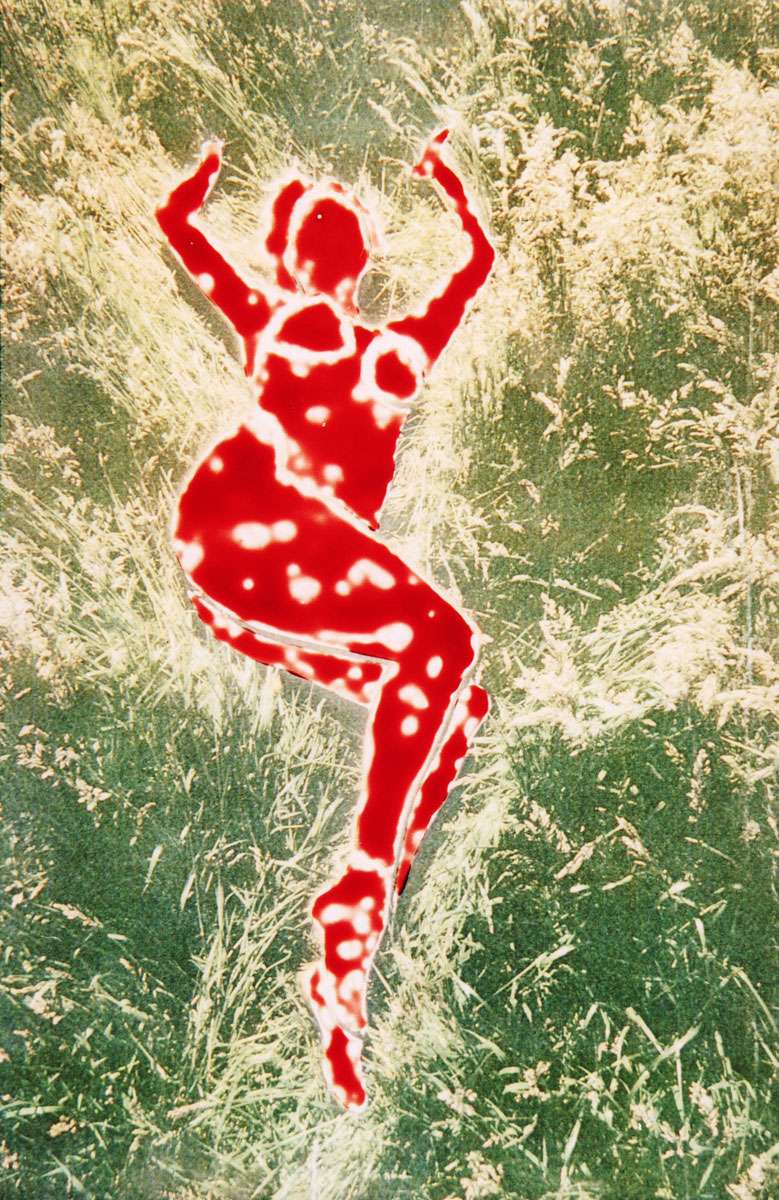 Homo Publicus 1.1 / nail polish, print on plastic / maat / 1998
Homo Publicus 1.1 / nail polish, print on plastic / maat / 1998
Archiving: Homo Publicus 1.1 // PuB / 031NA-100 / 0xxxx
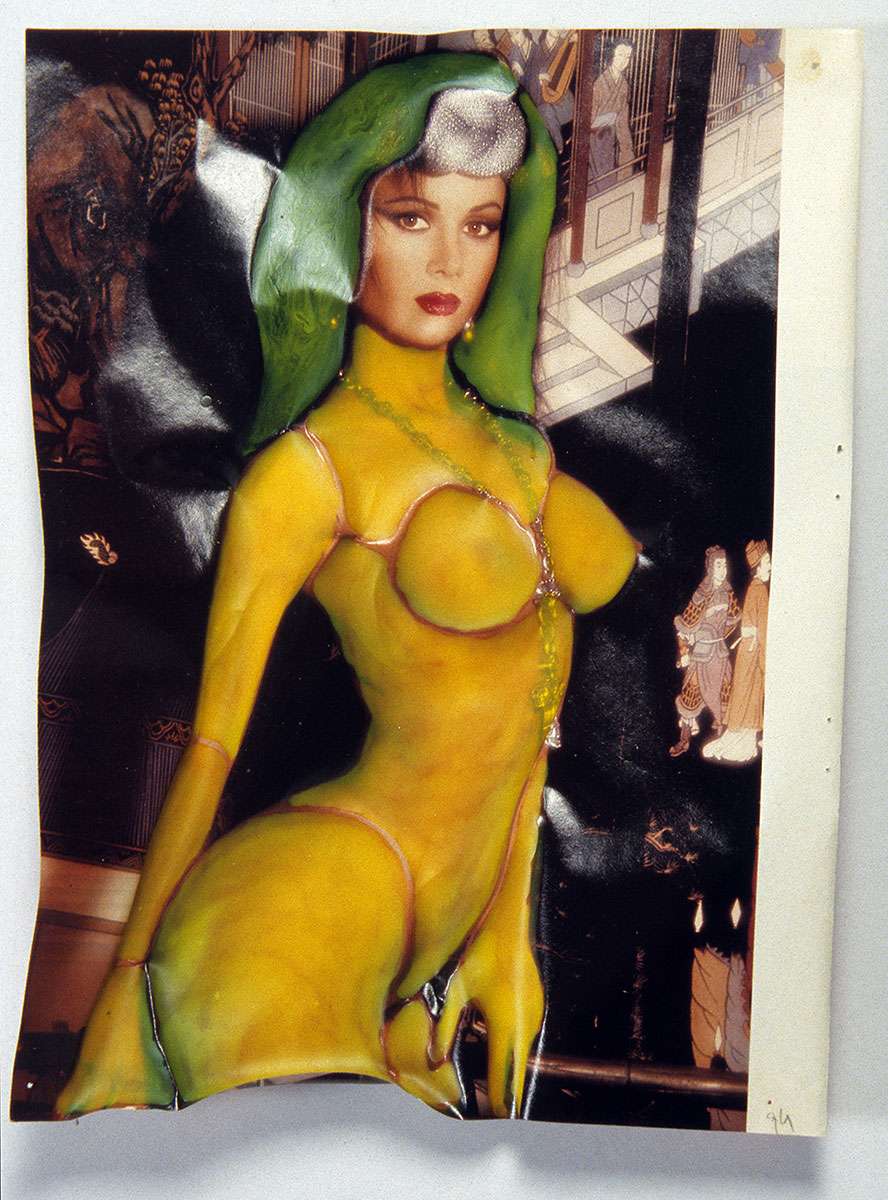 Homo Publicus 2.1 / nail polish, paper / 19.5x27.5cm / 1998
Homo Publicus 2.1 / nail polish, paper / 19.5x27.5cm / 1998
Archiving: Homo Publicus 2.1 // PuB / 000NA-100 / 01PEN95.12P94
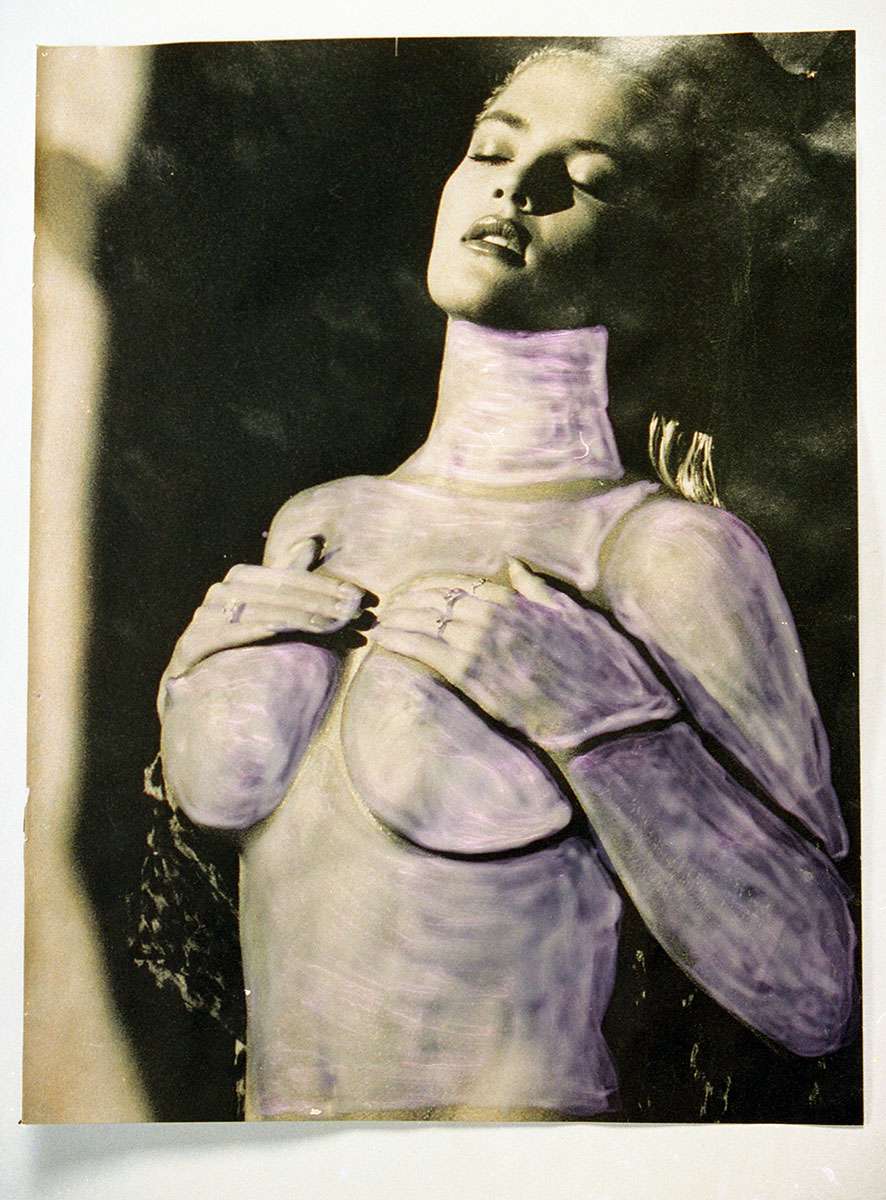 Homo Publicus 2.2 / nail polish, paper / 21x27.5cm / 1998
Homo Publicus 2.2 / nail polish, paper / 21x27.5cm / 1998
Archiving: Homo Publicus 2.2 // PuB / 000NA-100 / 01

Homo Publicus 2.3 / nail polish, paper / 41x27.5cm / 1998
Archivering: Homo Publicus 2.3 // OL / 000NA-100 / 01PENP84-85
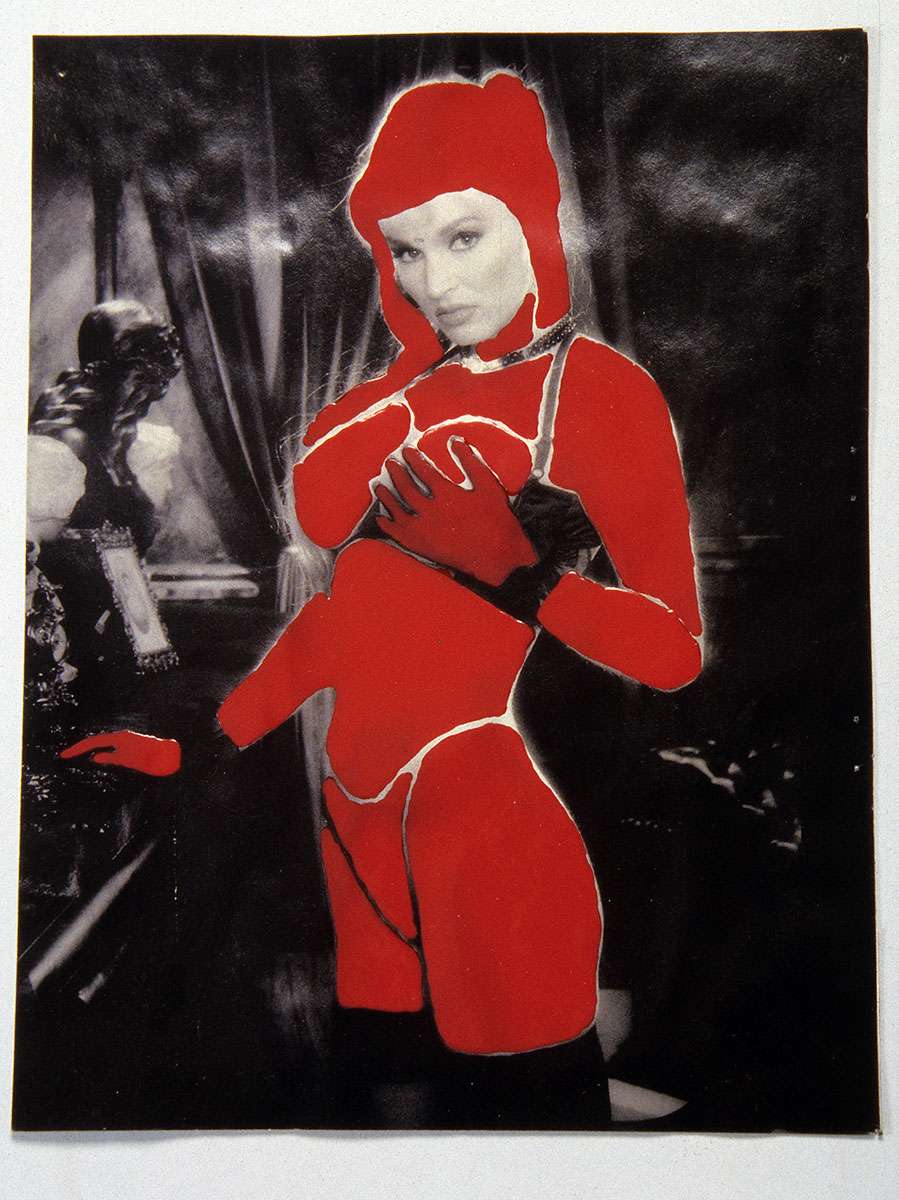 Homo Publicus 2.4 / nail polish, paper / size / 1998
Homo Publicus 2.4 / nail polish, paper / size / 1998
Archiving: Homo Publicus 2.4 // PuB / 000NA-100 / 01
Suitable images of the Public Body are not cut out, but, as with a ‘cutting plan’, processed with nail polish. Nail polish is a pretty and typical type of varnish that is widely used to decorate hard parts (horn) of the public parts of our bodies. With the Homo Publicus, as an analogy with a turtle, almost the entire public part of the body is covered with this varnish.
Booklets

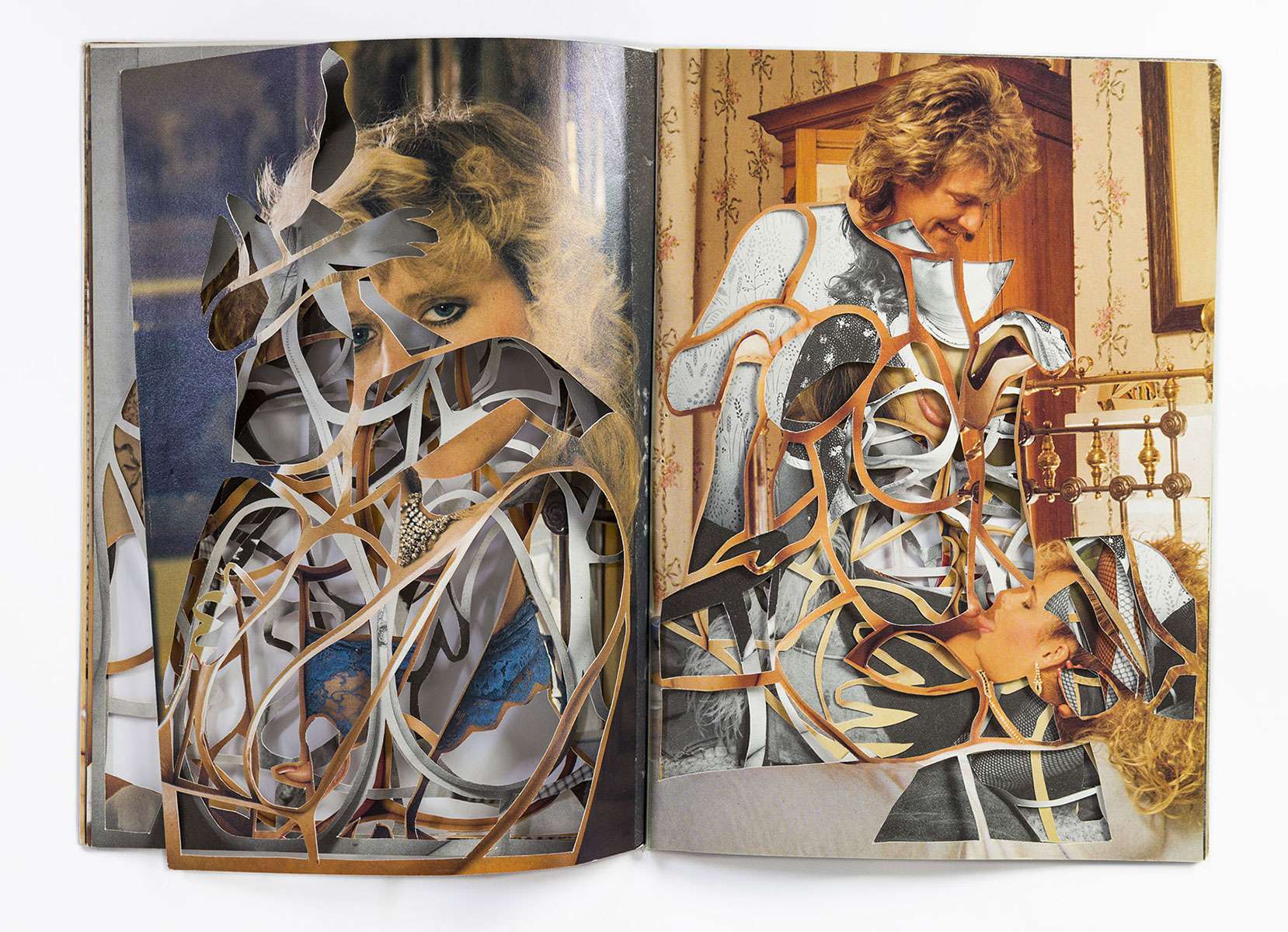
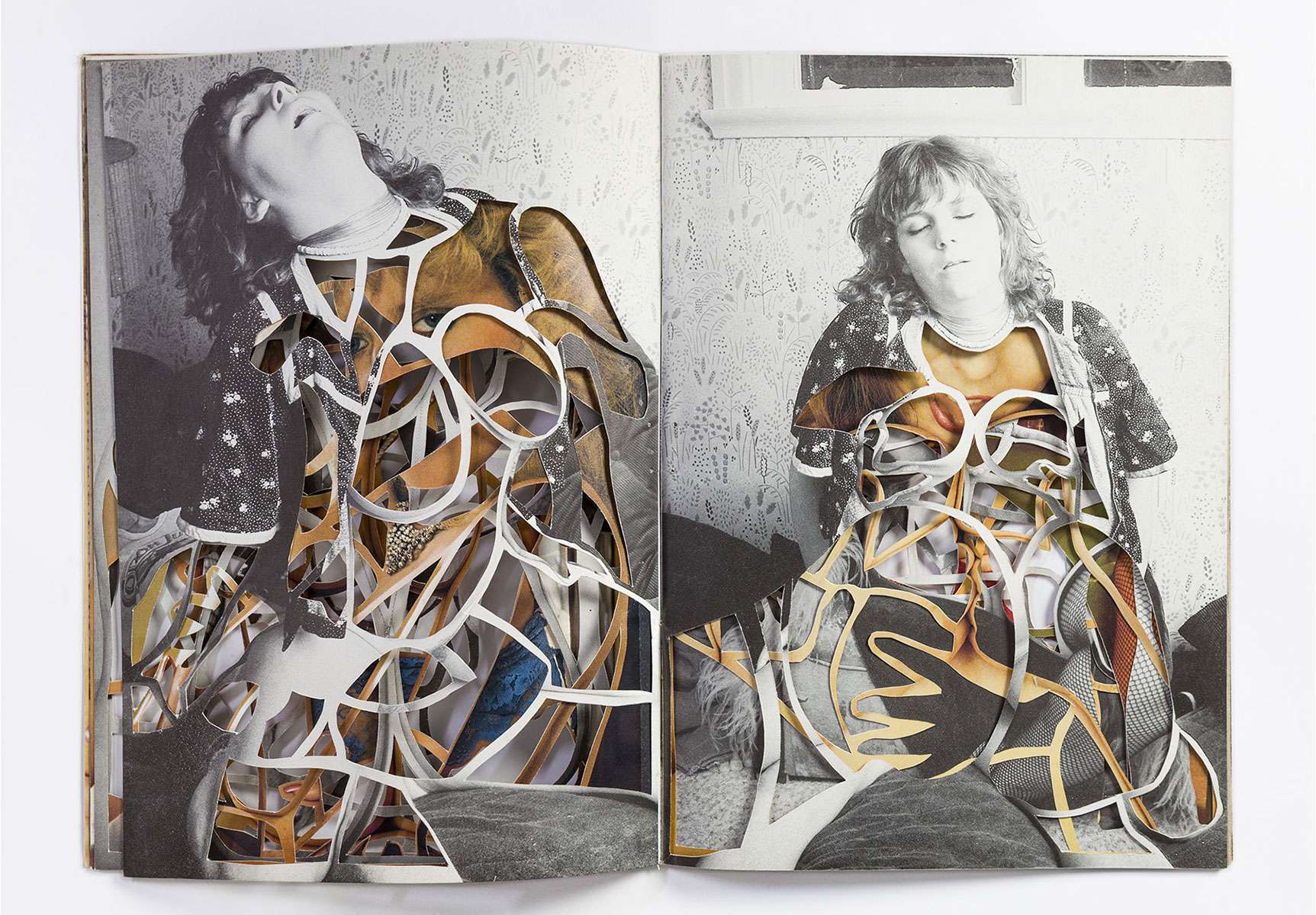 FATTY 40 / magazine / 15x21cm / 1999 / photos AT
FATTY 40 / magazine / 15x21cm / 1999 / photos AT
Archiving: FATTY 40 // RPuB / 000-100 / 01FAT40PP32
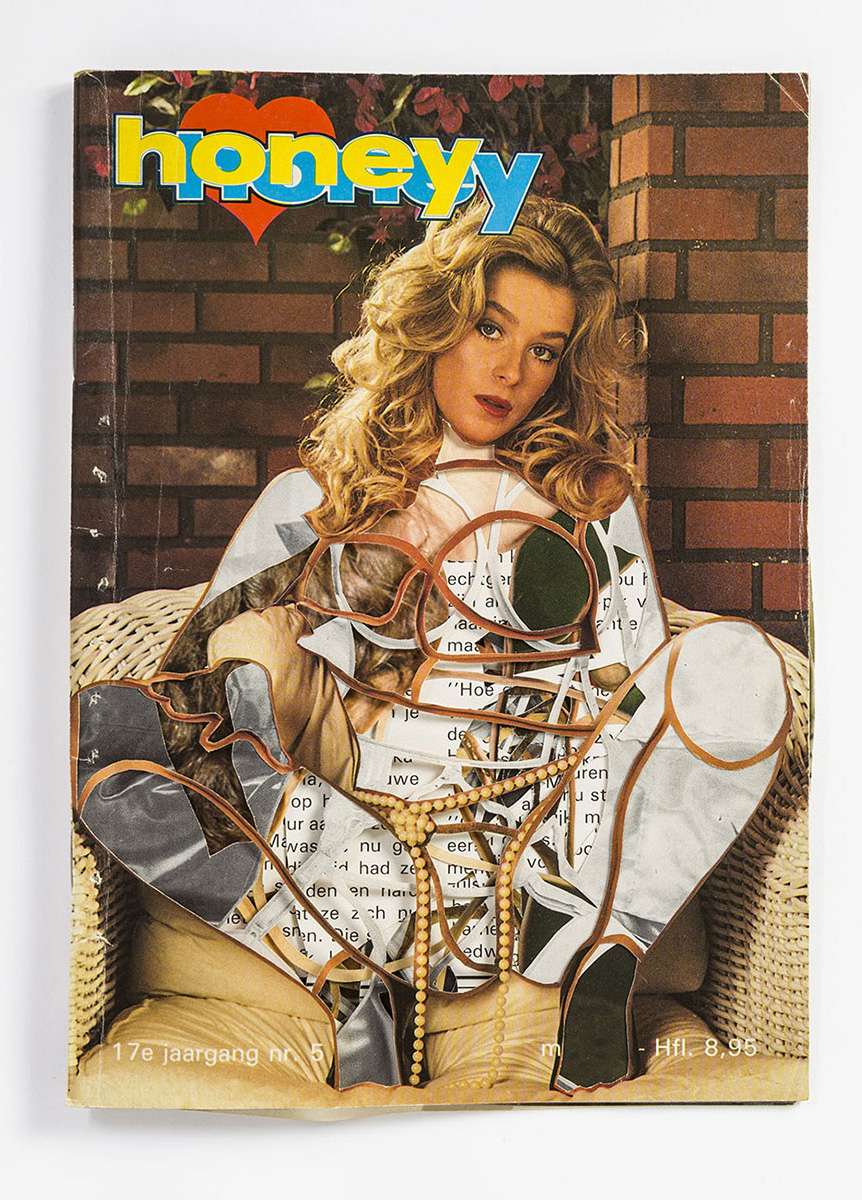
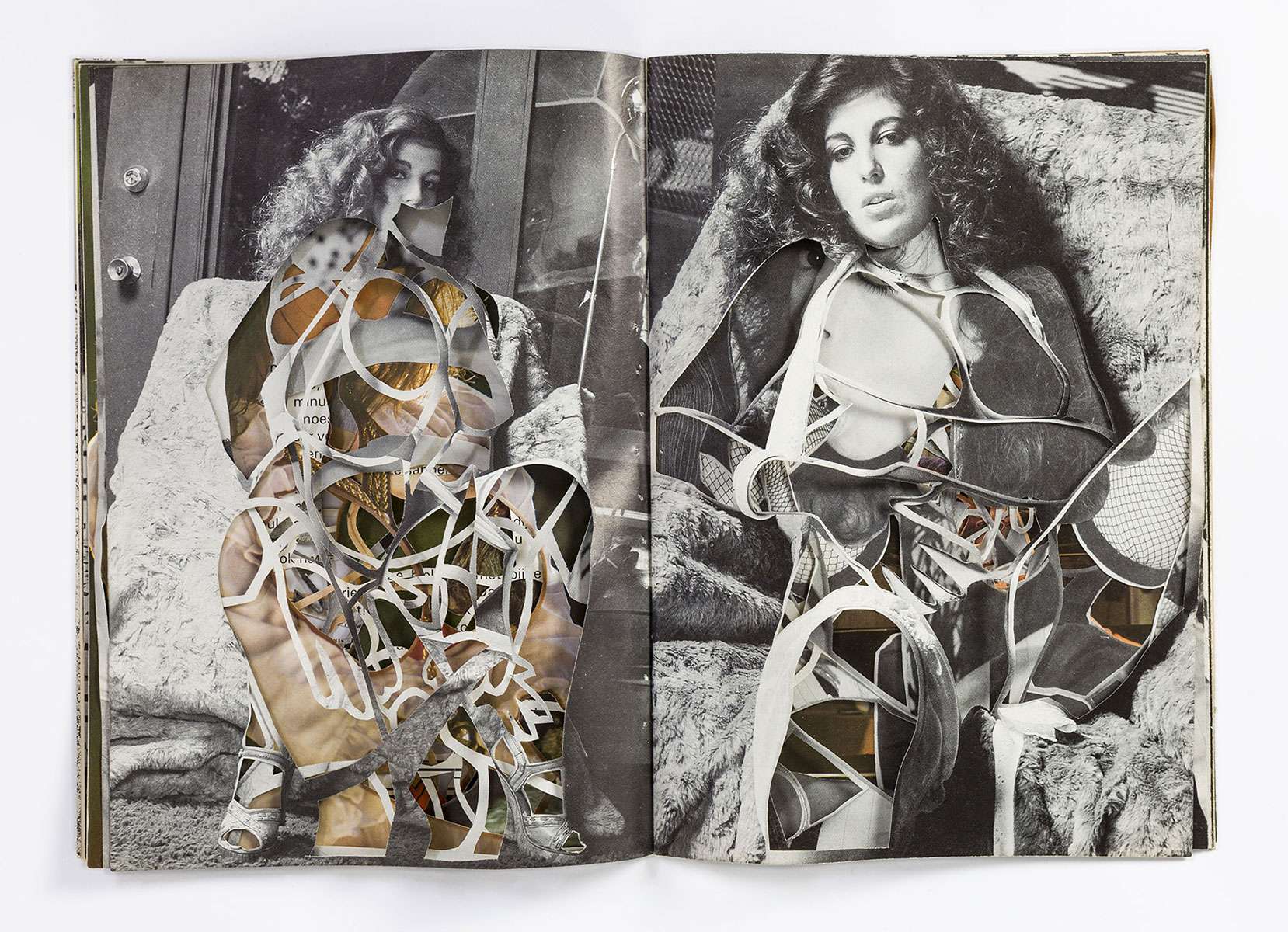
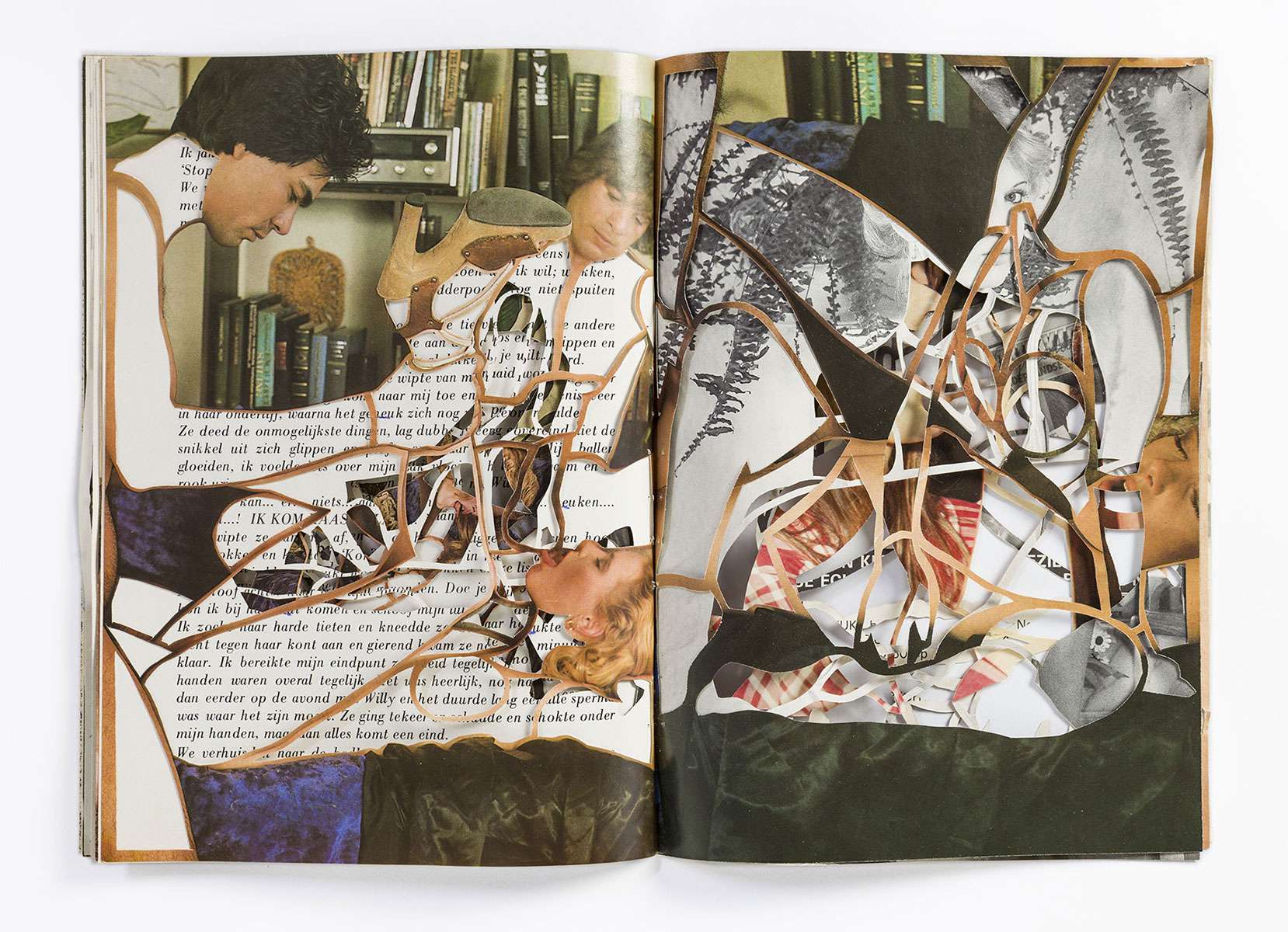 honey 17.5 / magazine / 15x21 / 1999 / photos AT
honey 17.5 / magazine / 15x21 / 1999 / photos AT
Archiving: honey 17.5 // RPuB / 000-100 / 01HON17.5PP42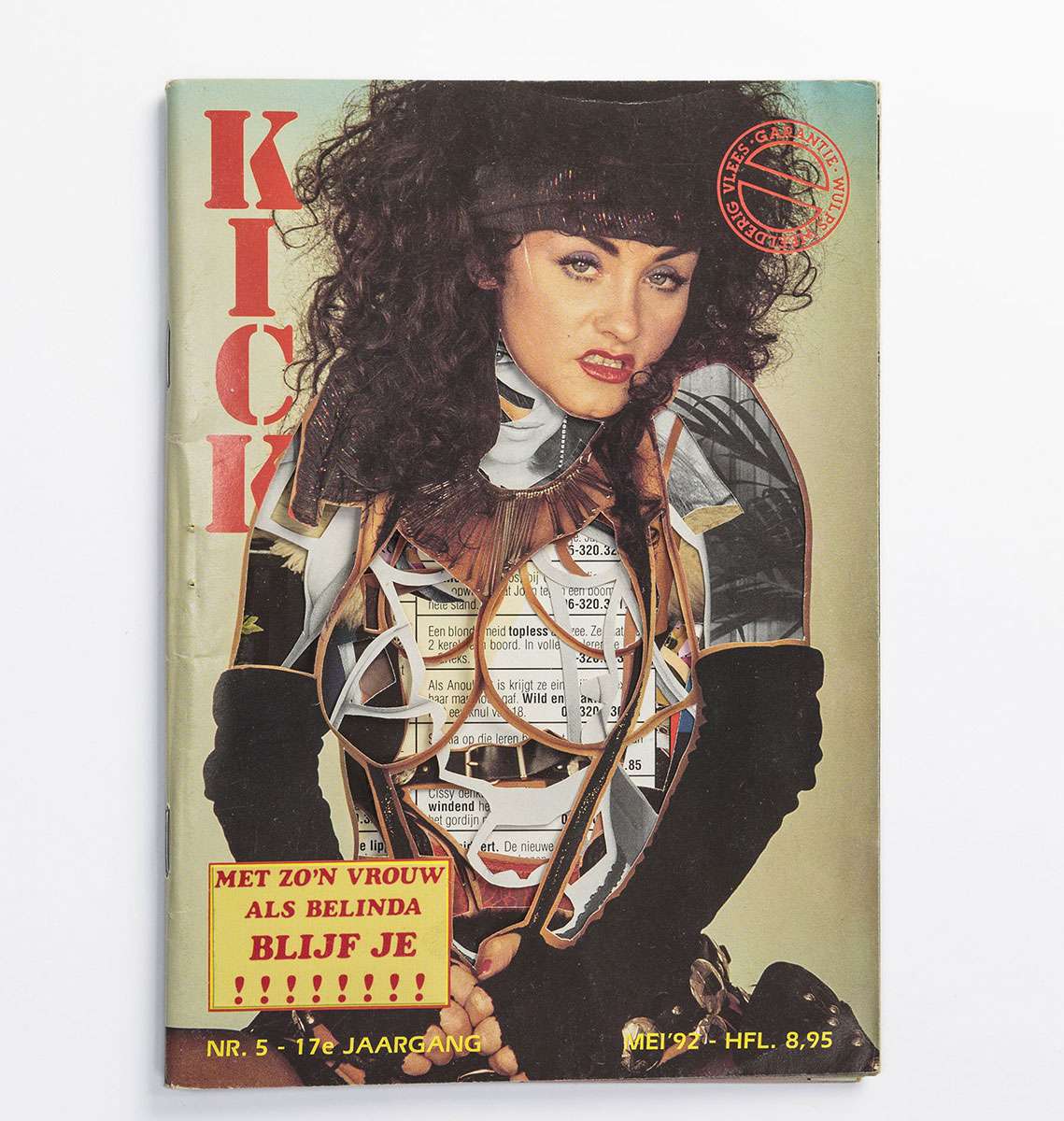

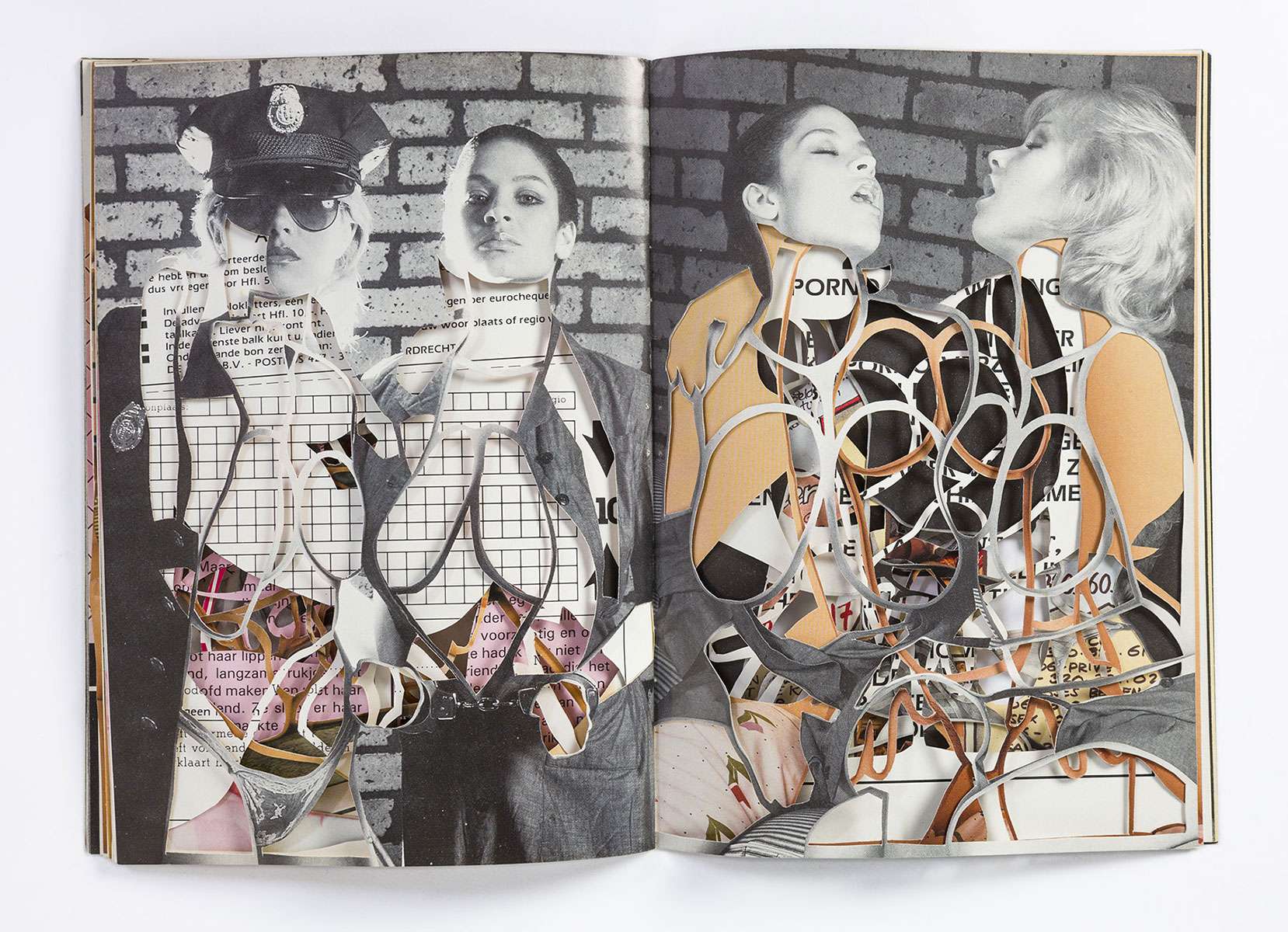 KICK 17.5 / magazine / 15x21cm / 1999 / photos AT
KICK 17.5 / magazine / 15x21cm / 1999 / photos AT
Archiving: KICK 17.5 // RPuB / 000-100 / 01KIC17.5PP42
Every right-hand page image is always cut out of a complete booklet. On every reverse side – the left page – there is an intrusion in the image and/or text present there. The choice has been made to permanently allow the faces of people to be seen.
Calendar
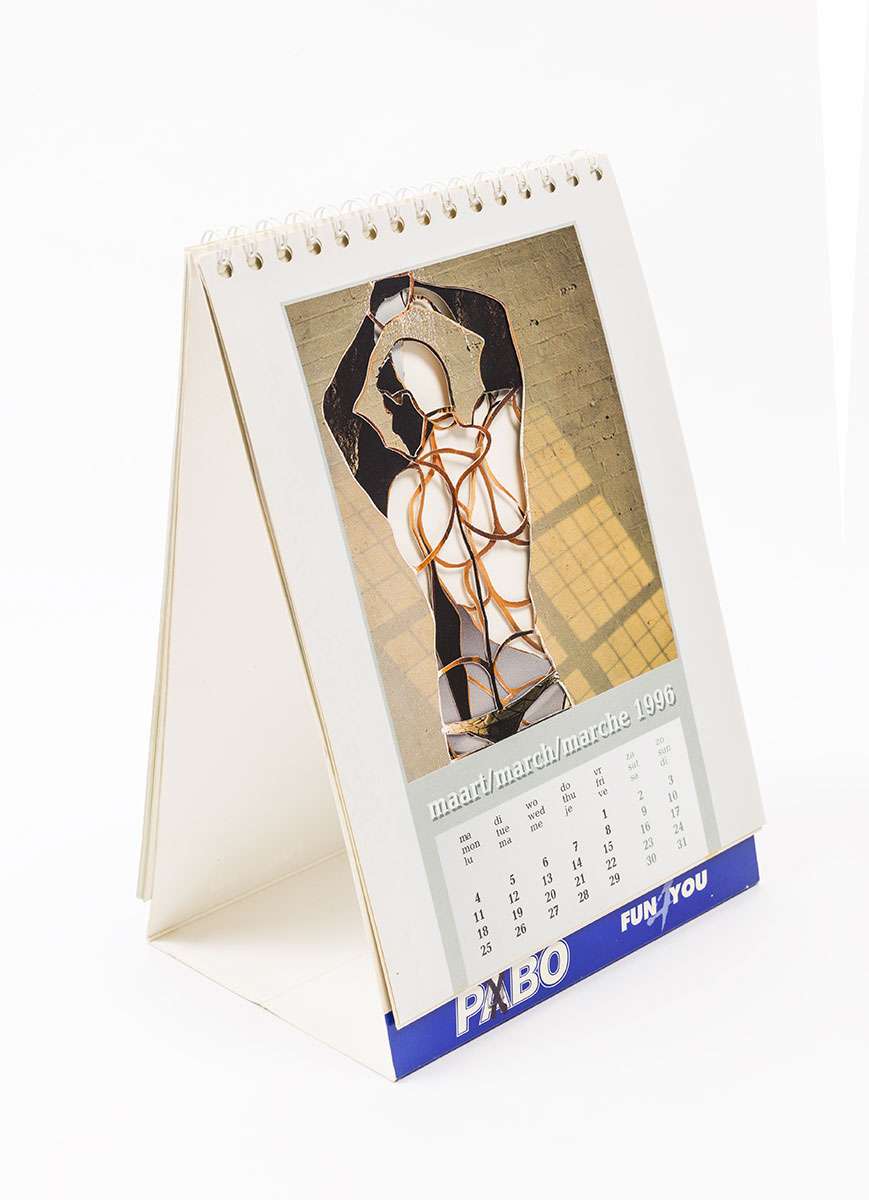
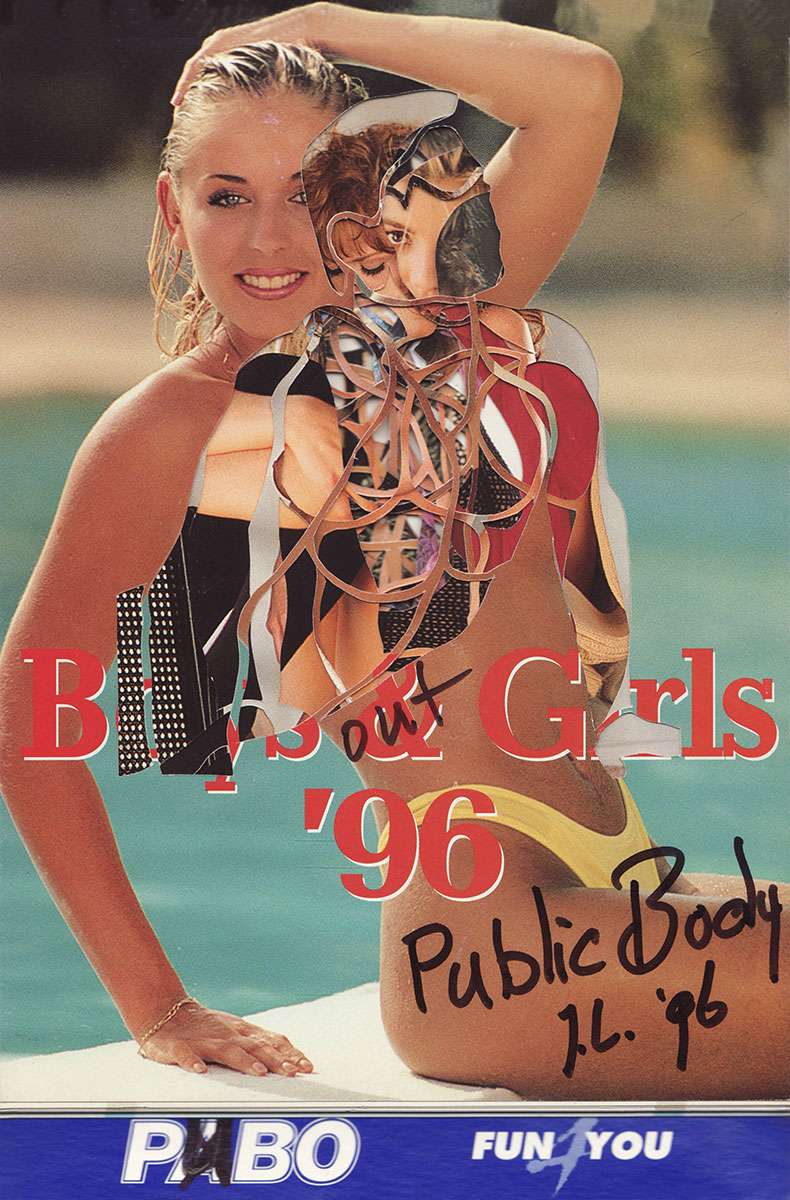
Public Body - Boys out Girls ‘96 / paper calendar / 13x19x10cm / 1997 / 1st photo AT
Archiving: Public Body – Boys out Girls ’96 // RPuB / 000-100 / A108 - 01PAB-K96PP13-12M1V159ST
All months, Side 1 and Side 2 of Public Body - Boys out Girls ‘96 / paper calendar / 13x19x10cm / 1997
The stand-up calendar of the PABO brand is processed and renamed as PUBO (Public Body).
Per calendar month the image of the man is cut out, which resulted in an intrusion in the image of the woman on the other side.

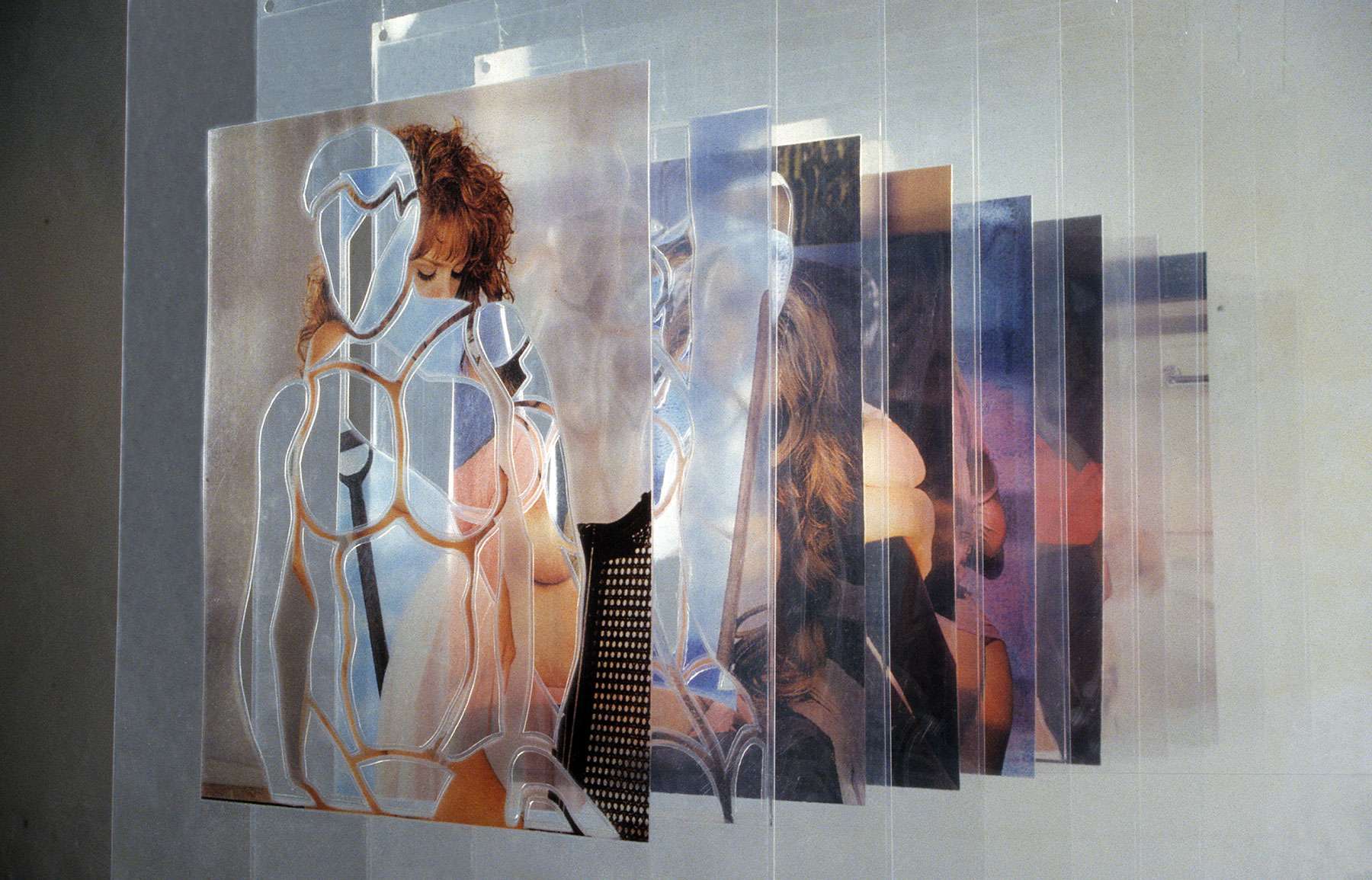
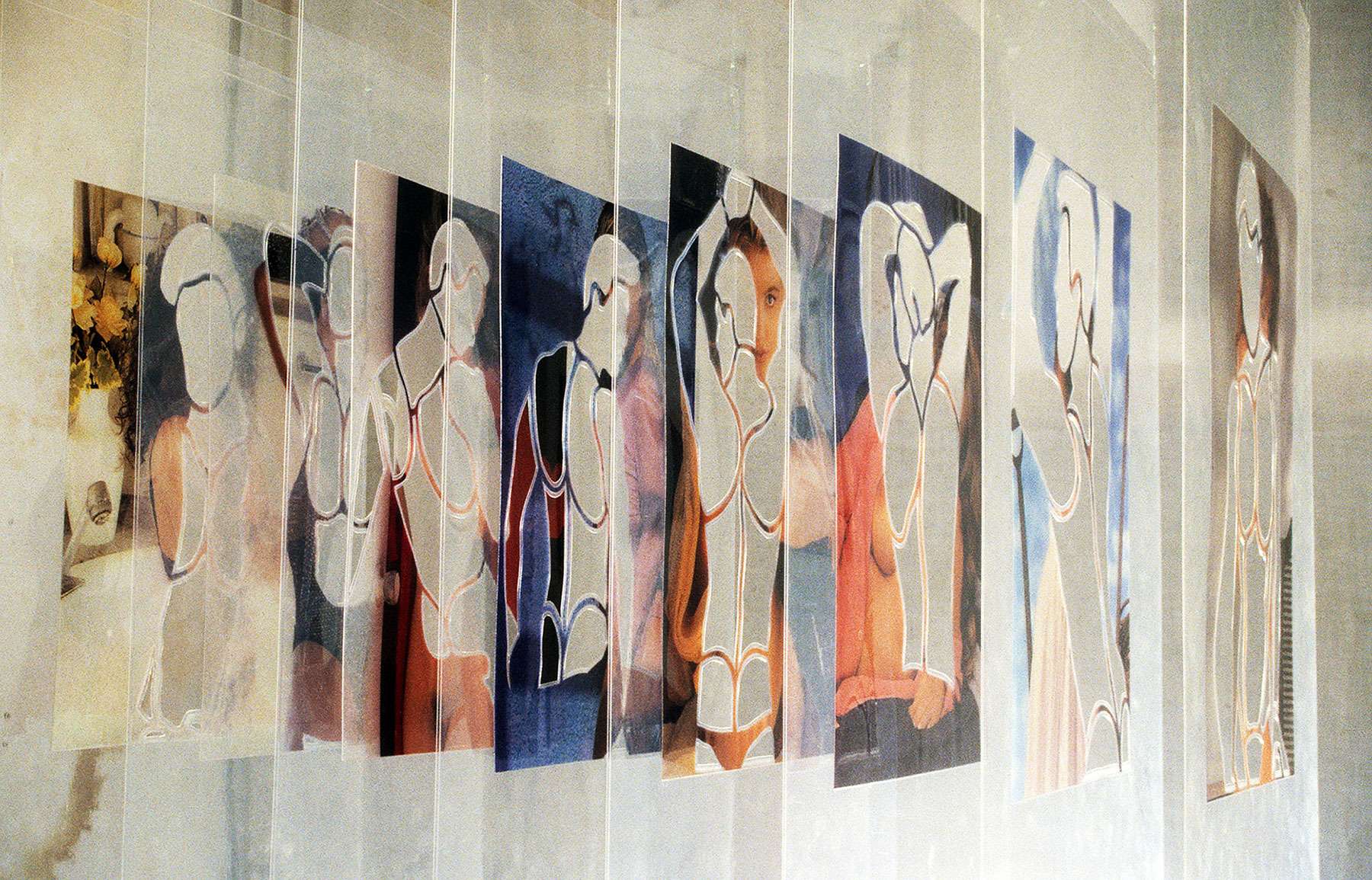 Public Body – Boys out Girls 21 / transparent copies, laminated, plastic, thread / 43x63x70cm / 1999
Public Body – Boys out Girls 21 / transparent copies, laminated, plastic, thread / 43x63x70cm / 1999
Archiving: Public Body – Boys out Girls 21 // RPuB / 031-300 / A108.2K2+A108.6K2+A108.11K2+A108.3K2+ A108.7K2+A108.4K2+A108.5K2+A108.12K2 – 01PAB-K96PP8-8MKL87ST
From 8 RPuB from the same number of months of the PUBO calendar, enlargements were made of Side 2 (the reverse side). These are the sides with the female images from which the male image has been cut out. These have been printed on plastic and cut out again, after which the prints are laminated and cut out once more.
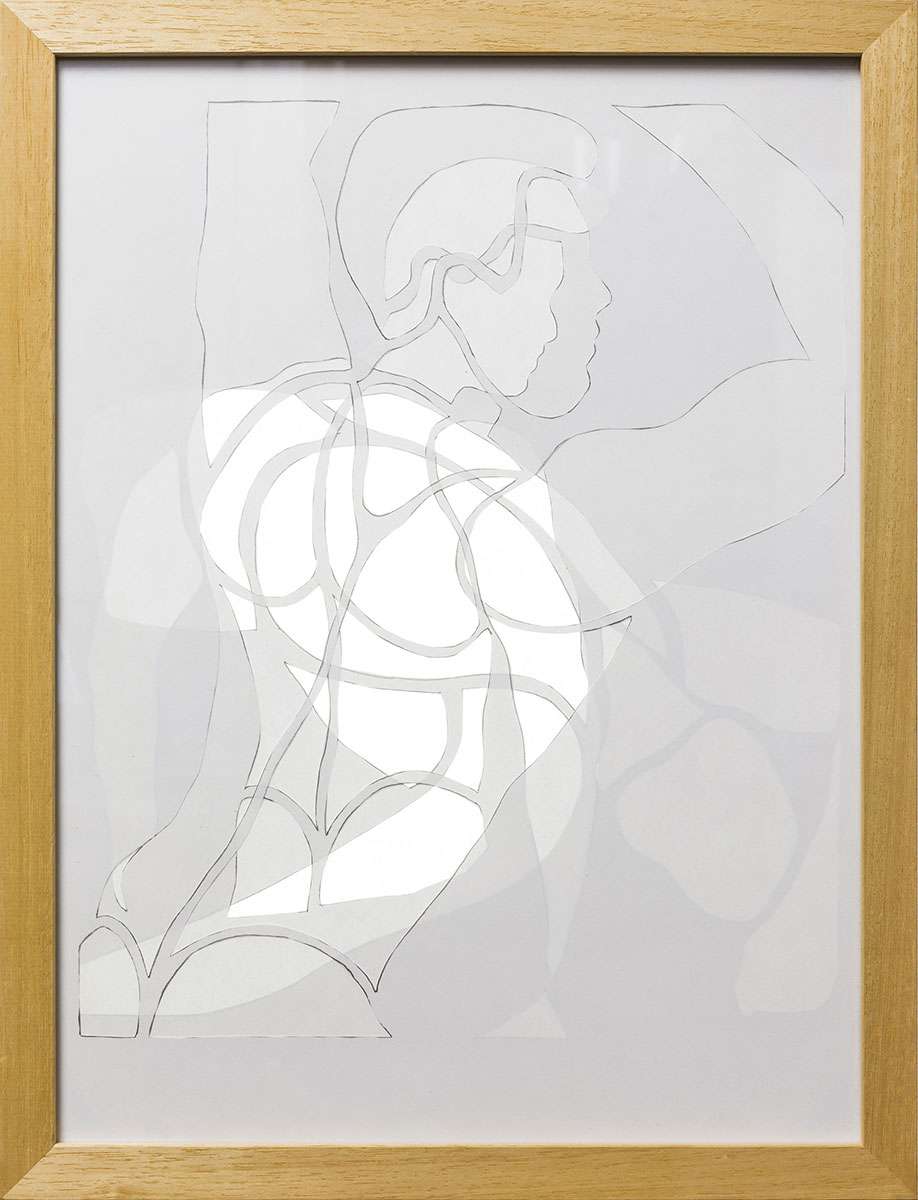
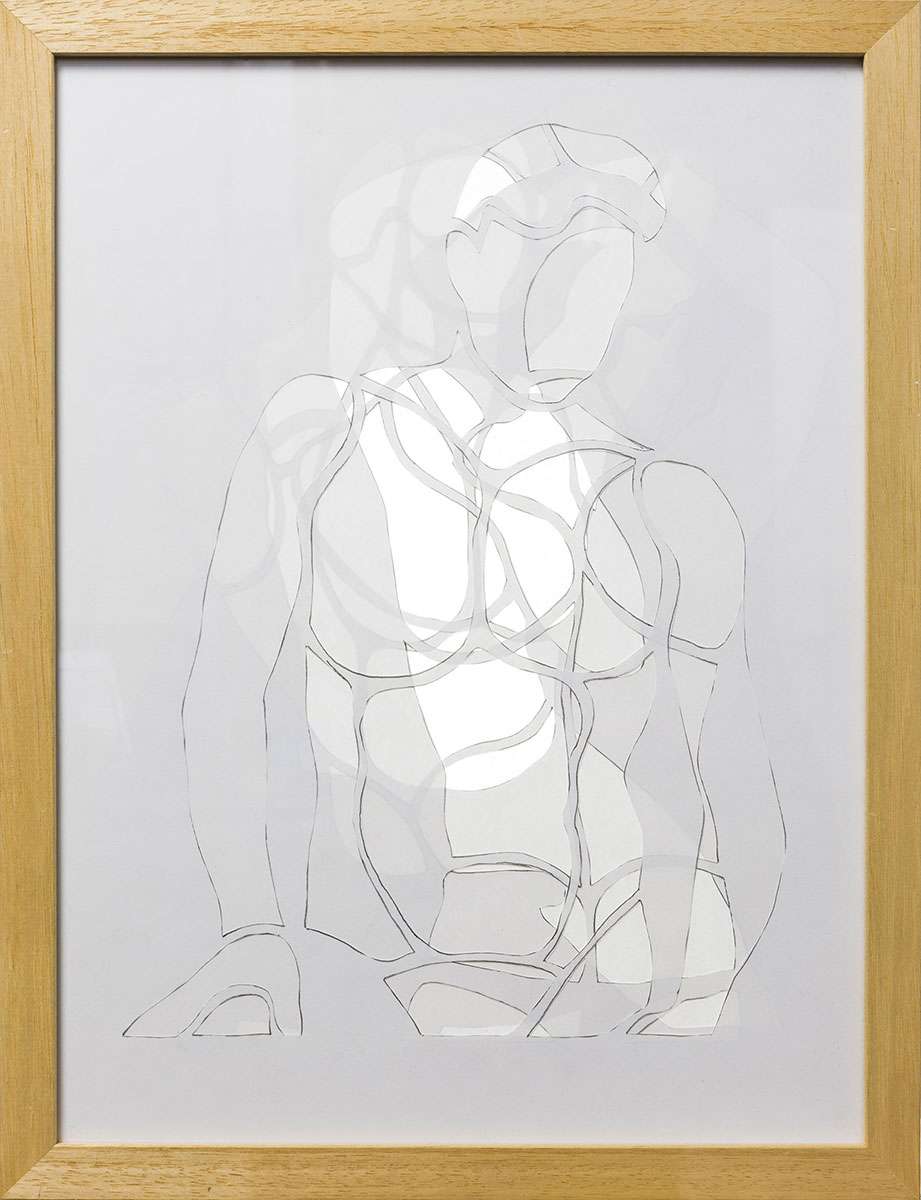
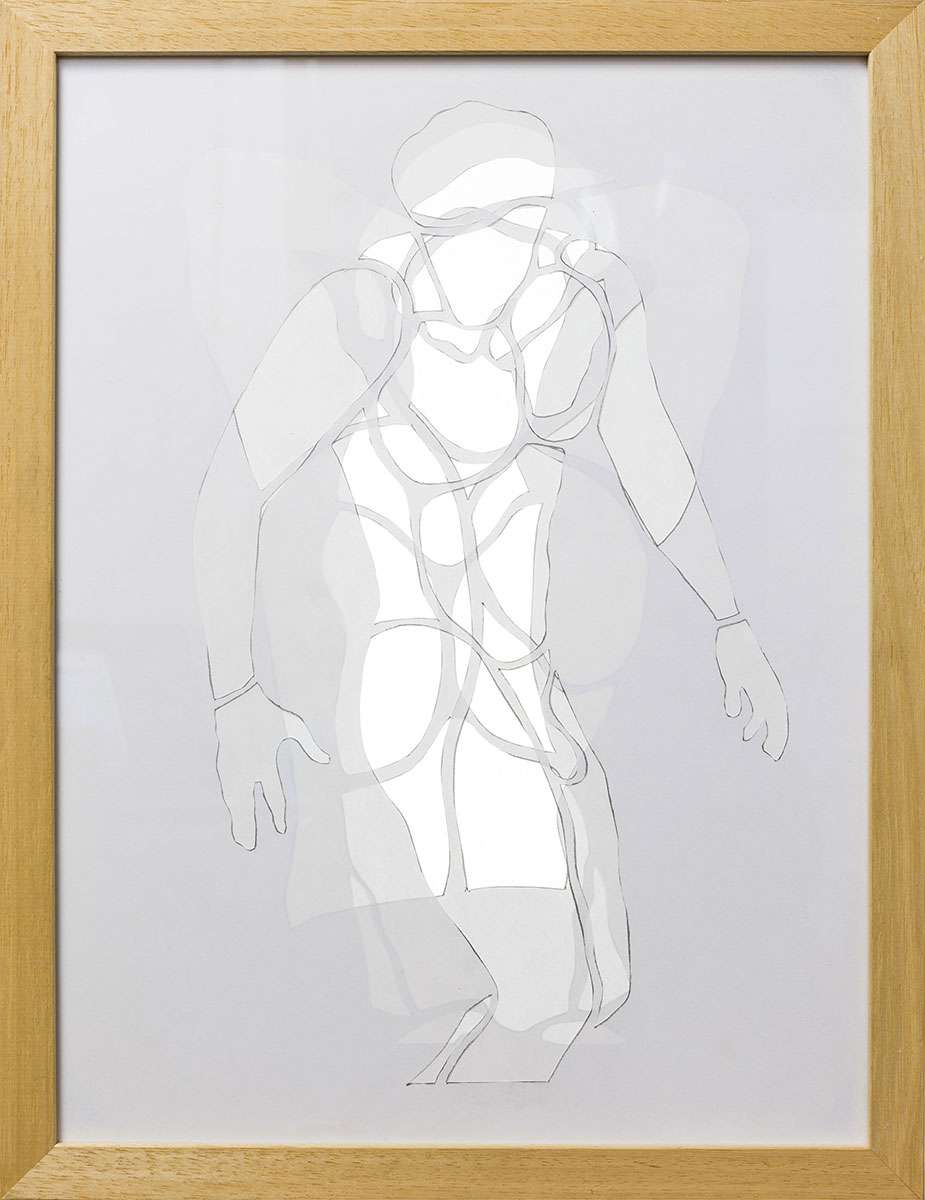
body-cut 21 - 23 / paper, wood / 3 pieces of 33x43cm / 1999 / photos AT
Archiving: body cut 21-23 // RPuB / 011TE-300 / A108.10K2+A108.11K2+A108.12K2 – 01PAB-K96PP3-3MZW36ST + A108.2K2+A108.3K2+A108.4K2+A108.5K2 – 01PAB-K96PP4-4MZW47ST + A108.6K2+A108.7K2+A108.9K2 – 01PAB-K96PP3-3MZW29ST
After being enlarged, again 10 Drawings of Side 2 have been cut out from the PUBO calendar. The result resembles enlarged shapes of the Remains of the Public Body. They are drawn and then cut out forms on white paper, with no further context. In 3 sets of 3 or 4, they are then placed behind each other in a frame between glass.
 body-cut 24 / paper, light box on table / 150x90x85cm / 2000
body-cut 24 / paper, light box on table / 150x90x85cm / 2000
Archiving: body cut 24 // RPuB+PPuB / 011TE-900 / A108.2K2+A108.3K2+A108.4K2+A108.5K2 - 01PAB-K96PP4-4MZW47ST
As with body-cut 21-23, 4 Drawings of Side 2 to of the PUBO calendar are cut out again after being enlarged. Although they are bigger, the result is comparable. The cut-out Parts of the Public Body are collected on the underside of the RPuB. The whole of the RPuB and PPuB is displayed on a lying light box. See further at Presentation / PUIRPuB 2.
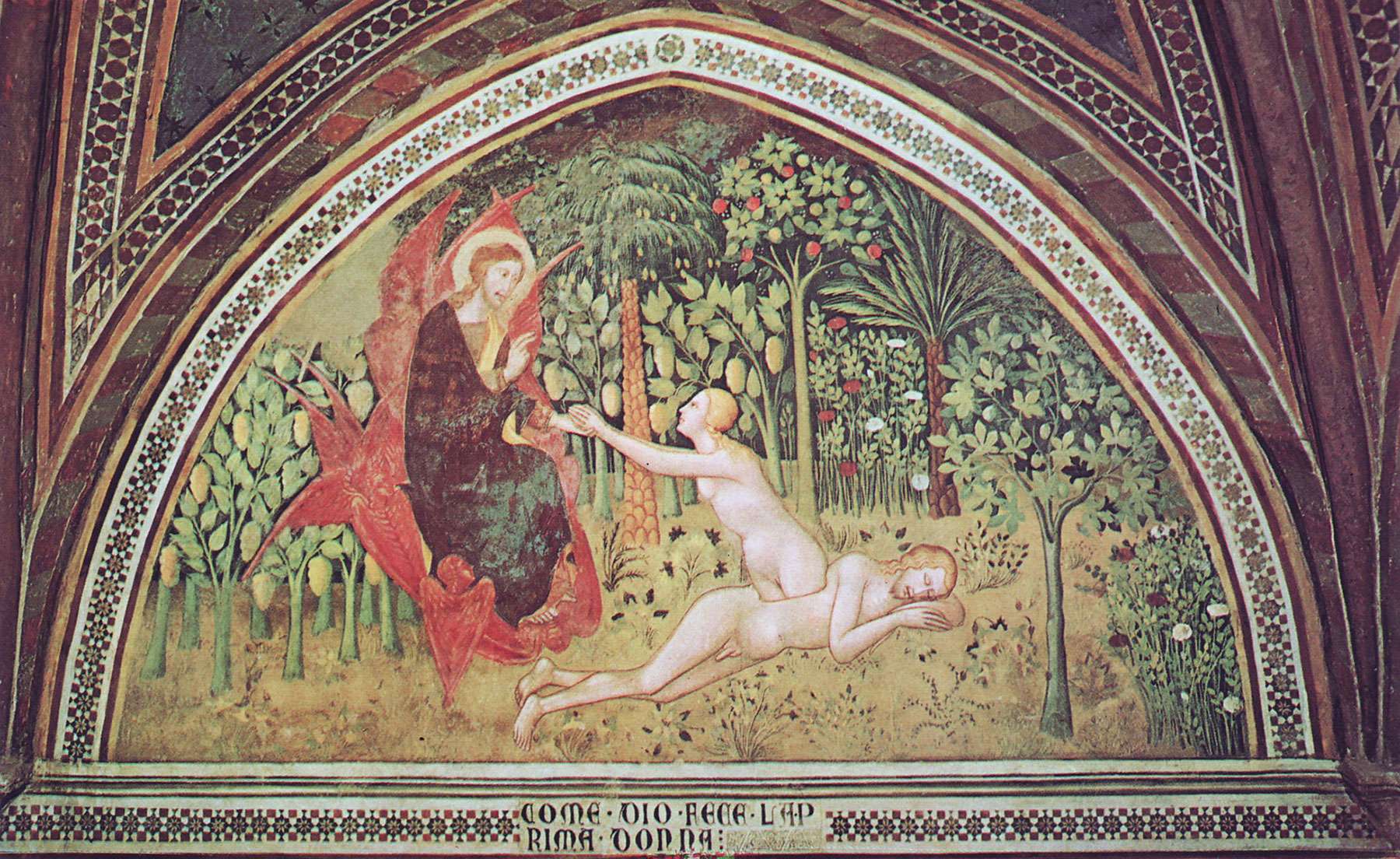 A fresco of the Creation from the Cathedral of San Gimignano in Italy. In the Catholic religion, a woman can simply come from a male rib.
A fresco of the Creation from the Cathedral of San Gimignano in Italy. In the Catholic religion, a woman can simply come from a male rib.
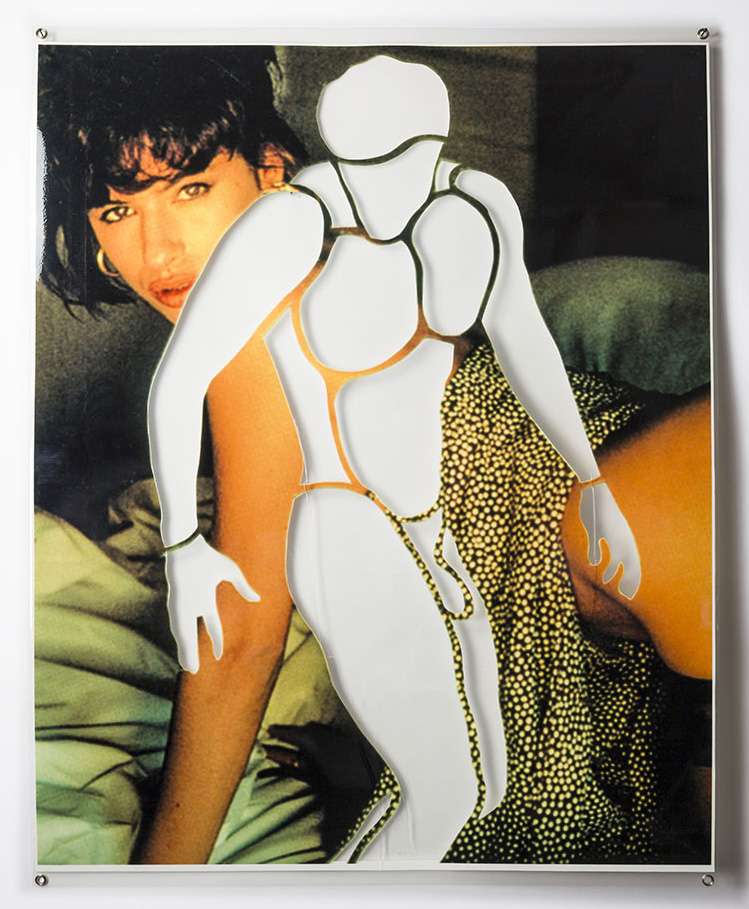 Adam from Eve 21 / print laminated paper, plastic, metal rings / 87x110cm / 1999 / photo AT
Adam from Eve 21 / print laminated paper, plastic, metal rings / 87x110cm / 1999 / photo AT
Archiving: Adam from Eve 21 // RPuB / 031-930 / A108.10K2 – 01PAB-K96PM10-1MKL16ST
An enlargement has been made reverse side of the RPuB of month 10 of the PUBO calendar, the female side. The enlargement is cut out according to the same cutting plan and the RPuB is then laminated.
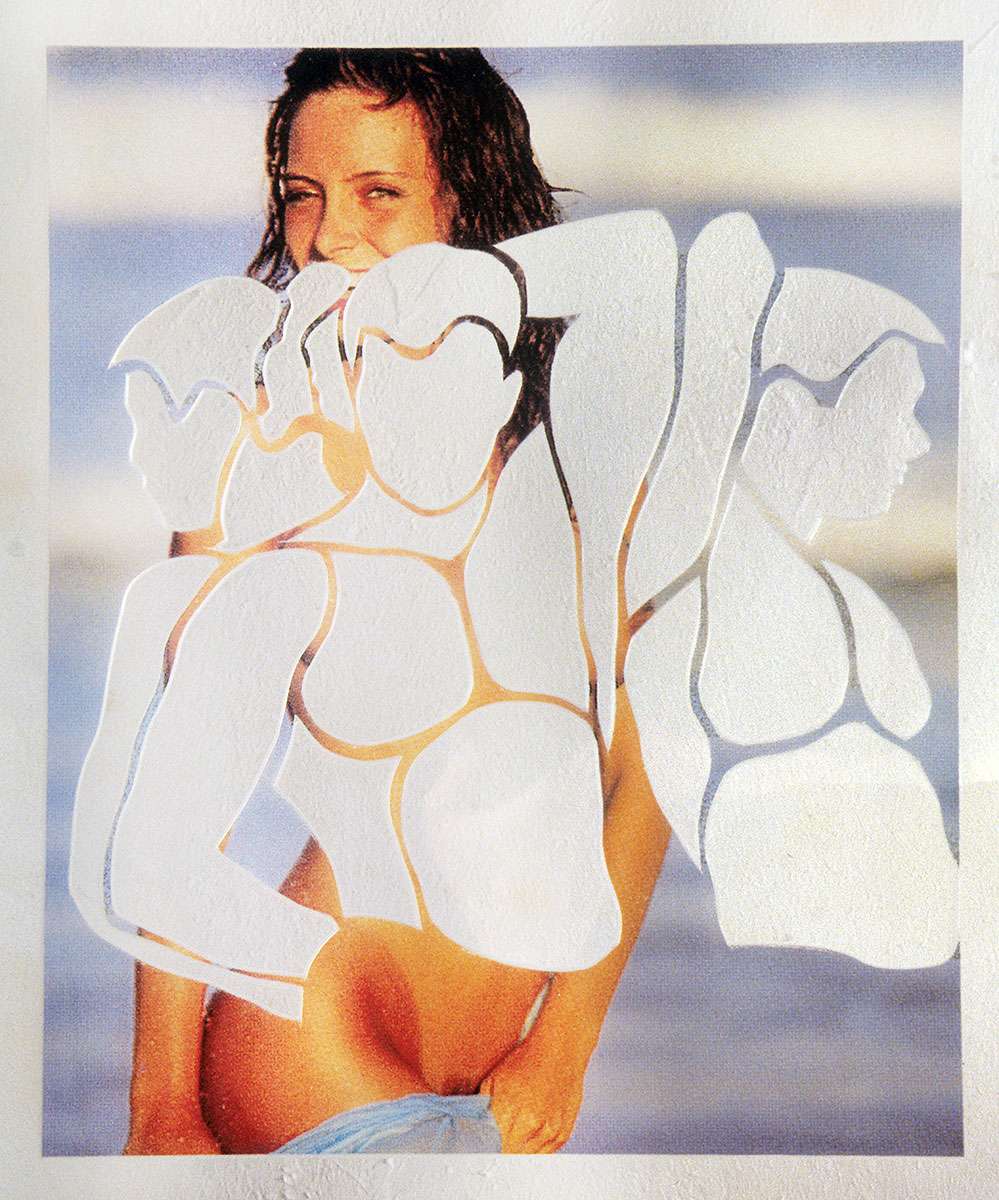
Adam from Eve 22 / print on laminated paper, plastic / 42.5x62.5cm / 1999
Archiving: Adam from Eve 22 // RPuB / 031-530 / A108.8K2 – 01PAB-K96PM8-3MKL21ST
Television
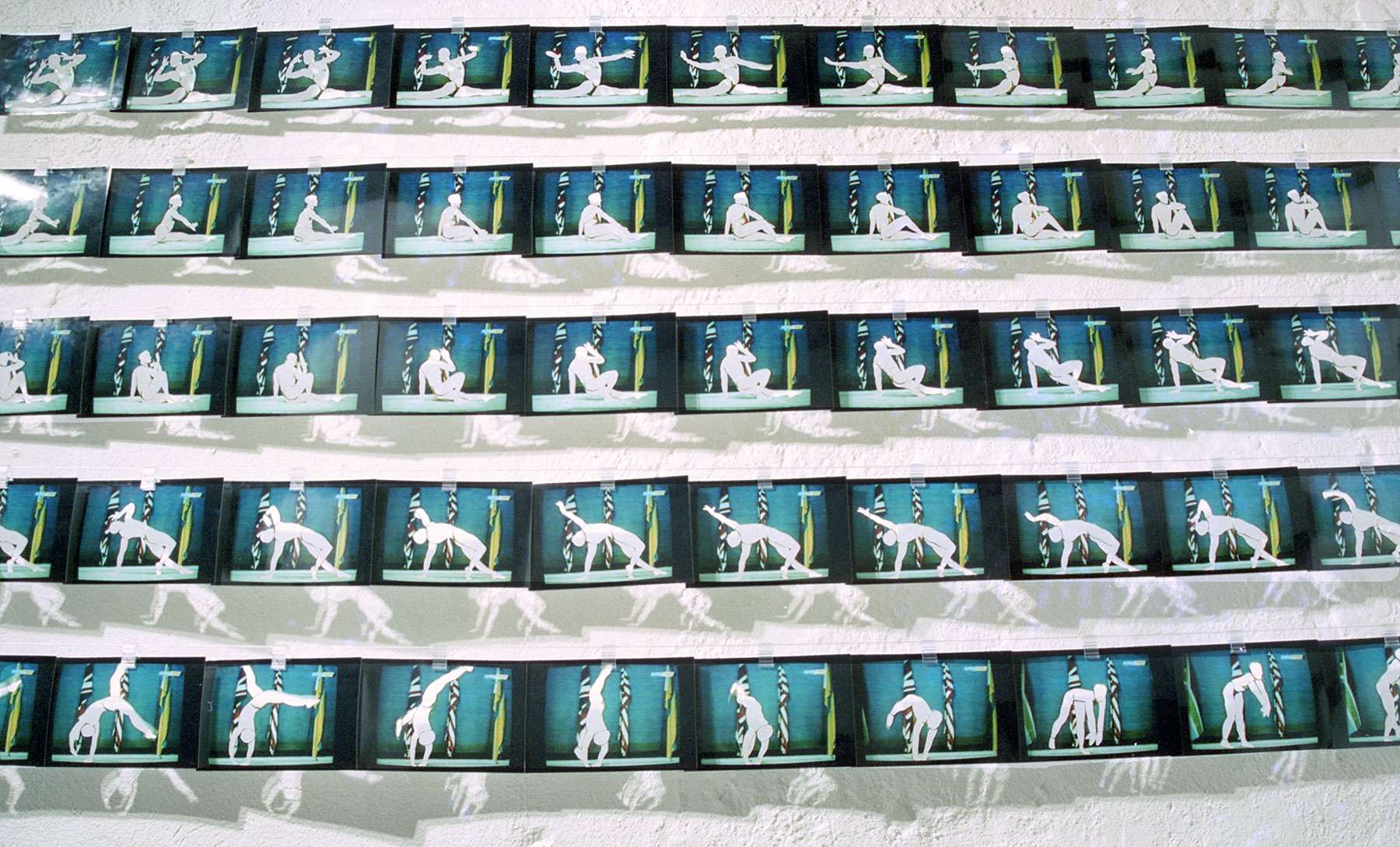 radslag 1 / photo paper, rope, clips, light / 165x80cm / 1996
radslag 1 / photo paper, rope, clips, light / 165x80cm / 1996
Archiving: radslag 1 // RPuB / 003-035 / 21TEL96PP55-55VKLXST
Photos were taken of a TV broadcast about female bodybuilders. This digital Public Body is partly photographed and printed. The sequence of a cartwheel (radslag) is then cut out, after which the PPuB and the RPuB are saved. They are presented as a series.
A new serial composition is made of part of the PPuB in the form of a flipbook. For an external Scan of the Public Body (SPuB) see also the previously discussed SPuB - Scans of the Public Body.

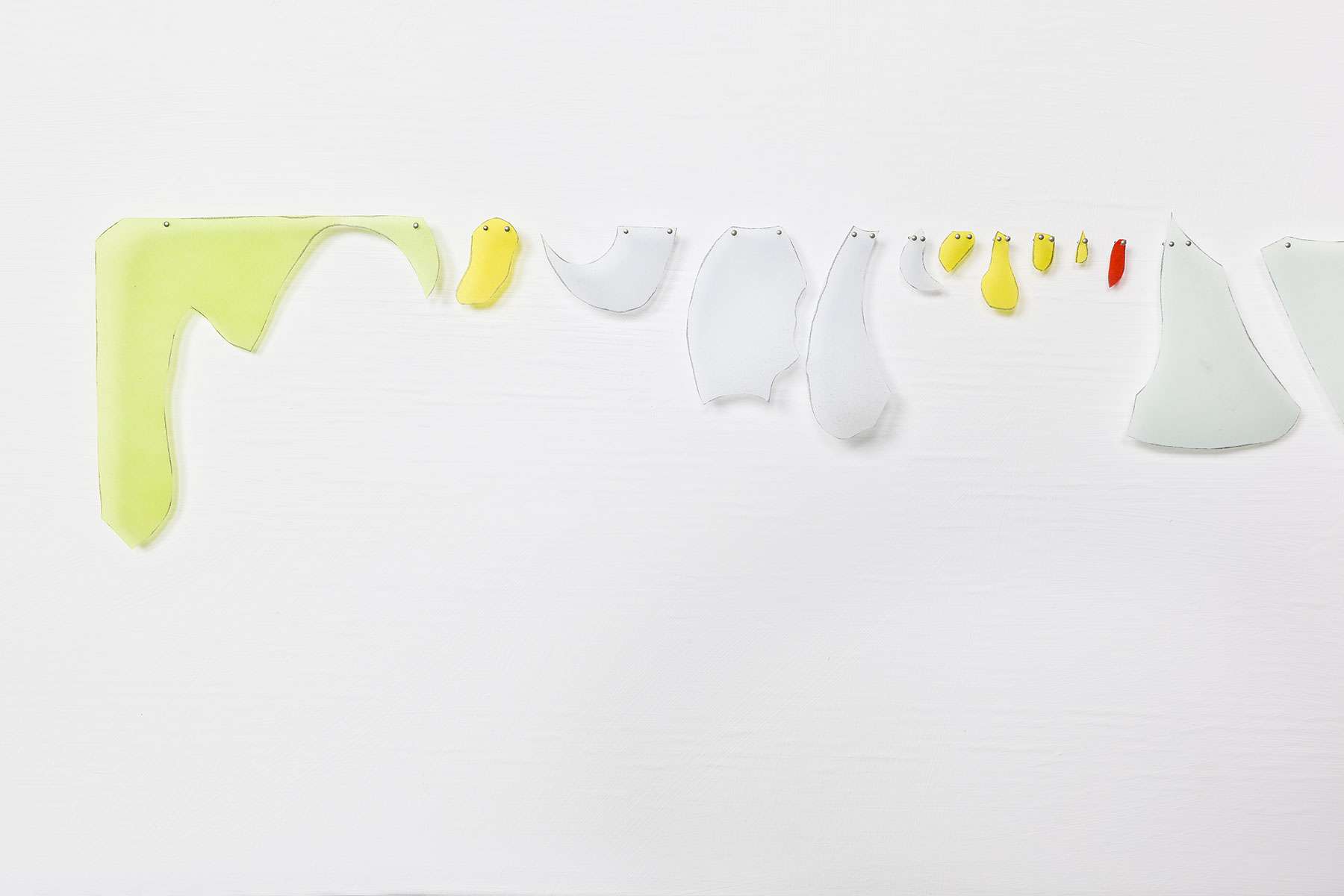
The Applications section uses the same composition techniques as the staff of Archive does for Compositions. The Archive department temporarily uses and re-groups archive material 1:1.
At Applications, free elaborations are made to the original archive material. This may serve as a basis, for instance, to make a magnified form in another material.
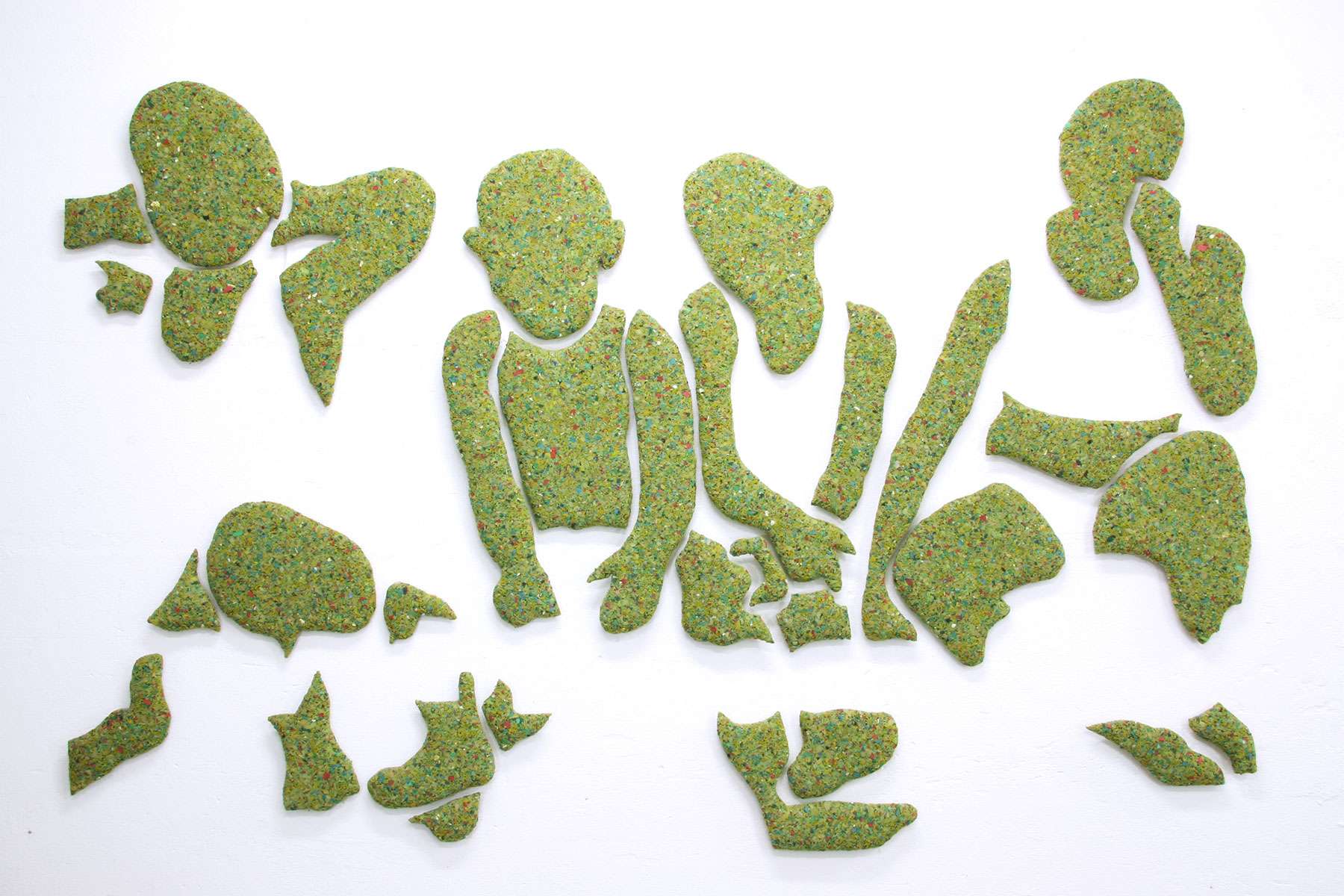
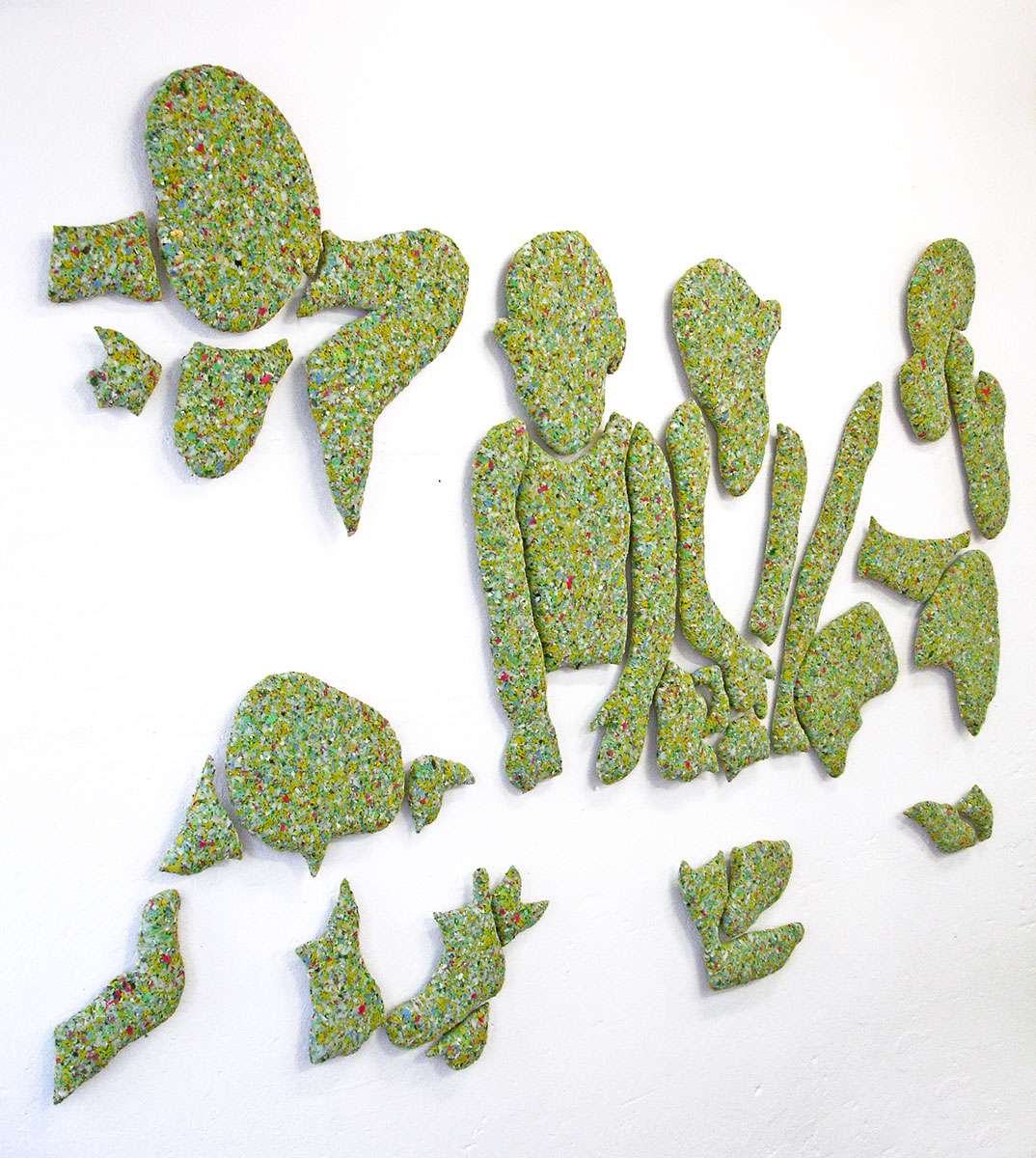
 the children 11 / foam rubber, cardboard, metal / 260x165cm / 2005
the children 11 / foam rubber, cardboard, metal / 260x165cm / 2005
Archiving: the children 11 // PPuB / 042-1000 / R027K1 - 01OUN95.7P56+57-4KKL33ST
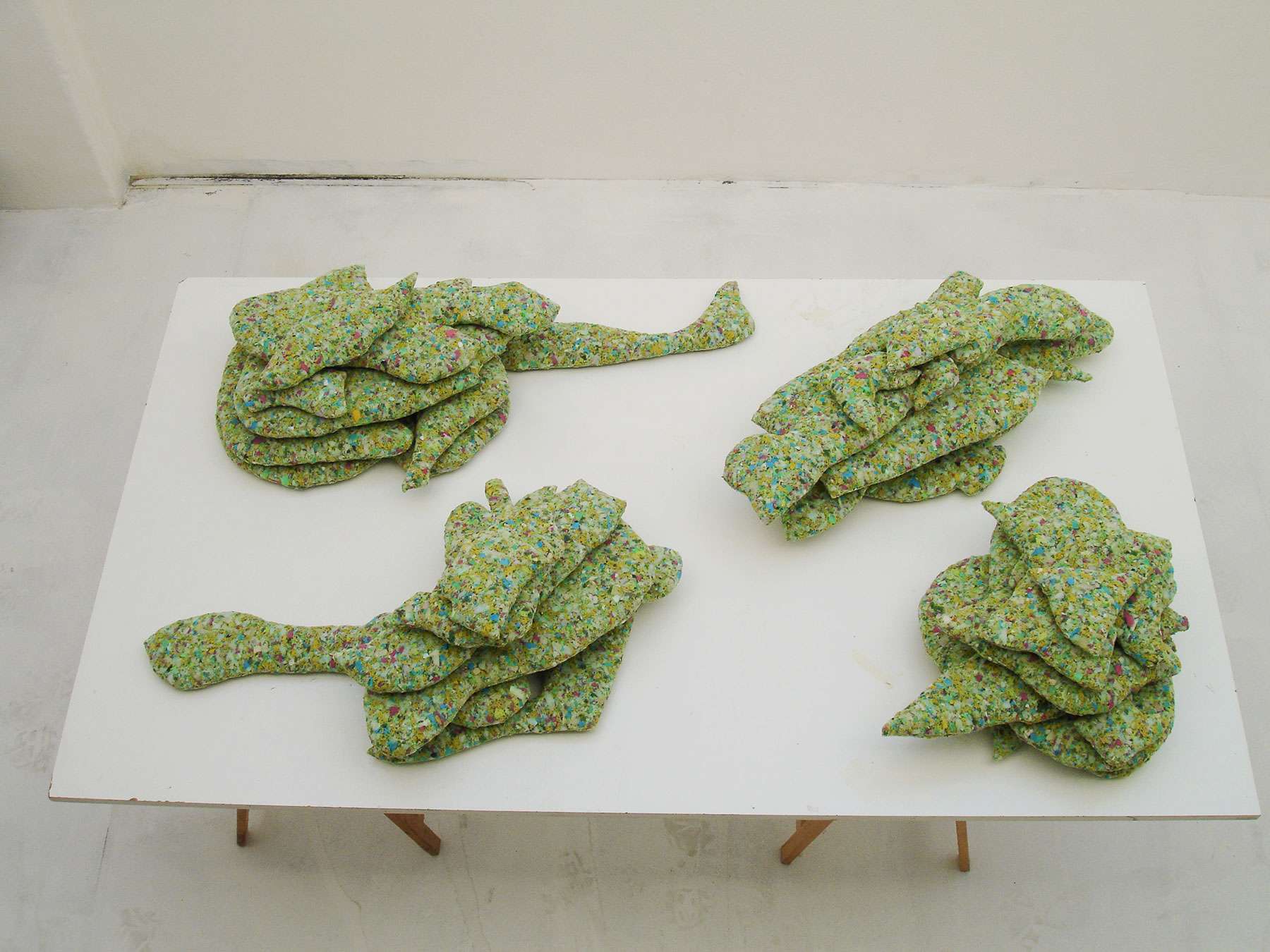
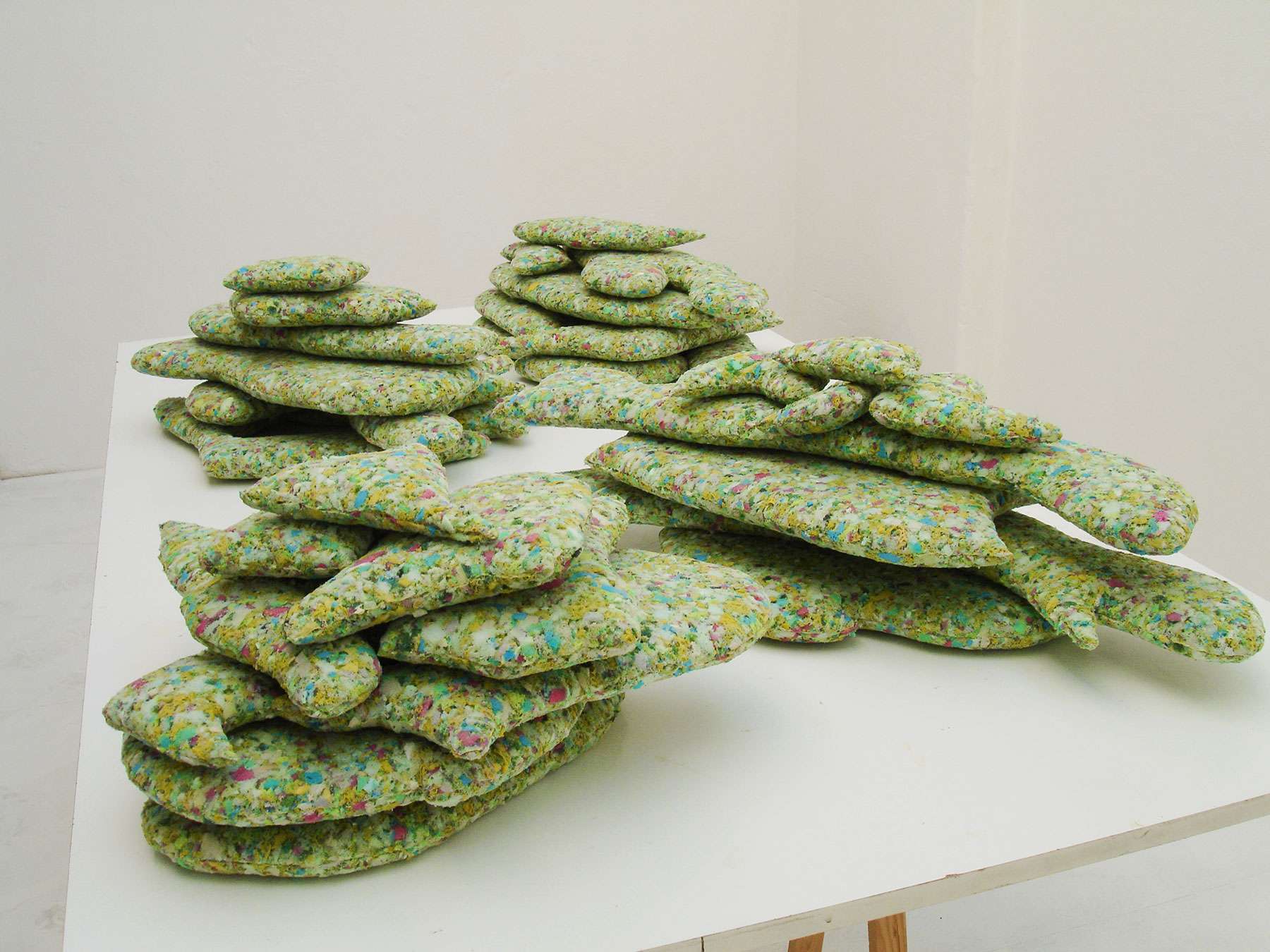
For the children R27 from the archive was used as the basis. It is a small image from a magazine. The original PPuB have been magnified 10x in acoustic foam rubber and have maintained their original position in relation to each other.
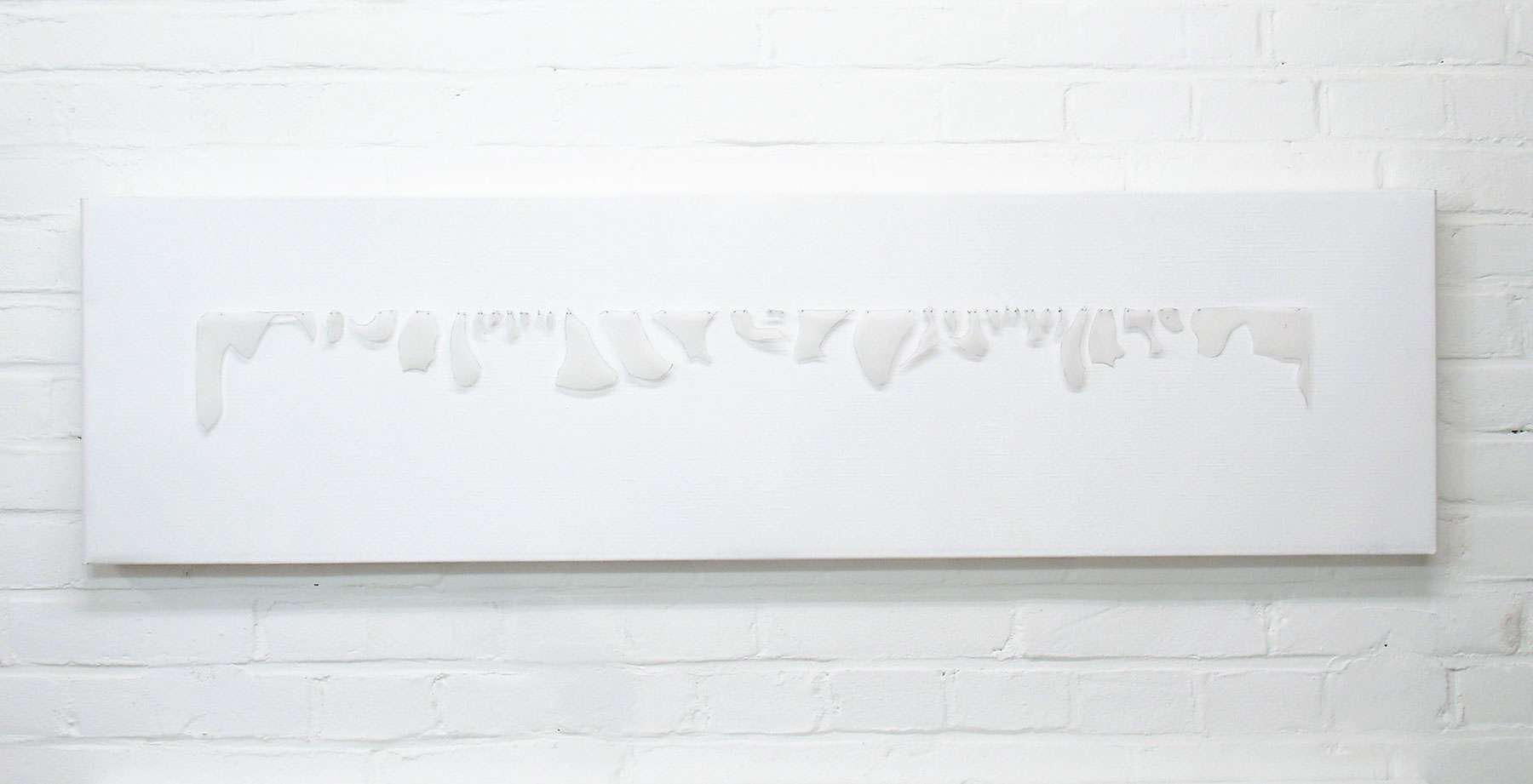
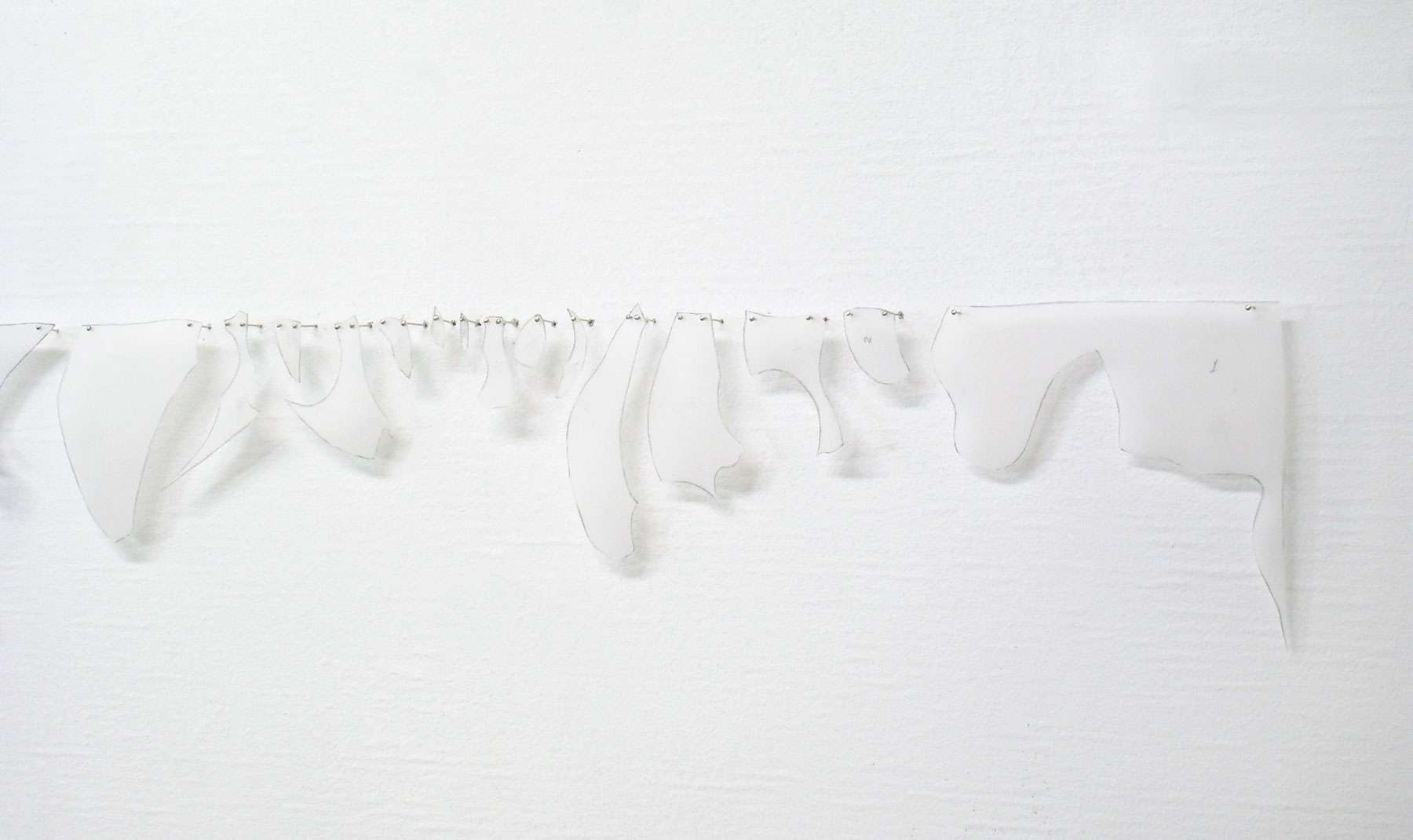 the kiss 11 / calque paper, cardboard, wood, pins, paint / 116x31x4cm / 2007
the kiss 11 / calque paper, cardboard, wood, pins, paint / 116x31x4cm / 2007
Archiving: the kiss 11 // PPuB / 013-100 / A017K1 - 01SEV128P38-2VKL32ST
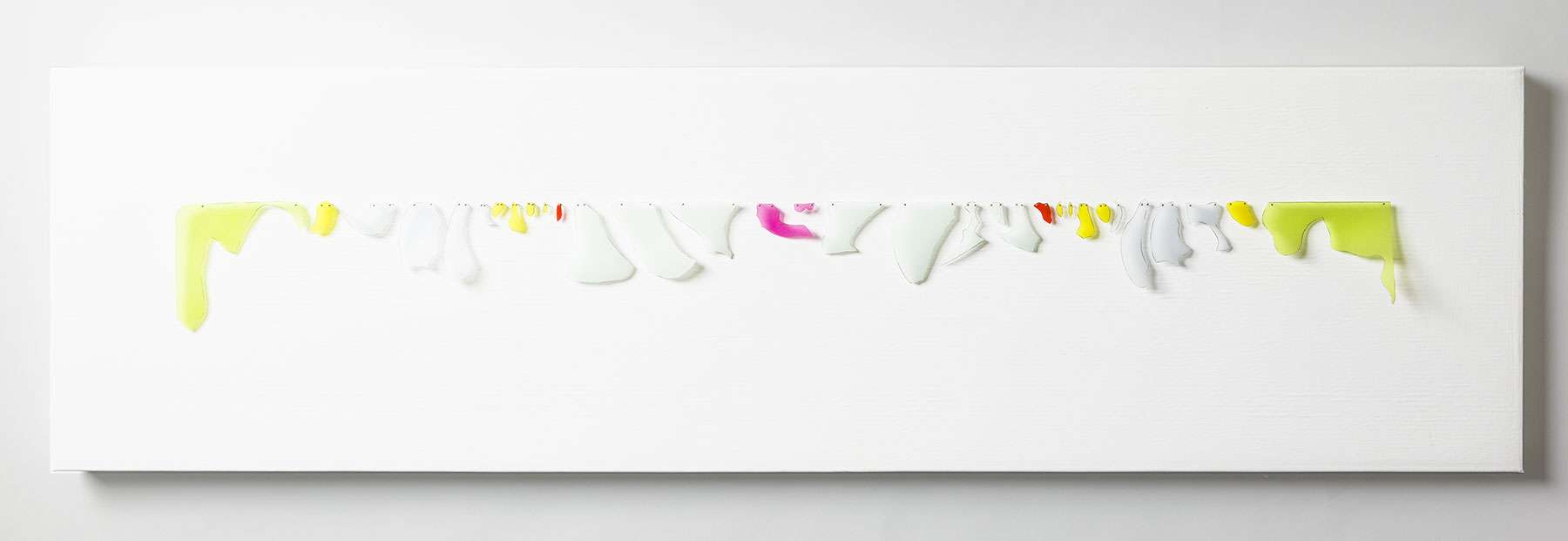
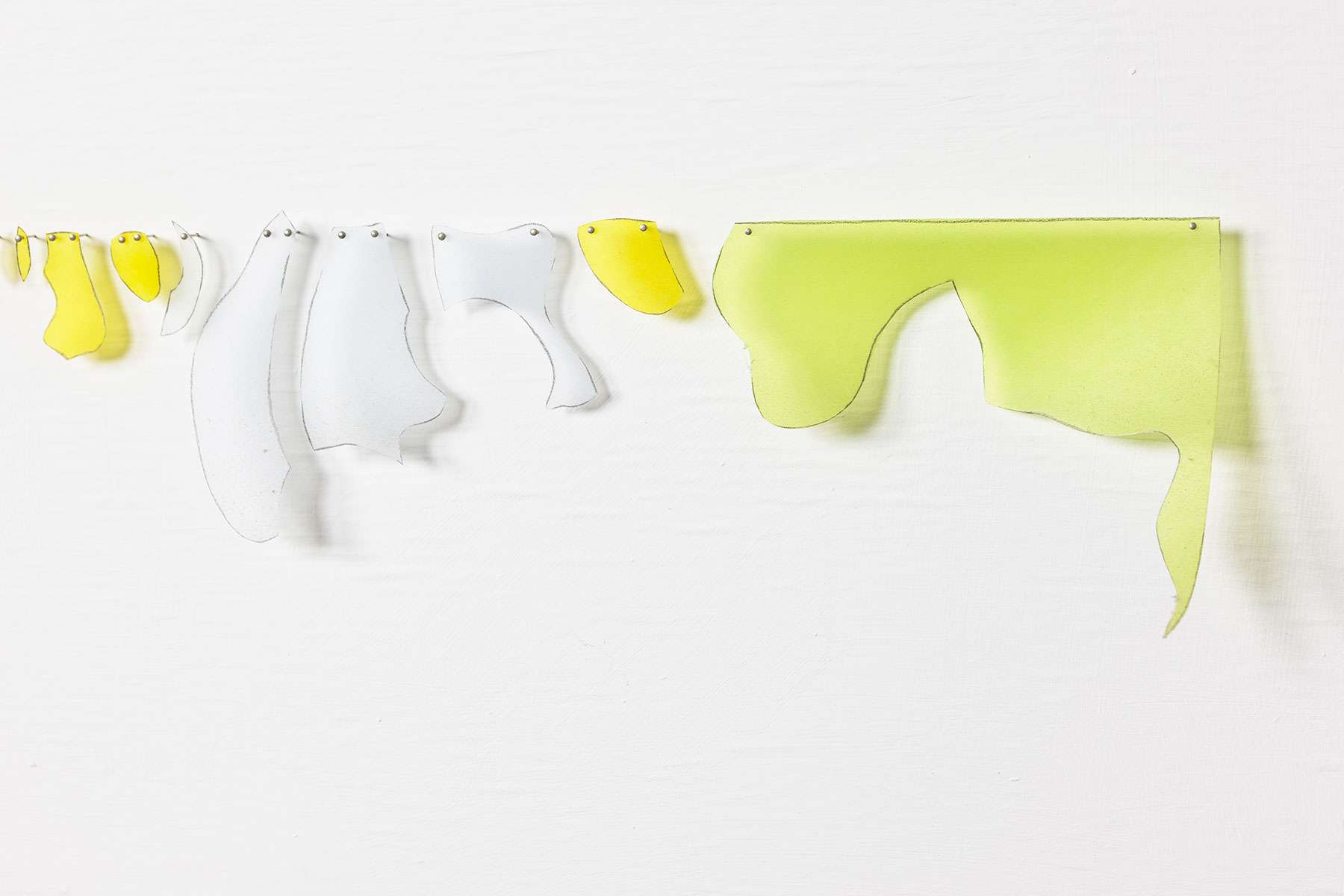 the kiss 13 / calque paper, cardboard, wood, pins, paint / 116x31x4cm / 2008 / photos AT
the kiss 13 / calque paper, cardboard, wood, pins, paint / 116x31x4cm / 2008 / photos AT
Archiving: the kiss 13 // PPuB / 014-100 / A017K1 - 01SEV128P38-2VKL32ST
For the kiss number A17 from the archive is taken as the basis, an image with 32 PPuB parts, from a magazine. All the PPuB parts have been copied 1:1 in calque paper and sorted again, now linearly, from left and right towards the middle. Starting with number 1, from left up to 16 and from right ascending from number 17 to 32.
The Presentations department of the Institute for Research of the Public Body, devotes itself to showing what the institute does. It puts together presentations from and with the various departments and puts documents, drawings and installations into the outside world.

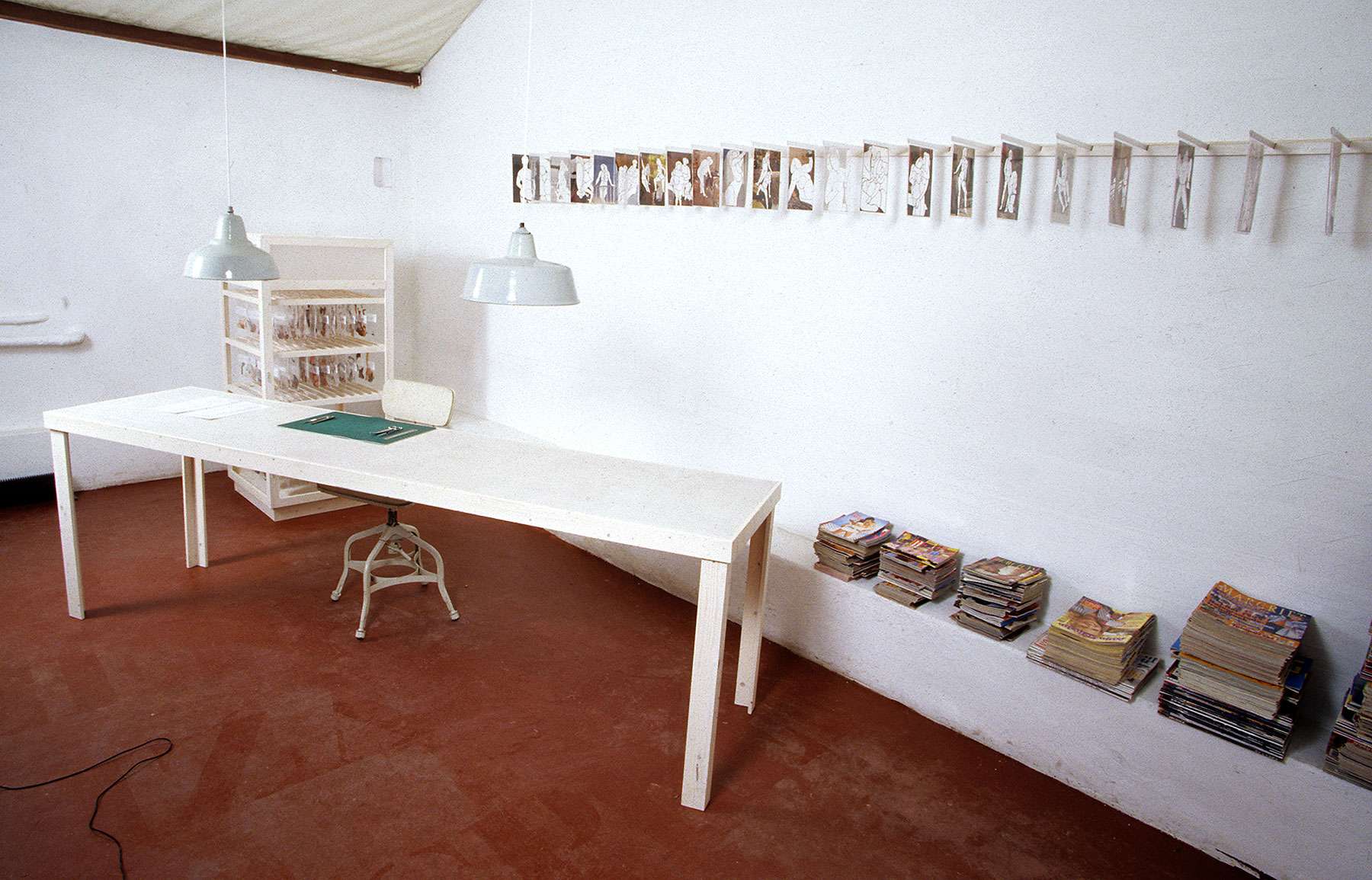
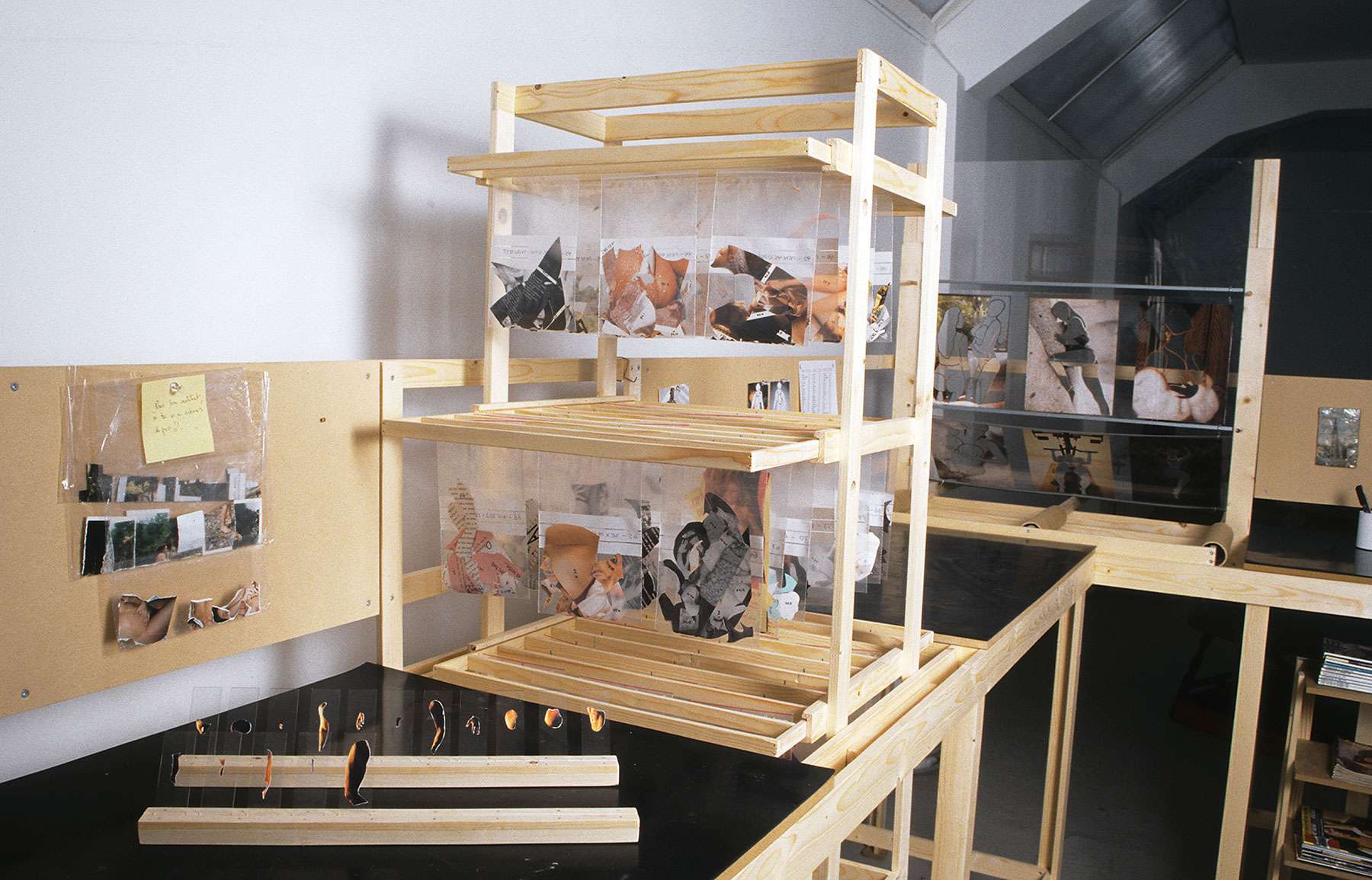
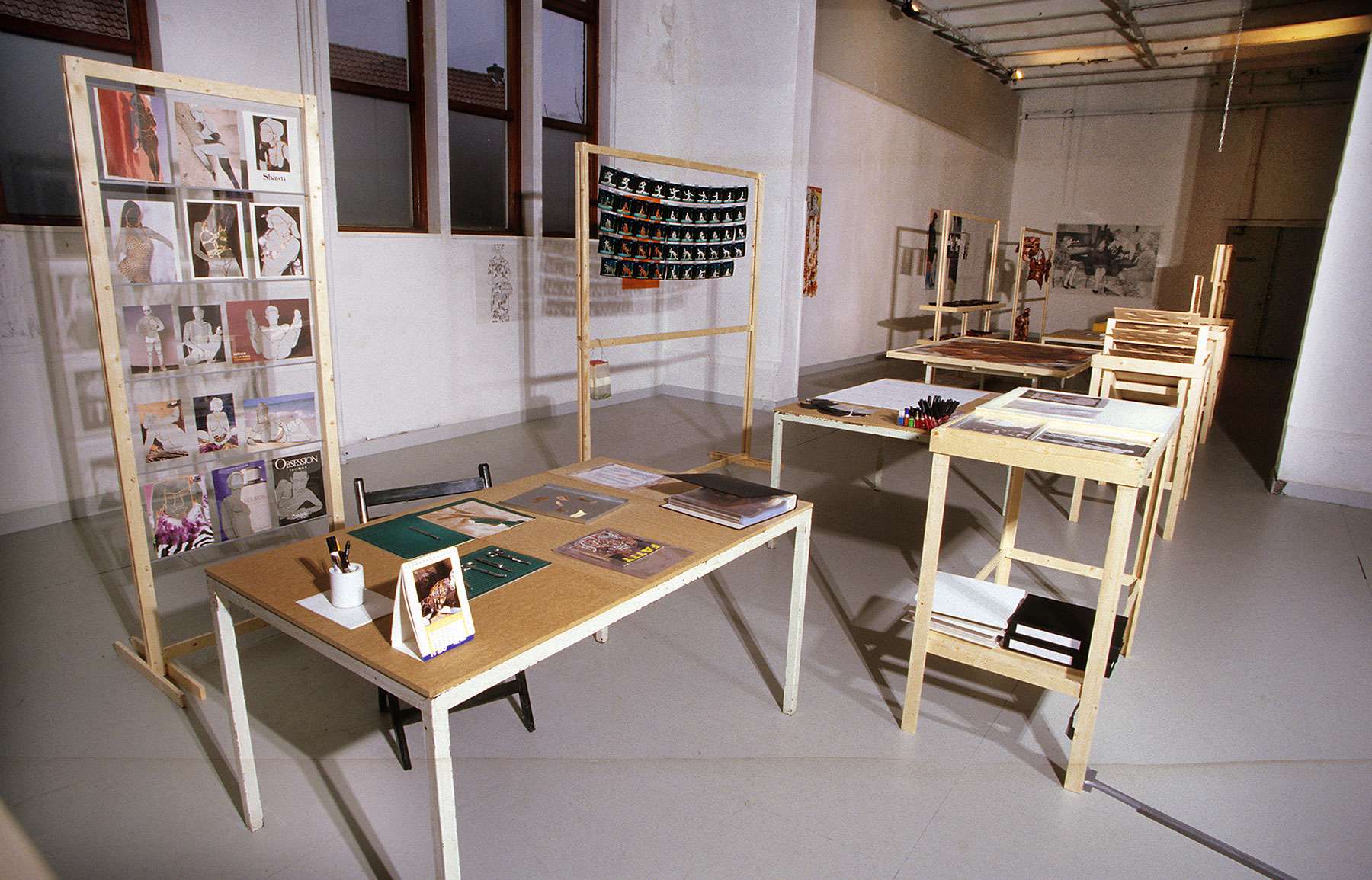
Together with the External Research department, it works with people and initiatives outside the Institute. Where External Research focuses on research questions, Presentations focuses on interpretation, clarification, and explanation. See also More Body for more projects on which it has worked.
A good example of a presentation is the Processing Unit of the Institute. This installation shows a number of activities of the Institute in a linear composition, as if it were a production line. Both the de-composition and the composition are handled.
Activities are introduced as parts of a conveyor belt, the departments where this happens as work benches and the results as presentations on walls, racks and in cabinets.
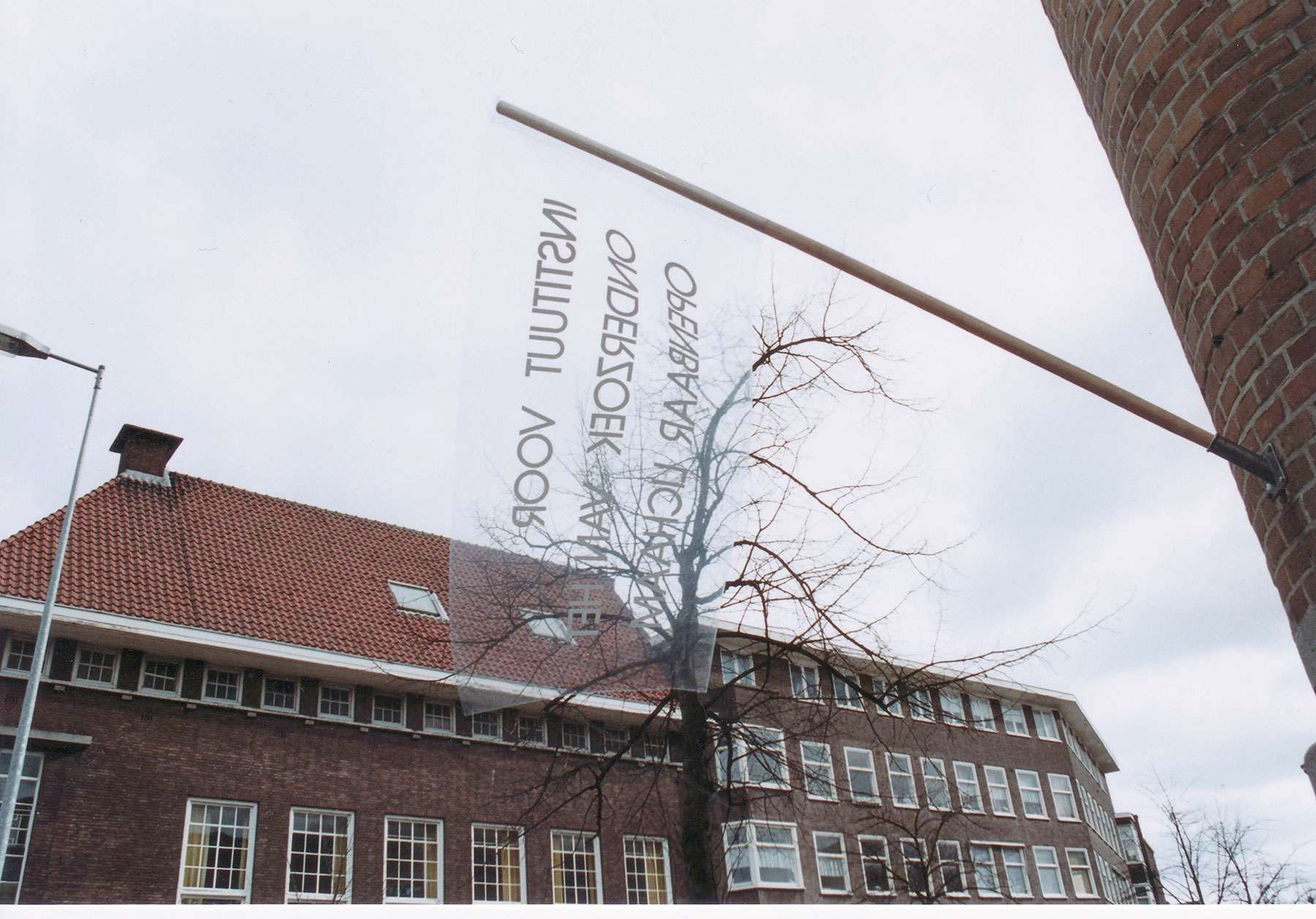
Flag in Rahmenerzählung / plastic, adhesive letters, wood / size / 1995
Rahmenerzählung is an installation on location, duo exhibition with Jurgen Winkler, Semarangstraat-Javastraat, Amsterdam
The first presentation of the (National) Institute for Research of the Public Body takes place in two window displays. The Institute’s flag flies between the two windows.
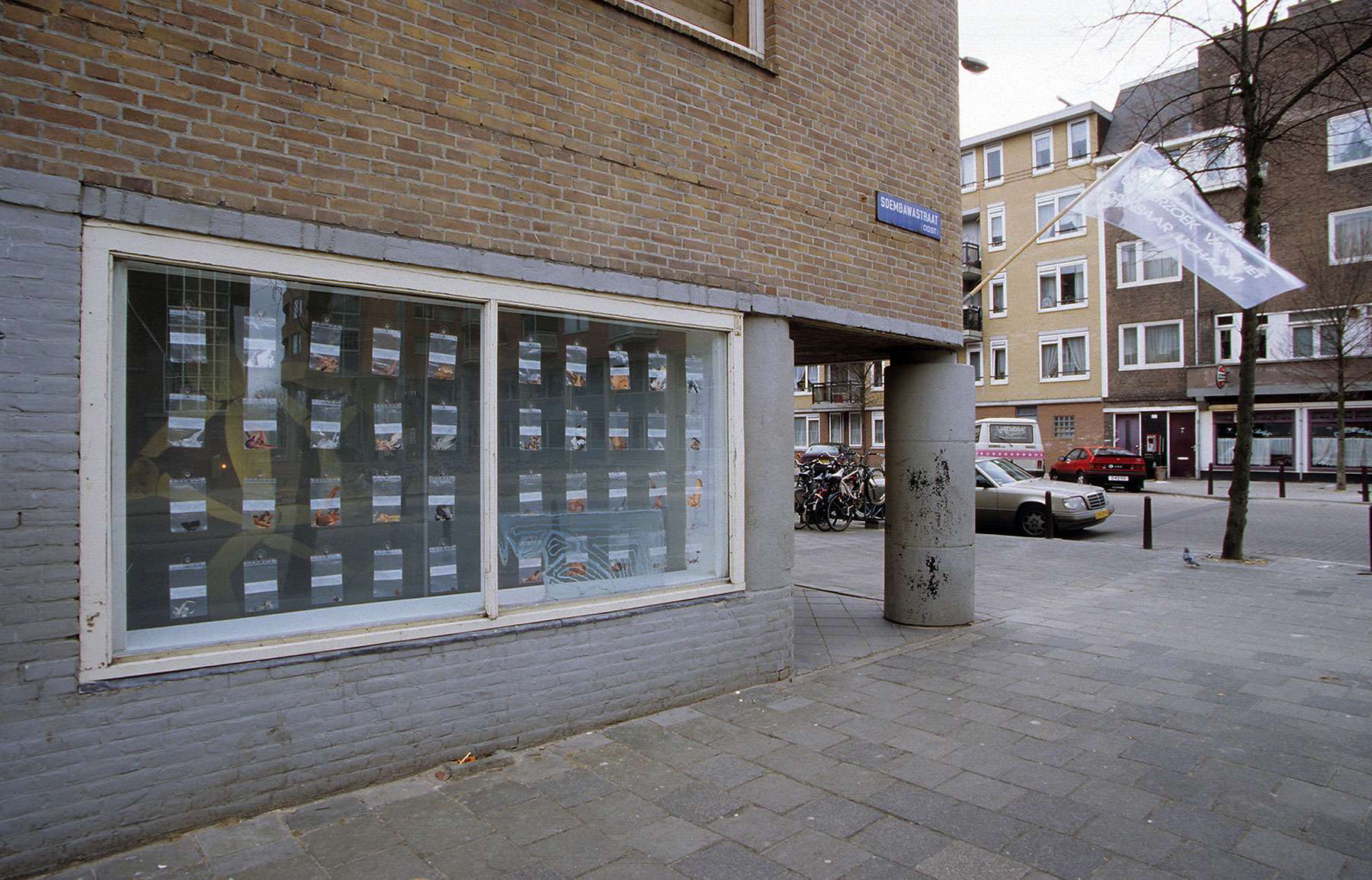
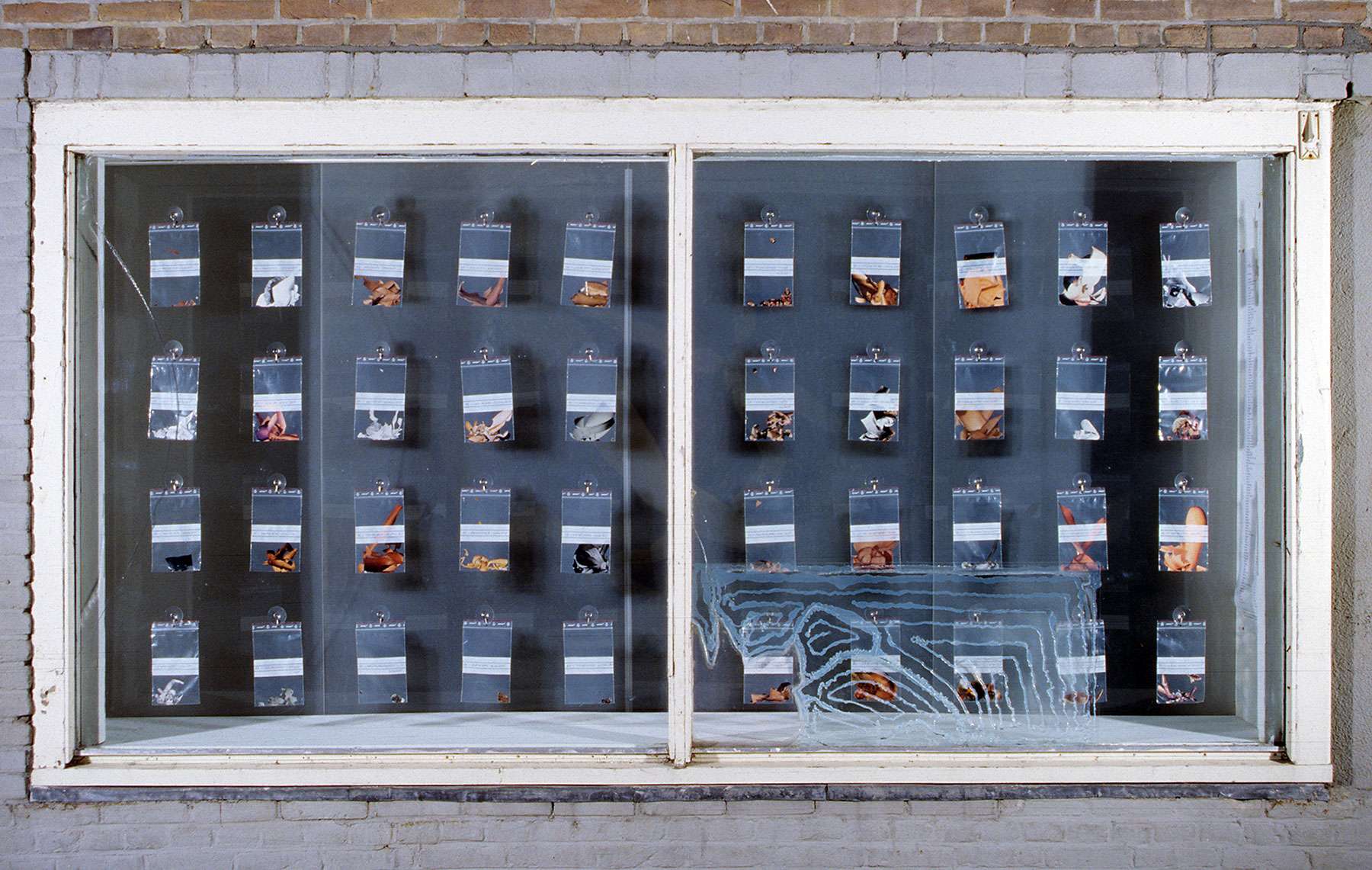
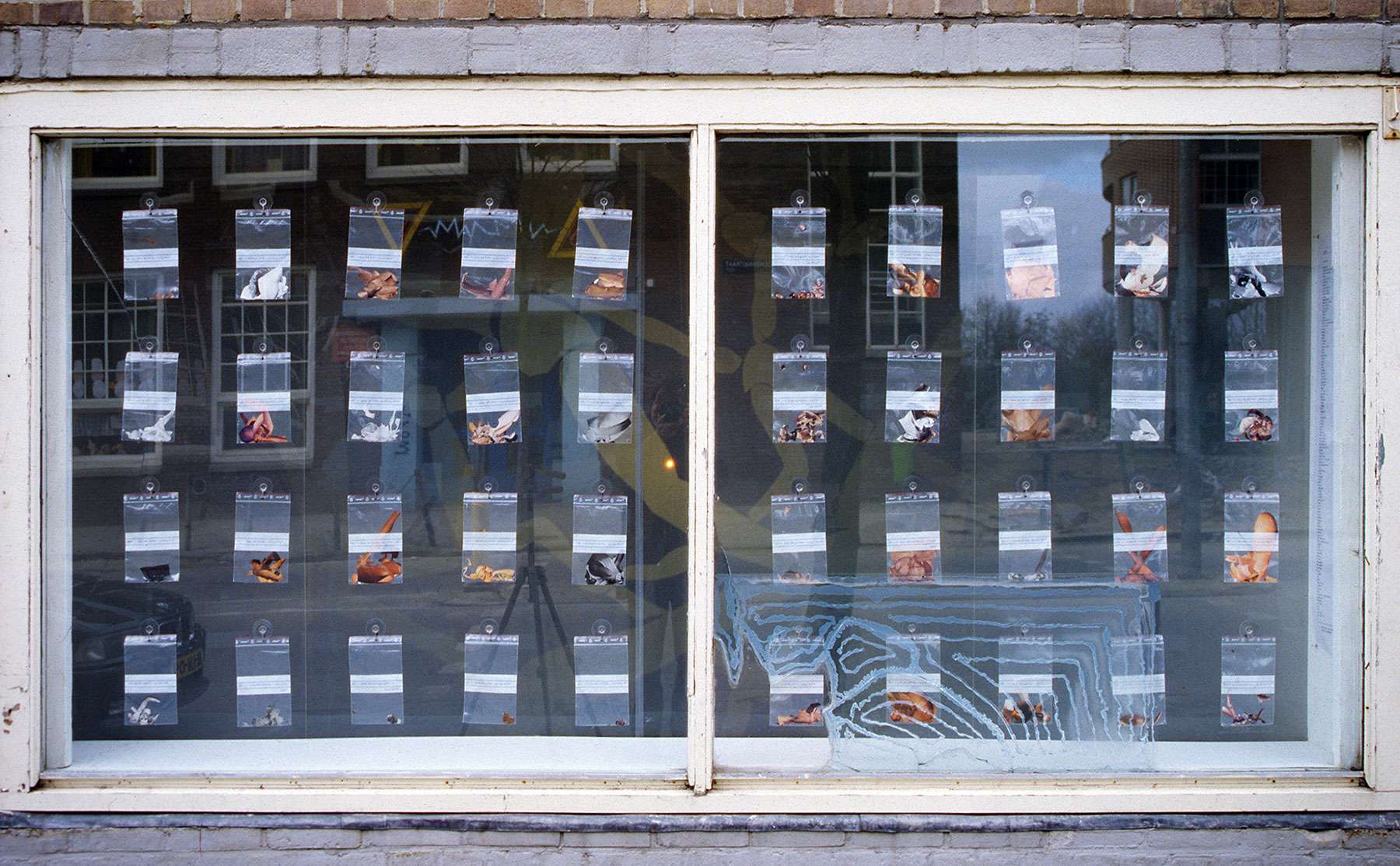
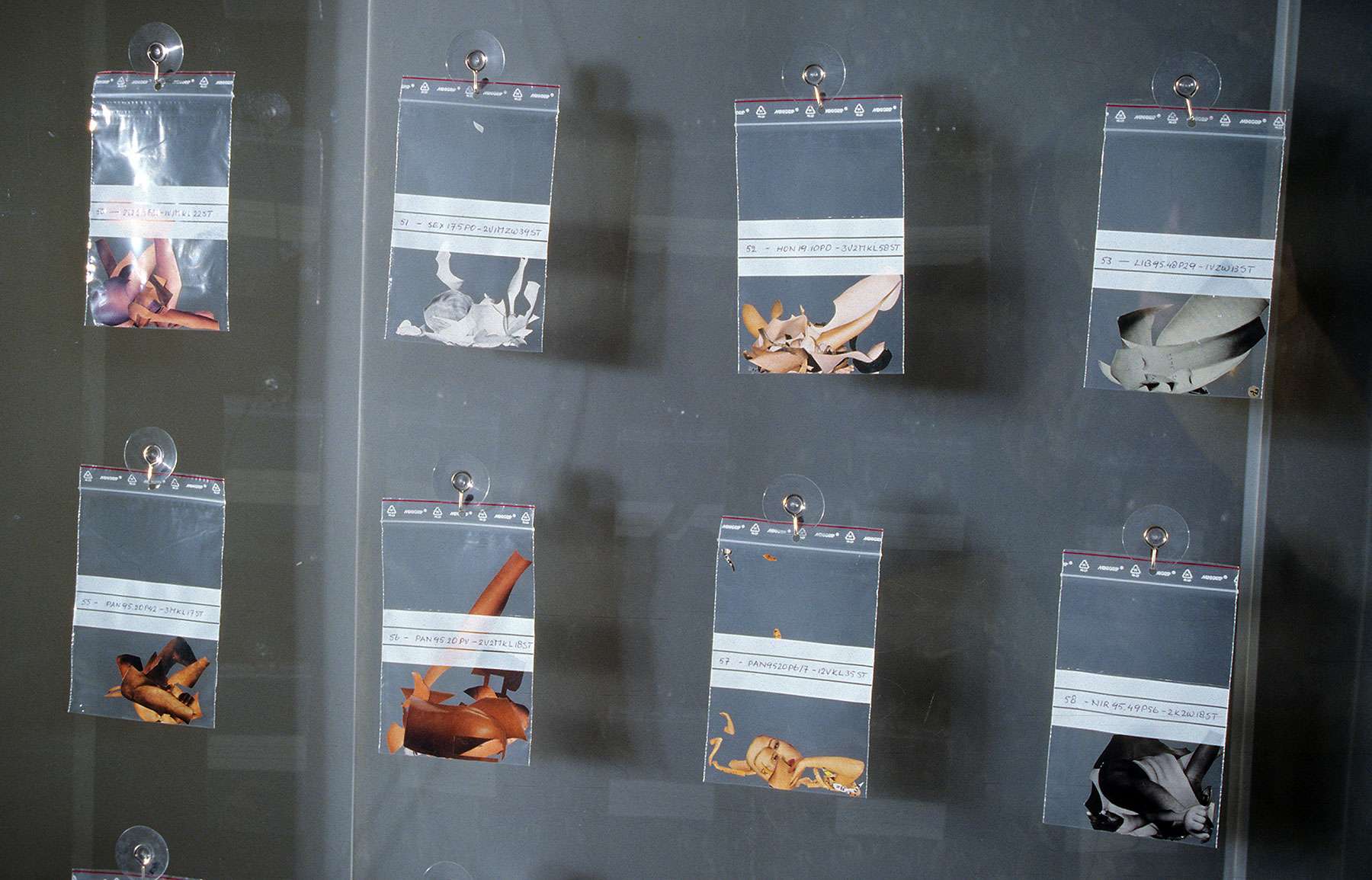 Window display 1 in Rahmenerzählung / paper, pen, plastic bags, suction cups, glass, calque paper, projection / 300x150cm / 1995
Window display 1 in Rahmenerzählung / paper, pen, plastic bags, suction cups, glass, calque paper, projection / 300x150cm / 1995
In the first window display, the Institute’s Archive department presents a number of plastic bags that are hung on the window using suction cups. The bags are filled with parts of images of people in the Public Body. These images are called PPuB in the archive, Parts of the Public Body. See also the Parts PuB of the Archive department.
A projection of a number of PPuB in black and white, blended into a new picture, is shown on a transparent back wall. These composed images are a re-use of Parts from the archive and are called SPuB, Scans of the Public Body. In this case, it concerns an ´internal image´, a scan of the inside of the Public Body. The picture is one from a series of 14. See also the Scan PuB from the Archive department.

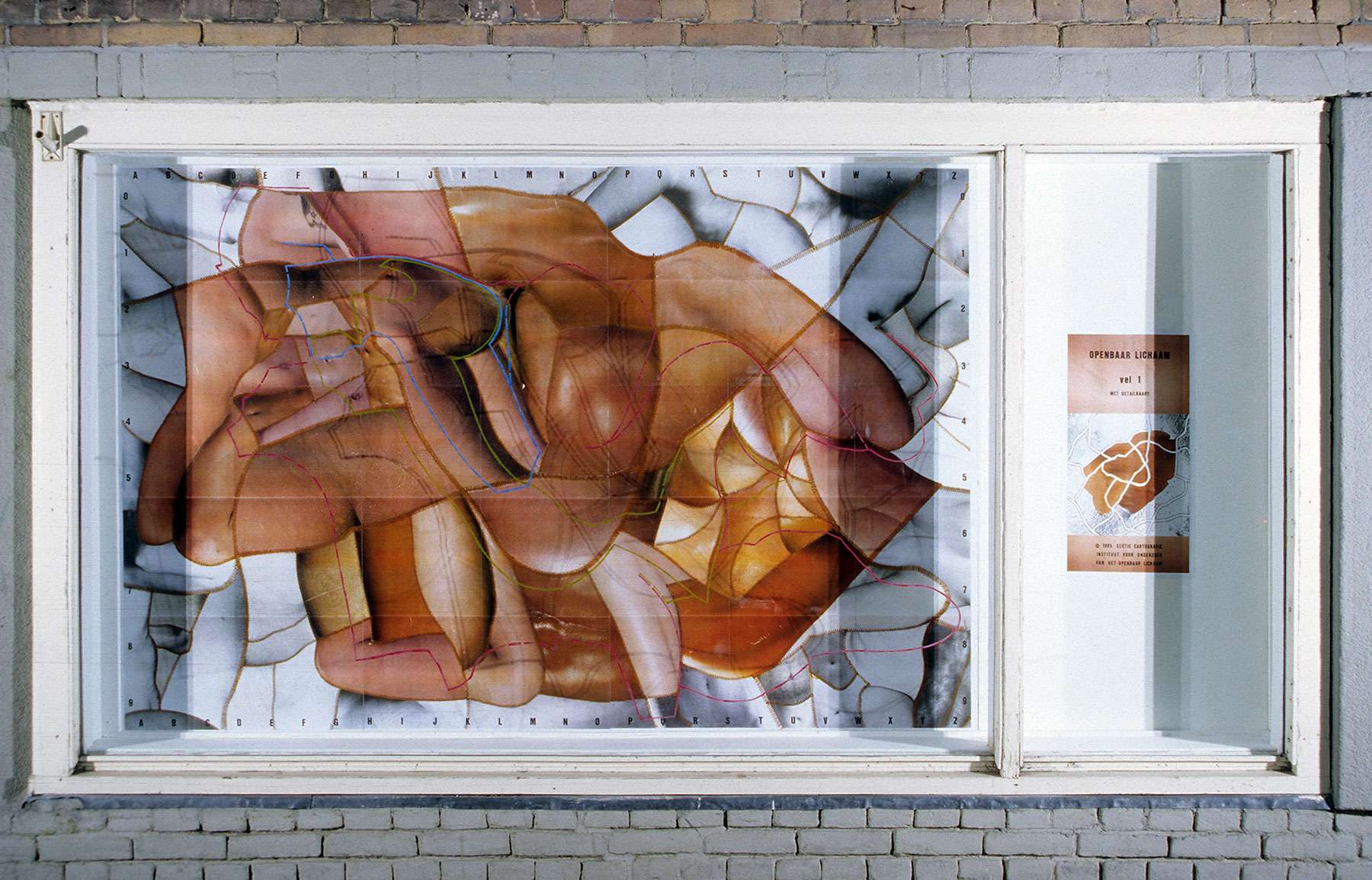
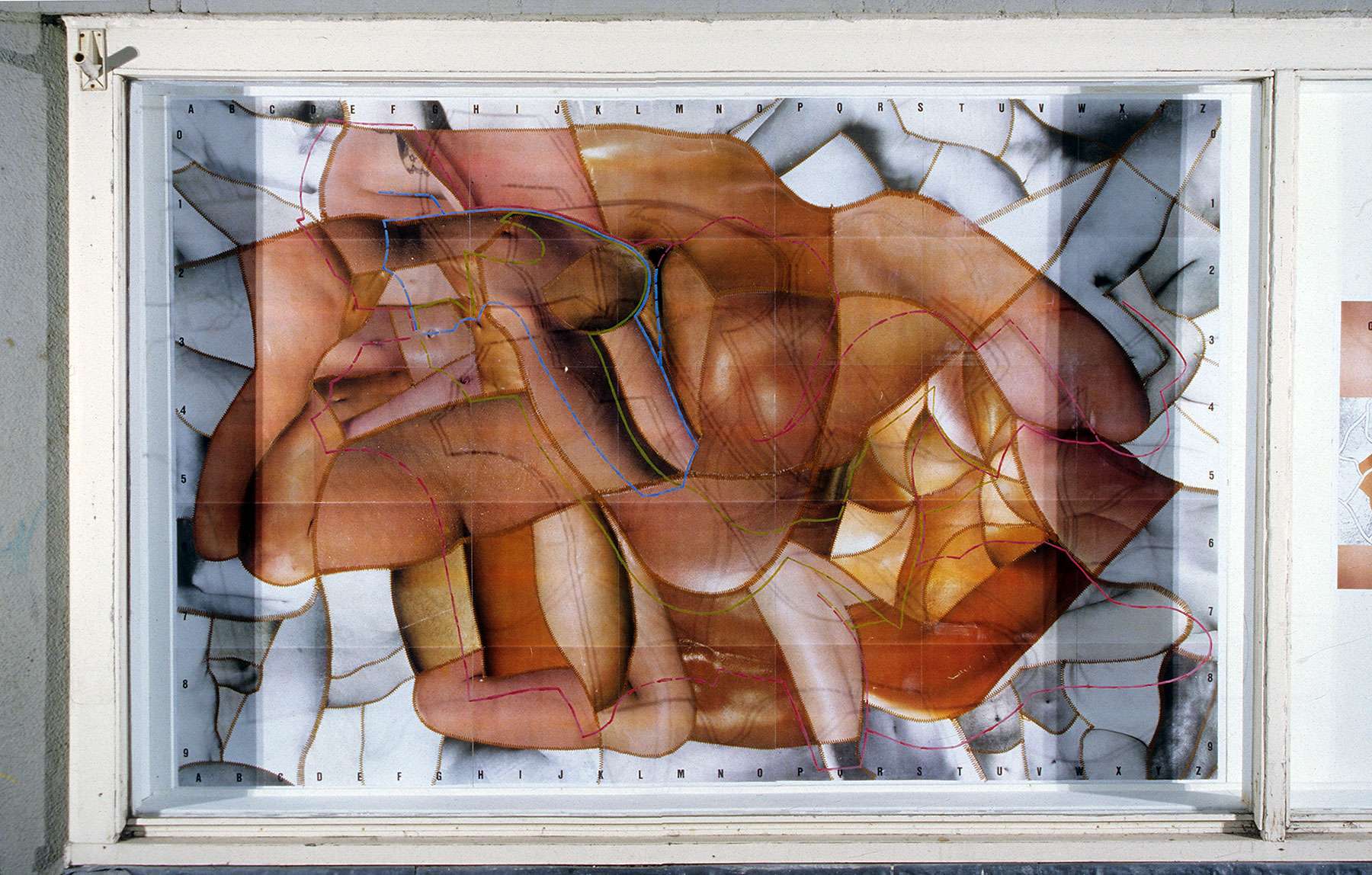
 Window display 2 in Rahmenerzählung / print on paper, wood, glass, nail polish, light / 300x150cm / 1995
Window display 2 in Rahmenerzählung / print on paper, wood, glass, nail polish, light / 300x150cm / 1995
In the second window display the Cartography section of the External Research department of the Institute for Research of the Public Body presents a large printed map on a back wall. It concerns an enlargement of an MPuB, a Map of the Public Body, including an enlarged front side of the map. See also the section Cartography of the Archive department.
On the inside of the window several walking paths are set out in nail polish on the Map of the Public Body. Nail polish is a material that easily distinguishes specific parts of the Public Body. Together with the map this forms the MPuB 2 of the Cartography section. For the use of nail polish see also the works Homo Publicus in the Processing section from the Development department.

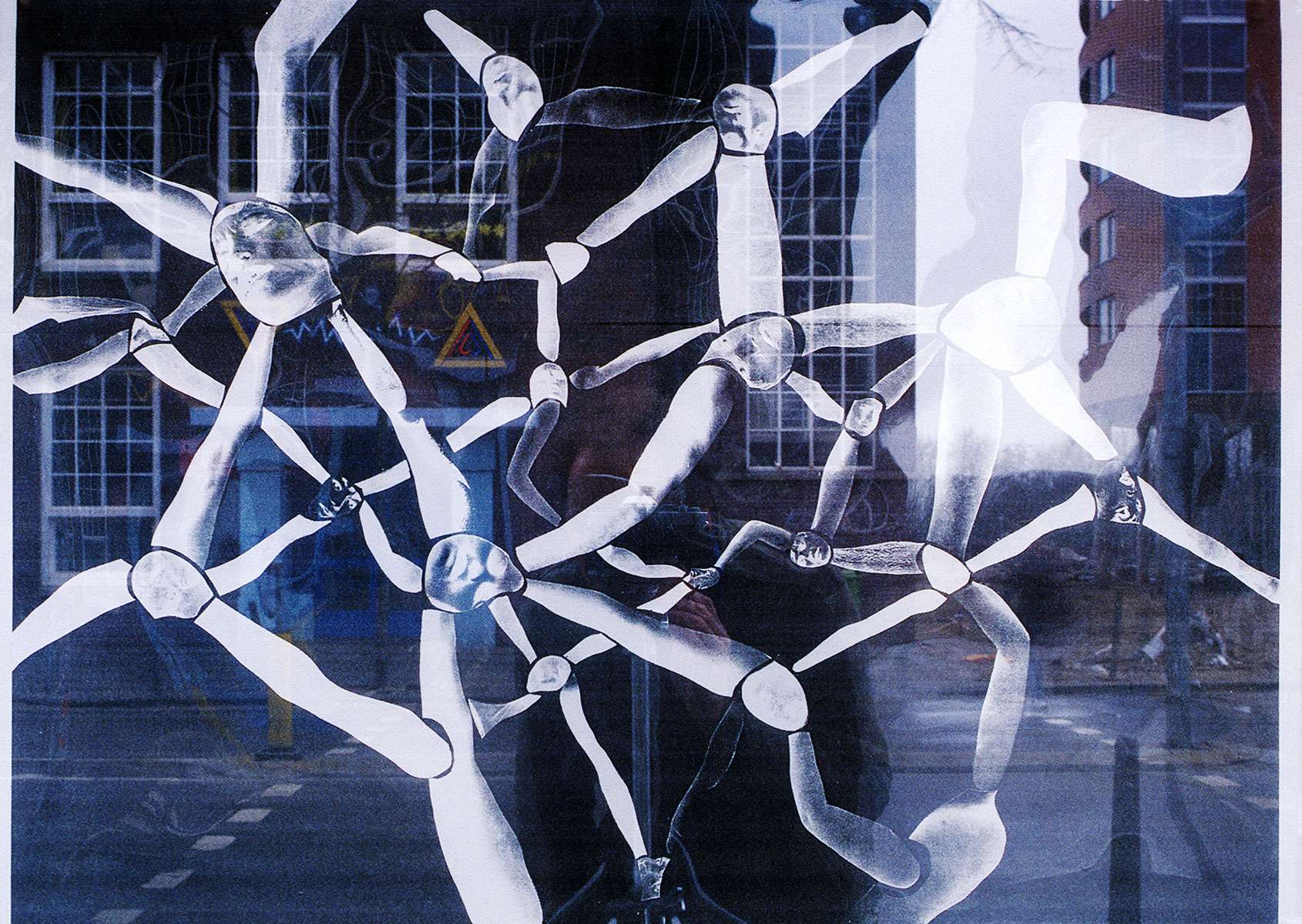

 Window displays 1 & 2 and flag in Rahmenerzählung / plastic, adhesive letters, paper, pen, plastic bags, suction cups, glass, calque paper, projection, print on paper, wood, nail polish, light / 1100x200cm / 1995
Window displays 1 & 2 and flag in Rahmenerzählung / plastic, adhesive letters, paper, pen, plastic bags, suction cups, glass, calque paper, projection, print on paper, wood, nail polish, light / 1100x200cm / 1995
Rahmenerzählung is an installation on location, Semarangstraat-Javastraat, Amsterdam
In both window displays, layering has been built-in. In display 1 with original Parts Public Body on the window and re-use of PPuB in a Scan of a larger Public Body (SPuB) as a projection onto the surface behind.
In display 2 layering is created using the Map of the Public Body (MPuB) on the back wall with the walking routes from that map put on the window with nail polish.
When the visitor looks through the windows in the displays, an extra dimension is added. Through the reflection in the windows, the spectator with the surroundings also become part of the presentation. The flag with text which you look through reinforces this effect even more.
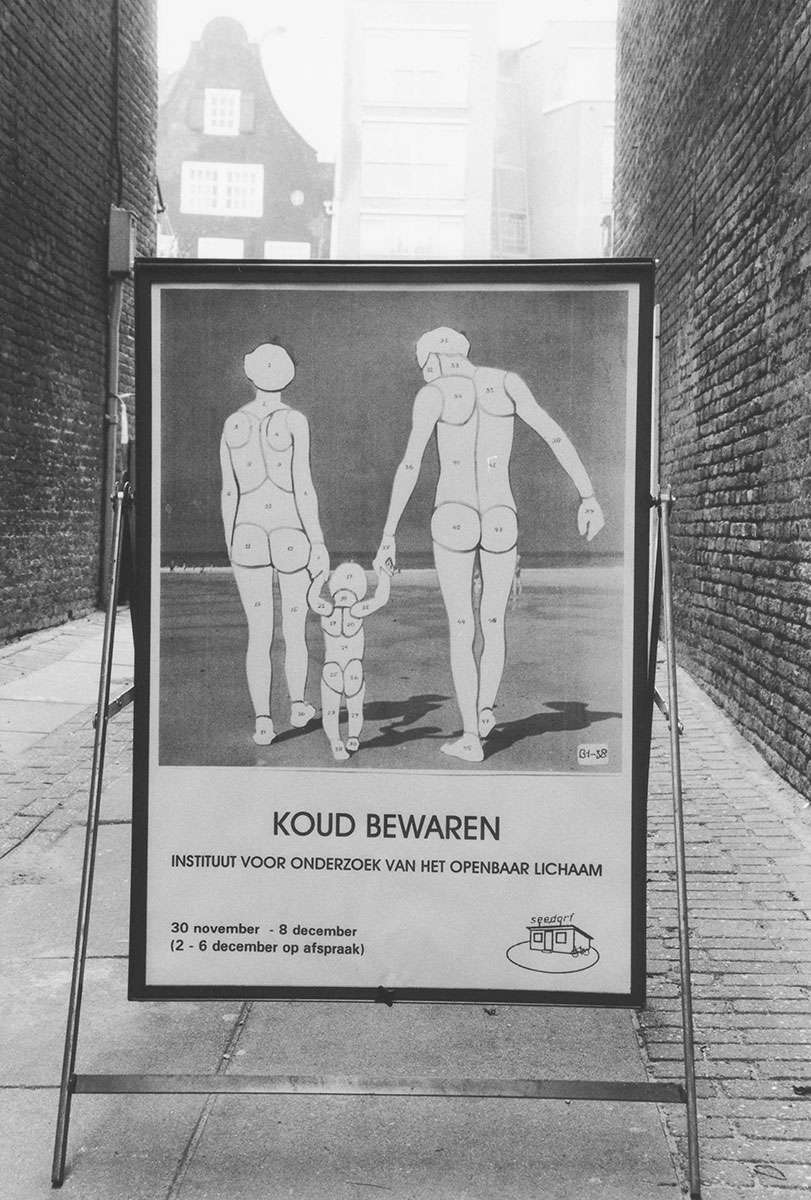
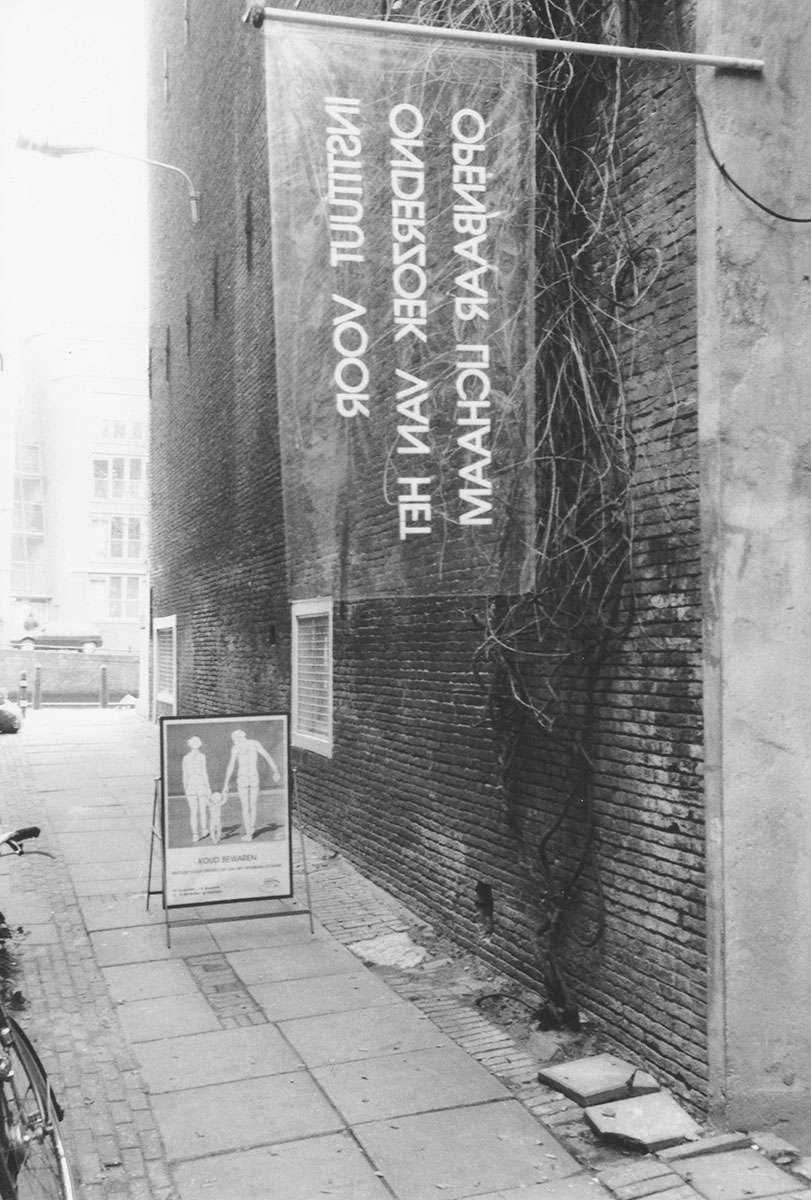
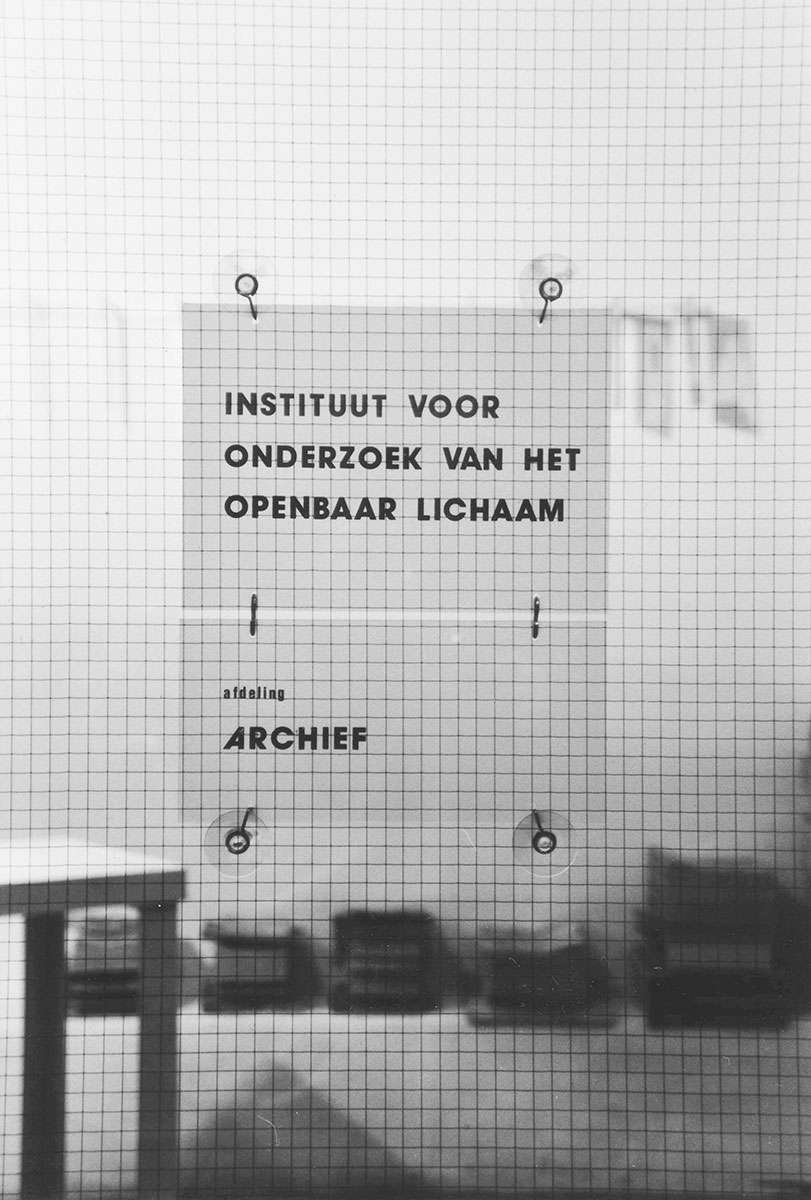 Outside at Cold Storage / advertising holder, paper, plastic, adhesive letters, wood, suction cups, plexiglas / various sizes / 1996
Outside at Cold Storage / advertising holder, paper, plastic, adhesive letters, wood, suction cups, plexiglas / various sizes / 1996
Cold Storage is an installation on location, solo exhibition, gallery Seedorf, Amsterdam
Outside, a sandwich board with a poster and a flag lead people to the entrance: a door with a sign for the Archive department of the Institute for Research of the Public Body.
In Cold Storage, the Institute presents the Archive department. Archive is its core department and the basis for many other activities and works.
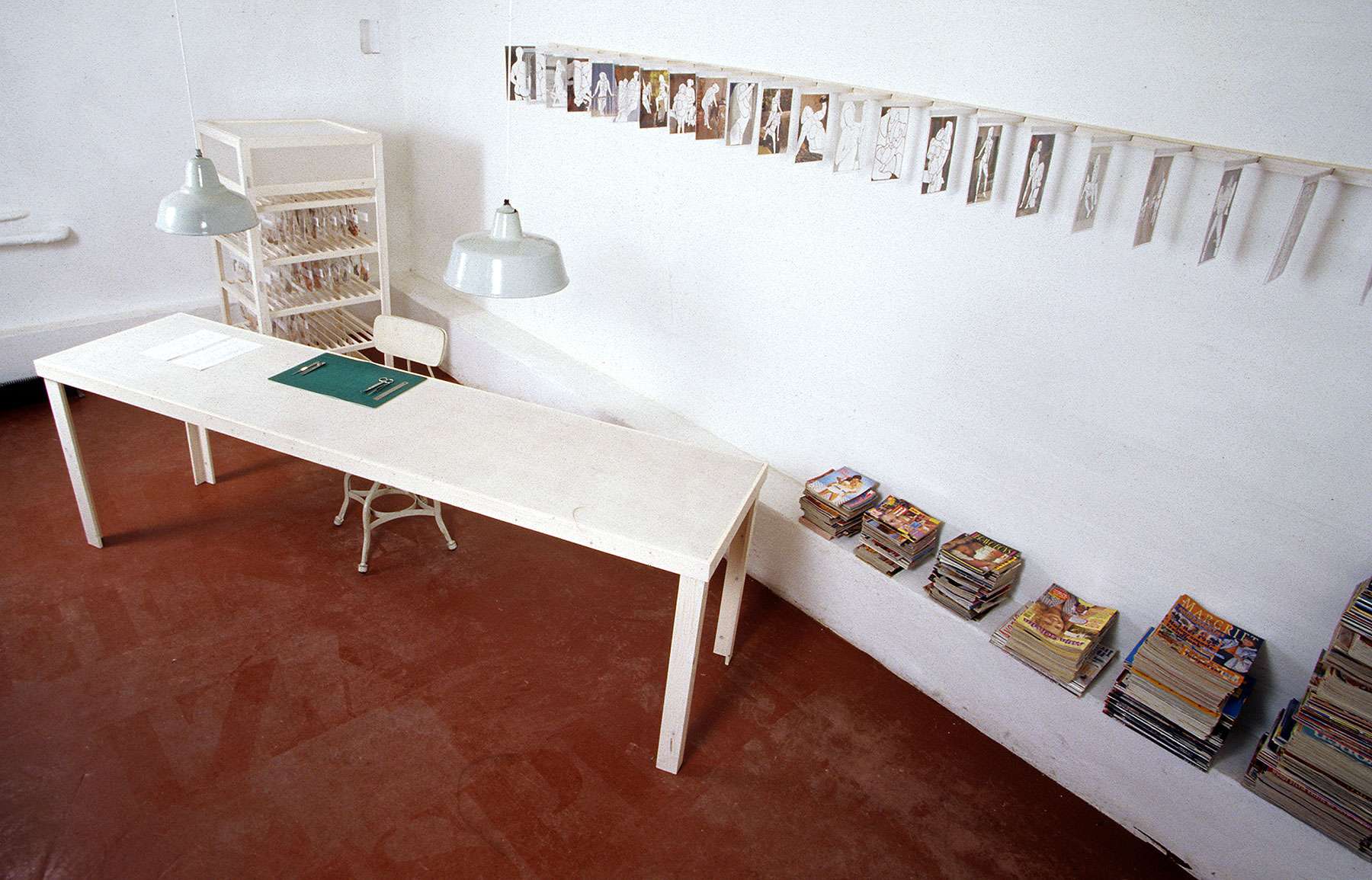 Overview inside of Cold Storage / table, cutting mat, instruments, chair, lamps, magazines, newspapers, paper, plastic, plexiglas, wood, rope / space of 300x400x250cm / 1996
Overview inside of Cold Storage / table, cutting mat, instruments, chair, lamps, magazines, newspapers, paper, plastic, plexiglas, wood, rope / space of 300x400x250cm / 1996
In an overview of the space we see in the middle, a table with cutting mat and cutting instruments. On the right piles of paper material await evaluation, at the back and left a cabinet with cut out parts in bags and on the wall the hung up remains of cut out pages. Not in view is a collection of cut out photos from radslag 1 and an overview of the organization of the Institute.
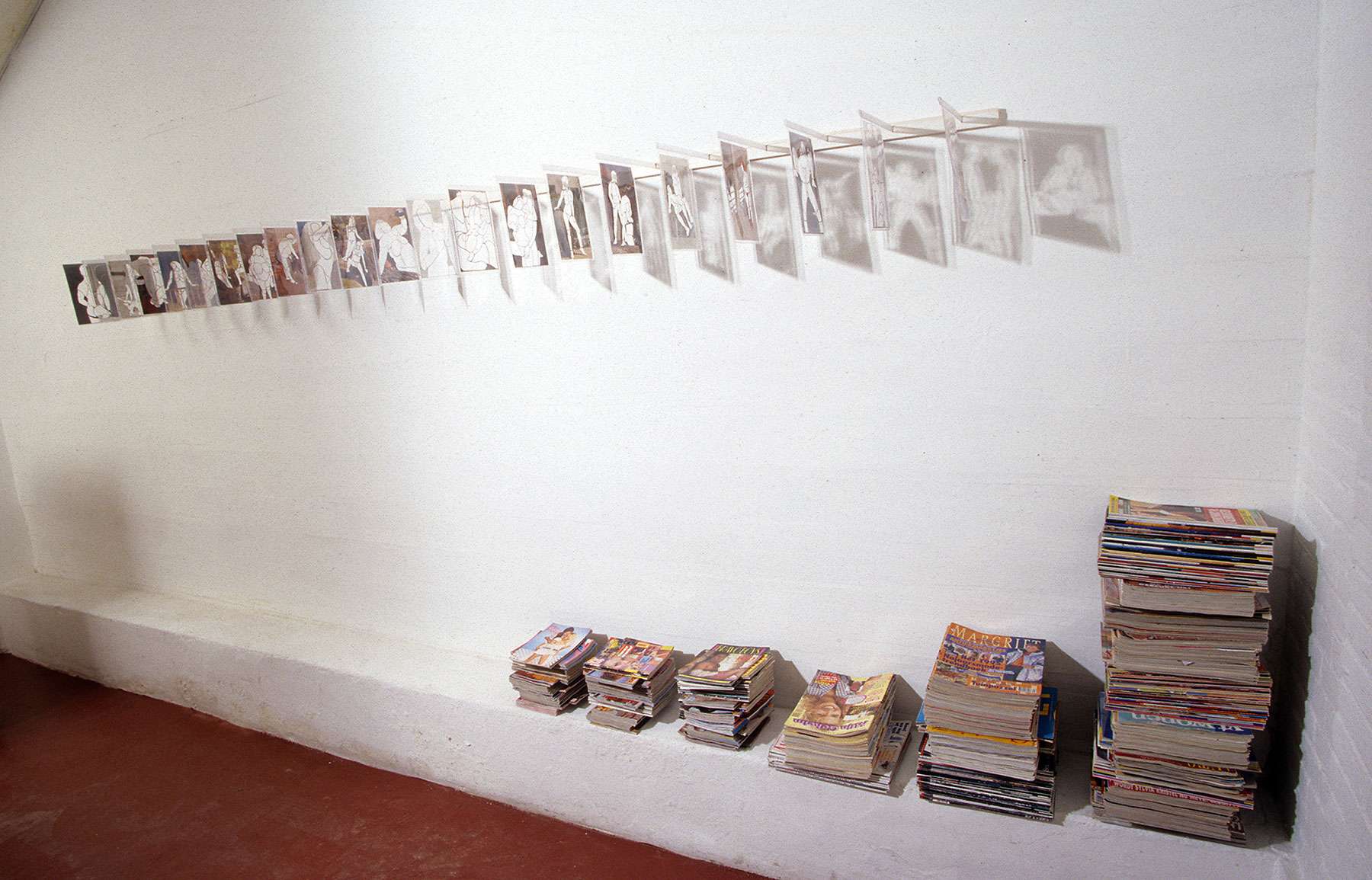 Basic material in Cold Storage / magazines, newspapers / various sizes / 1996
Basic material in Cold Storage / magazines, newspapers / various sizes / 1996
As basic material for Archive, often printed paper media, such as magazines and newspapers, are used. This material is assessed per page whether it is suitable to add to Archive and then possibly on suitability for use in other departments of the Institute
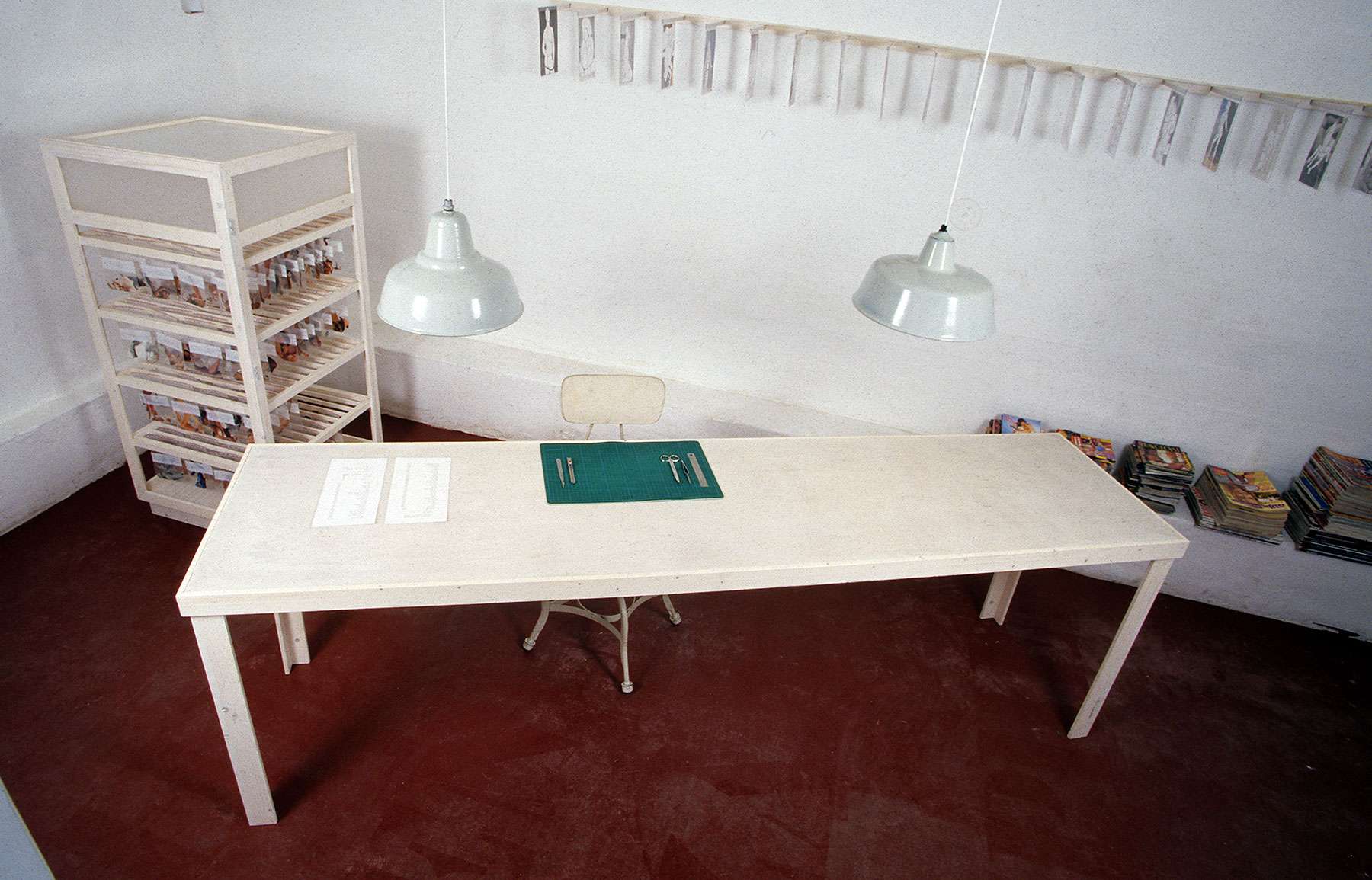
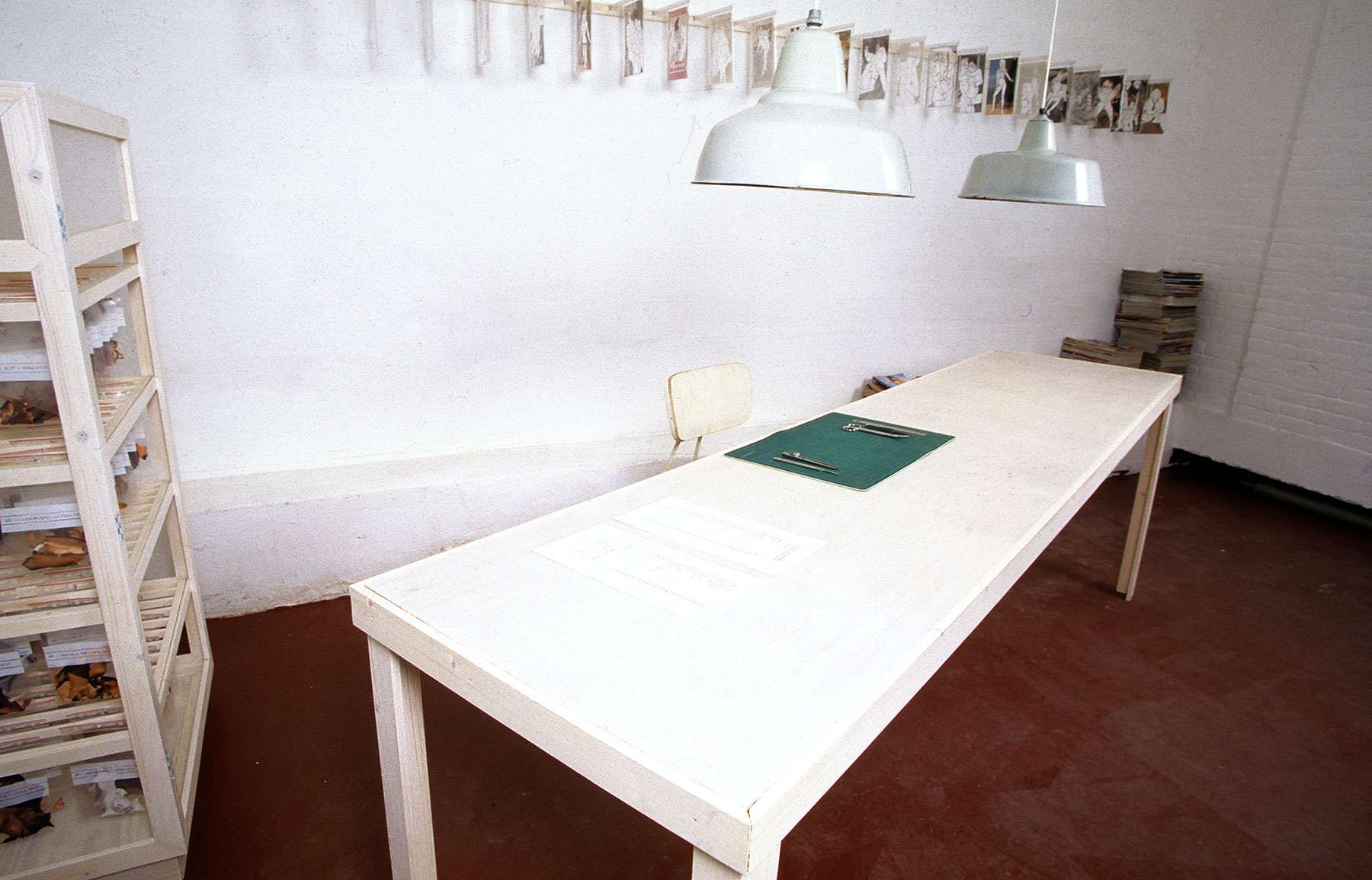 Cutting table in Cold Storage / table, cutting mat, cutting and measuring instruments, chair, lamps / various sizes / 1996
Cutting table in Cold Storage / table, cutting mat, cutting and measuring instruments, chair, lamps / various sizes / 1996
Each page is assessed for suitability for Archive. With a suitable image the page is removed and a cutting plan made of the image. The image is cut out and the cut-out parts (PPuB) are all given an archive and serial number.
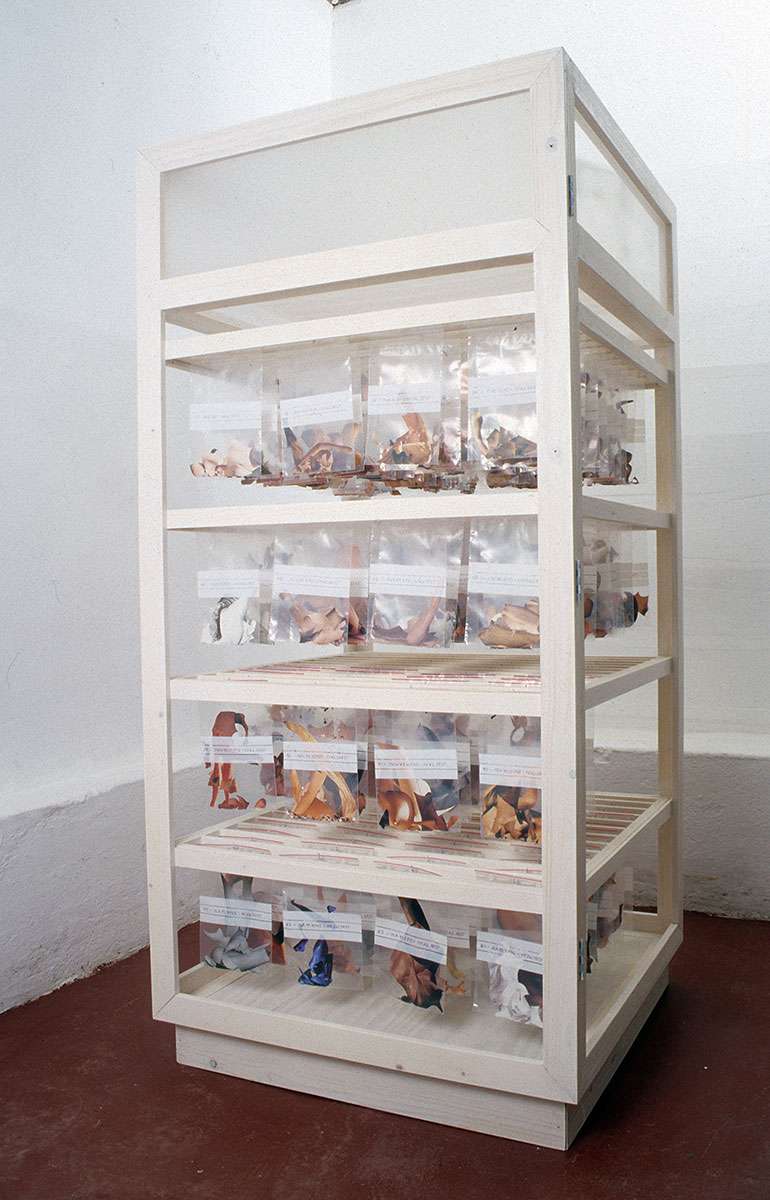
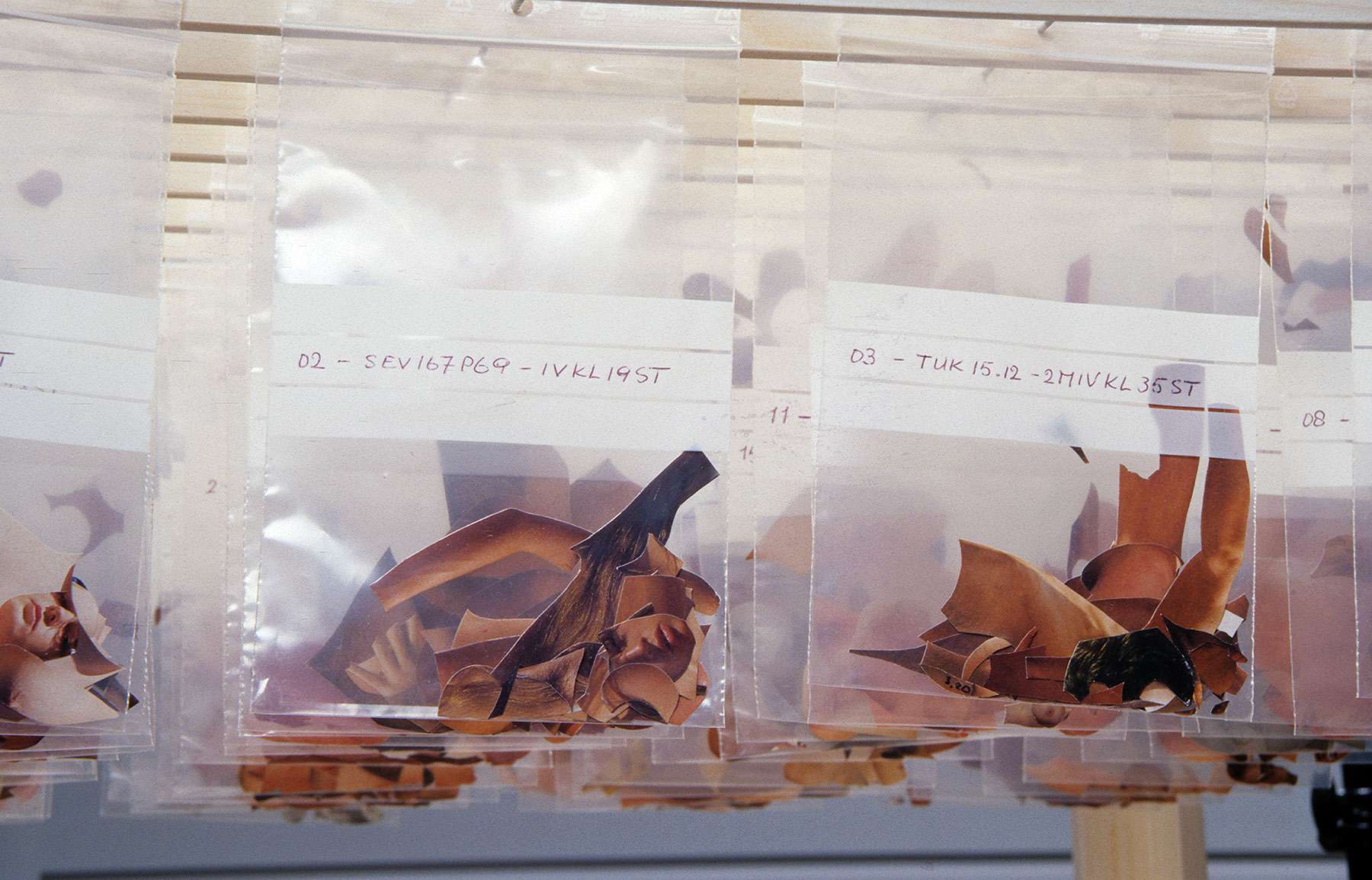 Filing cabinet in Cold Storage / plastic bags, paper, pen, wood, hooks, plexiglas, metal / 66x66x139cm / 1996
Filing cabinet in Cold Storage / plastic bags, paper, pen, wood, hooks, plexiglas, metal / 66x66x139cm / 1996
The cut our parts (PPuB) are saved in plastic bags on which the archive number and archive code are written. These bags are stored in a filing cabinet that evokes associations with a vertical fridge. This cabinet refers to the fridges in the project on location Think Thin.

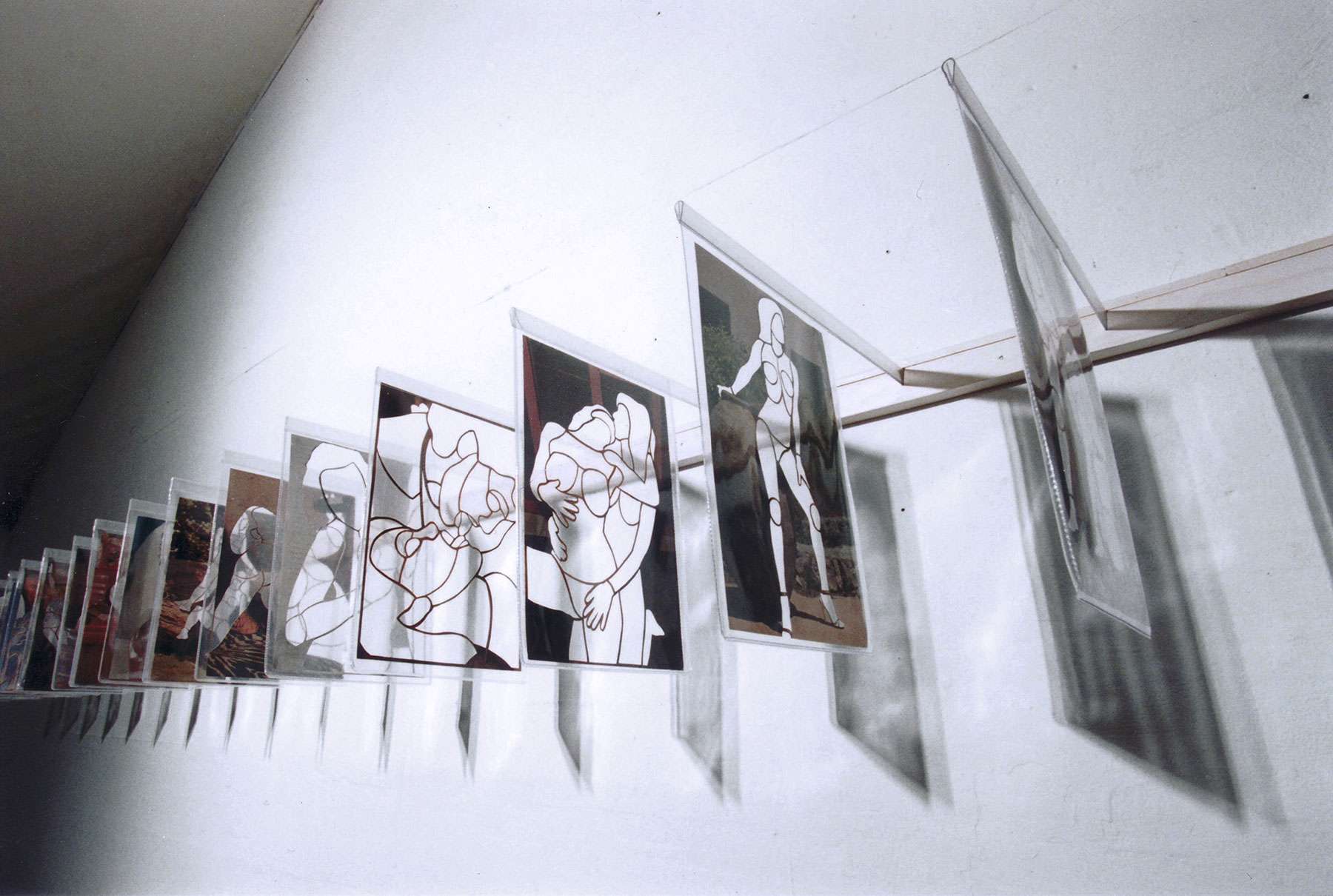
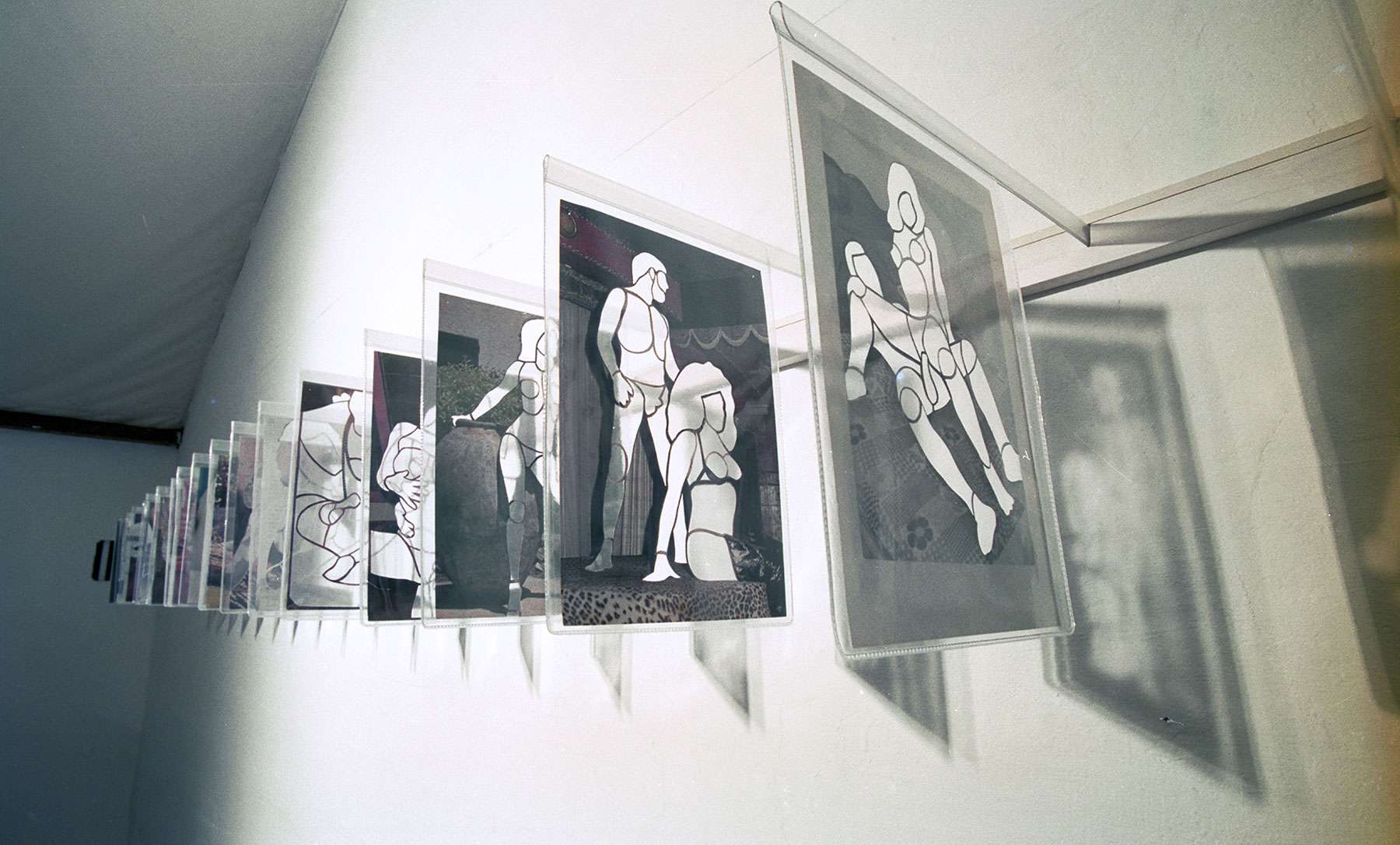
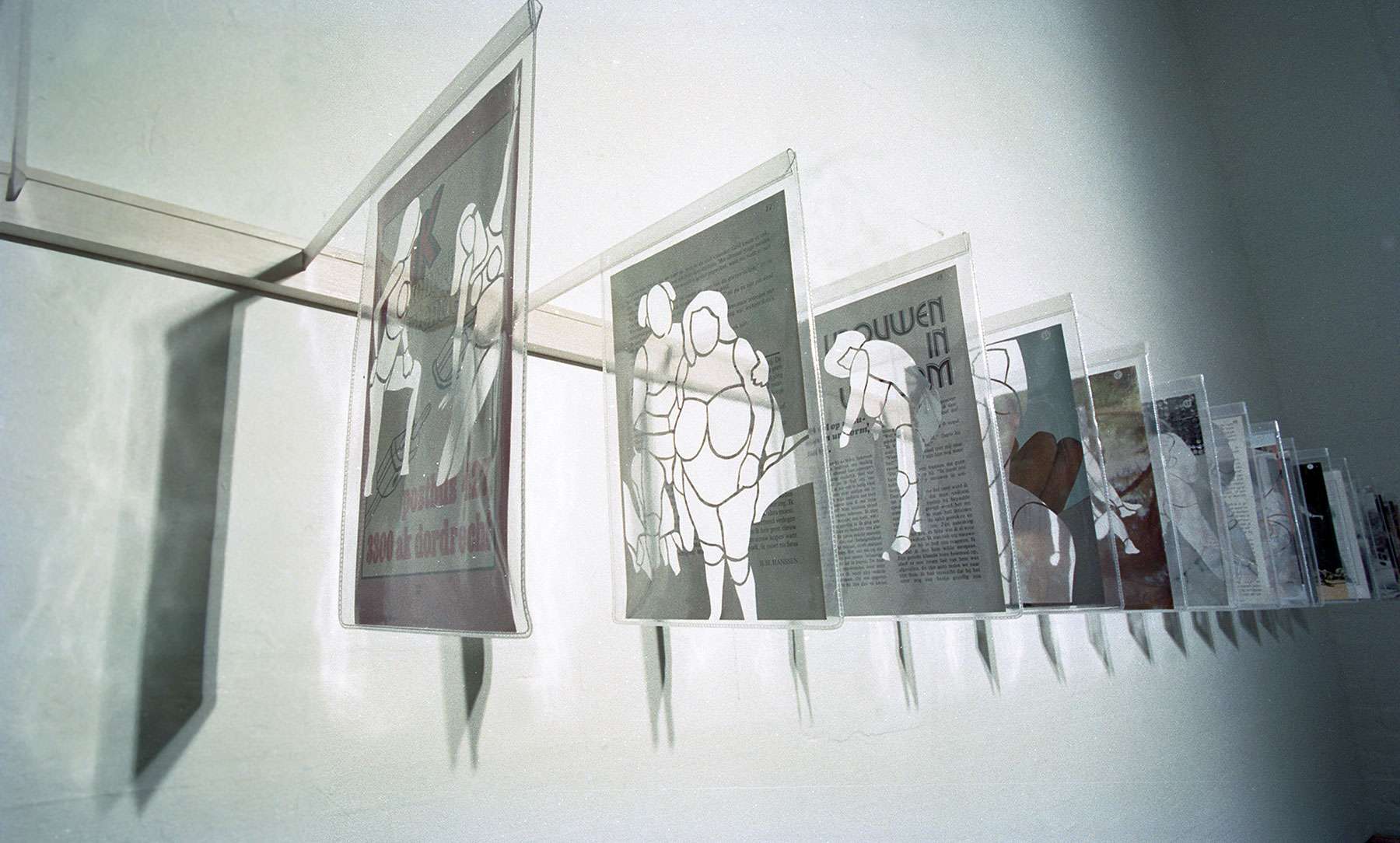
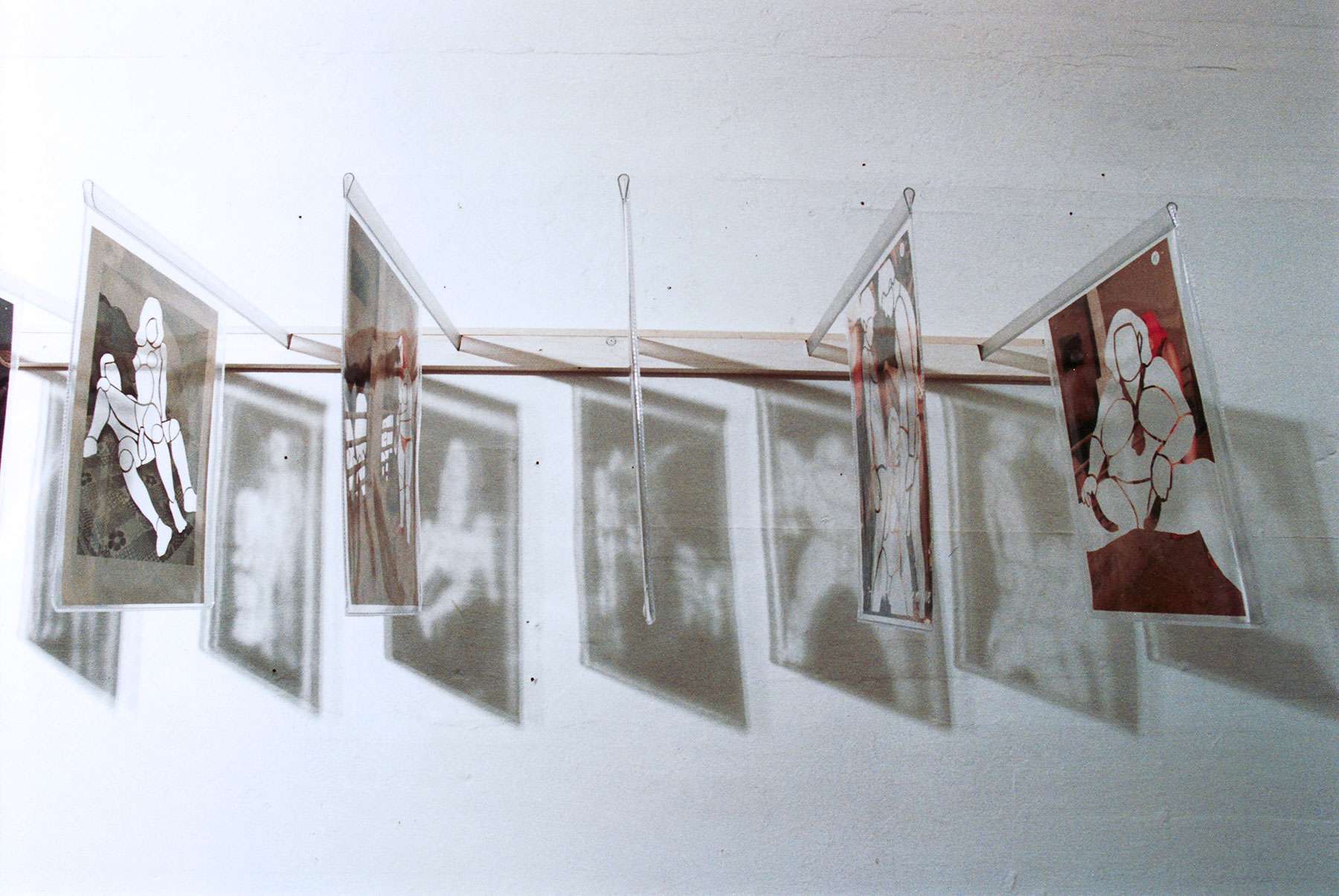 Rack with Remains in Cold Storage / plastic folders, plastic holders, paper, wood / various sizes / 1996
Rack with Remains in Cold Storage / plastic folders, plastic holders, paper, wood / various sizes / 1996
After cutting out the image, the Remains of the Public Body are left over. This is saved separately in plastic folders that are shown here on a rack on the wall. The remains show that the structure of the original image is still intact. On the other side of the page there are holes that have their own relationship with the images and/or text present there.
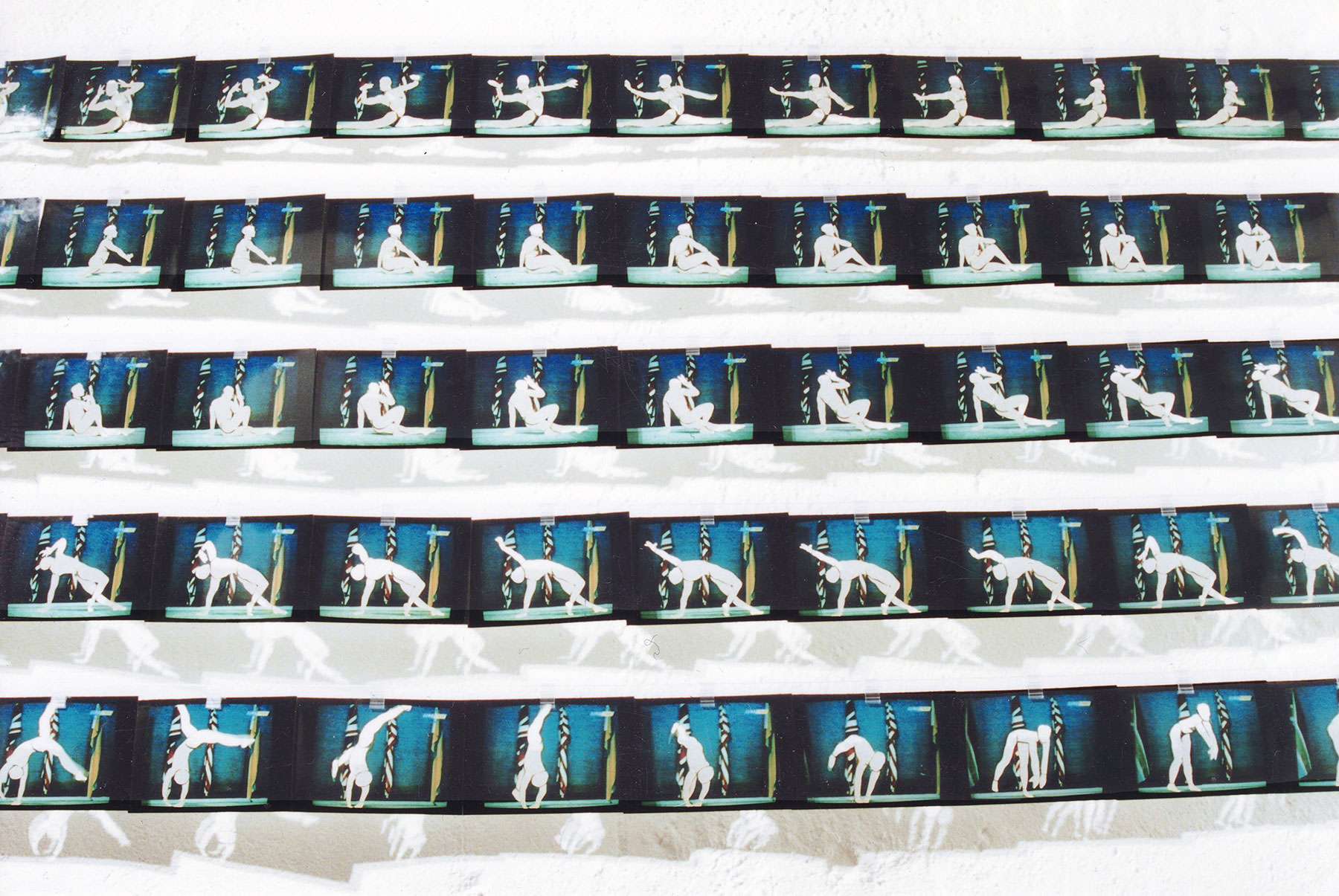 radslag 1 in Cold Storage / photo paper, rope, plastic clips / 165x80cm / 1996
radslag 1 in Cold Storage / photo paper, rope, plastic clips / 165x80cm / 1996
A derived work with a cut out procedure as used for Archive hangs on a separate wall. Photos have been made of a TV broadcast about female bodybuilders. This Digital Public Body is partly photographed and printed. The sequence of a cartwheel is then cut out. The RPuB hang on the wall here as radslag 1.
 Board with organization structure (N) IRPuB in Cold Storage / paper, plexiglas / size / 1996
Board with organization structure (N) IRPuB in Cold Storage / paper, plexiglas / size / 1996
An illustration of the organization structure of the Institute for Research of the Public Body hangs next to the entrance.
The installation Cold Storage is a solo exhibition in gallery Seedorf in Amsterdam.
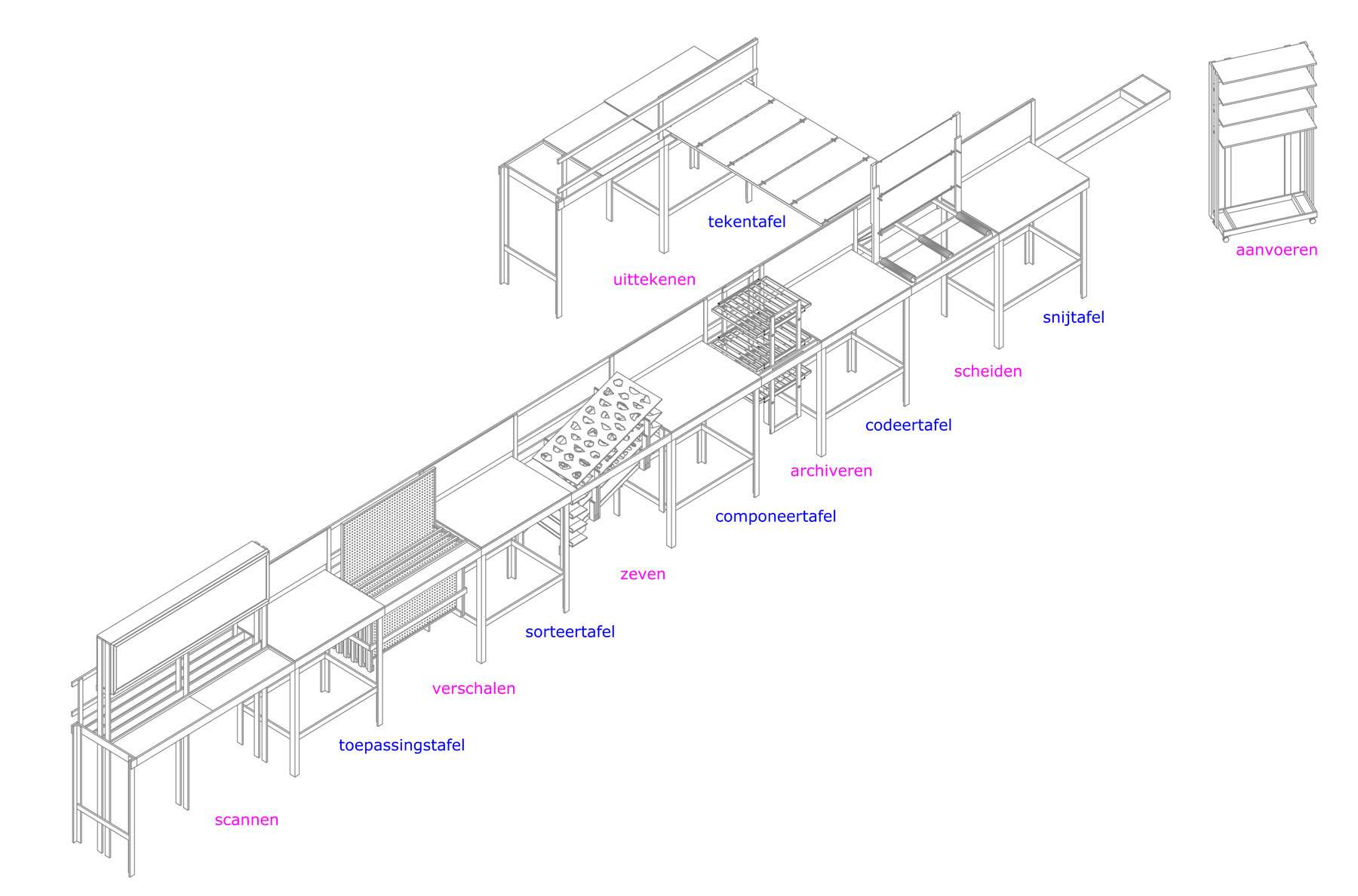 Setup of PUIRPuB 1, Processing Unit of the Institute for Research of the Public Body / 1999
Setup of PUIRPuB 1, Processing Unit of the Institute for Research of the Public Body / 1999
PUIRPuB 1 is an installation on location, group exhibition, gallery Retort, Amsterdam
With PUIRPuB 1 the Institute presents itself with its departments Archive and Development. The title stands for Processing Unit of the Institute for Research of the Public Body. Archive staff in particular, carry out many tasks where repetitive systematic handling is required. Internally, this is also known as ‘the production line’.
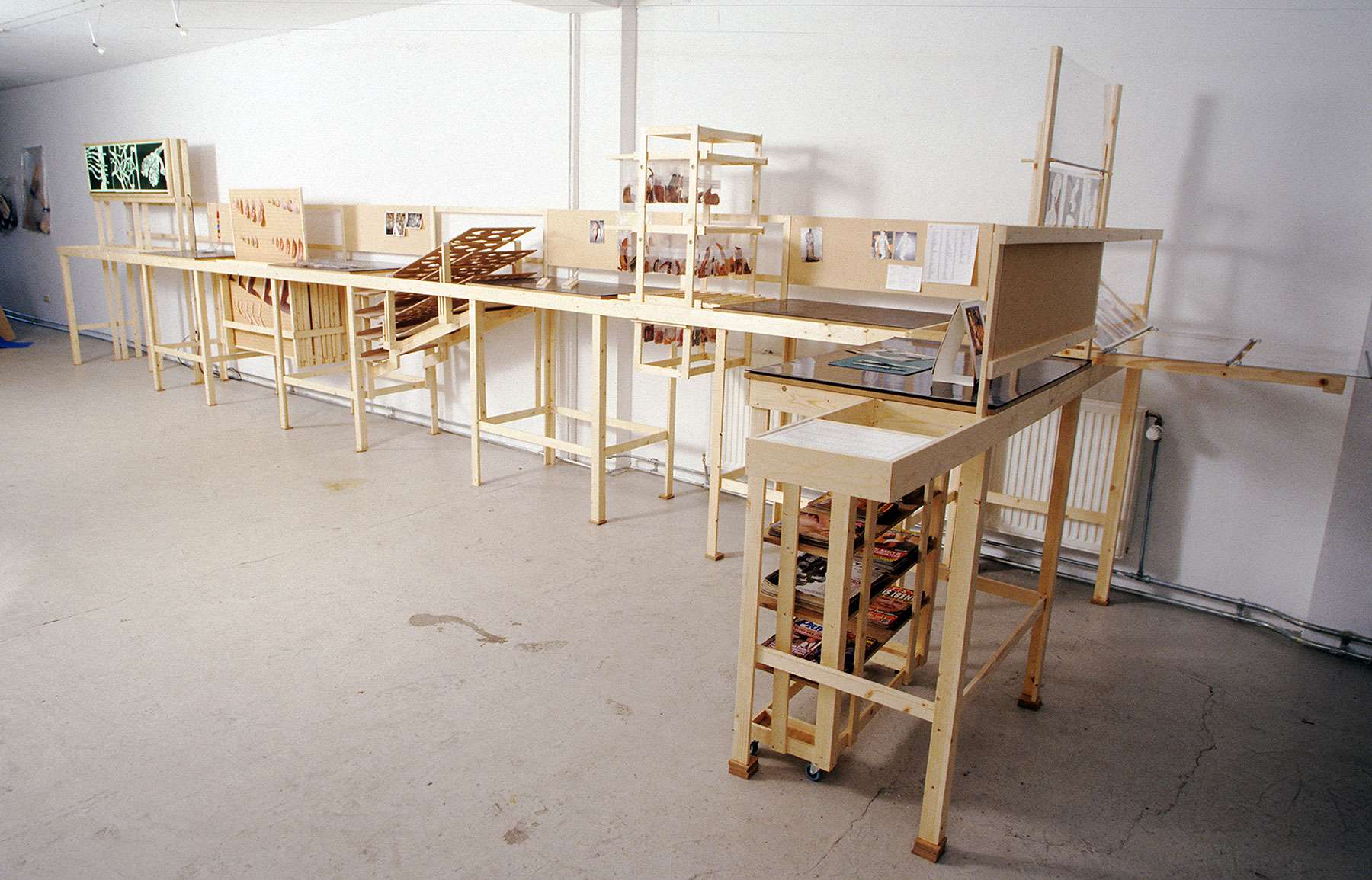
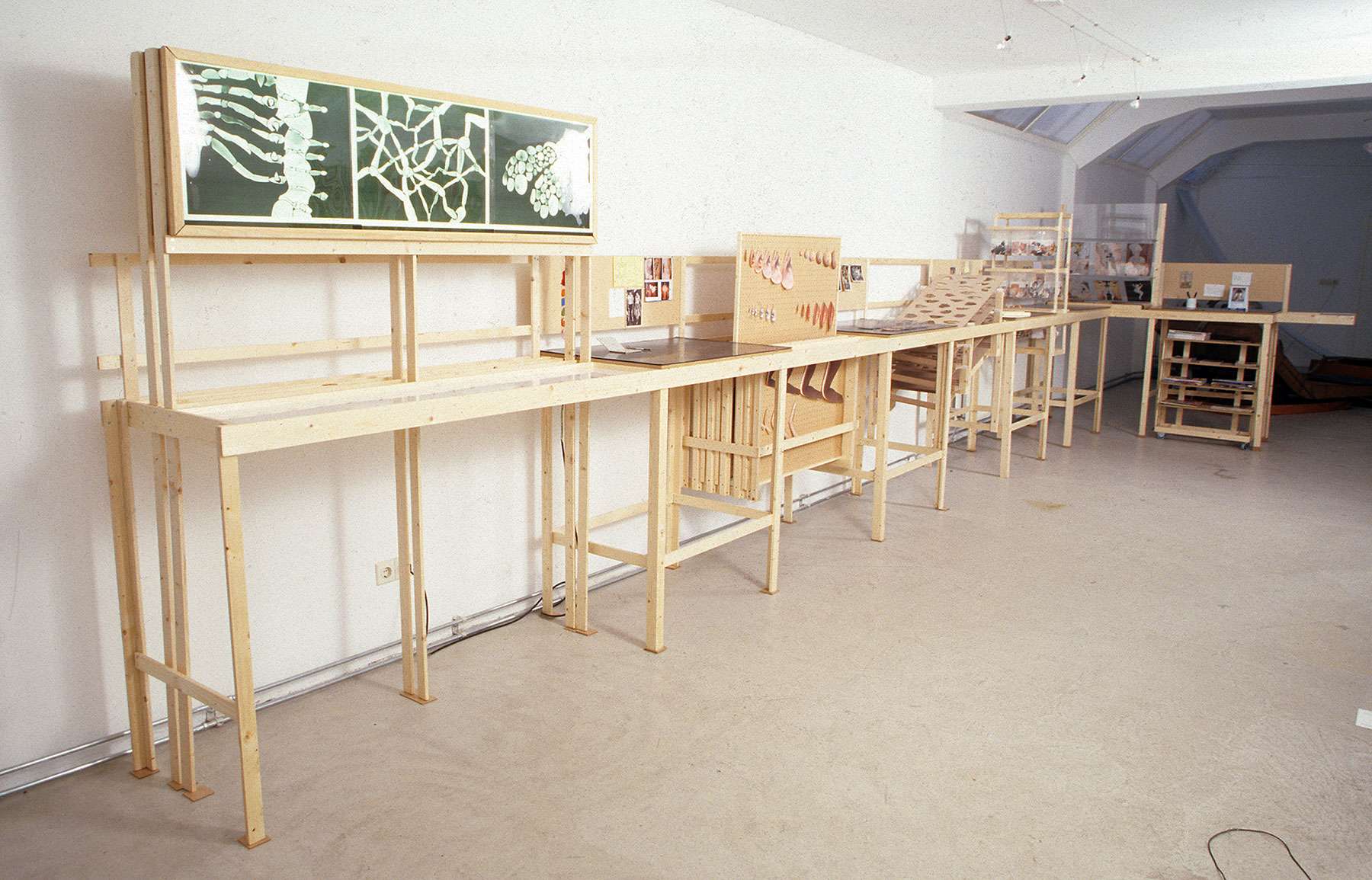 Overview of PUIRPuB 1, Processing Unit of the (N)IRPuB / various materials / 1100x300x190cm / 1999
Overview of PUIRPuB 1, Processing Unit of the (N)IRPuB / various materials / 1100x300x190cm / 1999
The Processing Unit consists of a wooden oblong construction with various components in it. It is like a kind of production line with Archive and Development activities and workplaces.
The actions and activities in the Institute – the lines – are presented as wooden constructions. These are alternated with tables with a rubber top – the places – that represent the places where staff develop their activities. The places are indicated with ‘tables’, the activities as ‘verbs’ and with ‘units’.

 Collecting and Cutting table in PUIRPuB 1 / various materials / 1100x300x190cm / 1999
Collecting and Cutting table in PUIRPuB 1 / various materials / 1100x300x190cm / 1999
Collecting = gathering images from newspapers and magazines or other media (under the table)
Cutting table = images are evaluated and cut out

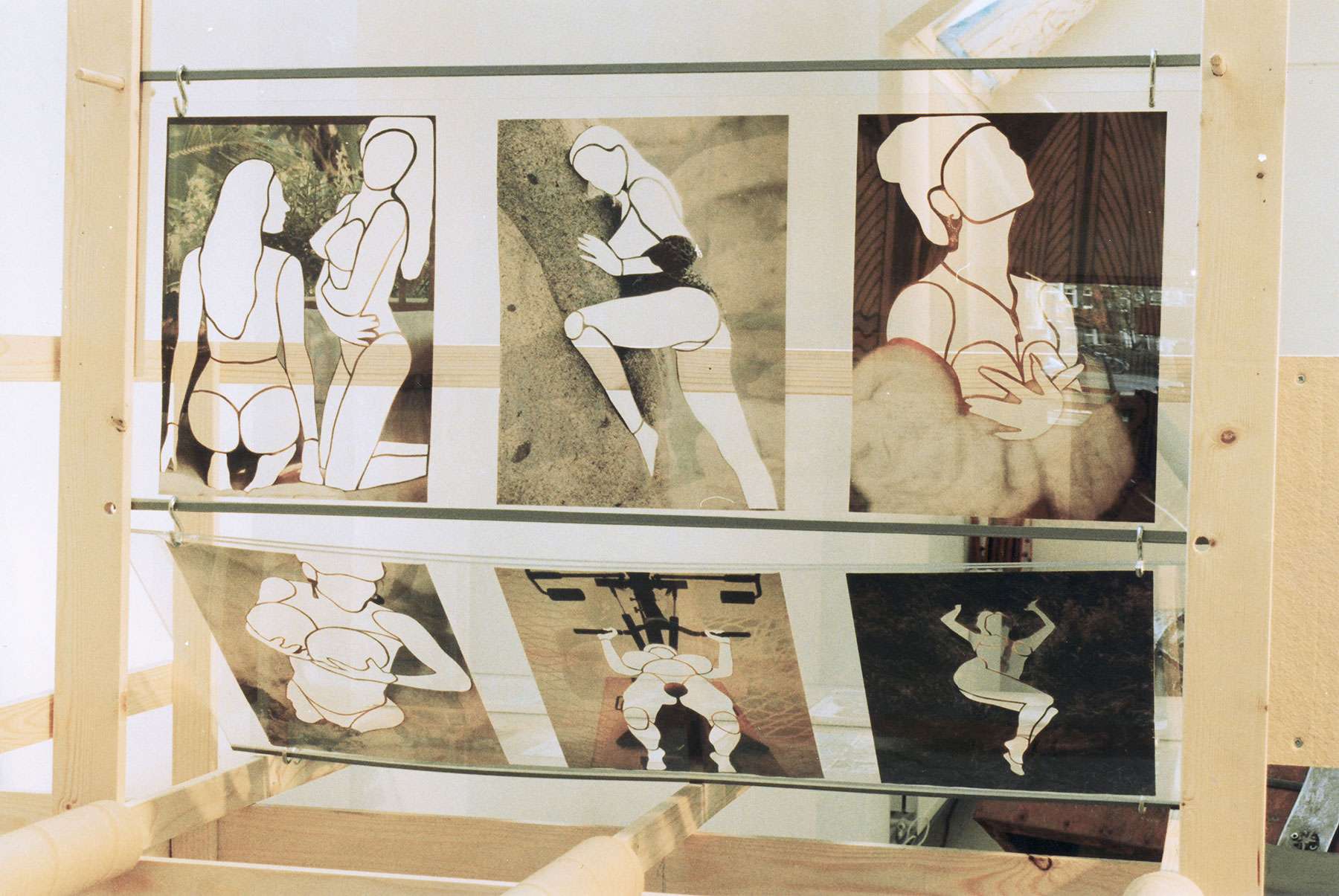
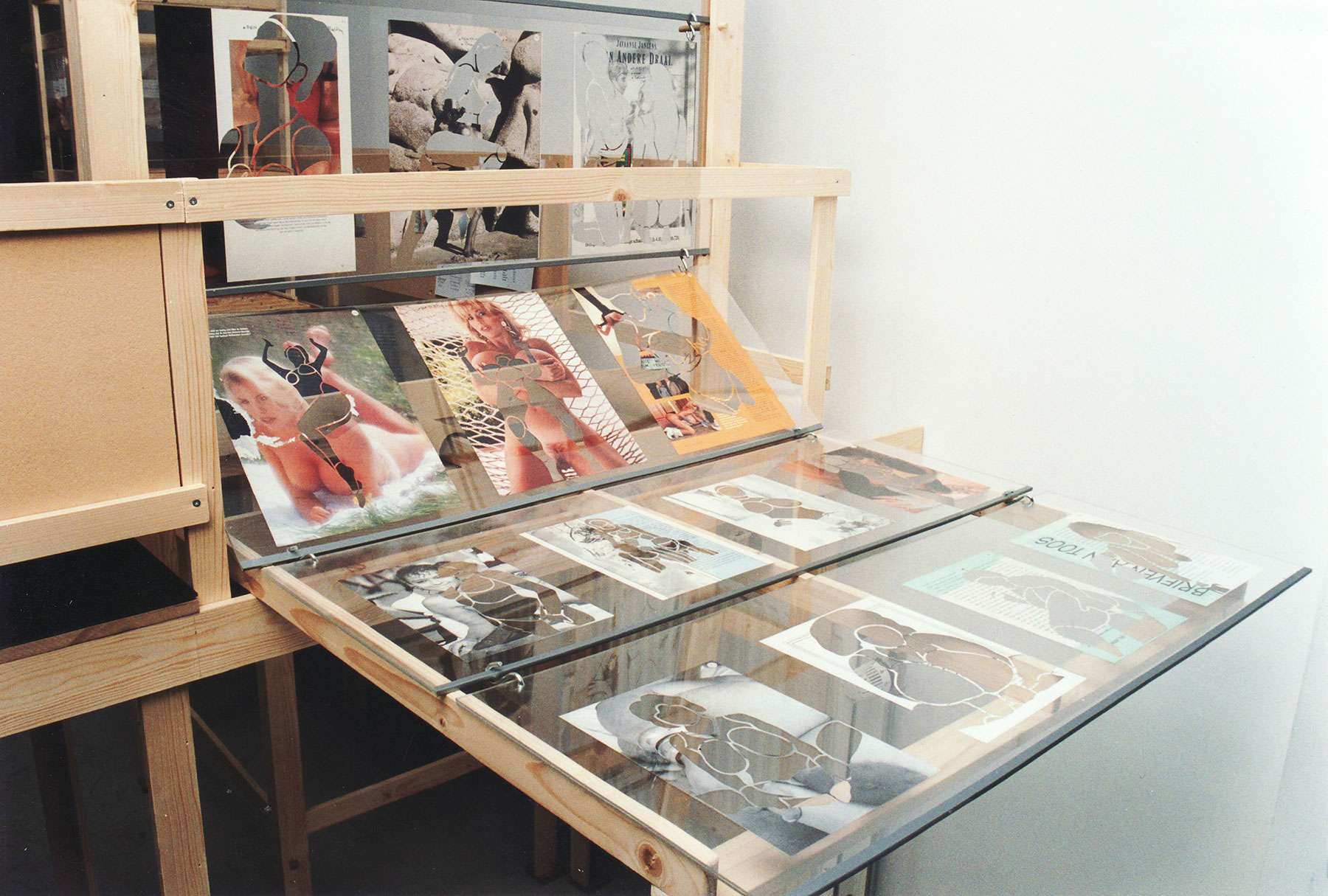 Separating and Cutting table in PUIRPuB 1 / various materials / 1100x300x190cm / 1999
Separating and Cutting table in PUIRPuB 1 / various materials / 1100x300x190cm / 1999
Cutting table = images are assessed and cut out
Separating = guiding the remains of the image (RPuB) to follow-up activity (not present here)
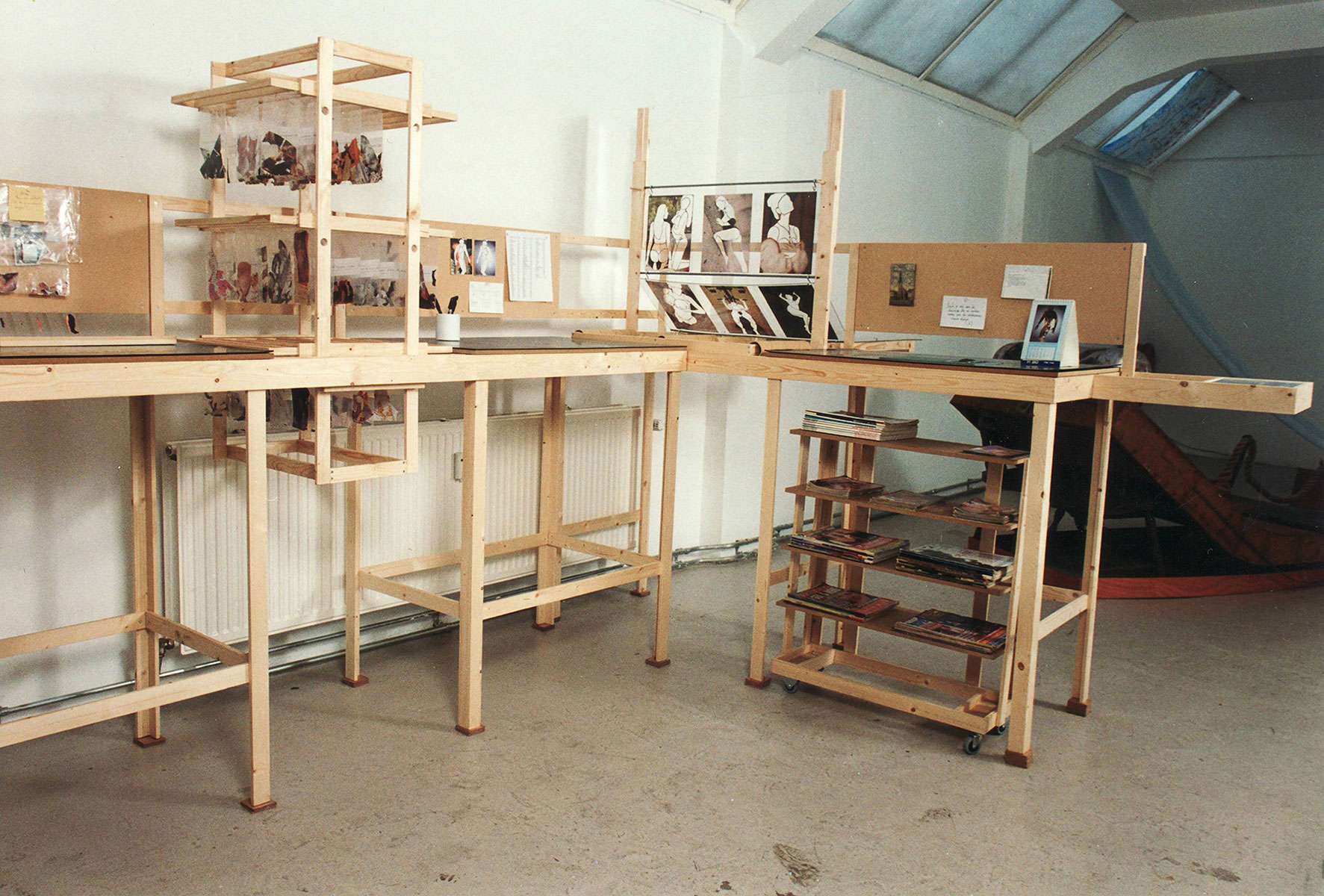 Collecting, Separating, Archiving and Cutting table, Coding table in PUIRPuB 1 / various materials / 1100x300x190cm / 1999
Collecting, Separating, Archiving and Cutting table, Coding table in PUIRPuB 1 / various materials / 1100x300x190cm / 1999
Collecting = gathering images from newspapers and magazines or other media (under the table)
Cutting table = images are assessed and cut out
Separating = guiding the remains of the image (RPuB) to follow-up activity (not present here)
Coding table = parts of the image (PPuB) are numbered and coded
Archiving = storing the parts of the image (PPuB)

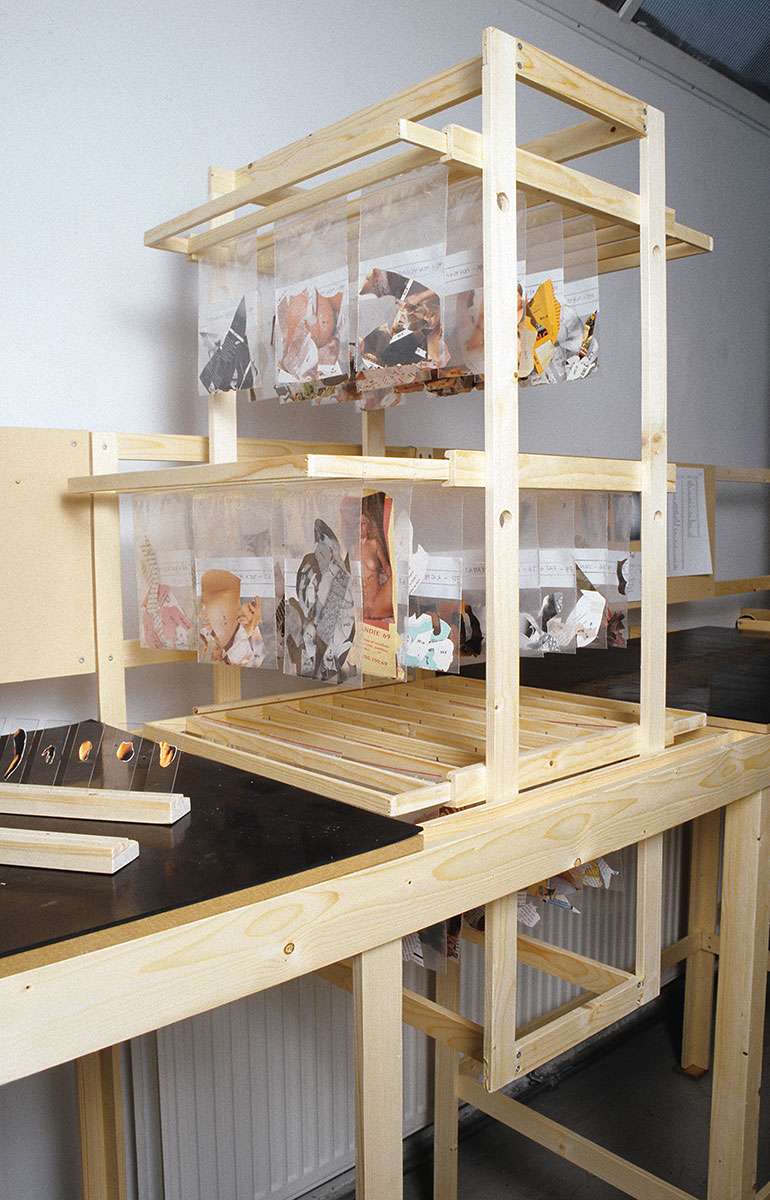
 Separating, Archiving and Coding table, Composition table in PUIRPuB 1 / various materials / 1100x300x190cm / 1999
Separating, Archiving and Coding table, Composition table in PUIRPuB 1 / various materials / 1100x300x190cm / 1999
Separating = guiding the remains of the image (RPuB) to follow-up activity (not present here)
Coding table = parts of the image (PPuB) are numbered and coded
Archiving = storing the parts of the image (PPuB)
Composition table = parts from the archive bags are re-used for new compositions
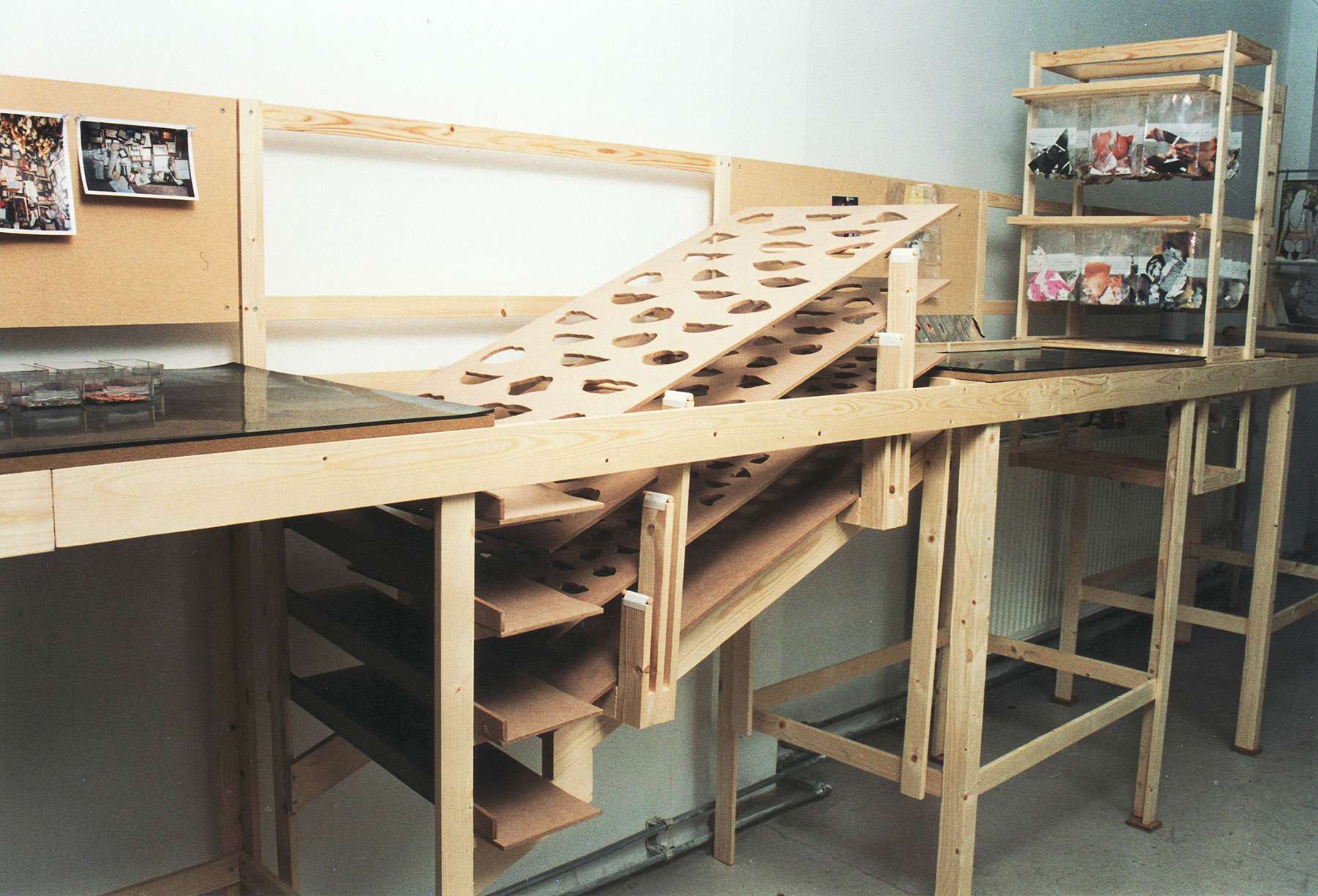
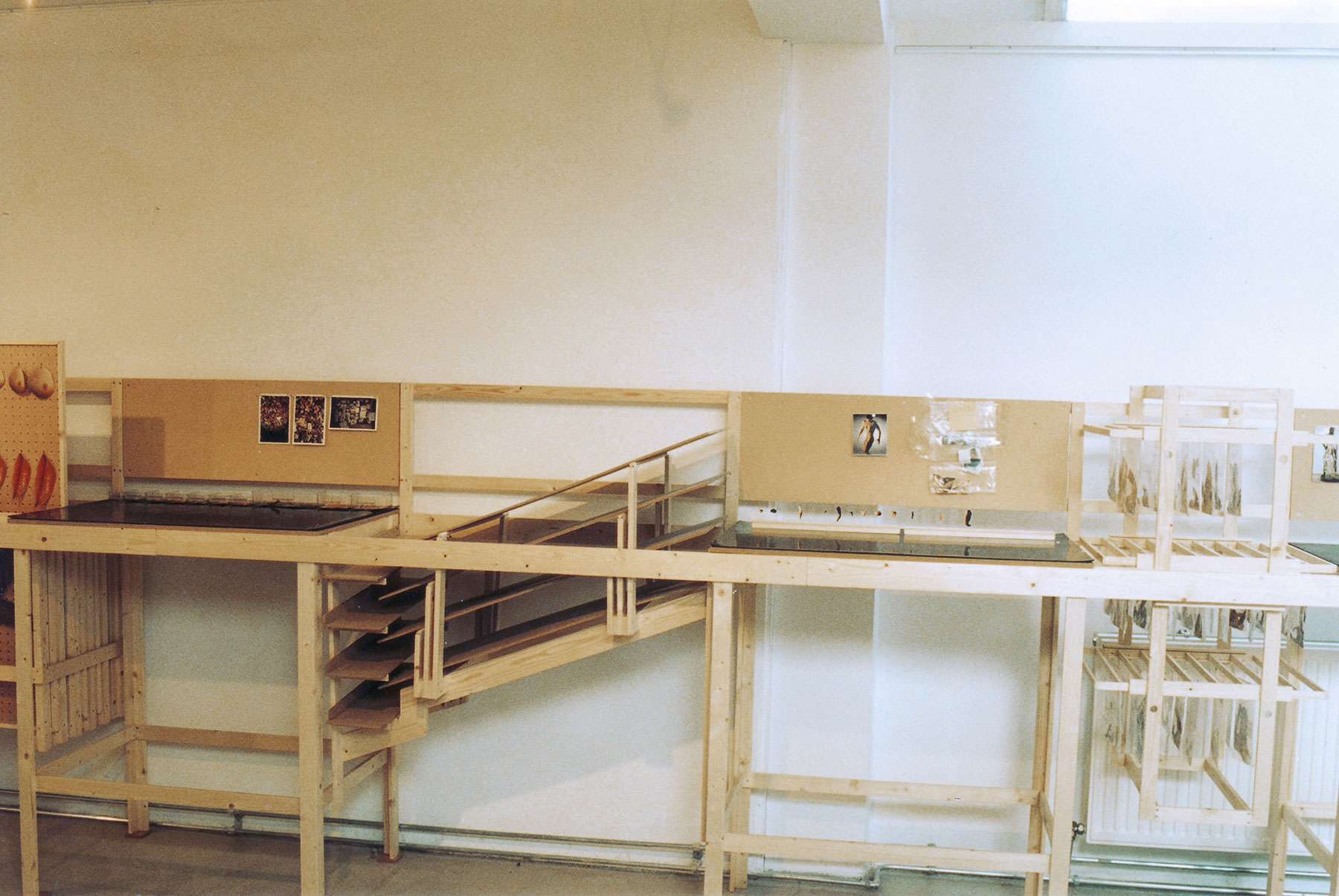
 Archiving, Sifting and Composition table, Sorting table in PUIRPuB 1 / various materials / 1100x300x190cm / 1999
Archiving, Sifting and Composition table, Sorting table in PUIRPuB 1 / various materials / 1100x300x190cm / 1999
Archiving = storing the parts of the image (PPuB)
Composition table = parts from the archive bags are re-used for new compositions
Sifting = sifting out the parts by sort and size
Sorting table = parts from the archive bags are grouped per type of image
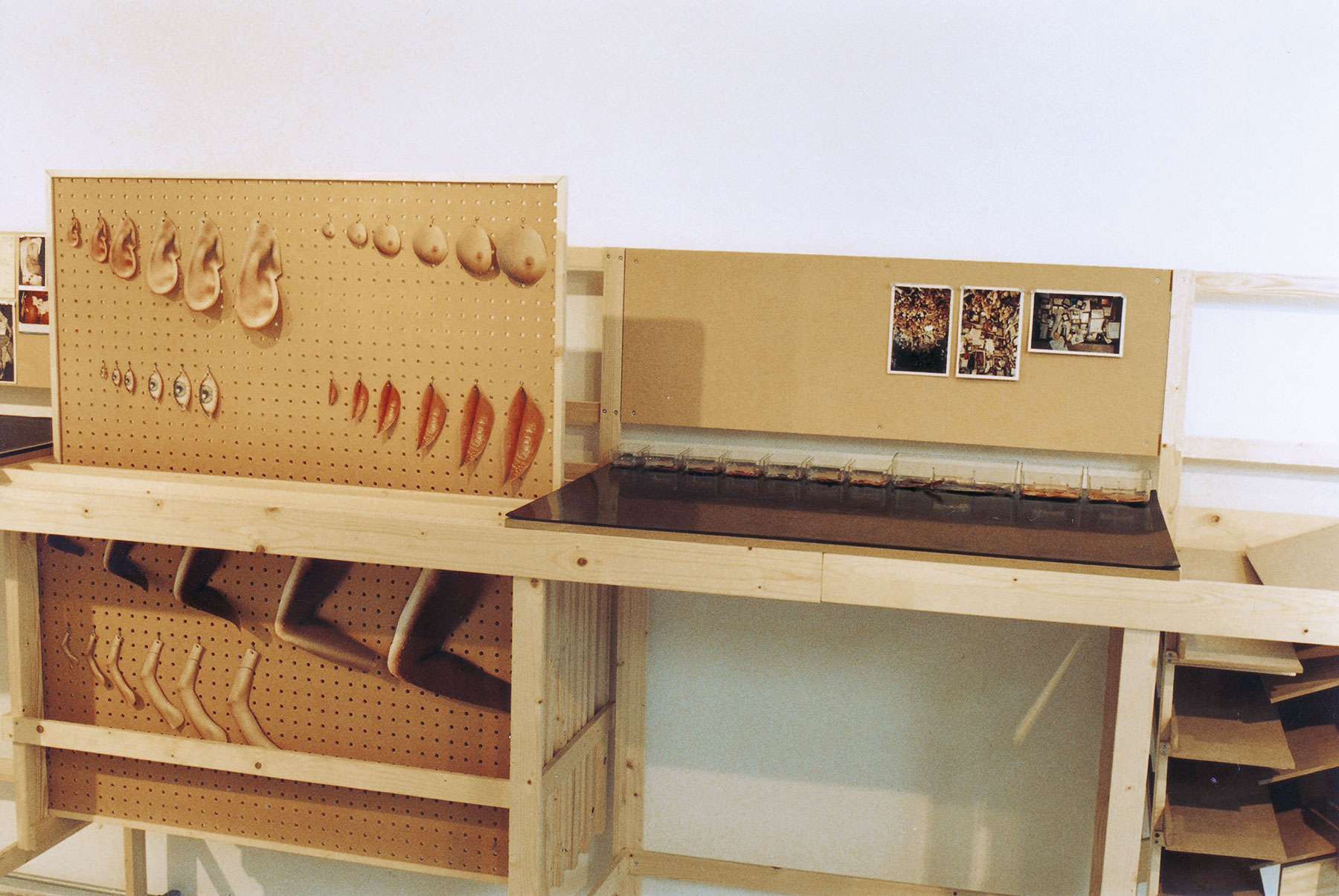
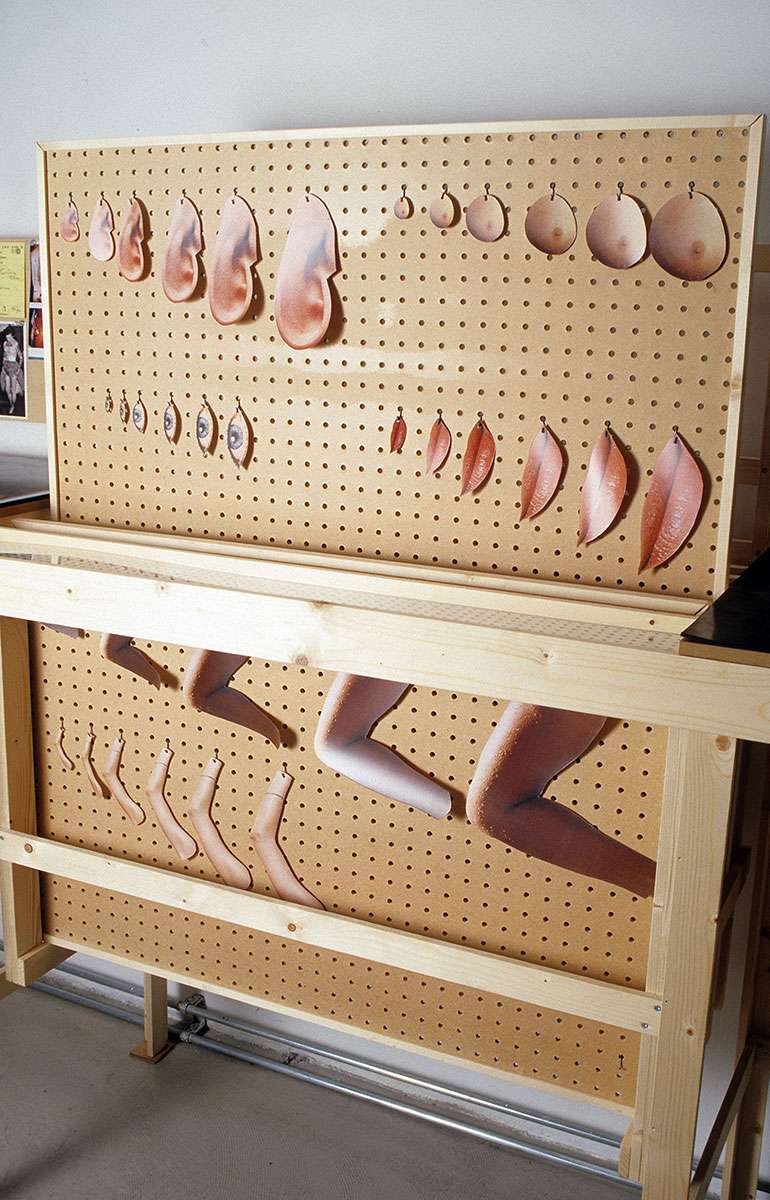
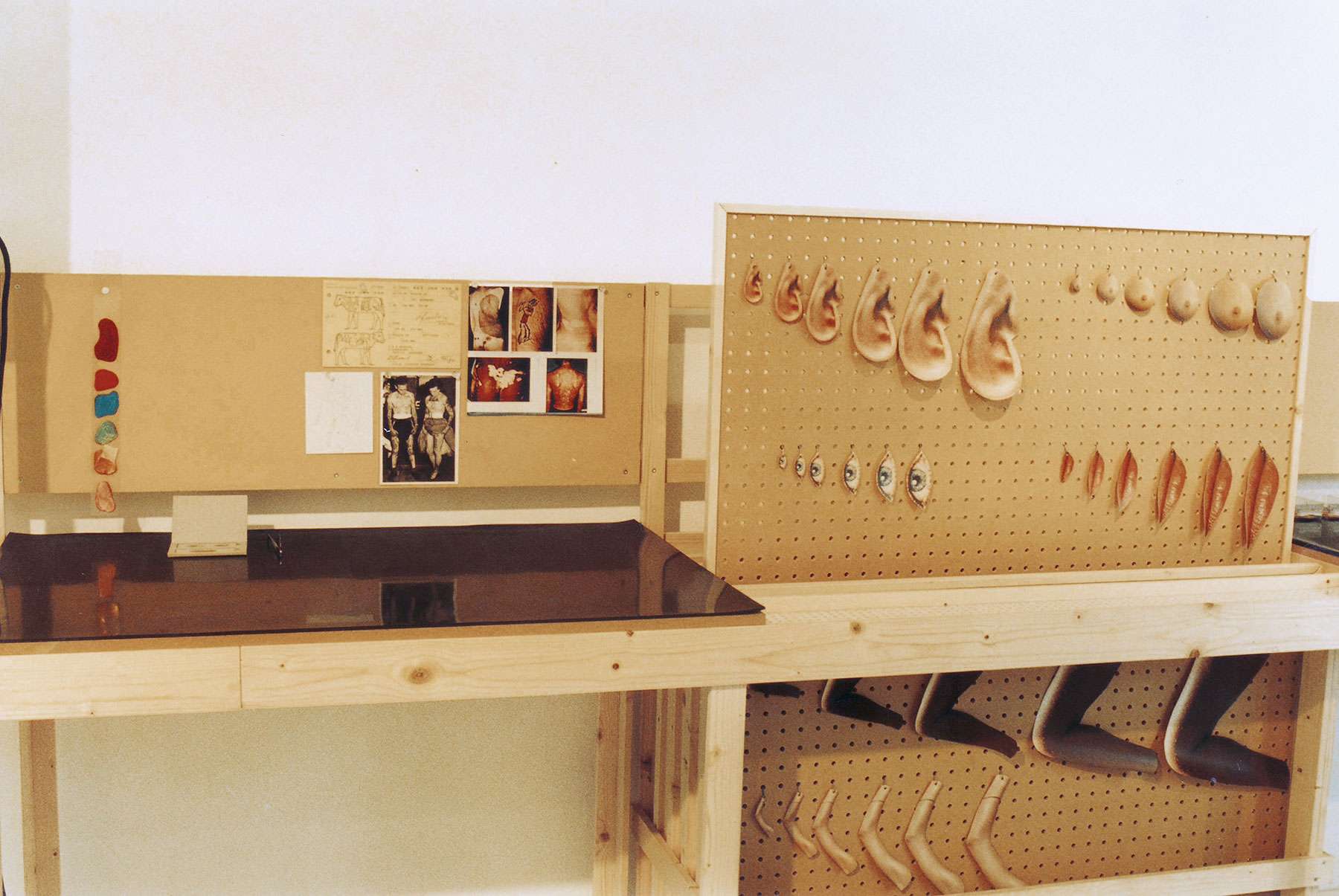 Scaling and Sorting table, Application table in PUIRPuB 1 / various materials / 1100x300x190cm / 1999
Scaling and Sorting table, Application table in PUIRPuB 1 / various materials / 1100x300x190cm / 1999
Sorting table = parts from the archive bags are grouped per type of image
Scaling = enlarging existing images and parts
Application table = re-use adapted parts in a broader, free sense
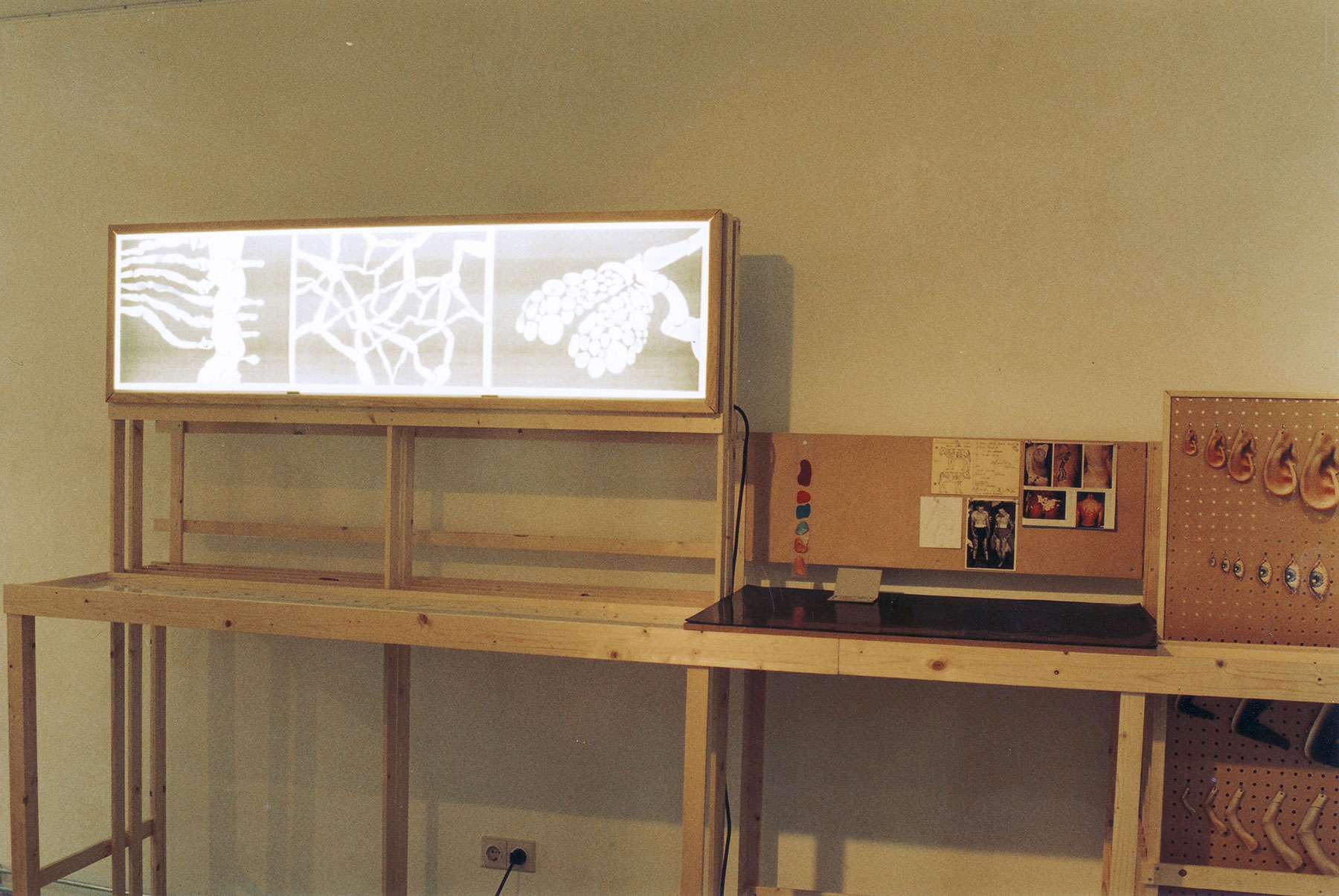

 Scaling and Application table in PUIRPuB 1 / various materials / 1100x300x190cm / 1999
Scaling and Application table in PUIRPuB 1 / various materials / 1100x300x190cm / 1999
Application table = re-use adapted parts in a broader, free sense
Scanning = screening of the large Public Body, here the inside
Above table level, the oblong wooden construction has several connecting wooden railings with a bulletin board at the place of the tables. The staff member at each table has pinned his or her own personal scribbles on it.
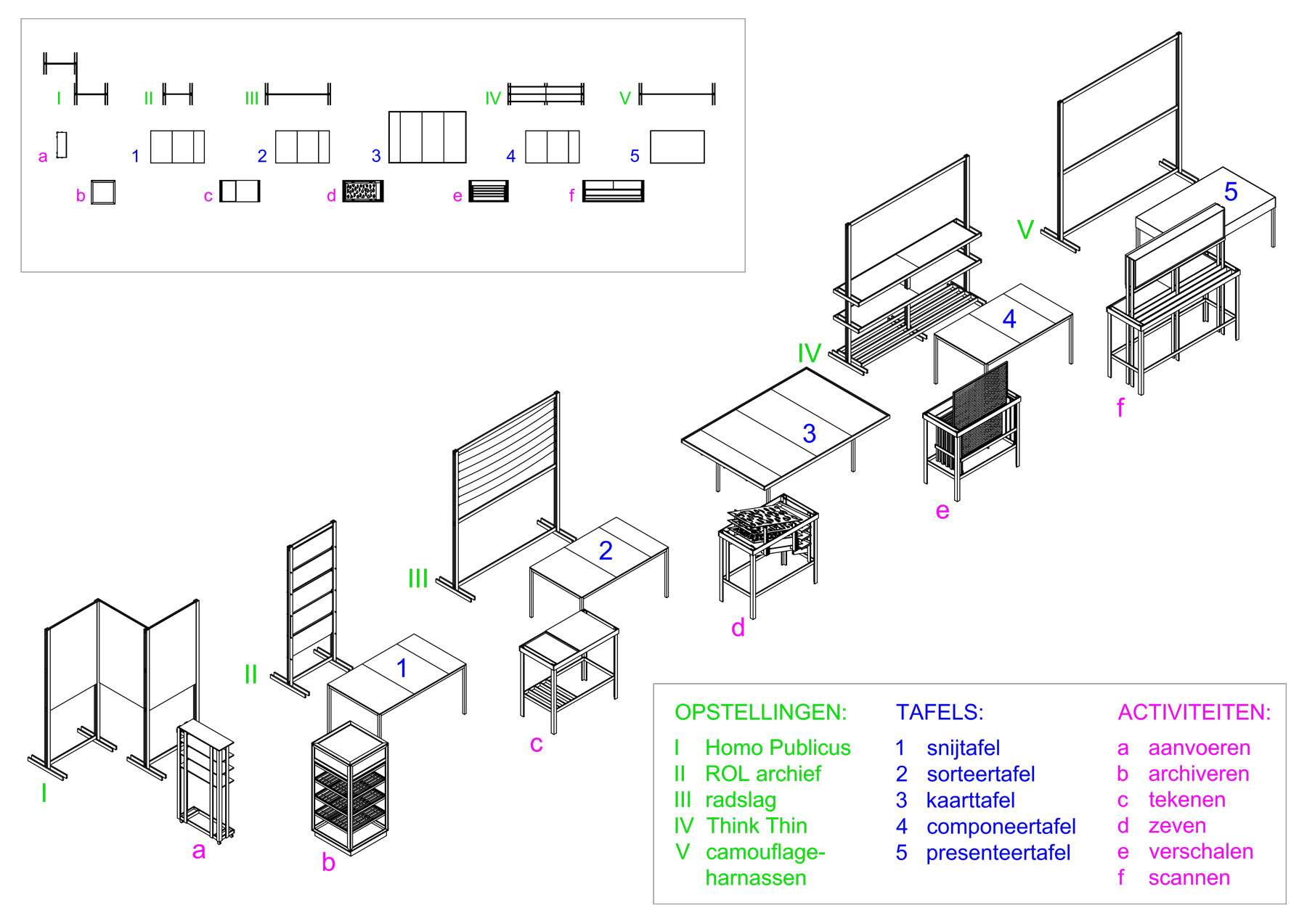 Setup of PUIRPuB 2 – Processing Unit of the Institute for Research of the Public Body / 2000
Setup of PUIRPuB 2 – Processing Unit of the Institute for Research of the Public Body / 2000
PUIRPuB 2 is an installation on location, duo exhibition with Pietsjanke Fokkema, artist’s initiative Nieuwe Vide, Haarlem
With PUIRPuB 2 the Institute presents itself again with its Archive and Development departments. The title stands for Processing Unit Institute for Research of the Public Body. It is an extended variation of PUIRPuB 1. The repetitive and systematic handling of the Archive are supplemented with more detailed results from Development. .
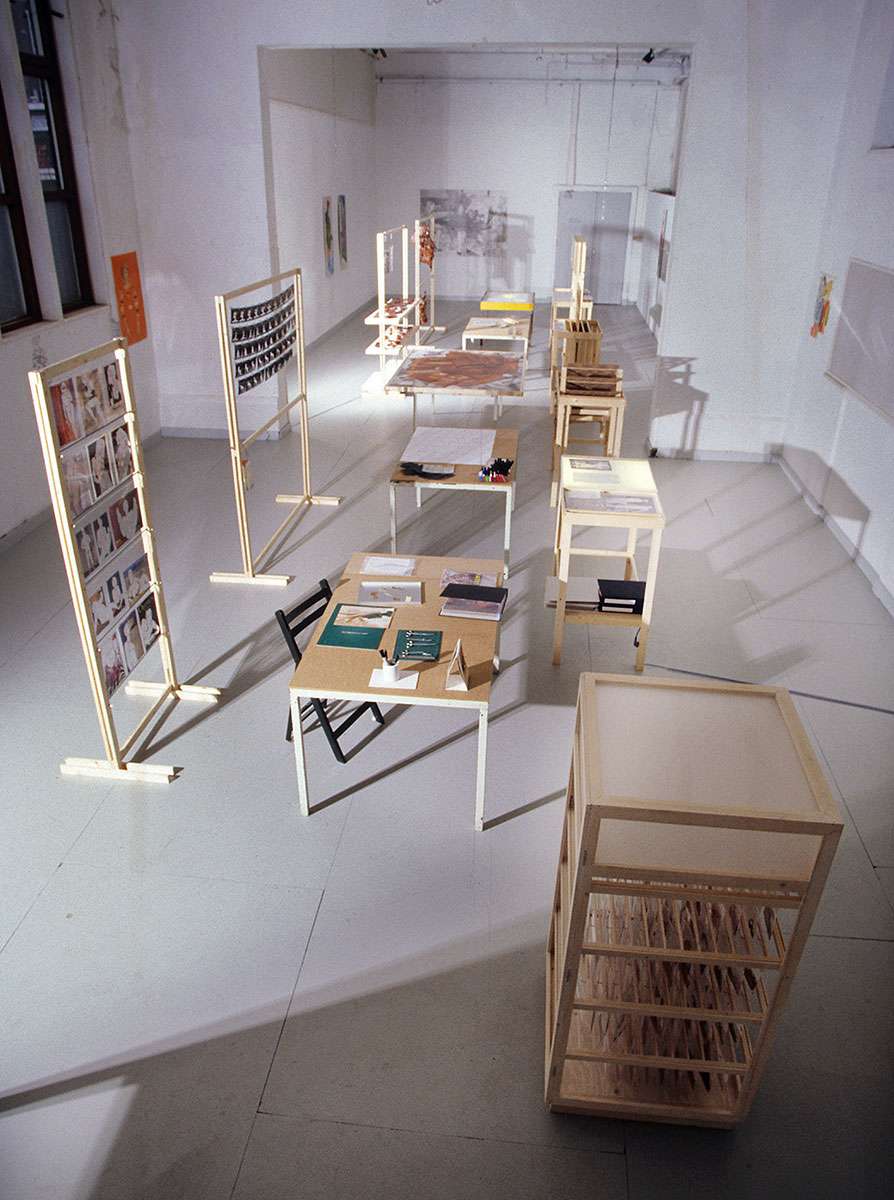
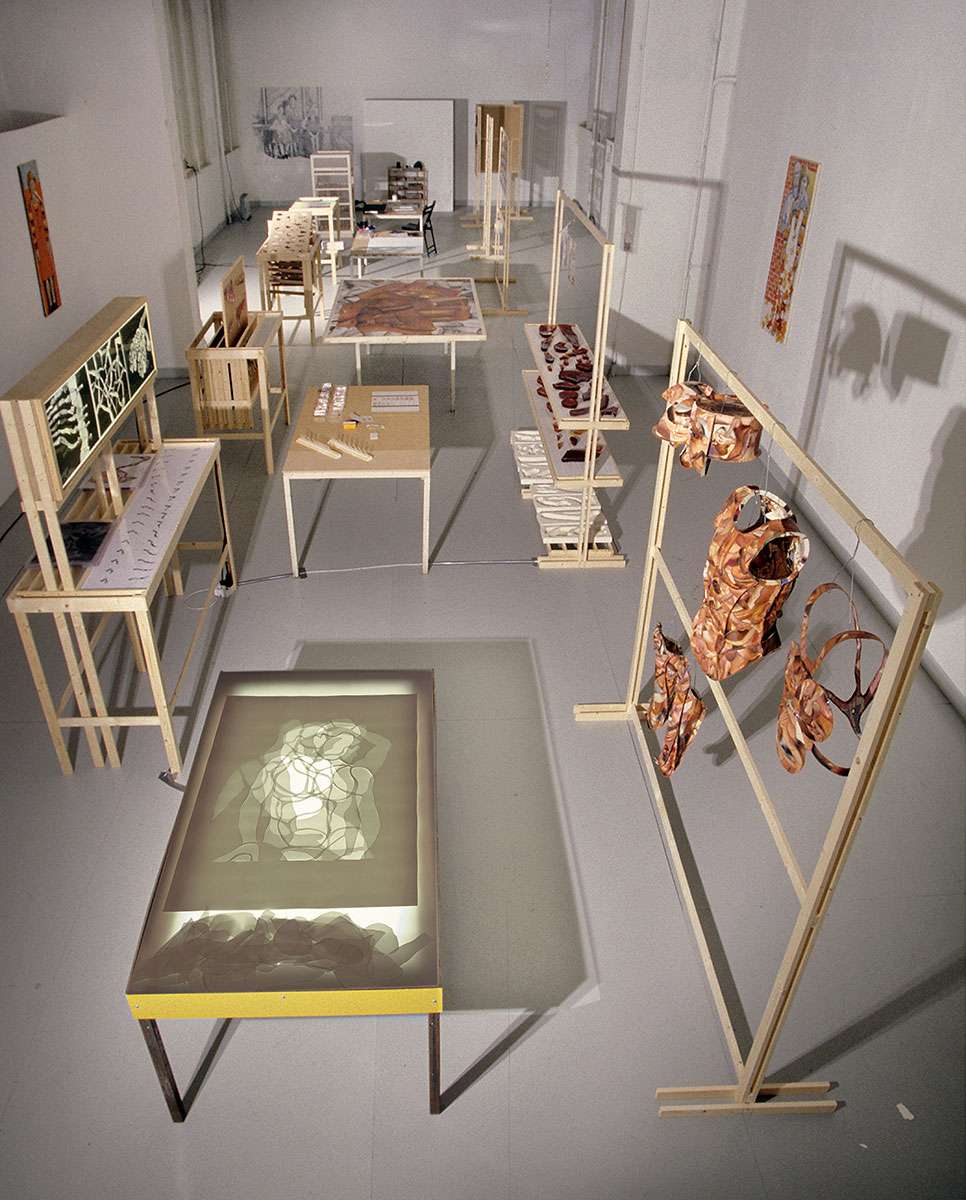 Overview of PUIRPuB 2, Processing Unit of the (N)IRPuB / various materials / space of 1350x450x170cm / 2000
Overview of PUIRPuB 2, Processing Unit of the (N)IRPuB / various materials / space of 1350x450x170cm / 2000
The Processing Unit 2 consists of a grouping of wooden constructions and tables. There are 3 distinctive rows. The middle row consists of tables – the places – that represent the spots where staff are at work. In a row to the right of that, wooden constructions represent various actions and activities. Left of the middle is a row of wooden racks that show results of the Development department.
The places are marked as ‘tables’, the activities – verbs – as ‘units’ and the presentations as ‘racks’.
The overview
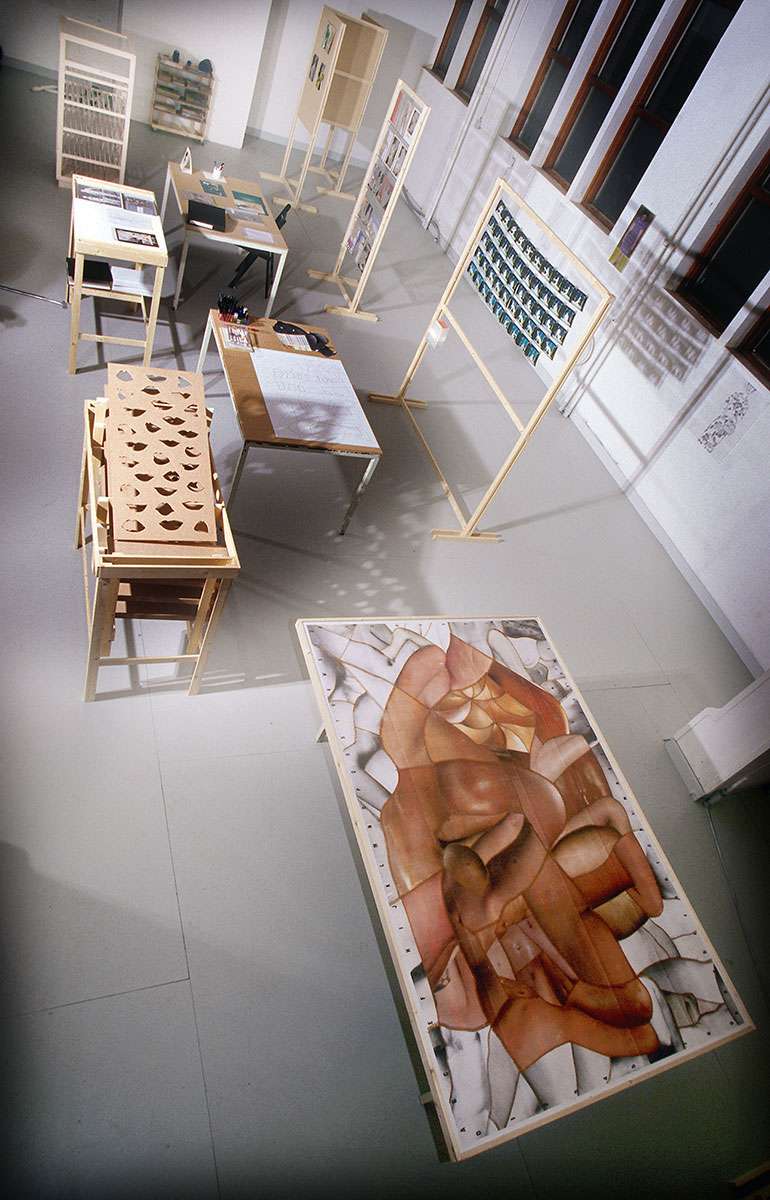 Collecting, Archiving, Drawing, Sifting and Cutting table, Sorting table, Map table and rack Public Person, rack Remains, rack Mobility study in PUIRPuB 2 / various materials / space of 1350x450x170cm / 2000
Collecting, Archiving, Drawing, Sifting and Cutting table, Sorting table, Map table and rack Public Person, rack Remains, rack Mobility study in PUIRPuB 2 / various materials / space of 1350x450x170cm / 2000
Through the middle, from the back to the front:
Collecting = gathering images from newspapers, magazines and other media (against the back wall)
Cutting table = images are assessed and cut out and coded
Sorting table = parts from the archive bags are sorted and grouped per image
Map table = partial images are blended to maps for external use, see also Cartography
Left, from the back to the front:
Archiving unit = storing the parts of the image, see also filing cabinet in Cold Storage
Drawing unit = recording the cut out image in a drawing and a serial number
Sifting unit = sifting out the parts by sort and size
Right, from the back to the front:
Public Person rack = works Homo Publicus, nail polish on images
Remains rack = Remains Public Body, RPuB
Mobility study rack = work radslag 1, remains of the image series of female bodybuilder on TV
 Scaling, Scanning and Map table, Composition table, Presentation table and rack Striptease, rack Camouflage in PUIRPuB 2 / various materials / space of 1350x450x170cm / 2000
Scaling, Scanning and Map table, Composition table, Presentation table and rack Striptease, rack Camouflage in PUIRPuB 2 / various materials / space of 1350x450x170cm / 2000
Through the middle, from the middle, from the back to the front:
Map table = partial images are blended to maps for external use, see also Cartography
Composition table = parts from the archive bags are re-used for new compositions
Presentation table = work body-cut 24 is presented, see also Applications
Left, from the middle, from the back to the front:
Scaling unit = enlarging existing images and parts
Scanning unit = screening of the large Public Body, here the inside, see also Scan PuB
Right, from the middle, from the back to the front:
Striptease rack = parts of the work Think Thin, last phase with cast PPuB and moulds
Ramouflage rack = camouflage harnesses for outside work in the Public Body, see also Field Work
The places as tables

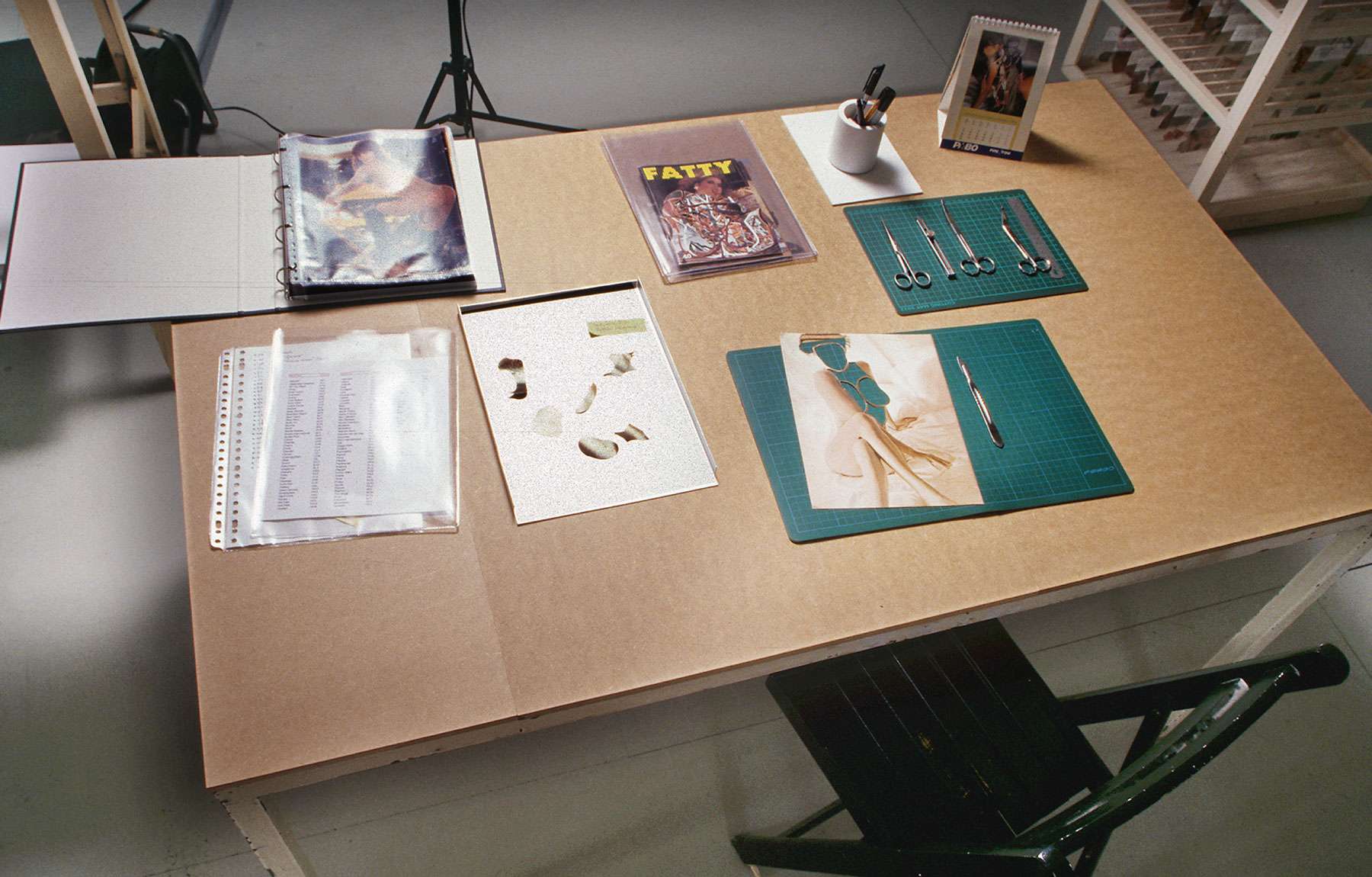 Cutting table in PUIRPuB 2 / various materials / table: 150x90x85cm / 2000
Cutting table in PUIRPuB 2 / various materials / table: 150x90x85cm / 2000
Cutting table = images are assessed and cut out and coded
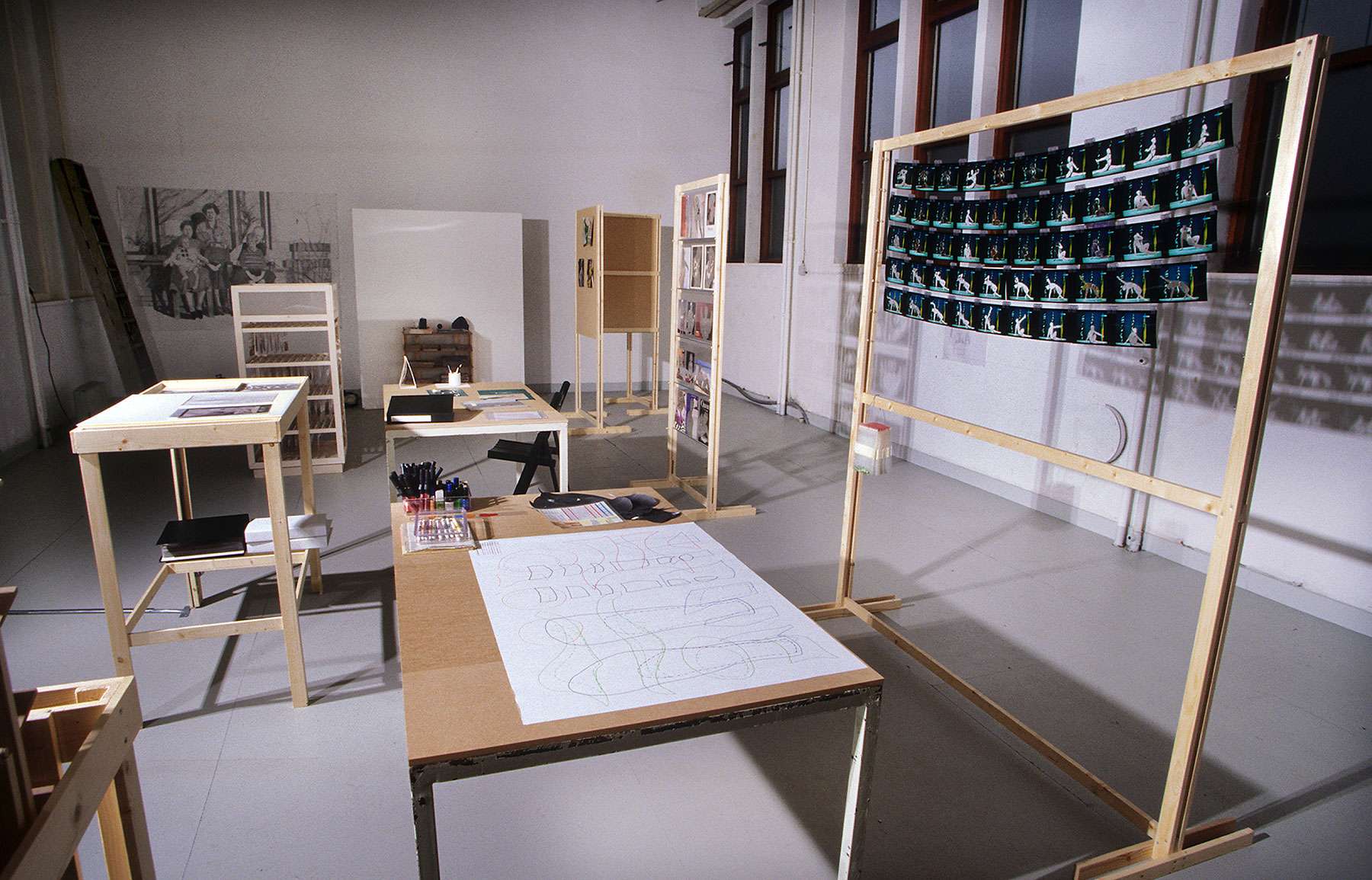
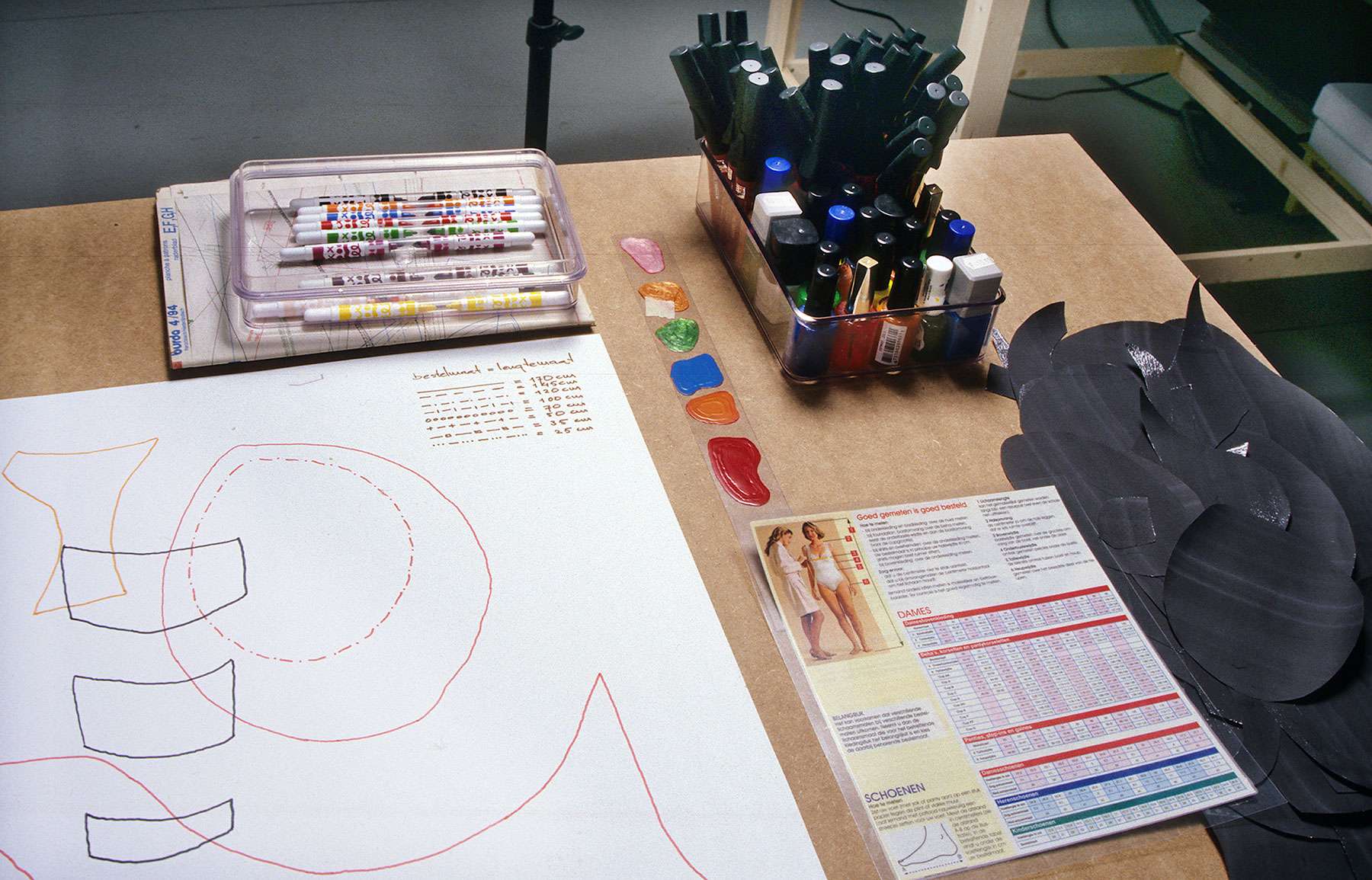 Sorting table in PUIRPuB 2 / various materials / table: 150x90x85cm / 2000
Sorting table in PUIRPuB 2 / various materials / table: 150x90x85cm / 2000
Sorting table = parts from the archive bags are sorted and grouped per image
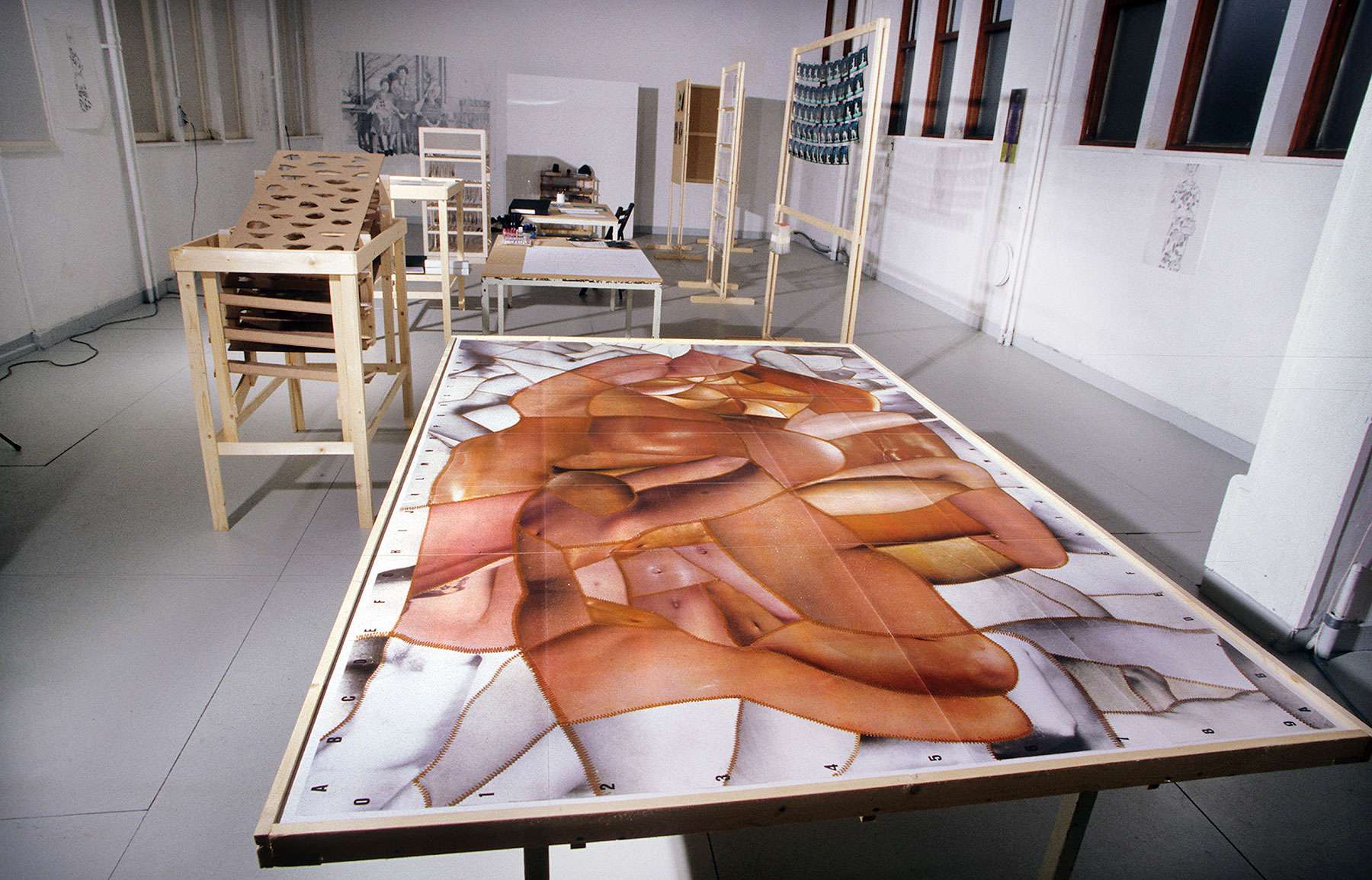
 Map table in PUIRPuB 2 / various materials / table: 217x144x81cm / 2000
Map table in PUIRPuB 2 / various materials / table: 217x144x81cm / 2000
Map table = partial images are blended to maps for external use, see also Cartography
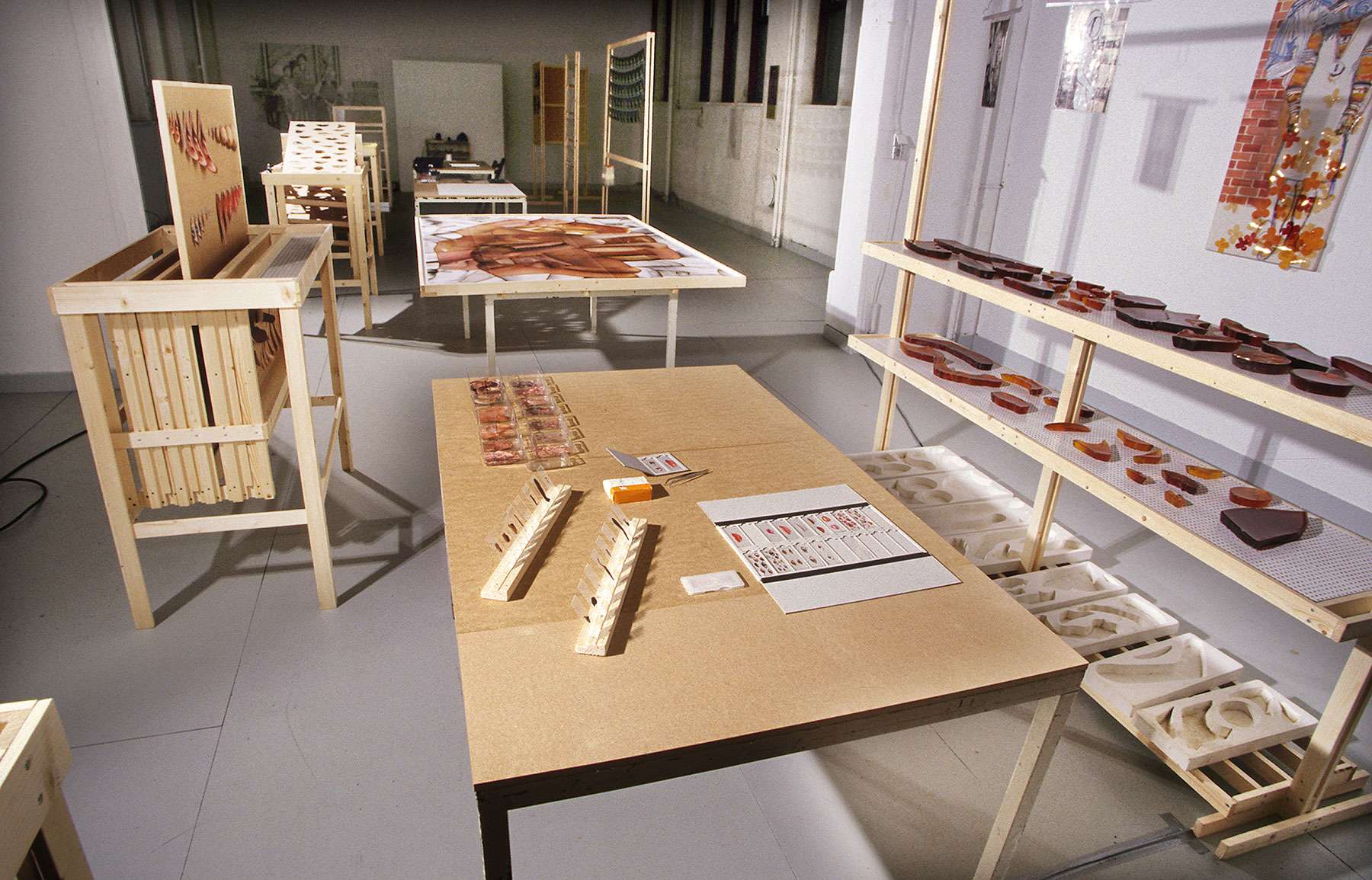
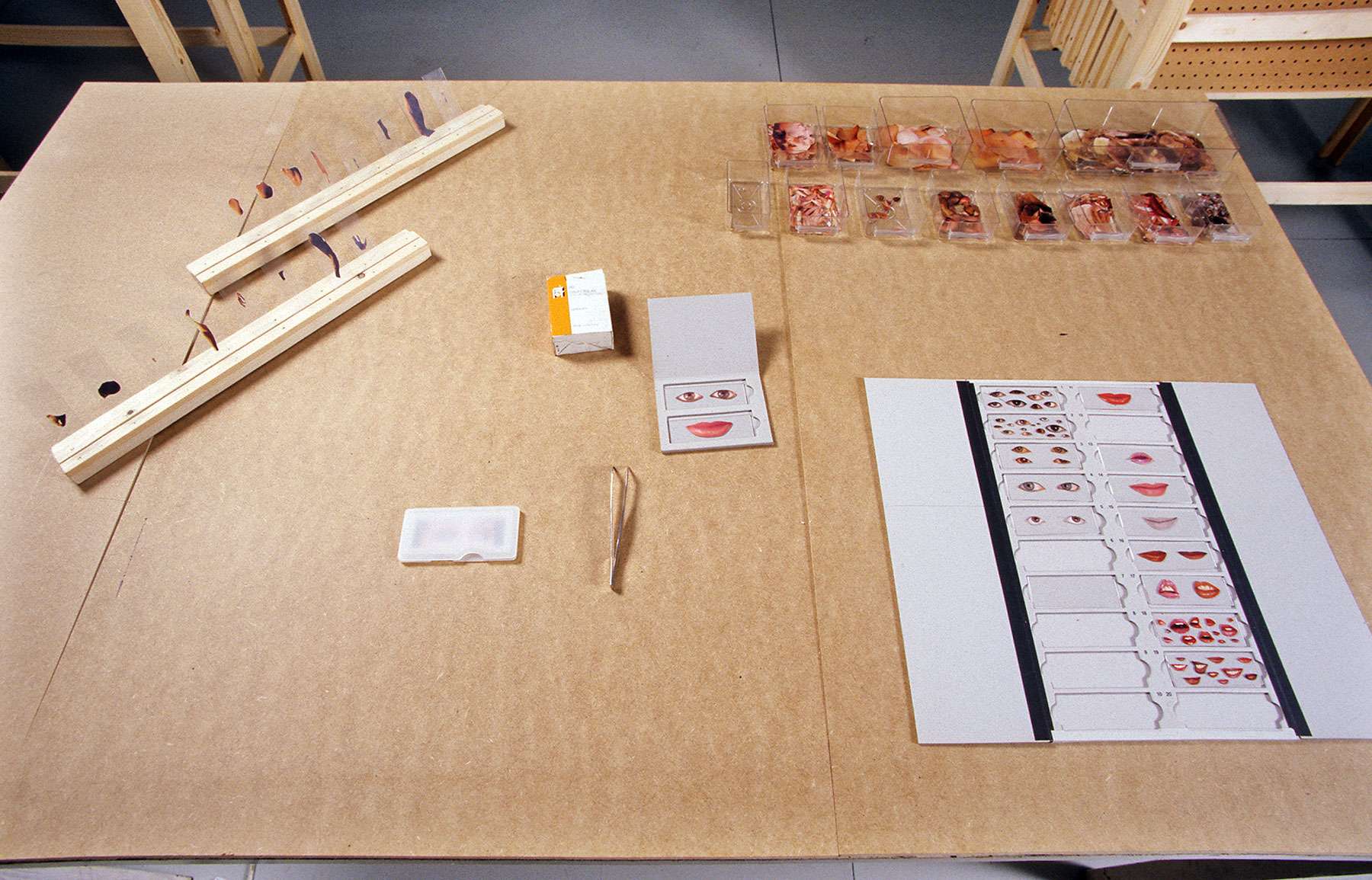 Composition table in PUIRPuB 2 / various materials / table: 150x90x85cm / 2000
Composition table in PUIRPuB 2 / various materials / table: 150x90x85cm / 2000
Composition table = parts from the archive bags are re-used for new compositions
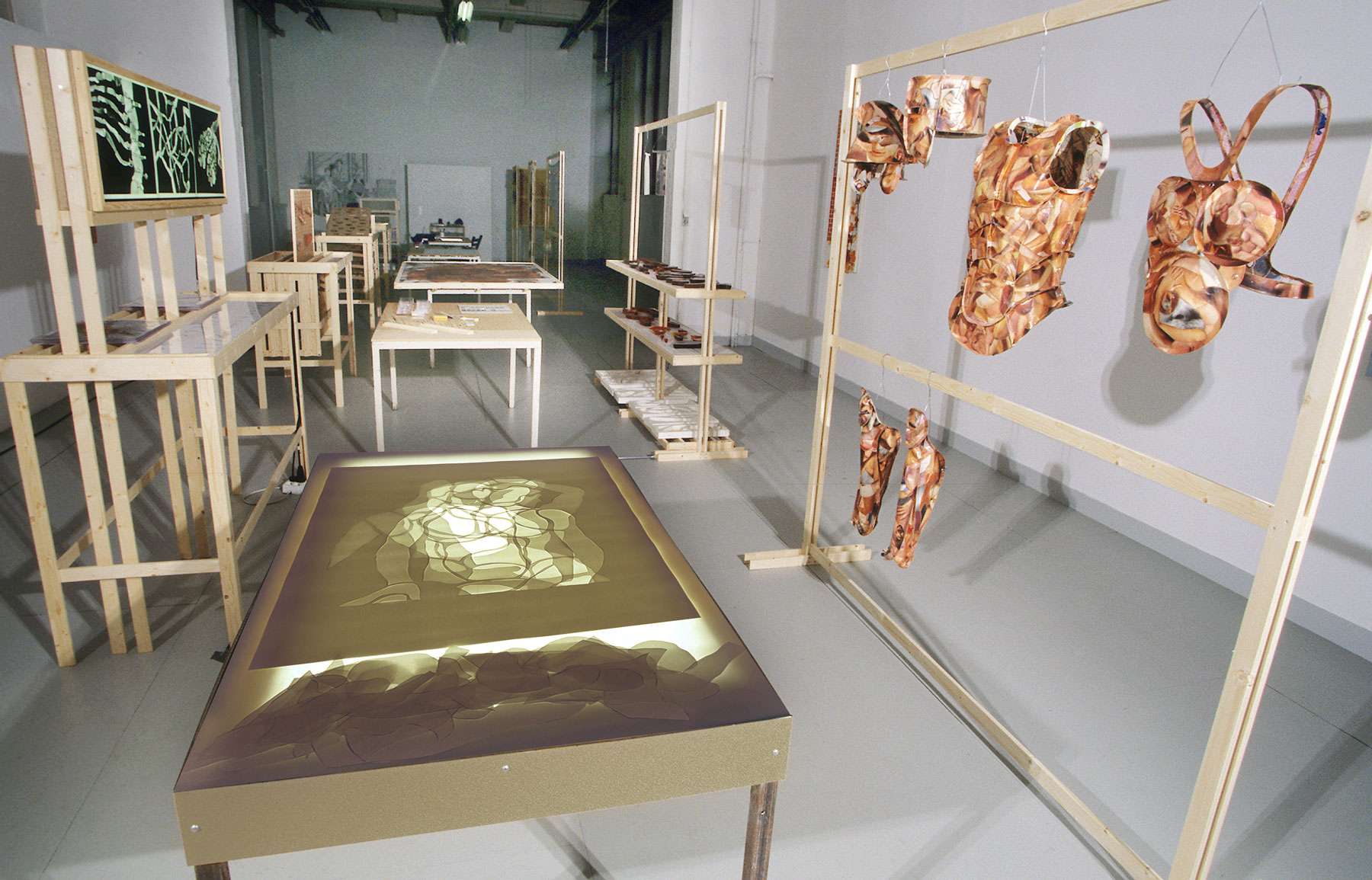
 Presentation table in PUIRPuB 2 / various materials / table: 150x90x85cm / 2000
Presentation table in PUIRPuB 2 / various materials / table: 150x90x85cm / 2000
Presentation table = work body-cut 24 is presented, see also Applications
De activities – verbs - as units
 Archiving in PUIRPuB 2 / various materials / unit: 66x66x139cm / 1996
Archiving in PUIRPuB 2 / various materials / unit: 66x66x139cm / 1996
Archiving unit = storing the parts of the image, see also filing cabinet in Cold Storage

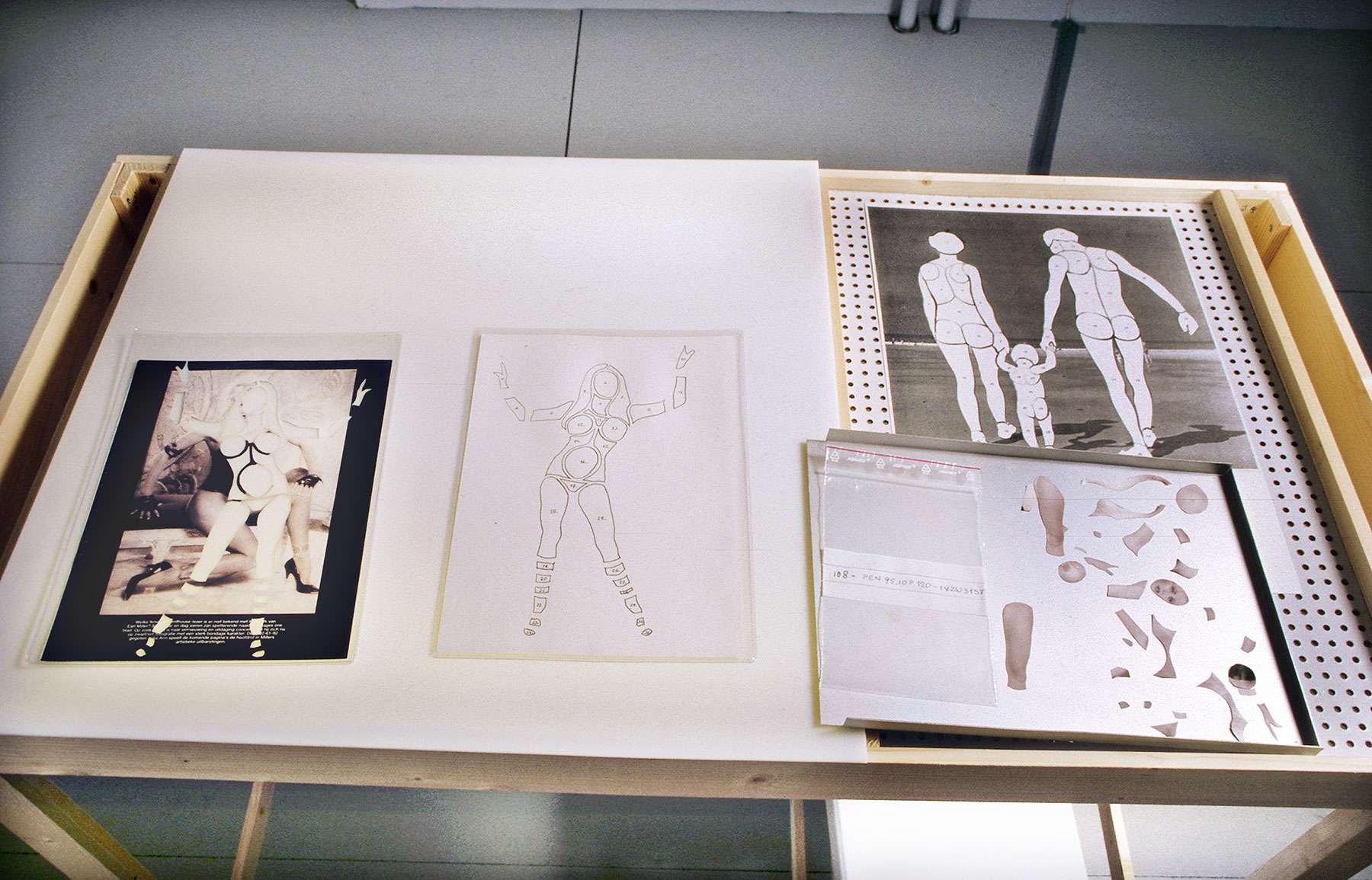 Drawing in PUIRPuB 2 / various materials / unit: 112x60x110cm / 2000
Drawing in PUIRPuB 2 / various materials / unit: 112x60x110cm / 2000
Drawing unit = recording the cut-out image in drawing and serial number
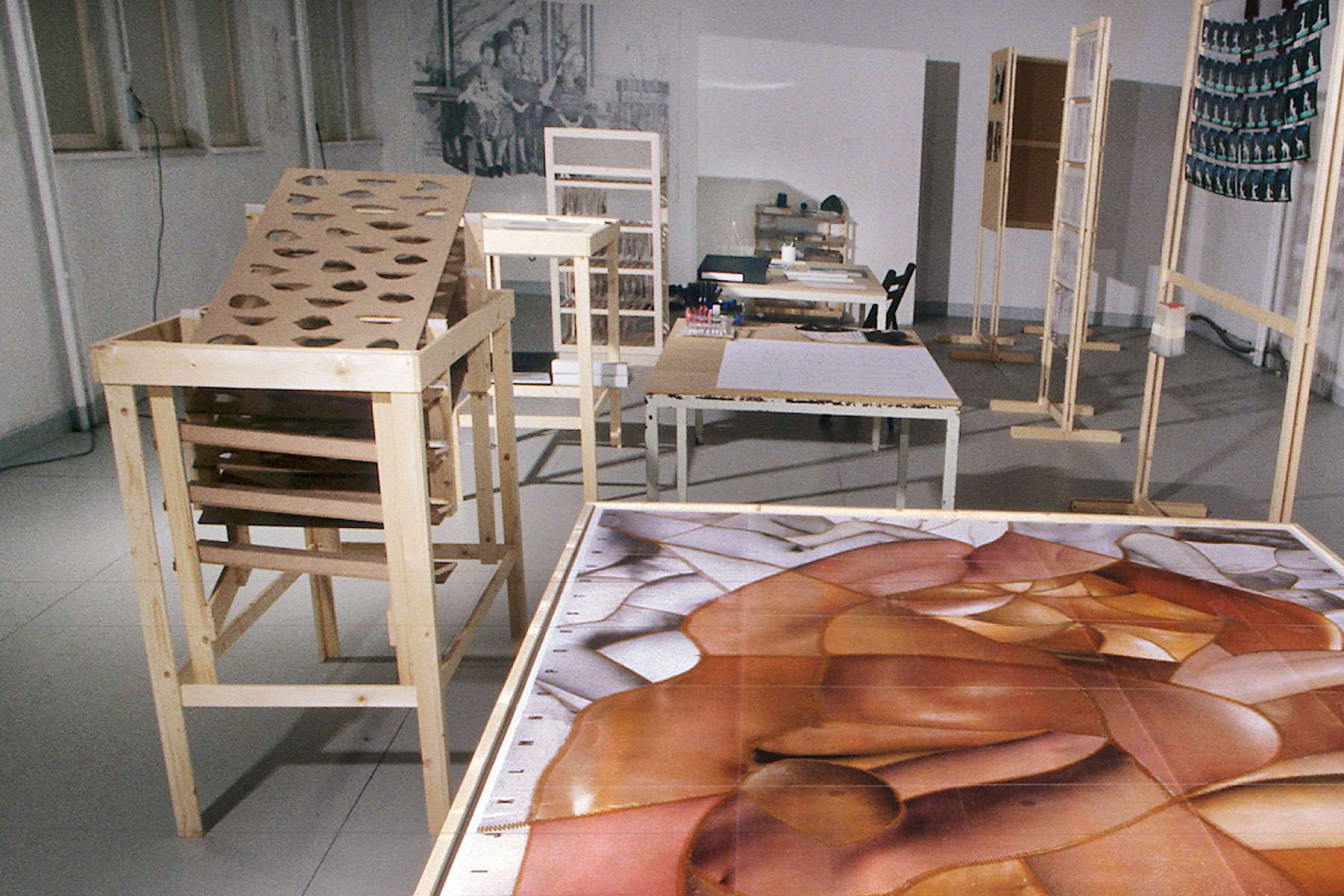
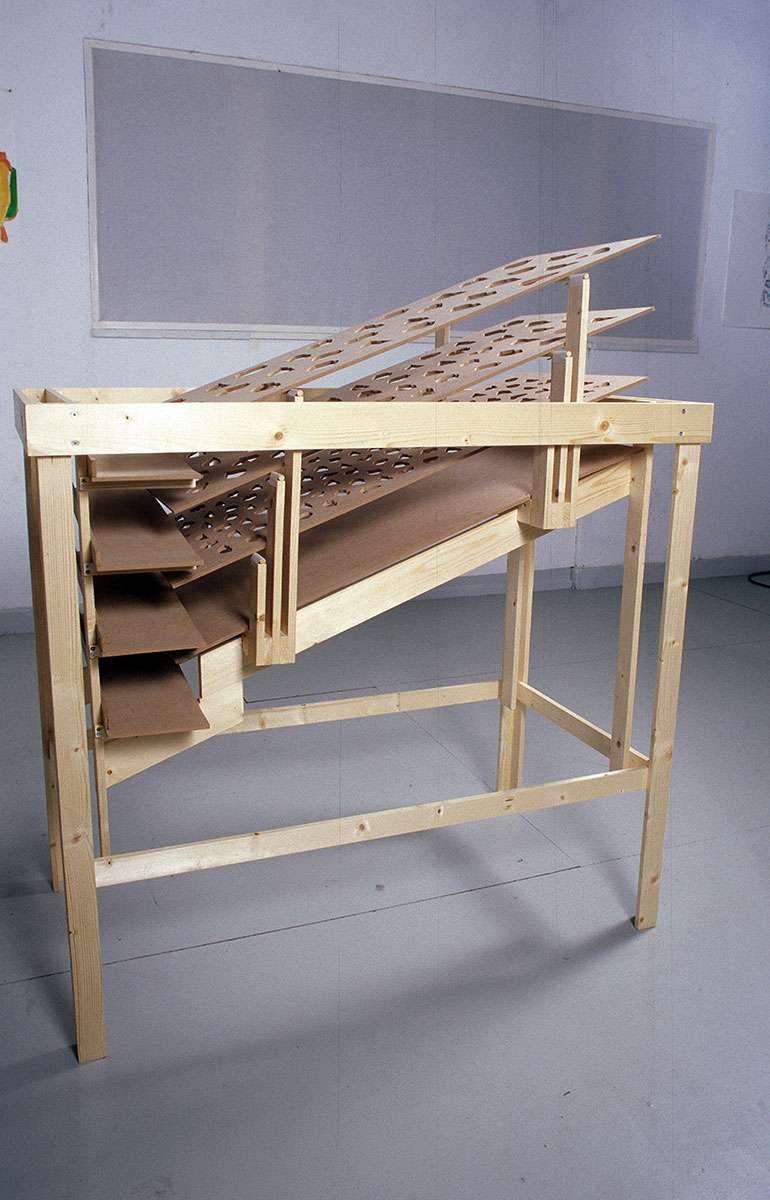 Sifting in PUIRPuB 2 / various materials / unit:114x60x132cm / 2000
Sifting in PUIRPuB 2 / various materials / unit:114x60x132cm / 2000
Sifting unit = sifting out the parts by sort and size
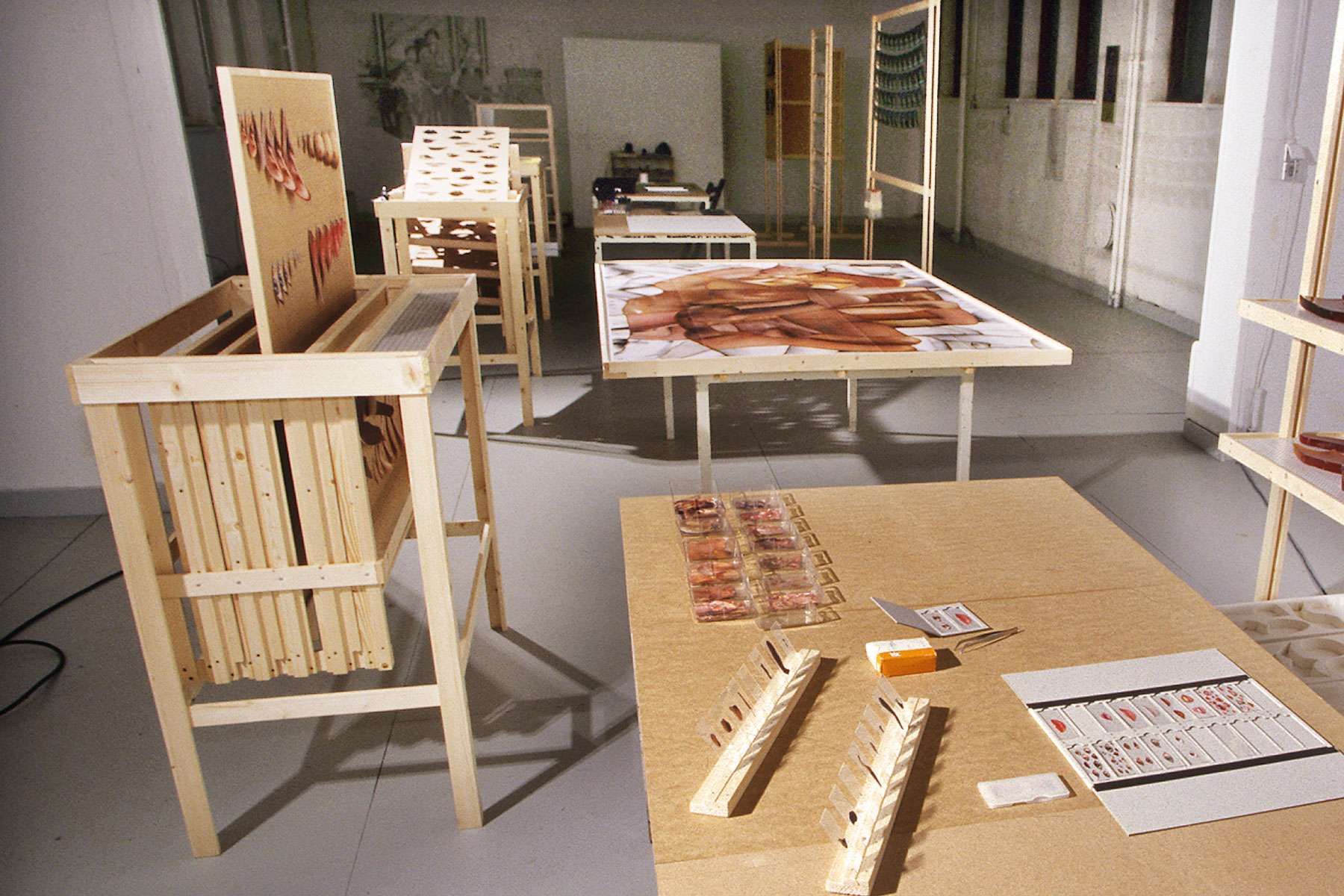
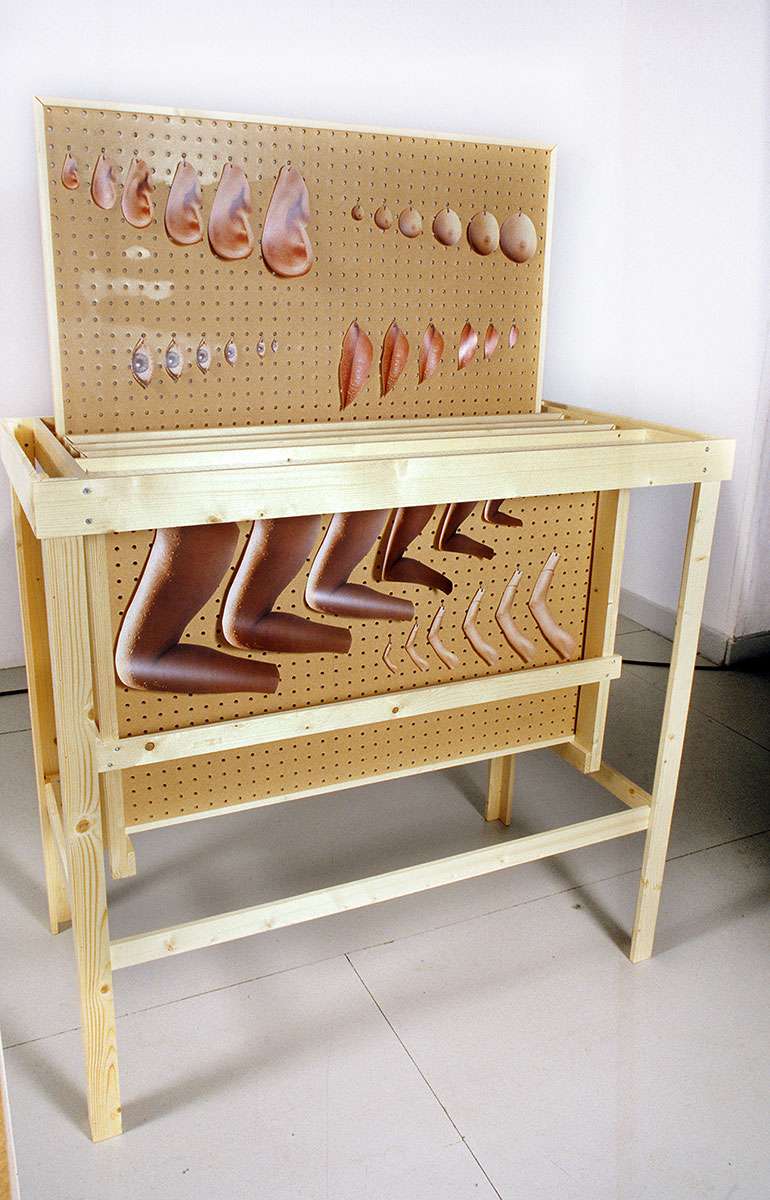 Scaling in PUIRPuB 2 / various materials / unit: 110x60x153cm / 2000
Scaling in PUIRPuB 2 / various materials / unit: 110x60x153cm / 2000
Scaling unit = enlarging existing parts of images
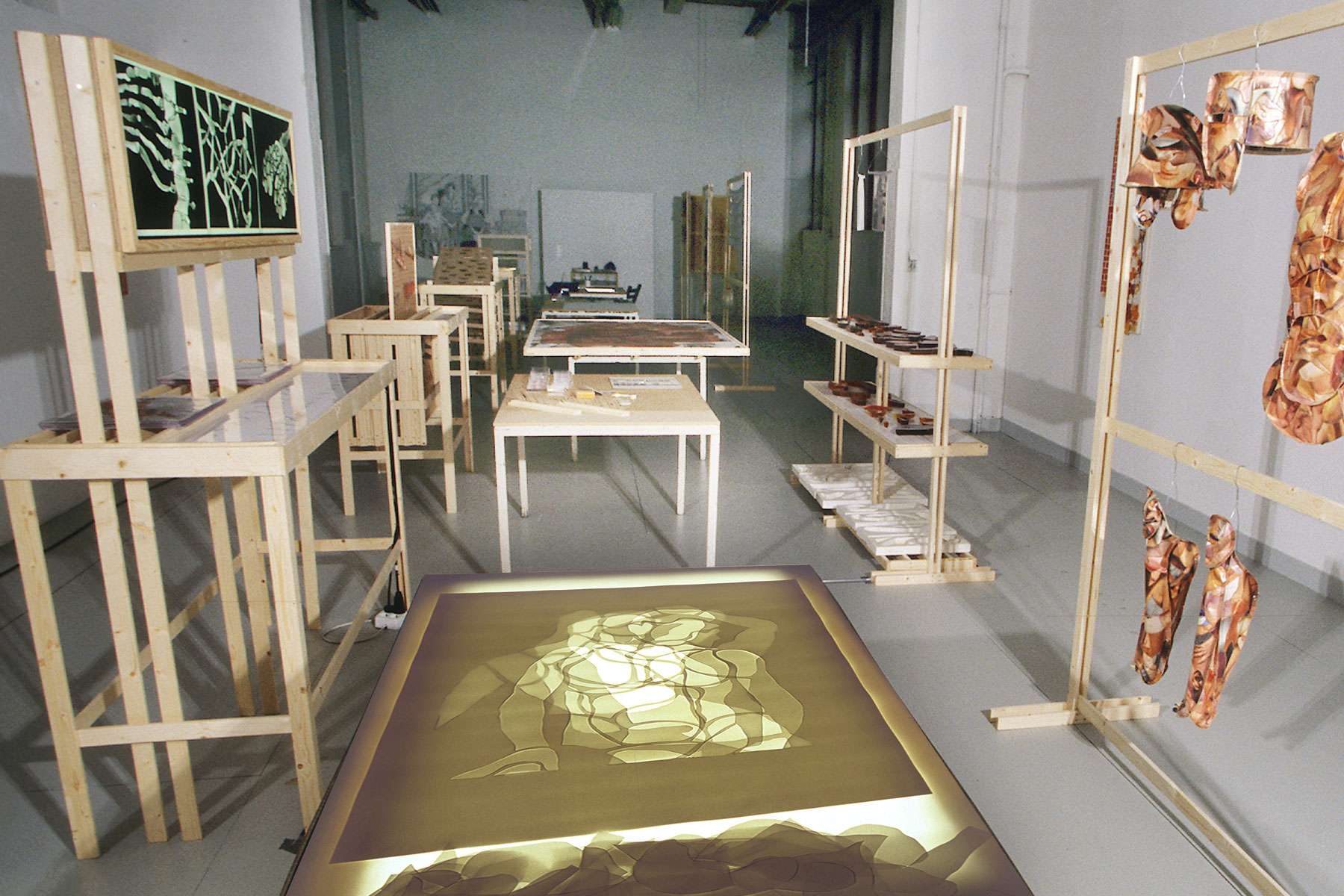
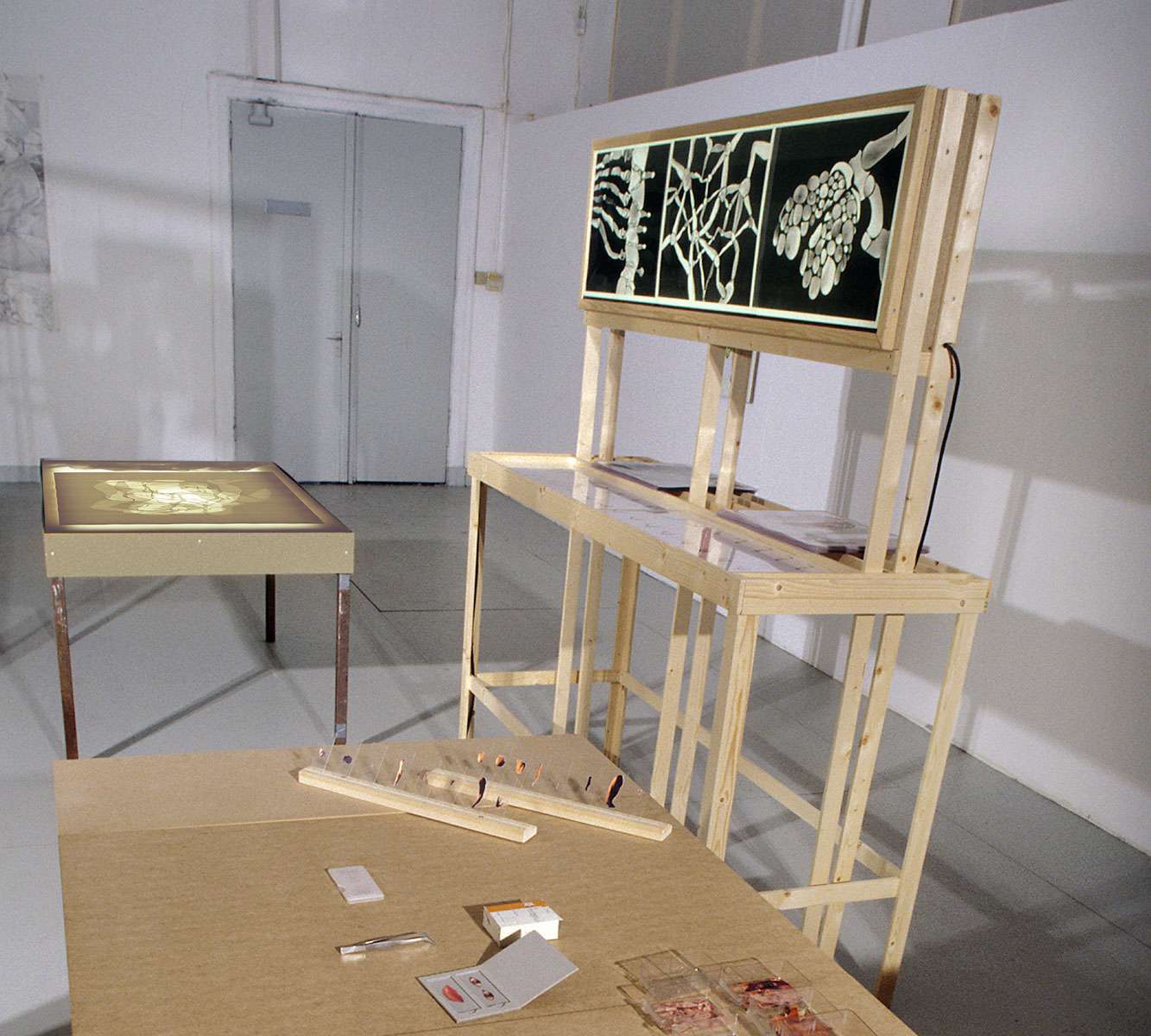 Scanning in PUIRPuB 2 / various material / unit: 172x60x190cm / 2000
Scanning in PUIRPuB 2 / various material / unit: 172x60x190cm / 2000
Scan unit = screening the large Public Body, here the inside, see also Scan PuB
The presentations as racks
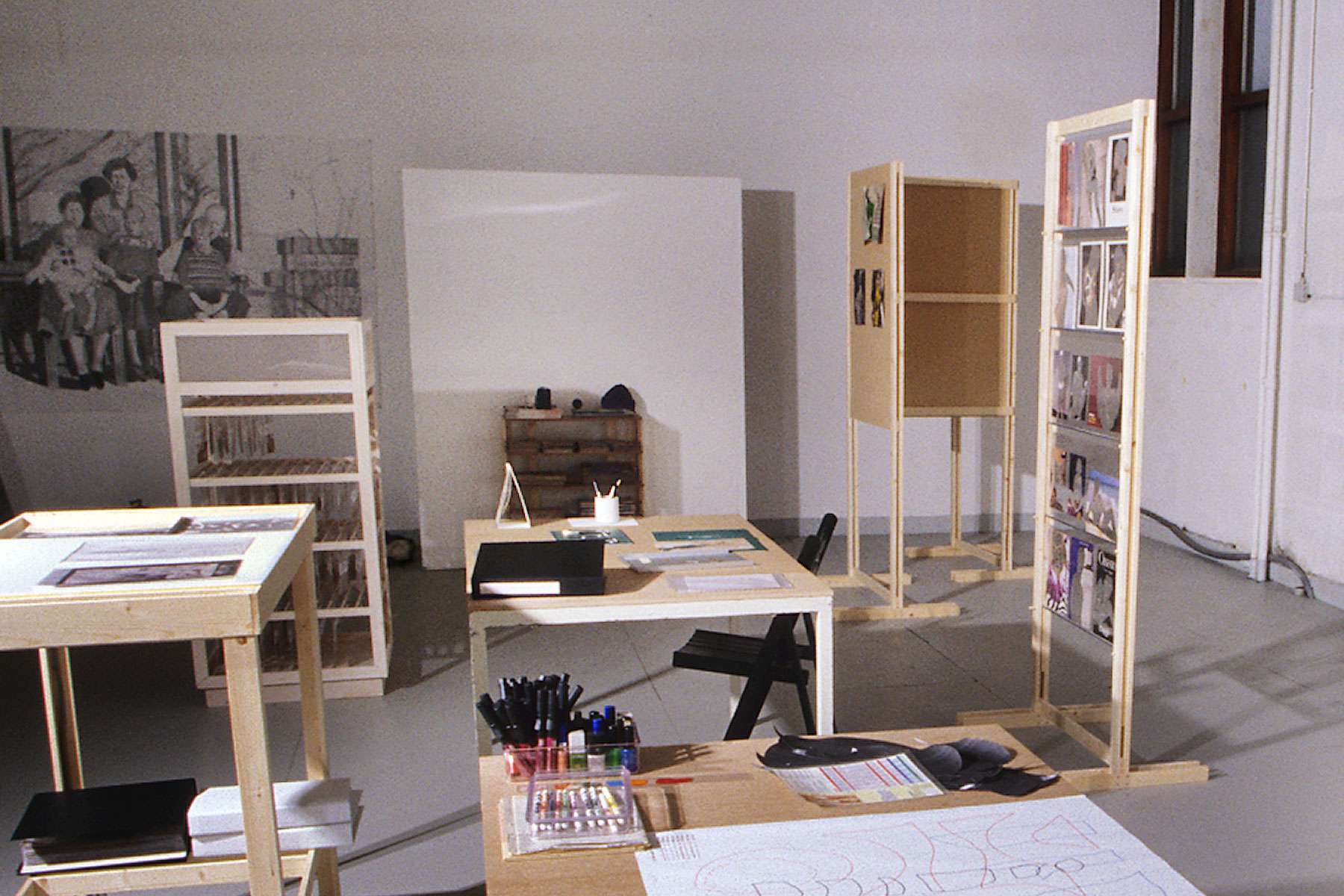 Public Person in PUIRPuB 2 / various materials / rack: 180x146x210cm / 2000
Public Person in PUIRPuB 2 / various materials / rack: 180x146x210cm / 2000
Public Person rack = works Homo Publicus, nail polish on images

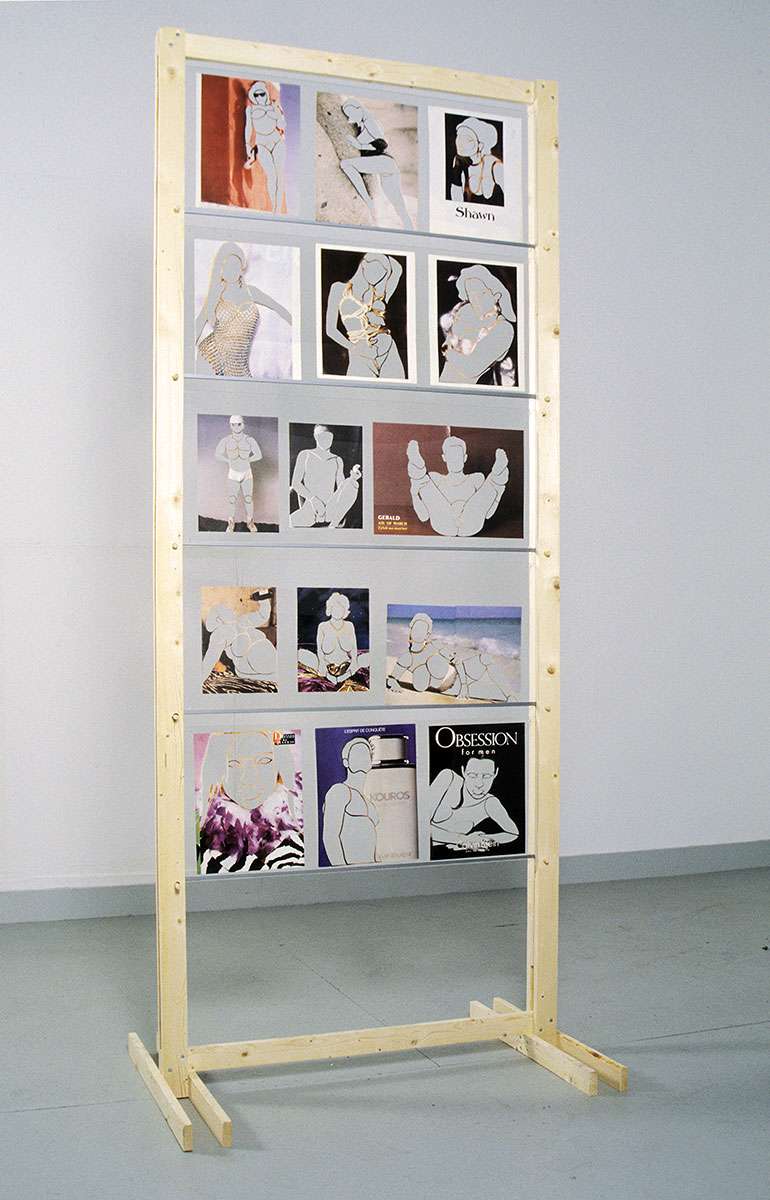
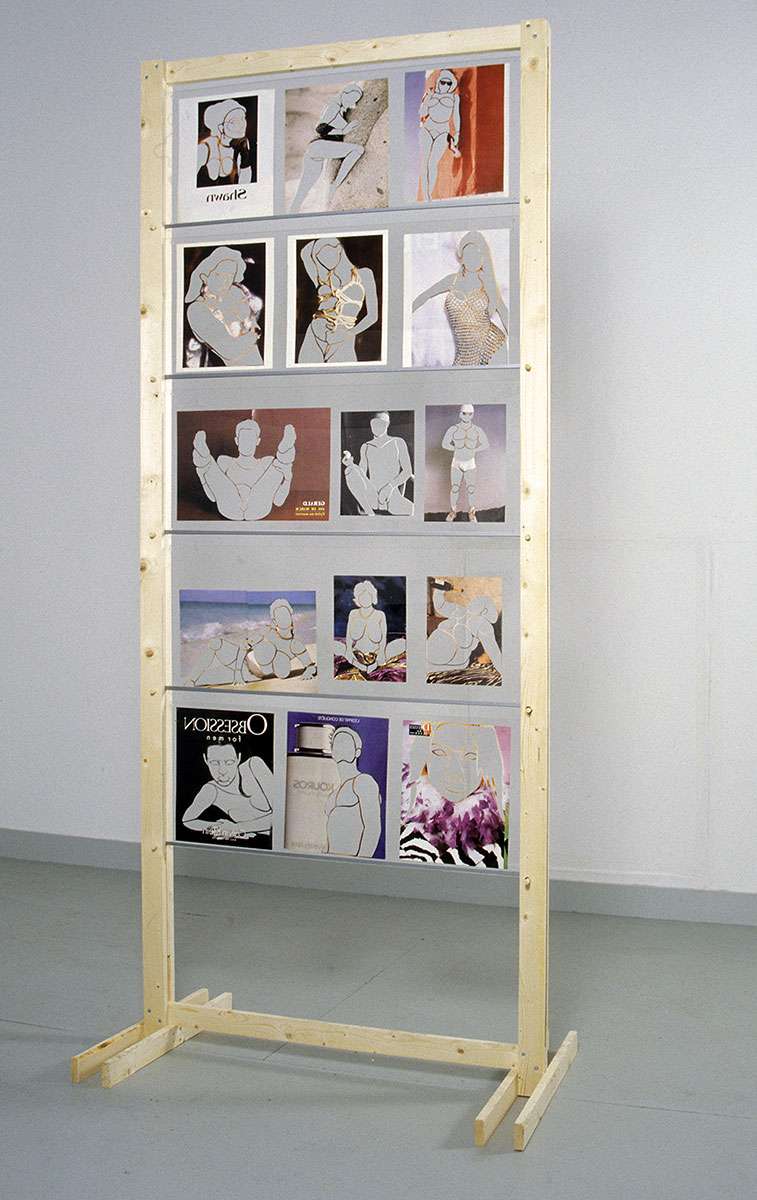 Remains in PUIRPuB 2 / various materials / rack: 103x33x210cm / 2000
Remains in PUIRPuB 2 / various materials / rack: 103x33x210cm / 2000
Remains rack = Remains Public Body, RPuB

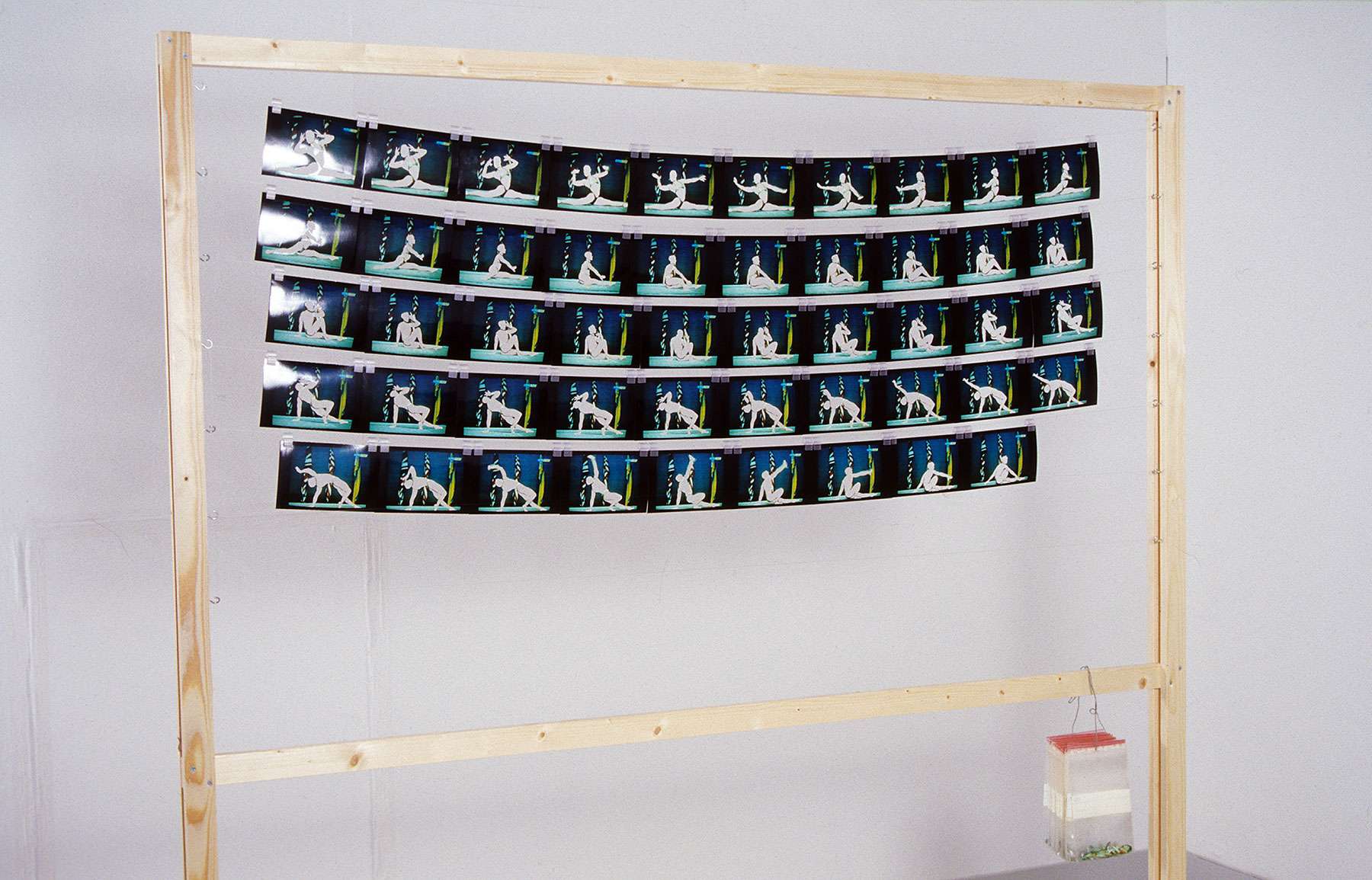 Mobility study in PUIRPuB 2 / various materials / rack: 193x33x210cm / 2000
Mobility study in PUIRPuB 2 / various materials / rack: 193x33x210cm / 2000
Mobility study rack = work radslag 1, remains of the image series of female bodybuilder on TV

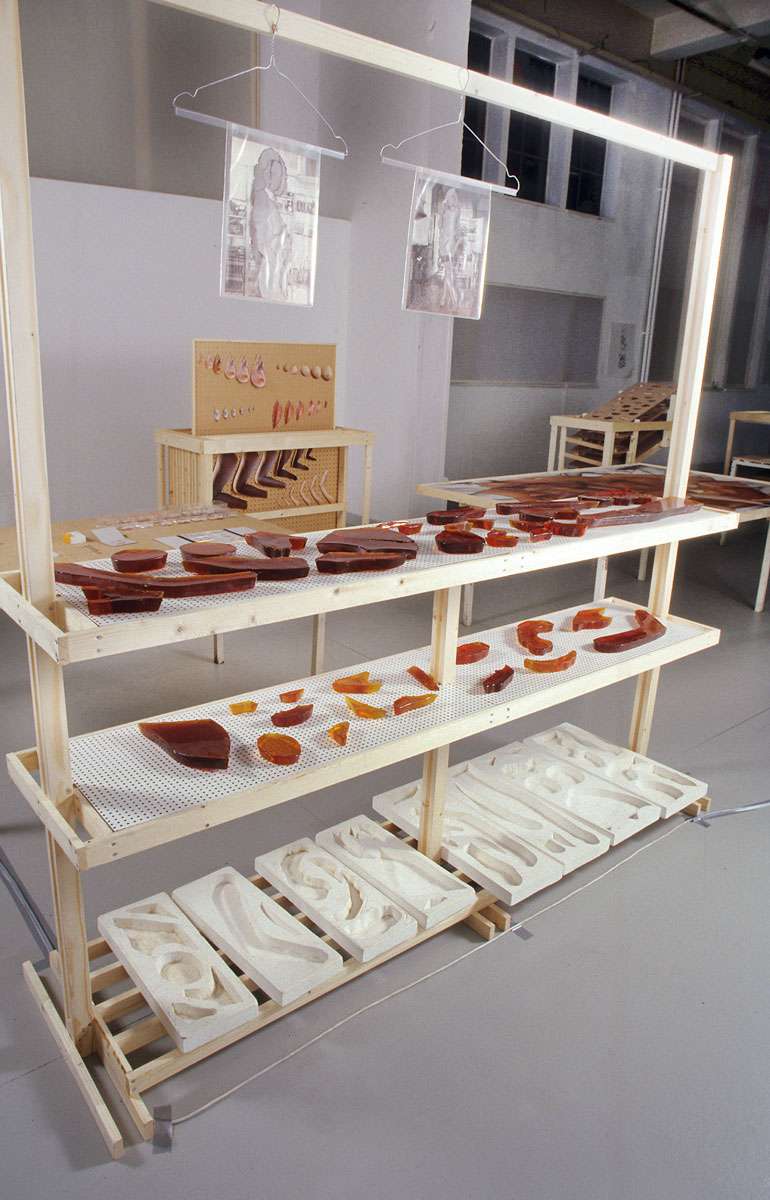
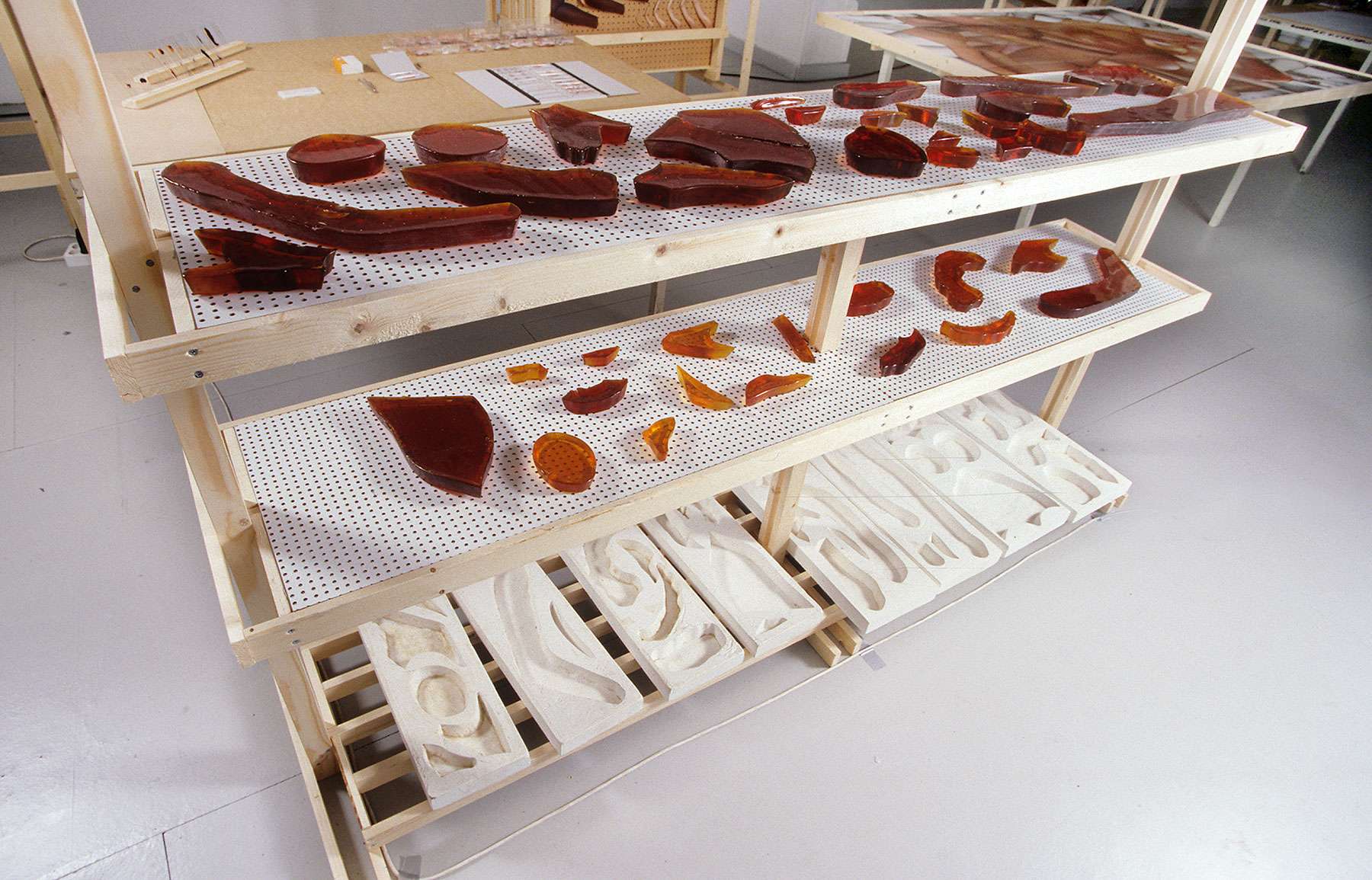 Striptease in PUIRPuB 2 / various materials / rack: 213x60x210cm / 2000
Striptease in PUIRPuB 2 / various materials / rack: 213x60x210cm / 2000
Striptease rack = parts of the work Think Thin, last phase with cast PPuB and moulds

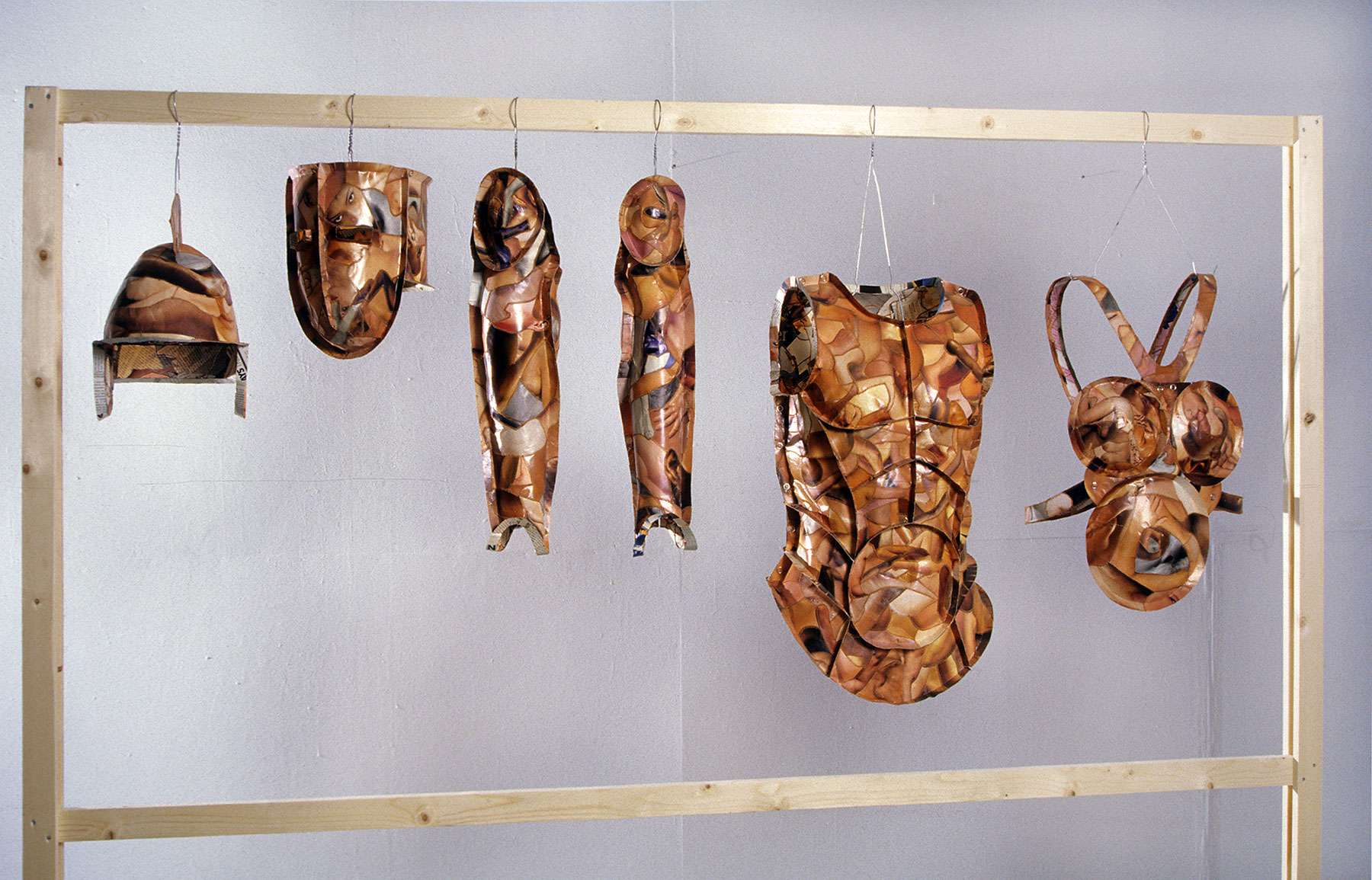 Camouflage in PUIRPuB 2 / various materials / rack: 213x60x210cm / 2000
Camouflage in PUIRPuB 2 / various materials / rack: 213x60x210cm / 2000
Camouflage rack = camouflage harness for outdoor work in the Public Body, see also Field Work